Printable Version of Topic
Click here to view this topic in its original format
Hamara Forums _ Bollywood _ Nostalgia......yesteryear Actresses
Posted by: Reeth Mar 28 2007, 03:07 PM
Saluting the beautiful and talented leading ladies of yesteryears ....
DEVIKA RANI
She is considered to be the 'First Lady' of the Indian cinema.Grand niece of Rabindranath Tagore she was truly a great beauty..........discovered by Himanshu Rai, who she later married . They together set up the
Famous" Bombay Talkies Studio " beginning with a murder mystery 'Jawani ki hawa' in which Devika Rani
played the lead.........thus began a successful film career...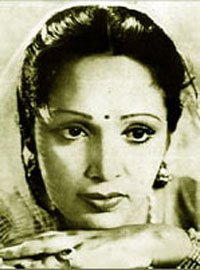

Some of her most memorable films were
Karma
Jawani ki hawa
Achoot kanya( with Ashok kumar considered to be a classic and a landmark in the history of Indian cinema)
Izzat
Jeevan naiyya
Durga
Savitri
Anjaan
Hamari Baat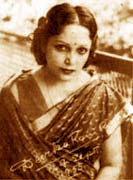
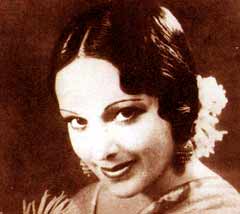
Himanshu Rai died in 1940,after which she took control of Bomabay Talkies and kept the banner flying high with hits such as Kangan, Bandhan Jhoola, Kismet, Punarmilan...
In 1945 she quit films to marry the noted Russian painter Dr Svetoslav Roerich and retired to a life of domesticity, in their sprwaling estate 'thatguni' in Bangalore, where she lived till her death in 1994,but maintained her link with the film industry...
She was honoured with the " Padmashri" in 1958, and she became the first film personality to be awarded he Dada Sahab Palkhe Award in 1969.
Devika rani photographed a few years before her death....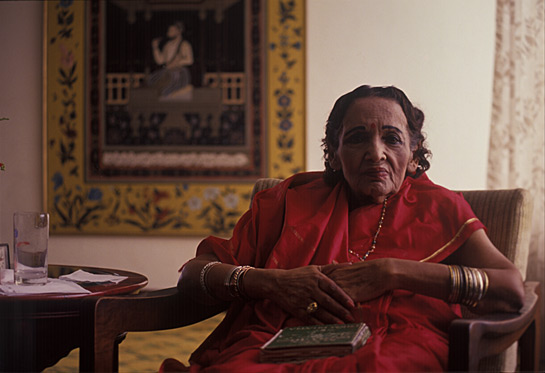
Attached image(s)
Posted by: Reeth Mar 28 2007, 03:10 PM
plss fel free to post your comments, feedbacks and any additional information...... ![]()
Posted by: jassi Mar 28 2007, 05:21 PM
i have no idea abt her nationality..she married to himanshu roy(i guess),they both started a film company..she was the actress of those films..later she even eloped with one of her actor,but come back and the actor was replaced by ashok kumar
Posted by: nasir Mar 28 2007, 10:25 PM
plss fel free to post your comments, feedbacks and any additional information......
Devika Rani is best remembered for her discovery of DILIP KUMAR. I think she can also be credited as being the First Lady of the Silver Screen and the person who actually kissed her screen hero.
Her tragedy lies in the fact that after her second husband (ROERICH's) demise she found herself surrounded by money-grubbers. Her employees were out to grab chunks of large estate in Bangalore. I wonder now what has happened to her large estate.
Despite being an actress of the Thirties, she was most accomplished and modern in every sense.
NASIR.
Posted by: noorie Mar 29 2007, 01:14 AM
plss fel free to post your comments, feedbacks and any additional information......
Devika Rani is best remembered for her discovery of DILIP KUMAR. I think she can also be credited as being the First Lady of the Silver Screen and the person who actually kissed her screen hero.
Her tragedy lies in the fact that after her second husband (ROERICH's) demise she found herself surrounded by money-grubbers. Her employees were out to grab chunks of large estate in Bangalore. I wonder now what has happened to her large estate.
Despite being an actress of the Thirties, she was most accomplished and modern in every sense.
NASIR.
She gave Indian cinema's first 'smouldering' smooch with her first husband Himanshu Rai in the 1933 film Karma if I am not wrong.
Her second husband Dr.Svetoslav Roerich the Russian painter who made his home in India..... I
The Kulu valley has never looked so beautiful as when he painted them.
Here's a painting he did of his celebrated wife entitled ‘Mme Devika Rani Roerich’.
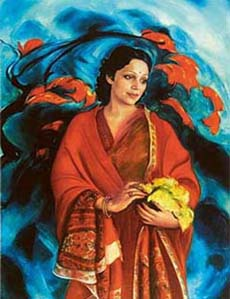
Noorie
Posted by: Reeth Mar 29 2007, 09:33 AM
i have no idea abt her nationality..she married to himanshu roy(i guess),they both started a film company..she was the actress of those films..later she even eloped with one of her actor,but come back and the actor was replaced by ashok kumar
She was Indian, of course..... did elope with Najam ul Hussain, the hero of her film Jawani ki Hawa....
plss fel free to post your comments, feedbacks and any additional information......
Devika Rani is best remembered for her discovery of DILIP KUMAR. I think she can also be credited as being the First Lady of the Silver Screen and the person who actually kissed her screen hero.
Her tragedy lies in the fact that after her second husband (ROERICH's) demise she found herself surrounded by money-grubbers. Her employees were out to grab chunks of large estate in Bangalore. I wonder now what has happened to her large estate.
Despite being an actress of the Thirties, she was most accomplished and modern in every sense.
NASIR.
Thank you for those inputs nasir......apparently Devika Rani suggested Muhammad Yousuf Khan to change his name to DILIP KUMAR........the rest is history
After the legal battle the estate is now in the hands of the State government and as can be expected, is badly maintained...it is a huge place covering 468 acres ....
some views of the Tataguni estate owned by Devika Rani and Roerich....

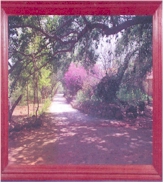

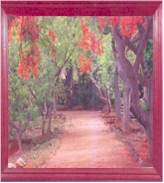
plss fel free to post your comments, feedbacks and any additional information......
Devika Rani is best remembered for her discovery of DILIP KUMAR. I think she can also be credited as being the First Lady of the Silver Screen and the person who actually kissed her screen hero.
Her tragedy lies in the fact that after her second husband (ROERICH's) demise she found herself surrounded by money-grubbers. Her employees were out to grab chunks of large estate in Bangalore. I wonder now what has happened to her large estate.
Despite being an actress of the Thirties, she was most accomplished and modern in every sense.
NASIR.
She gave Indian cinema's first 'smouldering' smooch with her first husband Himanshu Rai in the 1933 film Karma if I am not wrong.
Her second husband Dr.Svetoslav Roerich the Russian painter who made his home in India..... I
The Kulu valley has never looked so beautiful as when he painted them.
Here's a painting he did of his celebrated wife entitled ‘Mme Devika Rani Roerich’.

Noorie
You are absolutely right about the " Smouldering smooch"
She was a student of architecture in London and met Himanshu Rai there, where she had agreed to design
the sets for his film production....
Apparently,Roerich was not only an artist but was an environmental engineer with imagination and technical skills......had adopted rainwater harvesting nearly 50 years ago in the estate...
I have seen this place recently and though it is in a state of neglect one can see traces of Roerichs brilliant planning and vision....
That is S.M Krishna the the previous chief minister of Karnataka garlanding the statue of Svetoslav Roerich
at the inaguration of Dr.Roerich's centenary celebrations, attended by the Russian Ambassador..in Oct,2003
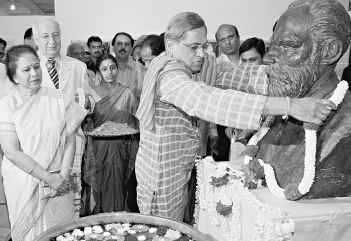
Posted by: nasir Mar 29 2007, 11:07 PM
Great people. Great information. Great painting.
Thanks Noorie and Reeth. ![]()
Reeth, regarding Yusuf Khan, actually three names were suggested: JAHANGIR, VASUDEV and DILIP KUMAR (quoting from memory). It was the name DILIP KUMAR that created history.
NASIR.
Posted by: noorie Mar 29 2007, 11:51 PM
Great people. Great information. Great painting.
Thanks Noorie and Reeth.
Reeth, regarding Yusuf Khan, actually three names were suggested: JAHANGIR, VASUDEV and DILIP KUMAR (quoting from memory). It was the name DILIP KUMAR that created history.
NASIR.
Most wannabe 'stars' of today even on the small screen take 2 the numerological route when their celestial stars start failing them.
Noorie
Posted by: jassi Mar 30 2007, 11:00 AM
dunno why she is called first leading lady of indian cinema..there were actresses before her too..ruby mayors(sulochana),who later played mother's roles too...was established actress
and what abt durga khote,shobhana samarth(i guess they made their debut at same time)
may be devika rani can be called first leading lady of talkies...
Posted by: nasir Mar 30 2007, 11:43 PM
Great people. Great information. Great painting.
Thanks Noorie and Reeth.
Reeth, regarding Yusuf Khan, actually three names were suggested: JAHANGIR, VASUDEV and DILIP KUMAR (quoting from memory). It was the name DILIP KUMAR that created history.
NASIR.
Most wannabe 'stars' of today even on the small screen take 2 the numerological route when their celestial stars start failing them.
Noorie
There have been others with the name of DILIP'S. But they could not become the darling of the nation.
Dilip Kumar was destined to be what he was, and what he is - namely the Emperor and Original Legend of the Bollywood industry.
NASIR.
Posted by: noorie Mar 31 2007, 02:28 AM
Did you know that it was Devika Rani's b'day on the 30th of March? That was yesterday!
Here is some more info on her gathered from the Net:
D.O.B - 30th March 1908
Devika Rani came from a distinguished background, grand-niece of the Nobel Laureate Rabindranath Tagore, her father, Col. M.N. Chaudhuri, was the first Indian Surgeon-General of Madras.
She completed her early schooling in the early 1920s. She then studied drama at the Royal Academy of Dramatic Art (RADA) and the Royal Academy of Music in London where she won scholarships. In addition, she studied architecture, textile and decor design and apprenticed under Elizabeth Arden.
She married Indian producer and actor Himansu Rai in 1929. Together they starred in Karma the first Hindi sound film. They soon founded Bombay Talkies whose films challenged the caste system.
There she met Himanshu Rai and agreed to design the sets of his first production Light of Asia (1925).
They got married and after marriage they left for Germany where Rai made A Throw of Dice (1929) in collaboration with Germany's famous UFA Studio.
Rai made a bilingual Karma (1933) with Devika Rani in the lead and the two came to India. Here Rai and Devika Rani set up the famous Bombay Talkies Studio.
Under the painstaking supervision of Himanshu Rai, it purchased the most modern equipment from Germany. Franz Osten, director and a handful of technicians came down from England and Germany. By 1935, stream of Hindi productions began to emerge from Bombay Talkies Ltd. beginning with Jawani ki Hawa (1935), a murder mystery.
Devika Rani played the lead in most of these early productions. Their films were of a high technical standard and had a glossy look to them reminiscent of the films of MGM. (Devika Rani was lit up in a manner not unlike Greta Garbo!) In 1958, the President of India honoured Devika with a "Padma Shri". In 1970, she became the first recipient of the prestigious film prize Dadasaheb Phalke Award.
Devika Rani formed a successful team with Ashok Kumar, which ironically started due to a scandal as she eloped with her hero of Jawani ki Hawa, Najam-ul-Hussain. Rai found her and got her to come back and forgave her but not Hussain and Bombay Talkies Ltd. needed a new leading man. Rai's eyes fell on his laboratory assistant, Ashok Kumar.
The two of them starred in a series of films starting with Jeevan Naiya (1936) but it was Achut Kanya (1936), which capitulated Devika Rani and Ashok Kumar to big time fame. The love story between an untouchable girl and a Brahmin boy was both a critical and commercial success with critics going in raptures over Devika's performance.
Going with the trend she even sang her own songs in films with Main Ban Ki Chidiya with Ashok Kumar from Achut Kanya remembered till today. Devika Rani continued acting till 1943 and when Rai died in 1940 she took over the reins at Bombay Talkies. Among her discoveries at Bombay Talkies was Dilip Kumar.
But eventually the economics of filmmaking and tussles with other studio executives led her to take voluntary retirement. She married famed Russian painter Svetoslav Roerich and stayed at their huge estate near Bangalore in South India.
For her contribution to Indian Cinema, Devika Rani was the first ever recipient of the prestigious Dadasaheb Phalke award in 1970. She remained in Bangalore till her death in 1994. At her funeral Devika was given full state honours.
Here's a B/W still from one of her old movies.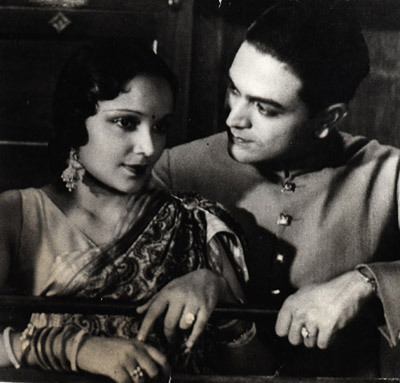
Noorie
Posted by: noorie Mar 31 2007, 03:08 AM
More info: ![]() Reeth, I really enjoyed doing this.
Reeth, I really enjoyed doing this.
Devika Rani Chaudhuri Roerich is not only one of the most colourful personalities of India, but the darling of film fans of more than two generations. She is a gifted artiste, well versed in the techniques of film making. Indeed, she is verily a symbol of Satyam, Shivam, Sundaram (Truth, goodness and beauty).
Daughter of Col.M.N.Choudheri, I.M.S., and Mrs.Leela Choudheri, she was born in Waltair. Her father had a distinguished medical career and was the first Indian Surgeon General of Madras.
She was educated in England and while at School, she received a scholarship from the Royal Academy of Dramatic Arts and the Royal Academy of Music in London to study acting and music.
She took up the study of applied arts in London, specialising in textile designing and decor, and also studied architecture. At an early age, she was already earning her living as a textile designer at a leading art studio in London.
While in London in 1928, she met the well-known Indian producer Himanshu Rai who produced famous Indian films like "The Light of Asia", "Shiraz" and "A Throw of Dice" for Indian and international markets.
Mr.Rai persuaded Devika Rani to join his production unit, to further the cause of Indian films. She signed a contract in London with Mr.Bruce Wolfe who was then associated with Himansu Rai. She later returned to India with Himansu Rai and his English and German experts to work on "A Throw of Dice" which was scheduled for production for England, Germany and the Continent.
She worked on the costumes and sets of this production under the guidance of the art director Promod Roy and studied the art of production.
In 1929, she married Himansu Rai and returned with him to Germany. Mr.Rai was the only Indian producer with the famous German film concern U.F.A. in Berlin. At the U.F.A. Studios, Devika Rani learnt costumes designing, make-up, decor and other different branches of film production with special training in acting.
She apprenticed in the Eric Pommer production unit at U.F.A., where she studied the art and techniques of acting under the guidance of Germany's great director Pabst, and other famous directors.
She was a U.F.A. at the time of the epoch-making change over from silent to the talkie films, and with Himansu Rai had the rare opportunity of seeing and studying the various changes and experiments in the new talking pictures.
At the time, Devika Rani also acted with Himansu Rai in a play for U.F.A. which took them to Switzerland and the Scandinavian countries, where they were received with the highest honours.
She was also a student in the production unit of the famous State producer Max Heinhardt in Germany. From Germany, Devika Rani and Himansu Rai returned to India, to produce their first international talking picture "KARMA" in which Devika Rani, Himansu Rai, Princess Suda Rani of Burdwan and others acted. "KARMA" was produced both in English and Hindusthani and was completed at the Stall Studios in London. It was the first Indian talking picture in English and Hindusthani to be released in England and on the Continent as well as Indian.
"KARMA" was received with the highest approbation by the public of London. The premier was inaugurated by Lord Irwin and attended by the highest officials and England's most distinguished artiste. The same success was accorded to "KARMA" throughout Great Britain and wherever it was released.
The release of "KARMA" in India created a sensation, it was the beginning of a new era in Indian motion picture production.
It was in "KARMA" that Devika Rani established herself as a "star" of first magnitude.
During the screening of "KARMA", Devika Rani was honoured by an invitation of the B.B.C. at London to act in the first television broadcast in Britain which was relayed throughout the country. She was also chosen to inaugurate the first B.B.C. broadcast on the short wave length to India.
The Bombay Talkies Ltd., was founded by Himansu Rai and Devika Rani in 1934 in Malad, Bombay. It was a public limited company formed by eminent businessmen of Bombay including F.E.Dinhsaw, Sir Firoze Sethna and others. The advent of the Bombay Talkies gave an impetus to Indian films.
It was Himansu Rai's idea to attract to films the best elements of society as he believed that education and a cultured background where essential to achieve high standards in art.
The Bombay Talkies set a new standard in motion picture production in India on most up-to-date lines with experts from England, Germany, France who also trained young Indian men and women in the art and techniques of films production. It was responsible for a vast number of famous producers, directors, stars, musicians, writers, poets and technicians who even today rank among the best in the country.
Devika Rani was the star of the Bombay Talkies Ltd.
Her outstanding portrayals, her style of acting and new approach created a distinct form and tradition. She acted in numerous films, many of which have become classics of the Indian screen. Among her most famous pictures were "Jawani-Ki-Hawa", "Jeevan Nayya", "Achoot Kanya", "Savitri", "Jeevan Prabhat", "Durga", "Vachan", "Nirmala" and "Izzat".
She was acclaimed as India's greatest film actress, and was popularly known as the "First Lady of the Indian screen".
During this period, Devika Rani was the recipient of numerous honours, awards, medals and prizes from the film industry, the Press and the public.
After the death of the great founder of the Bombay Talkies Mr.Himanshu Rai in 1940, Devika Rani was made Controller of Production of the Bombay Talkies. She was a partner and also a producer of the concern. She was asked to assume the responsibility of management of the Bombay Talkies including the business.
As producer and controller of production of the company, Devika Rani continued the high standard of its productions with such outstanding success etc as in "Punarmilan", "Kangan", "Bandhan", "Basant", "Kismat", "Hamari Baat", etc.
The shares of the company rose to their highest level during this period. Among some of the outstanding artistes trained and presented for the first time on the screen during the period are such famous names as Leela Chitnis, Dilip Kumar, Madhubala, Mumtaz, Shanti, etc., as well as many outstanding technicians, producers, directors, story and screen writers and artistes who are among the most successful film personalities of today.
In 1945 at the height of her film career, Devika Rani decided to retire from the Bombay Talkies Ltd.
She married Dr.Svetoslav Roerich, she was a member of the Central Government Audio Visual Education Board. She was also nominated to the National Academy of Dance, Drama, Music and Films, the Sangeet Natak Akademi, Delhi, as a nominee of the Central Government and was a member of the Executive Board of the National Academy, Member of the Lalit Kala Akademi and the National Handicrafts Board and Member of the Indian Council for Cultural Relations.
On Republic Day, January 26, 1958, the President of India conferred the decoration of "PADMA SHRI" on Devika Rani for her valuable contribution to Indian motion picture.
On November 21, 1970, the Government of India conferred on Devika Rani the first Dadasaheb Phalke Award for her outstanding service to the film industry. Equally invaluable is the prestigious Soviet Land Nehru award conferred on her in 1989.
Here are some more stunningly beautiful stylized paintings of her by Roerich: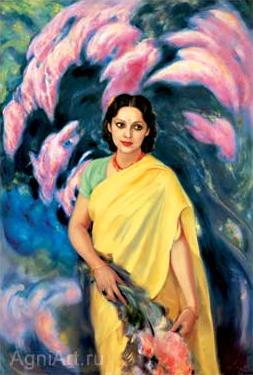
Dreaming on 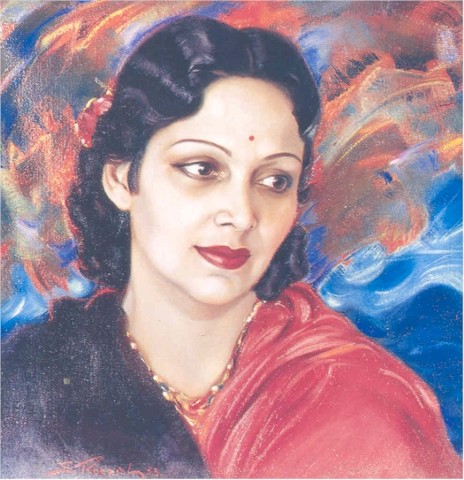
The classically beautiful Indian face. 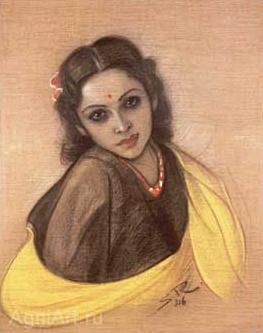
The coy maiden look
Noorie
Posted by: Reeth Mar 31 2007, 02:17 PM
Did you know that it was Devika Rani's b'day on the 30th of March? That was yesterday!
Here is some more info on her gathered from the Net:
D.O.B - 30th March 1908
Devika Rani came from a distinguished background, grand-niece of the Nobel Laureate Rabindranath Tagore, her father, Col. M.N. Chaudhuri, was the first Indian Surgeon-General of Madras.
She completed her early schooling in the early 1920s. She then studied drama at the Royal Academy of Dramatic Art (RADA) and the Royal Academy of Music in London where she won scholarships. In addition, she studied architecture, textile and decor design and apprenticed under Elizabeth Arden.
She married Indian producer and actor Himansu Rai in 1929. Together they starred in Karma the first Hindi sound film. They soon founded Bombay Talkies whose films challenged the caste system.
There she met Himanshu Rai and agreed to design the sets of his first production Light of Asia (1925).
They got married and after marriage they left for Germany where Rai made A Throw of Dice (1929) in collaboration with Germany's famous UFA Studio.
Rai made a bilingual Karma (1933) with Devika Rani in the lead and the two came to India. Here Rai and Devika Rani set up the famous Bombay Talkies Studio.
Under the painstaking supervision of Himanshu Rai, it purchased the most modern equipment from Germany. Franz Osten, director and a handful of technicians came down from England and Germany. By 1935, stream of Hindi productions began to emerge from Bombay Talkies Ltd. beginning with Jawani ki Hawa (1935), a murder mystery.
Devika Rani played the lead in most of these early productions. Their films were of a high technical standard and had a glossy look to them reminiscent of the films of MGM. (Devika Rani was lit up in a manner not unlike Greta Garbo!) In 1958, the President of India honoured Devika with a "Padma Shri". In 1970, she became the first recipient of the prestigious film prize Dadasaheb Phalke Award.
Devika Rani formed a successful team with Ashok Kumar, which ironically started due to a scandal as she eloped with her hero of Jawani ki Hawa, Najam-ul-Hussain. Rai found her and got her to come back and forgave her but not Hussain and Bombay Talkies Ltd. needed a new leading man. Rai's eyes fell on his laboratory assistant, Ashok Kumar.
The two of them starred in a series of films starting with Jeevan Naiya (1936) but it was Achut Kanya (1936), which capitulated Devika Rani and Ashok Kumar to big time fame. The love story between an untouchable girl and a Brahmin boy was both a critical and commercial success with critics going in raptures over Devika's performance.
Going with the trend she even sang her own songs in films with Main Ban Ki Chidiya with Ashok Kumar from Achut Kanya remembered till today. Devika Rani continued acting till 1943 and when Rai died in 1940 she took over the reins at Bombay Talkies. Among her discoveries at Bombay Talkies was Dilip Kumar.
But eventually the economics of filmmaking and tussles with other studio executives led her to take voluntary retirement. She married famed Russian painter Svetoslav Roerich and stayed at their huge estate near Bangalore in South India.
For her contribution to Indian Cinema, Devika Rani was the first ever recipient of the prestigious Dadasaheb Phalke award in 1970. She remained in Bangalore till her death in 1994. At her funeral Devika was given full state honours.
Here's a B/W still from one of her old movies.

Noorie
More info:
Devika Rani Chaudhuri Roerich is not only one of the most colourful personalities of India, but the darling of film fans of more than two generations. She is a gifted artiste, well versed in the techniques of film making. Indeed, she is verily a symbol of Satyam, Shivam, Sundaram (Truth, goodness and beauty).
Daughter of Col.M.N.Choudheri, I.M.S., and Mrs.Leela Choudheri, she was born in Waltair. Her father had a distinguished medical career and was the first Indian Surgeon General of Madras.
She was educated in England and while at School, she received a scholarship from the Royal Academy of Dramatic Arts and the Royal Academy of Music in London to study acting and music.
She took up the study of applied arts in London, specialising in textile designing and decor, and also studied architecture. At an early age, she was already earning her living as a textile designer at a leading art studio in London.
While in London in 1928, she met the well-known Indian producer Himanshu Rai who produced famous Indian films like "The Light of Asia", "Shiraz" and "A Throw of Dice" for Indian and international markets.
Mr.Rai persuaded Devika Rani to join his production unit, to further the cause of Indian films. She signed a contract in London with Mr.Bruce Wolfe who was then associated with Himansu Rai. She later returned to India with Himansu Rai and his English and German experts to work on "A Throw of Dice" which was scheduled for production for England, Germany and the Continent.
She worked on the costumes and sets of this production under the guidance of the art director Promod Roy and studied the art of production.
In 1929, she married Himansu Rai and returned with him to Germany. Mr.Rai was the only Indian producer with the famous German film concern U.F.A. in Berlin. At the U.F.A. Studios, Devika Rani learnt costumes designing, make-up, decor and other different branches of film production with special training in acting.
She apprenticed in the Eric Pommer production unit at U.F.A., where she studied the art and techniques of acting under the guidance of Germany's great director Pabst, and other famous directors.
She was a U.F.A. at the time of the epoch-making change over from silent to the talkie films, and with Himansu Rai had the rare opportunity of seeing and studying the various changes and experiments in the new talking pictures.
At the time, Devika Rani also acted with Himansu Rai in a play for U.F.A. which took them to Switzerland and the Scandinavian countries, where they were received with the highest honours.
She was also a student in the production unit of the famous State producer Max Heinhardt in Germany. From Germany, Devika Rani and Himansu Rai returned to India, to produce their first international talking picture "KARMA" in which Devika Rani, Himansu Rai, Princess Suda Rani of Burdwan and others acted. "KARMA" was produced both in English and Hindusthani and was completed at the Stall Studios in London. It was the first Indian talking picture in English and Hindusthani to be released in England and on the Continent as well as Indian.
"KARMA" was received with the highest approbation by the public of London. The premier was inaugurated by Lord Irwin and attended by the highest officials and England's most distinguished artiste. The same success was accorded to "KARMA" throughout Great Britain and wherever it was released.
The release of "KARMA" in India created a sensation, it was the beginning of a new era in Indian motion picture production.
It was in "KARMA" that Devika Rani established herself as a "star" of first magnitude.
During the screening of "KARMA", Devika Rani was honoured by an invitation of the B.B.C. at London to act in the first television broadcast in Britain which was relayed throughout the country. She was also chosen to inaugurate the first B.B.C. broadcast on the short wave length to India.
The Bombay Talkies Ltd., was founded by Himansu Rai and Devika Rani in 1934 in Malad, Bombay. It was a public limited company formed by eminent businessmen of Bombay including F.E.Dinhsaw, Sir Firoze Sethna and others. The advent of the Bombay Talkies gave an impetus to Indian films.
It was Himansu Rai's idea to attract to films the best elements of society as he believed that education and a cultured background where essential to achieve high standards in art.
The Bombay Talkies set a new standard in motion picture production in India on most up-to-date lines with experts from England, Germany, France who also trained young Indian men and women in the art and techniques of films production. It was responsible for a vast number of famous producers, directors, stars, musicians, writers, poets and technicians who even today rank among the best in the country.
Devika Rani was the star of the Bombay Talkies Ltd.
Her outstanding portrayals, her style of acting and new approach created a distinct form and tradition. She acted in numerous films, many of which have become classics of the Indian screen. Among her most famous pictures were "Jawani-Ki-Hawa", "Jeevan Nayya", "Achoot Kanya", "Savitri", "Jeevan Prabhat", "Durga", "Vachan", "Nirmala" and "Izzat".
She was acclaimed as India's greatest film actress, and was popularly known as the "First Lady of the Indian screen".
During this period, Devika Rani was the recipient of numerous honours, awards, medals and prizes from the film industry, the Press and the public.
After the death of the great founder of the Bombay Talkies Mr.Himanshu Rai in 1940, Devika Rani was made Controller of Production of the Bombay Talkies. She was a partner and also a producer of the concern. She was asked to assume the responsibility of management of the Bombay Talkies including the business.
As producer and controller of production of the company, Devika Rani continued the high standard of its productions with such outstanding success etc as in "Punarmilan", "Kangan", "Bandhan", "Basant", "Kismat", "Hamari Baat", etc.
The shares of the company rose to their highest level during this period. Among some of the outstanding artistes trained and presented for the first time on the screen during the period are such famous names as Leela Chitnis, Dilip Kumar, Madhubala, Mumtaz, Shanti, etc., as well as many outstanding technicians, producers, directors, story and screen writers and artistes who are among the most successful film personalities of today.
In 1945 at the height of her film career, Devika Rani decided to retire from the Bombay Talkies Ltd.
She married Dr.Svetoslav Roerich, she was a member of the Central Government Audio Visual Education Board. She was also nominated to the National Academy of Dance, Drama, Music and Films, the Sangeet Natak Akademi, Delhi, as a nominee of the Central Government and was a member of the Executive Board of the National Academy, Member of the Lalit Kala Akademi and the National Handicrafts Board and Member of the Indian Council for Cultural Relations.
On Republic Day, January 26, 1958, the President of India conferred the decoration of "PADMA SHRI" on Devika Rani for her valuable contribution to Indian motion picture.
On November 21, 1970, the Government of India conferred on Devika Rani the first Dadasaheb Phalke Award for her outstanding service to the film industry. Equally invaluable is the prestigious Soviet Land Nehru award conferred on her in 1989.
Here are some more stunningly beautiful stylized paintings of her by Roerich:

Dreaming on

The classically beautiful Indian face.

The coy maiden look
Noorie
Posted by: Reeth Apr 3 2007, 03:36 PM
dunno why she is called first leading lady of indian cinema..there were actresses before her too..ruby mayors(sulochana),who later played mother's roles too...was established actress
and what abt durga khote,shobhana samarth(i guess they made their debut at same time)
may be devika rani can be called first leading lady of talkies...
Because of the contributions she made and her stature, Devika Rani was called the First Lady of Indian cinema
Pradeep has given details about all the mentioned actresses in his article 'Sirens of the 30's and 40's'
i am just adding a few photographs here....
Shobana Samarth( 1915 - Feb 9, 2000)
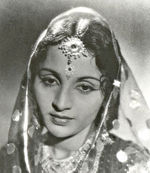
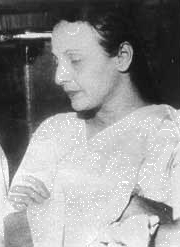
Naseem Bano( 1916 - 2002) Considered to be one of the most beautiful actresses ,was popularly called 'Pari Chehra'...
With her daughter Saira bano & dilip kumar
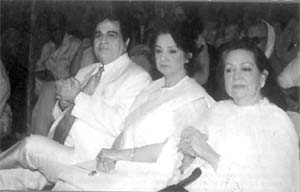
Kanan Devi ( 1916 - 1992 )One of the early singing stars..

Khurshid ( 1912- 2001) singing star of the late 30's and the 40's ....Acted wih Saigal, Motilal...
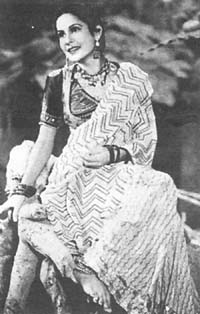
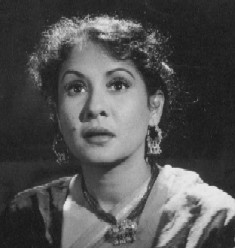
Sulochana or Ruby Myers ( 1907- 1983)She is one of the earliest female stars of Indian cinema..


Nadia ( 1908 - 1996) popularly known as Fearless Nadia...of Scottish, greek parents...famous as a stuntwoman..
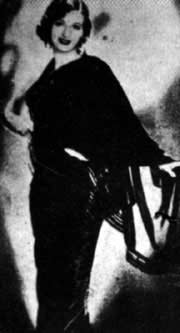

Posted by: Reeth Apr 5 2007, 01:47 PM
NOOR JAHAN
( September 21, 1926 - December 23,2000)
Noor Jehan was probably the Biggest singing star ever...until independence, after which she moved to Pakistan...She came from Kasur area of Punjab( now in Pakistan) she entered films as a child artiste, and continued to act in many punjabi films. She was fully trained in classical singing...In 1939 she acted in a prominent role in a Punjabi film " Gul e Bakhavali " which brought her a lot of fame as an actress also as a singer, and then she acted in her first hindi film " Khandaan" with Pran, which became a huge hit.....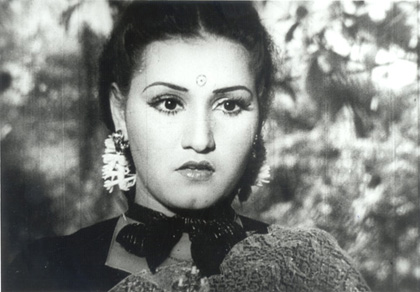
with Pran in Khandaan....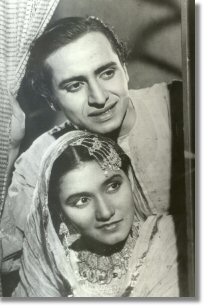
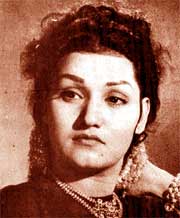
She married her Khandaan dirctor Syed Shaukat Hussain Rizvi, and shifted base to Bomabay....She became established as one of the four leading singing stars, the other three being Shanta Apte, Kanan Devi and Khursheed..
She acted in many hit films with hit music and was adored for both her acting and singing...
She reached her peak with 'Anmol ghadi' which had three singing stars......Suraiya , Surendra and Noor jehan herself......then came Jugnu with Dilip Kumar...
Anmol ghadi had Great songs like " Awaz de kahan..." " Jawan hai muhobat" and "Mere bachpan ke saathi".....and 'Yahan badla vafaa ka' sung with Mohammad Rafi' will be rememberd forever...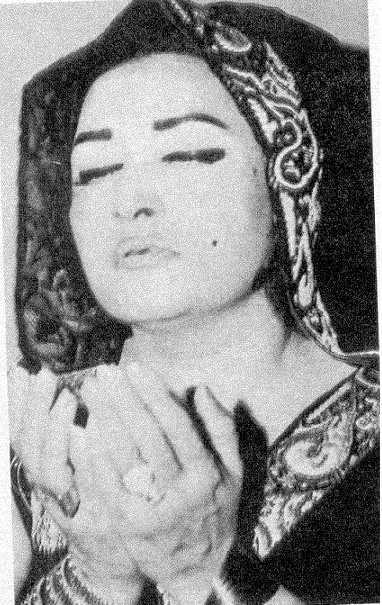
with Surendra in Anmol ghadi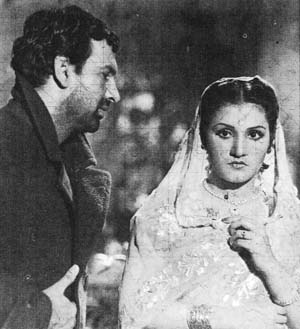
with Dilip kumar in jugnu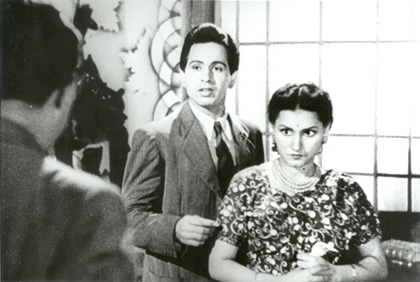
In 1945 she acted in a film 'Badi maa' with 'Baby Lata Mangeshkar' and 'Baby Asha Mangeshkar' in supporting roles...Noor jehan encouraged lata to sing and prdicted that she would become a sensational singer some day....
Lata mangeshkar admired and respected Noor Jehan . Lata's early singing was inspired by Noor jehan..
Some of Noor Jehan's memorable films wre
Khanddan
Badi maa
Dost
Village girl
Zeenat
Anmol Ghadi
jugnu
Mirza Sahibaan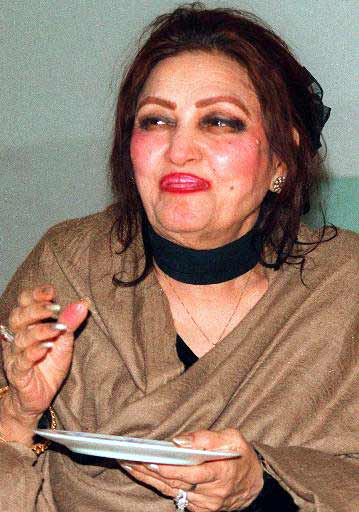
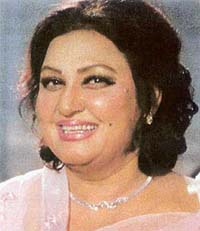
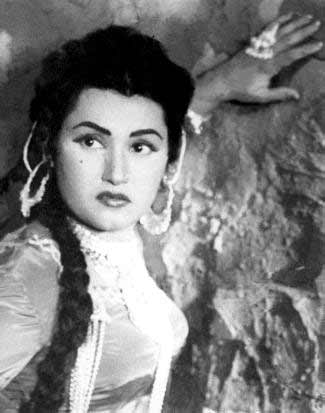
Noor Jehan migrated to Pakistan following partition...she wanted to be with the country where her birthplace Kasur was..
She went on to direct many films in Pakistan and sang many memorable songs...she hit the headlines many times for her many 'affairs' and marriages....
She came to India in 1982 to celebrate the Golden Jubilee of the Indian Talkie....
She was ailing for alnmost four years with protracted illness of the Heart and others and had to take treatment at various hospitals, and her last days were painful......On Dec 23, 2000, Noor Jehan died from Heart failure...leaving behind many Great memories and Melodies...
Attached image(s)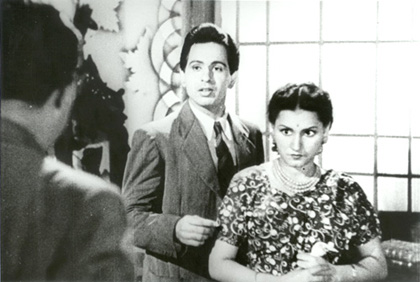
Posted by: harihar Apr 5 2007, 02:02 PM
Excellent stuff
Posted by: nasir Apr 5 2007, 09:45 PM
Thanks so much REETH for those picture as well as information.
By the way, speaking of yesteryear actress, do you have anything on REHANA? I haven't seen her name being mentioned as yet since the time I joined HF a year ago.
NASIR.
Posted by: Reeth Apr 7 2007, 02:31 PM
Thanks so much REETH for those picture as well as information.
By the way, speaking of yesteryear actress, do you have anything on REHANA? I haven't seen her name being mentioned as yet since the time I joined HF a year ago.
NASIR.
Nasir this is what i found on the net about Rehana........
REHANA
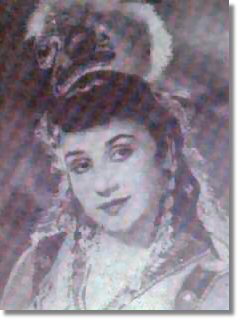
She appeared on the silver screen sometime in the late 30's acting in minor roles but soon took the cine world by storm....Made her major debut as a leading lady in "Hum Ek Hain" with Dev Anand...which was incidentally his first film too ...
With the exception of Dilip Kumar Rehana acted with all top heroes of her era...
Dilruba with dev Ananad
Sargam
and
sunehre Din with Raj kapoor
Cham chama cham with Kishore kumar
Sagai with Premnath
Actress with prem Adeeb
Adaa with Shekar
Some of the best Lata Mangeshkar songs were picturised on her...
Koi kisika deewana na baney.....Sargam
Zamaney ka dastoor hai yeh.....Laajawab
Tum kya jaano tumhari yaad mein.....Shin shinaki babla boo
Preetam mere duniya mein....Adaa
Mohobat mein aise .....Sagaai
Her memrable movies were...
Shehnai
Saajan
Sunehra Din
Sargam
Sagaai
Adaa
Dilruba
Shin shinaki babla boo....
After completing her last films in 1956," Delhi Darbaar "and "Qeemat ", she migrated to Pakistan....
She acted in a few films in Pakistan, but failed to impress......later married a film poducer...
She is widowed and leading a life of seclusion in pakistan now...
Posted by: HumTum Apr 7 2007, 02:59 PM
Reeth great job dost! ![]()
Who are you going to feature next?
Posted by: nasir Apr 7 2007, 10:38 PM
Thanks so much REETH for those picture as well as information.
By the way, speaking of yesteryear actress, do you have anything on REHANA? I haven't seen her name being mentioned as yet since the time I joined HF a year ago.
NASIR.
Nasir this is what i found on the net about Rehana........
REHANA

She appeared on the silver screen sometime in the late 30's acting in minor roles but soon took the cine world by storm....Made her major debut as a leading lady in "Hum Ek Hain" with Dev Anand...which was incidentally his first film too ...
With the exception of Dilip Kumar Rehana acted with all top heroes of her era...
Dilruba with dev Ananad
Sargam
and
sunehre Din with Raj kapoor
Cham chama cham with Kishore kumar
Sagai with Premnath
Actress with prem Adeeb
Adaa with Shekar
Some of the best Lata Mangeshkar songs were picturised on her...
Koi kisika deewana na baney.....Sargam
Zamaney ka dastoor hai yeh.....Laajawab
Tum kya jaano tumhari yaad mein.....Shin shinaki babla boo
Preetam mere duniya mein....Adaa
Mohobat mein aise .....Sagaai
Her memrable movies were...
Shehnai
Saajan
Sunehra Din
Sargam
Sagaai
Adaa
Dilruba
Shin shinaki babla boo....
After completing her last films in 1956," Delhi Darbaar "and "Qeemat ", she migrated to Pakistan....
She acted in a few films in Pakistan, but failed to impress......later married a film poducer...
She is widowed and leading a life of seclusion in pakistan now...
Seems even the songs you mentioned above are all mellifluous. Not to speak of those well-known movies.
Of course I don't remember seeing those movies except SHIN SHINAKI BUBALA BOO as a very small kid at the Imperial Theatre or perhaps the Swatik. But don't remember a thing from it. The title song of this movie I do remember the line. I wonder whether this was a mythical movie and whether the swashbuckling RANJAN was her hero.
I specially asked for REHANA's info since my dad had informed me that he had purchased the house of Rehana before her migration to Pakistan.
NASIR.
Posted by: Reeth Apr 10 2007, 03:53 PM
[quote name='HumTum' date='Apr 7 2007, 02:59 PM' post='359306']
Reeth great job dost! ![]()
Who are you going to feature next?
[/quote]
Nargis... ![]()
[quote name='nasir' date='Apr 7 2007, 10:38 PM' post='359442']
NASIR.
[/quote]
Seems even the songs you mentioned above are all mellifluous. Not to speak of those well-known movies.
Of course I don't remember seeing those movies except SHIN SHINAKI BUBALA BOO as a very small kid at the Imperial Theatre or perhaps the Swatik. But don't remember a thing from it. The title song of this movie I do remember the line. I wonder whether this was a mythical movie and whether the swashbuckling RANJAN was her hero.
I specially asked for REHANA's info since my dad had informed me that he had purchased the house of Rehana before her migration to Pakistan.NASIR.
[/quote]
Nasir,Are you still in posession of that house??
Posted by: Reeth Apr 10 2007, 05:14 PM
NARGIS ( June 1 1929 - 3 May 1981)
Nargis was one of the Greatest Indian Actresses of all times...She is undoubtedly one of the most powerful actresses in Indian cinema....
She was the daughter of Mohanbabu, a mohyaul brahmin from Rawalpindi, Pakistan and Jaddanbhai, who was a singer/actress....
Made her debut in 1935 in Talash e haq, and her first adult role was in Mehboob khan's 'Taqdeer' in 1943, opposite Motilal.Then came 'Humayun' and with ' Andaaz' and later 'Barsat' in 1949 she became a superstar.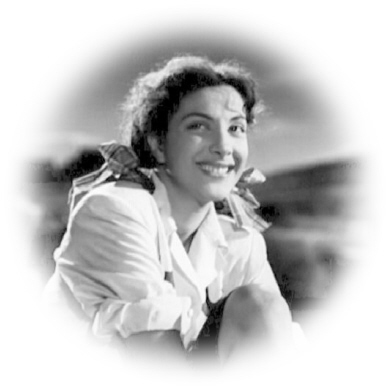
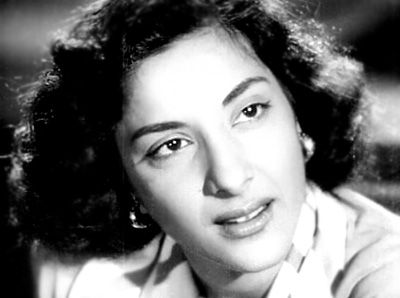
With Dilip Kumar and Cuckoo in "Andaz"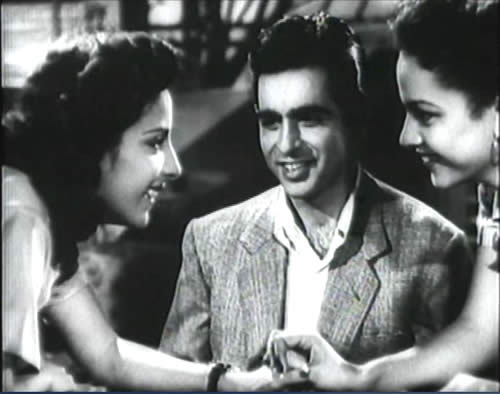
Nargis appeared in numerous movies with all the top leading actors Andaaz,Mela, Jogan,Babul and Deedar with Dilip Kumar... Off screen her affair with the already married Raj Kapoorwas a matching of soul and spirit....After Awaara in 1951 she began to work exclusively with him...they did Aag Beawafaa,Shri 420, and Chori Chori....She is supposed to have turned down the role of 'Aan'..
The passion they had for each other poured out on the screen as they romanced each other in several films..Nargis even went and met the then Home Minister Morarji desai to try and get him to sanction a marriage between her and Raj kapoor.The affair was doomed, as Raj kapoor never wanted to divorce his wife..By 1956 the pair had broken up......She however did a special appearence in his 'Jagte Raho' in 1956..
At the height of their romnce....Raj kapoor, Nargis in Shri 420...
Raj kapoor Nargis in 'Awaara'...
With raj kapoor and Dilip kumar in 'Andaaz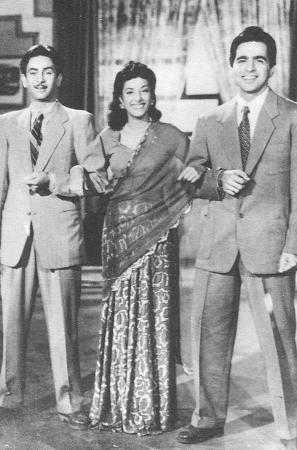
With Raj Kapoor out of her life , Mehbob Khan offered her his Magnum opus " Mother India" in 1957.
Mother India is considered to be the ultimate tribute to Indian Womanhood! It was nominated for the Oscar, but lost by a solitary vote to Fellini's Nights of Caberia
While shooting for the film she was trapped amidst lit haystacks, was rescued by Sunil Dutt who was playing her rebellious son in the film....They fell in love during the making of the movie and married in 1958....
They have 3 children actor Sanjay Dutt, Priya and Anju...Nargis gave up acting after her marriage....
She came back with a Brilliant performance in 'Raat aur Din' expertly playing a woman with split personality winning the National award for the same in 1964..
Mother India.....some images...
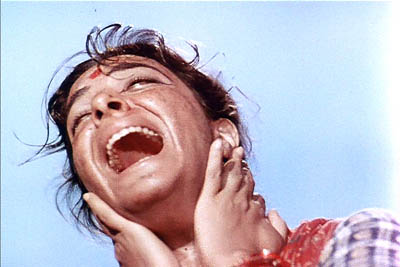
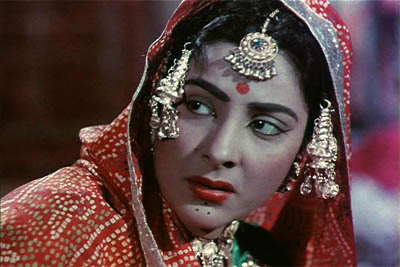
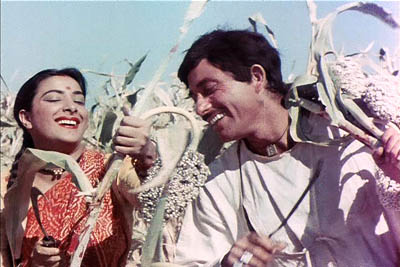
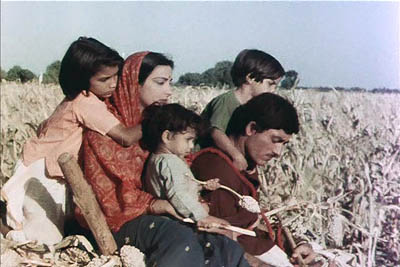
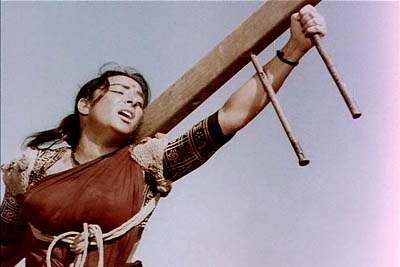

Her memorable films were
Mela
Anokha pyar
Aag
Lahore
Barsaat
Andaz
Pyar
Meena bazar
Jogan
Bewafa
Aashiana
Anhonee
Deedar
Amber
Shikast
Angaarey
Shri 420
Jagte Raho
Chori chori
Lajwanti
Ghar Sansar
Adaalat
Mother India
Raat aur Din....
She was the recipient of the Urvashy award the highest honour that can be conferred on a movie actress in India.
She was the first film personality to be conferred the 'Padmashri' and she was the first film personality to be given a Rajya sabha seat in parliament..
She has been honoured as the Best Artiste of the Millenium.......
Nargis died of Pancreatic cancer in 1981.....
Attached image(s)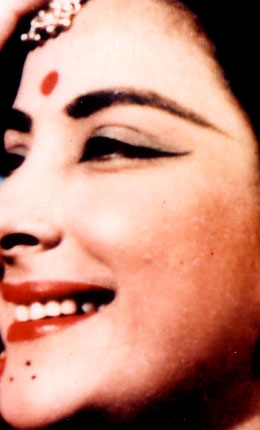
Posted by: nasir Apr 11 2007, 05:12 PM
[quote name='Reeth' date='Apr 10 2007, 03:53 PM' post='360284']
[quote name='HumTum' date='Apr 7 2007, 02:59 PM' post='359306']
Reeth great job dost! ![]()
Who are you going to feature next?
[/quote]
Nargis... ![]()
[quote name='nasir' date='Apr 7 2007, 10:38 PM' post='359442']
NASIR.
[/quote]
Seems even the songs you mentioned above are all mellifluous. Not to speak of those well-known movies.
Of course I don't remember seeing those movies except SHIN SHINAKI BUBALA BOO as a very small kid at the Imperial Theatre or perhaps the Swatik. But don't remember a thing from it. The title song of this movie I do remember the line. I wonder whether this was a mythical movie and whether the swashbuckling RANJAN was her hero.
I specially asked for REHANA's info since my dad had informed me that he had purchased the house of Rehana before her migration to Pakistan.NASIR.
[/quote]
Nasir,Are you still in posession of that house??
[/quote]
Not today. The fact is that he used to move a lot in and around Bombay itself. But during that period he had many filmy friends and I was a very small kid. Now since you have come up with Nargis..I'll disclose something in that section too.
NASIR.
Posted by: nasir Apr 11 2007, 05:32 PM
I had seen Nargis closely for fleeting moments as a kid at a time when her romance with Sunil Dutt was flowering. (That would be 1957 or so). We were at that time staying at Napean Sea Road, Bombay. In my hazy memory I remember to have seen Sunil Dutt with a black Fiat and looked so dashing and handsome no doubt.
In my opinion, the break-up of RK-Nargis alliance was for the betterment of Nargis: She found true love in Sunil Dutt who had risked his life to save hers during the shooting of MOTHER INDIA - the episode that everyone knows about. It was otherwise too very courageous of Sunil Dutt to marry her since after having played the role of her son. That time some narrow-minded people did not fail to criticise him for playing the role of a son and then marrying her. But this was the happiest of star-couples.
NASIR.
Posted by: Reeth Apr 11 2007, 06:37 PM
I had seen Nargis closely for fleeting moments as a kid at a time when her romance with Sunil Dutt was flowering. (That would be 1957 or so). We were at that time staying at Napean Sea Road, Bombay. In my hazy memory I remember to have seen Sunil Dutt with a black Fiat and looked so dashing and handsome no doubt.
In my opinion, the break-up of RK-Nargis alliance was for the betterment of Nargis: She found true love in Sunil Dutt who had risked his life to save hers during the shooting of MOTHER INDIA - the episode that everyone knows about. It was otherwise too very courageous of Sunil Dutt to marry her since after having played the role of her son. That time some narrow-minded people did not fail to criticise him for playing the role of a son and then marrying her. But this was the happiest of star-couples.
NASIR.
Sunil dutt was a gentleman actor, i like watching his films, Humraaz, Waqt, Mera saaya and Chaaya are the few i have seen.........they must have been very happy together......and Nargis was the kind of person one looked upto, there was more to her than being just an actress....
Posted by: nasir Apr 12 2007, 06:28 PM
I had seen Nargis closely for fleeting moments as a kid at a time when her romance with Sunil Dutt was flowering. (That would be 1957 or so). We were at that time staying at Napean Sea Road, Bombay. In my hazy memory I remember to have seen Sunil Dutt with a black Fiat and looked so dashing and handsome no doubt.
In my opinion, the break-up of RK-Nargis alliance was for the betterment of Nargis: She found true love in Sunil Dutt who had risked his life to save hers during the shooting of MOTHER INDIA - the episode that everyone knows about. It was otherwise too very courageous of Sunil Dutt to marry her since after having played the role of her son. That time some narrow-minded people did not fail to criticise him for playing the role of a son and then marrying her. But this was the happiest of star-couples.
NASIR.
Sunil dutt was a gentleman actor, i like watching his films, Humraaz, Waqt, Mera saaya and Chaaya are the few i have seen.........they must have been very happy together......and Nargis was the kind of person one looked upto, there was more to her than being just an actress....
Yes, Nargis was no snob and didn't have airs despite her very high standing in the film industry. Sunil Dutt was a doting husband. And yes, as you stated, he was a gentleman actor. That quality of his did not diminish even in his political field. Even as an MLA from Bandra to Versova area in Mumbai he was accessible to ordinary folks and did actual work for their cause. I used to attend his meetings in the playground of the VERSOVA WELFARE SCHOOL at 7 Bungalows, Mumbai where I had been then staying.
NASIR.
Posted by: YaarMere Apr 12 2007, 06:35 PM
Wot on earth did she see in RK that she did not see in DK?
Posted by: noorie Apr 12 2007, 06:57 PM
Wot on earth did she see in RK that she did not see in DK?
What she and RK felt or allegedly felt, there’s a name 4 that – infatuation.
Reason doesn’t work there.
Noorie
Posted by: YaarMere Apr 12 2007, 06:59 PM
I assure you Dilip wudnt have married her.
Posted by: noorie Apr 12 2007, 07:04 PM
I assure you Dilip wudnt have married her.
What's a wedding ring got 2 do with 'true love'?
Noorie
Posted by: YaarMere Apr 12 2007, 07:07 PM
You said "infatuation", and 4rom my experience that never lasts. Toughts?
Posted by: noorie Apr 12 2007, 07:12 PM
You said "infatuation", and 4rom my experience that never lasts. Toughts?
Sum 'infatuations' last 4ever. Not all folks get 2 experience that.
Noorie
Posted by: YaarMere Apr 12 2007, 07:19 PM
Lucky them.
Posted by: noorie Apr 12 2007, 07:29 PM
Lucky them.
Unlucky spouses though!
Noorie
Posted by: YaarMere Apr 12 2007, 07:35 PM
Wot are we talking abt? I mean Im just guttted that DK didnt bed her and you're going on abt wot?
Posted by: Reeth Apr 13 2007, 01:10 AM
Wot are we talking abt? I mean Im just guttted that DK didnt bed her and you're going on abt wot?
Welcome back YM
Posted by: YaarMere Apr 13 2007, 03:44 AM
( much married?)
Very much so. Thanks.
Am gonna try and change myself now and hopefully it'll be 4 the better but baby steps tho Reeth
Posted by: nasir Apr 13 2007, 09:35 PM
Wot on earth did she see in RK that she did not see in DK?
A Million Dollar question YAARMERE....
What indeed she see in him - a much married man while DK was the most eligible bachelor till as late he celebrated his 44th birthday.
This calls for analysis based on their performance together right from 1948 MELA, then 1949 ANDAAZ, JOGAN and BABUL 1950 and DEEDAR 1951, BABUL 1952 where Dilip keeps on losing her. So also in HULCHAL. Much has also to do with AAN 1952.
NASIR.
Posted by: Reeth Apr 14 2007, 12:03 AM
Wot on earth did she see in RK that she did not see in DK?
A Million Dollar question YAARMERE....
What indeed she see in him - a much married man while DK was the most eligible bachelor till as late he celebrated his 44th birthday.
This calls for analysis based on their performance together right from 1948 MELA, then 1949 ANDAAZ, JOGAN and BABUL 1950 and DEEDAR 1951, BABUL 1952 where Dilip keeps on losing her. So also in HULCHAL. Much has also to do with AAN 1952.
NASIR.
I guess at that stage ,Dilip Kumar had better things on his mind...
Posted by: YaarMere Apr 14 2007, 12:11 AM
Sunil Dutt ji ka khayal aa gaya so I wont say anything now, otherwise damn Nargis.
Posted by: Reeth Apr 14 2007, 12:16 AM
( much married?)
Very much so. Thanks.
Am gonna try and change myself now and hopefully it'll be 4 the better but baby steps tho Reeth
Great news YM celebrations all round
Posted by: YaarMere Apr 14 2007, 12:39 AM
W8 untill you get married.
I'll tell you a story. few days back I came home and as soon as I turned the key to open the door my cousins were there, they're only kids, they came running (the ice-cream van was parked outside) and started pestering me "ice-cream, ice-cream le ke do" and Im like "pese nahi hai jao Sheetal (ever since I saw that Dilip film I vowed to called my wife by that name) mango." The elder 1 says: woh kyun hai? In a heartbeat I reply "bete woh jo nai kaam karnewali laye hein, woh" and while I was still sayin that I walked into the living room to find my in-laws sitting there. Needless to say that that I put myself in reverse gear and went out to get them their ice-cream. Its little things like that need changing.
Posted by: Reeth Apr 14 2007, 12:46 AM
W8 untill you get married.
I'll tell you a story. few days back I came home and as soon as I turned the key to open the door my cousins were there, they're only kids, they came running (the ice-cream van was parked outside) and started pestering me "ice-cream, ice-cream le ke do" and Im like "pese nahi hai jao Sheetal (ever since I saw that Dilip film I vowed to called my wife by that name) mango." The elder 1 says: woh kyun hai? In a heartbeat I reply "bete woh jo nai kaam karnewali laye hein, woh" and while I was still sayin that I walked into the living room to find my in-laws sitting there. Needless to say that that I put myself in reverse gear and went out to get them their ice-cream. Its little things like that need changing.
Posted by: desai2rn Apr 14 2007, 03:54 AM
Wot on earth did she see in RK that she did not see in DK?
A Million Dollar question YAARMERE....
What indeed she see in him - a much married man while DK was the most eligible bachelor till as late he celebrated his 44th birthday.
This calls for analysis based on their performance together right from 1948 MELA, then 1949 ANDAAZ, JOGAN and BABUL 1950 and DEEDAR 1951, BABUL 1952 where Dilip keeps on losing her. So also in HULCHAL. Much has also to do with AAN 1952.
NASIR.
I guess we will never know. As they say love is blind. Other than the fact that Rk was married and DK was
bachelor, they were both powerful personalites. DK it seems could not decide who he wanted to be with.
If I am not wrong he had affairs with Kamini Kaushal (married ??), Madhubala etc. Just when people thougt
he would settle down with Waheeda Rehman ( would have been nice couple) he marries Saira??
Posted by: nasir Apr 14 2007, 10:39 PM
Wot on earth did she see in RK that she did not see in DK?
A Million Dollar question YAARMERE....
What indeed she see in him - a much married man while DK was the most eligible bachelor till as late he celebrated his 44th birthday.
This calls for analysis based on their performance together right from 1948 MELA, then 1949 ANDAAZ, JOGAN and BABUL 1950 and DEEDAR 1951, BABUL 1952 where Dilip keeps on losing her. So also in HULCHAL. Much has also to do with AAN 1952.
NASIR.
I guess we will never know. As they say love is blind. Other than the fact that Rk was married and DK was
bachelor, they were both powerful personalites. DK it seems could not decide who he wanted to be with.
If I am not wrong he had affairs with Kamini Kaushal (married ??), Madhubala etc. Just when people thougt
he would settle down with Waheeda Rehman ( would have been nice couple) he marries Saira??
But the fate willed that DK marry Saira. And what a lovely couple they made. They both deserved each other. Many film personalities could not even digest the thought. (A friend of mine who was in the Baraat did here some snide remarks from an eminent film personality). But as they say: KOI JAL GAYA AUR KISI NE DUA' DEE.....May this pair bloom for many many years to come.
NASIR.
Posted by: nasir Apr 14 2007, 10:42 PM
Wot on earth did she see in RK that she did not see in DK?
A Million Dollar question YAARMERE....
What indeed she see in him - a much married man while DK was the most eligible bachelor till as late he celebrated his 44th birthday.
This calls for analysis based on their performance together right from 1948 MELA, then 1949 ANDAAZ, JOGAN and BABUL 1950 and DEEDAR 1951, BABUL 1952 where Dilip keeps on losing her. So also in HULCHAL. Much has also to do with AAN 1952.
NASIR.
I guess we will never know. As they say love is blind. Other than the fact that Rk was married and DK was
bachelor, they were both powerful personalites. DK it seems could not decide who he wanted to be with.
If I am not wrong he had affairs with Kamini Kaushal (married ??), Madhubala etc. Just when people thougt
he would settle down with Waheeda Rehman ( would have been nice couple) he marries Saira??
But the fate willed that DK marry Saira. And what a lovely couple they made. They both deserved each other. Many film personalities could not even digest the thought. (A friend of mine who was in the Baraat did hear some snide remarks from an eminent film personality). But as they say: KOI JAL GAYA AUR KISI NE DUA' DEE.....May this pair bloom for many many years to come.
NASIR.
Posted by: Reeth Apr 16 2007, 06:57 PM
Wot on earth did she see in RK that she did not see in DK?
A Million Dollar question YAARMERE....
What indeed she see in him - a much married man while DK was the most eligible bachelor till as late he celebrated his 44th birthday.
This calls for analysis based on their performance together right from 1948 MELA, then 1949 ANDAAZ, JOGAN and BABUL 1950 and DEEDAR 1951, BABUL 1952 where Dilip keeps on losing her. So also in HULCHAL. Much has also to do with AAN 1952.
NASIR.
I guess we will never know. As they say love is blind. Other than the fact that Rk was married and DK was
bachelor, they were both powerful personalites. DK it seems could not decide who he wanted to be with.
If I am not wrong he had affairs with Kamini Kaushal (married ??), Madhubala etc. Just when people thougt
he would settle down with Waheeda Rehman ( would have been nice couple) he marries Saira??
But the fate willed that DK marry Saira. And what a lovely couple they made. They both deserved each other. Many film personalities could not even digest the thought. (A friend of mine who was in the Baraat did hear some snide remarks from an eminent film personality). But as they say: KOI JAL GAYA AUR KISI NE DUA' DEE.....May this pair bloom for many many years to come.
NASIR.
I was going through some very old Filmfare magazines......happened to read that Nasim bano was very keen on Saira tying the knot with Nawab of Pataudi, this was before Sharmila Tagore came into the scene....
she( Nasim Bano) was initially opposed to Saira marrying Dilip kumar bec of the vast age difference between the 2...22 yrs or so........no matter what,they look good together
Posted by: nasir Apr 16 2007, 09:31 PM
Wot on earth did she see in RK that she did not see in DK?
A Million Dollar question YAARMERE....
What indeed she see in him - a much married man while DK was the most eligible bachelor till as late he celebrated his 44th birthday.
This calls for analysis based on their performance together right from 1948 MELA, then 1949 ANDAAZ, JOGAN and BABUL 1950 and DEEDAR 1951, BABUL 1952 where Dilip keeps on losing her. So also in HULCHAL. Much has also to do with AAN 1952.
NASIR.
I guess we will never know. As they say love is blind. Other than the fact that Rk was married and DK was
bachelor, they were both powerful personalites. DK it seems could not decide who he wanted to be with.
If I am not wrong he had affairs with Kamini Kaushal (married ??), Madhubala etc. Just when people thougt
he would settle down with Waheeda Rehman ( would have been nice couple) he marries Saira??
But the fate willed that DK marry Saira. And what a lovely couple they made. They both deserved each other. Many film personalities could not even digest the thought. (A friend of mine who was in the Baraat did hear some snide remarks from an eminent film personality). But as they say: KOI JAL GAYA AUR KISI NE DUA' DEE.....May this pair bloom for many many years to come.
NASIR.
I was going through some very old Filmfare magazines......happened to read that Nasim bano was very keen on Saira tying the knot with Nawab of Pataudi, this was before Sharmila Tagore came into the scene....
she( Nasim Bano) was initially opposed to Saira marrying Dilip kumar bec of the vast age difference between the 2...22 yrs or so........no matter what,they look good together
Never heard of the Nawab of Pataudi angle, Reeth Though at one time word did go round that Rajendra Kumar was a contender and that hastened Nasim Banu to marry Saira off to Dilip Kumar.
At the time of her LIFETIME ACHIEVEMENT Award, Saira confided to the audience that it was from the age of twelve that she wanted to marry Dilip Kumar. That scene was very poignant with Dilip Kumar literally in tears (SIGH!)
NASIR.
NASIR.
Posted by: noorie Apr 17 2007, 08:35 PM
RK
NASIR.
Wonder what everyone sees in RK? He’s hideous if you ask me.
Noorie
Posted by: desai2rn Apr 17 2007, 08:59 PM
RK
NASIR.
Wonder what everyone sees in RK? He’s hideous if you ask me.
Noorie
You seem highly Opinionated. !!!!
Raj Kapoor is todate one of the most popular Legend in HF.
A complete film maker if there was ever one in Bollwood.
One of the best Actor/director/producer.
Posted by: noorie Apr 17 2007, 10:38 PM
RK
NASIR.
Wonder what everyone sees in RK? He’s hideous if you ask me.
Noorie
You seem highly Opinionated. !!!!
So I am !
Wud sumone please teach me how 2 sugar-coat the truth ? I'll be very grateful.
Noorie
Posted by: nasir Apr 17 2007, 10:42 PM
RK
NASIR.
Wonder what everyone sees in RK? He’s hideous if you ask me.
Noorie
You seem highly Opinionated. !!!!
So I am !
Wud sumone please teach me how 2 sugar-coat the truth ? I'll be very grateful.
Noorie
But there must be some reasons surely for "bitter truth?"
Nasir.
Posted by: noorie Apr 18 2007, 03:06 AM
RK
NASIR.
Wonder what everyone sees in RK? He’s hideous if you ask me.
Noorie
You seem highly Opinionated. !!!!
So I am !
Wud sumone please teach me how 2 sugar-coat the truth ? I'll be very grateful.
Noorie
But there must be some reasons surely for "bitter truth?"
Nasir.
Plenty!
Let's say that unlike DK, RK cud never manage 2 look like a gentleman.
Didn't look the part, cudn't play the part either. Not even in his personal life.
Noorie
Posted by: desai2rn Apr 18 2007, 05:08 AM
RK
NASIR.
Wonder what everyone sees in RK? He’s hideous if you ask me.
Noorie
You seem highly Opinionated. !!!!
So I am !
Wud sumone please teach me how 2 sugar-coat the truth ? I'll be very grateful.
Noorie
But there must be some reasons surely for "bitter truth?"
Nasir.
Plenty!
Let's say that unlike DK, RK cud never manage 2 look like a gentleman.
Didn't look the part, cudn't play the part either. Not even in his personal life.
Noorie
Since when did your opinion become truth, bitter or sweet.
I happen to be a fan of both DK and RK so I have no intention of comparing their talents and personalities.
They are both great acotrs in their own rights and that is not even debatable in my opinion.
Prefrence is another matter.
But you seem prejudice towards RK.
I have seen plenty of RK movies and interviews and came across as intelligent, articulate, courteous
and friendly. Their personal lives are thier personal. If you dig enough you will find problems with
most bollywood/hollywood and otherwood personalites and these days it is true for lot of other fields too.
Posted by: Reeth Apr 19 2007, 03:11 AM
SURAIYA (June 15, 1929 - January 31, 2004
Suriya was perhaps the last of the Great singing stars...Born in Lahore, she was an only child.She began her acting career by playing bit roles as a child artiste,between the years 1937-1941.Her major film was TajMahal in 1941.....She did playback as a 13 year old for actress Mehtaab in Sharda(1942)
She was launched as a singing star in Bombay talkies Hamaari Baat(1943).She initially started by playing powerful secondary roles in films like Phool, Anmol Ghadi and Dard,..Her singing career found a mentor in music maestro naushad...K.L.Saigal recommended her as heroine for Tadbir in 1945,she co starred with Saigal in Omar Khayyam and Parwana. In 1947 after the partition when Major actresses Noor jehan and Khurshid migrated to Pakistan, more opportunities appeared for Suraiya....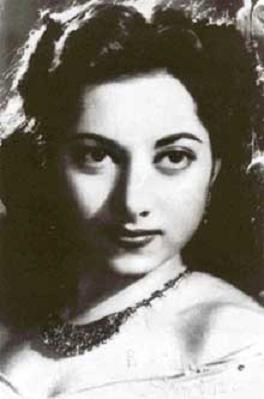
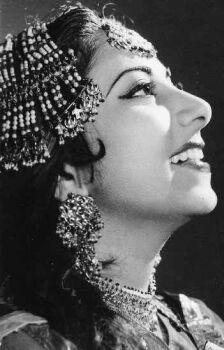
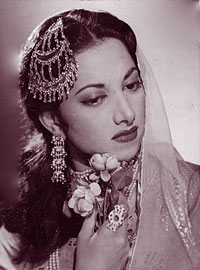
The Year 1948 - 1949 were the best for her career...She had three major hits Pyar ki Jeet, Badi bahen and Dillagi and she became the highest paid Female Star.At her peak Suriaya generated hysteria among the masses...Her songs were a craze....Her songs like Tere nainon ne chori kiya, Woh paas rahe ya door rahe...Bigdi bananewale, murliwale murli bajaa were hummed in every nook and corner of the country..

while shooting for the film Vidya Suraiya fell in love with Dev Anand and the two of them did six films together....Afsar,shayar,Do sitare,Jeet,Nili , none of them hits, suraiya had no regrets as their love flourished...But suraiya's grandmother opposed the relationship . Suraiya remained unmarried all her life...Their love story was the stuff legends are made of...
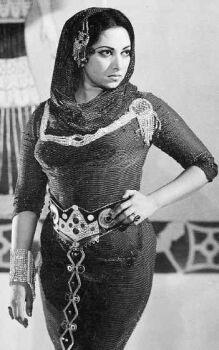
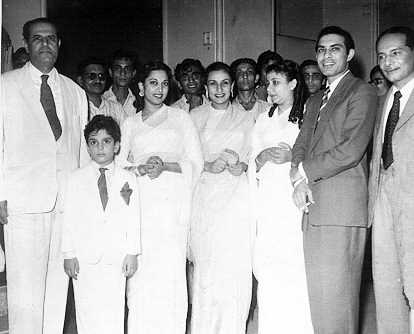

She made a hit pair with Talat mehmood in movies like Maalik and Waris.... In 1954 she gave her finest dramatic performance in Mirza Ghalib, in the role of a courtesan, the married Ghalib's lover.....her songs in this film are eternal classics...Yeh na thi hamare kismat, Dil e naadan tujhe hua kya hai..
Some of her memorable films
Anmolghadi pyar ki jeet
Waris
Afsar
Sanam
Malik
Mirza Ghalib
Deewana
Mashooqa
Vidya
Shama
Rustom Sohrab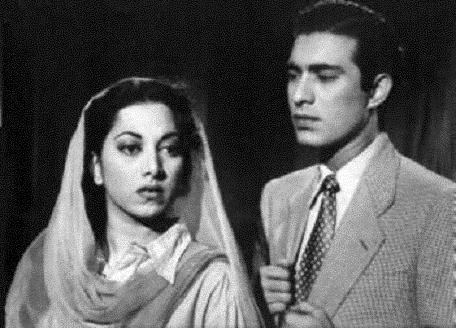
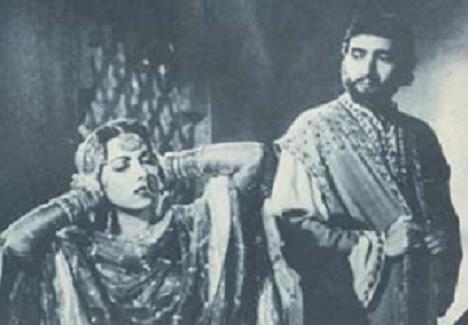
Suraiya's films startrd flopping in the fifties.....followed some indifferent films, and finally in 1963 after acting in Rustom Soharb with Prithviraj Kapoor she bade farewell to the studios....
She retreated into a world surrounded by her close family..
She died in 2004 ,at the age of 75....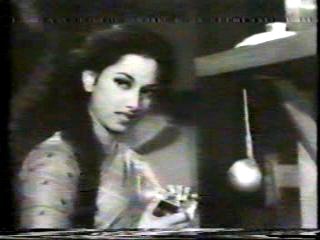
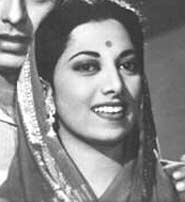

Suriya's Films and songs continue to thrive on speculations,lore and memories....
Posted by: parag_sankla Apr 19 2007, 03:55 AM
Reeth, thank you for this excellent piece of write-up with great pictures...
Cheers
Parag
Posted by: desai2rn Apr 19 2007, 07:47 AM
So far I have been able to see Mirza Ghalib with Bharat Bushan.
She was very impressive as was Bharat Bushan as Ghalib.
Great songs by Suraiya, talat, and Rafi saab.
Posted by: Reeth Apr 19 2007, 06:12 PM
Reeth, thank you for this excellent piece of write-up with great pictures...
Cheers
Parag
Most welcome parag......
Posted by: Reeth Apr 19 2007, 06:14 PM
So far I have been able to see Mirza Ghalib with Bharat Bushan.
She was very impressive as was Bharat Bushan as Ghalib.
Great songs by Suraiya, talat, and Rafi saab.
I have seen a few songs from Mirza Ghalib ......Anmol ghadi is the only film i have seen and to be frank i found her much more charming than Noor Jehan.
Posted by: YaarMere Apr 19 2007, 06:16 PM
Reeth? 1 or 2 pages on Rakhee Gulzar plz coz acting wise, no1 was like her!
Posted by: Reeth Apr 19 2007, 06:20 PM
Reeth? 1 or 2 pages on Rakhee Gulzar plz coz acting wise, no1 was like her!
Sure yaar.........
Posted by: YaarMere Apr 19 2007, 06:33 PM
Yaar Mera. Thatz the only film of Rakhee Ive seen where she is young enuff to play the lead heroine the rest of the time Ive seen doing mother roles or you know the 'elder' role and thatz where she excels!
I seen this film once where she plays the part of very young Akshay Kumar's mum and there is another greast actor in Mukesh Khanna (wotever happened to him??) playin a young Karisma Kapoor's father, I 4get the film's name but my word Rakhee rules!
Posted by: desai2rn Apr 19 2007, 07:32 PM
So far I have been able to see Mirza Ghalib with Bharat Bushan.
She was very impressive as was Bharat Bushan as Ghalib.
Great songs by Suraiya, talat, and Rafi saab.
I have seen a few songs from Mirza Ghalib ......Anmol ghadi is the only film i have seen and to be frank i found her much more charming than Noor Jehan.
I have yet to see a Noor Jehan movie but I tend to agree with you.
As for singing I prefer her over NJ.
Posted by: nasir Apr 19 2007, 10:30 PM
RK
NASIR.
Wonder what everyone sees in RK? He’s hideous if you ask me.
Noorie
You seem highly Opinionated. !!!!
So I am !
Wud sumone please teach me how 2 sugar-coat the truth ? I'll be very grateful.
Noorie
But there must be some reasons surely for "bitter truth?"
Nasir.
Plenty!
Let's say that unlike DK, RK cud never manage 2 look like a gentleman.
Didn't look the part, cudn't play the part either. Not even in his personal life.
Noorie
Your answer immediately brought before me Dilip Kumar's characters of MANGAL (INSANIYAT), MR. DALIP (ANDAZ), and SHAAMU (DEEDAR). These characters amplify your reply Noorie.
NASIR.
Posted by: NATURE Apr 20 2007, 10:45 AM
reeth, o reeth. where do you get all the informations man ? it's awesome.
thank you very much. write something on deepti naval, smita patil, mousumi(the honey) ...


suraiya is very gorgeous. the 2nd photo is a class one. in the first one, i like her hair.
Reeth? 1 or 2 pages on Rakhee Gulzar plz coz acting wise, no1 was like her!
yeah, yeah. i demand the same. rakhee is adorable. i like her eyes, lips and cheeks.
gulzar connection too. he is someone i take my hat off to.
Posted by: Reeth Apr 21 2007, 02:00 AM
reeth, o reeth. where do you get all the informations man ? it's awesome.
thank you very much. write something on deepti naval, smita patil, mousumi(the honey) ...


suraiya is very gorgeous. the 2nd photo is a class one. in the first one, i like her hair.
Reeth? 1 or 2 pages on Rakhee Gulzar plz coz acting wise, no1 was like her!
yeah, yeah. i demand the same. rakhee is adorable. i like her eyes, lips and cheeks.
gulzar connection too. he is someone i take my hat off to.
Thank you NATURE......Most of the material i get from the net...you know this hs been a learning process for me....i knew very little about hindi films and actors,but after joining hf i started developing an interest in them......and i find the older films,actors and songs definitely much much more interesting.....
Posted by: RafiKiAwaaz Apr 22 2007, 12:27 AM
RK
NASIR.
Wonder what everyone sees in RK? He’s hideous if you ask me.
Noorie
You seem highly Opinionated. !!!!
So I am !
Wud sumone please teach me how 2 sugar-coat the truth ? I'll be very grateful.
Noorie
The truth as you know it or do you have the ownership on truth. What do you don't give the credit where the credit is due, he made great strides in his career, he just didn't pop out of no where. I love Dilip Kumar as a great actor but he is NOT the only one. What one sees in one is their choice, so try to be FAIR not just blur out your great thoughts.
RKA
Posted by: noorie Apr 22 2007, 12:40 AM
The truth as you know it or do you have the ownership on truth. What do you don't give the credit where the credit is due, he made great strides in his career, he just didn't pop out of no where. I love Dilip Kumar as a great actor but he is NOT the only one. What one sees in one is their choice, so try to be FAIR not just blur out your ignorant thoughts.
RKA
I was stating my opinion;that doesn't mean everyone has 2 agree with it.
As 4 not being competent enough 2 comment on him; allow me 2 be the judge of that.
Reason? I've seen all of his celebrated and not so celebrated movies - acted, directed and produced; this isn't a vain boast either.
Noorie
Posted by: Ummer Apr 22 2007, 07:40 AM
Thanks so much REETH for those picture as well as information.
By the way, speaking of yesteryear actress, do you have anything on REHANA? I haven't seen her name being mentioned as yet since the time I joined HF a year ago.
NASIR.
Nasir this is what i found on the net about Rehana........
REHANA

She appeared on the silver screen sometime in the late 30's acting in minor roles but soon took the cine world by storm....Made her major debut as a leading lady in "Hum Ek Hain" with Dev Anand...which was incidentally his first film too ...
With the exception of Dilip Kumar Rehana acted with all top heroes of her era...
Dilruba with dev Ananad
Sargam
and
sunehre Din with Raj kapoor
Cham chama cham with Kishore kumar
Sagai with Premnath
Actress with prem Adeeb
Adaa with Shekar
Some of the best Lata Mangeshkar songs were picturised on her...
Koi kisika deewana na baney.....Sargam
Zamaney ka dastoor hai yeh.....Laajawab
Tum kya jaano tumhari yaad mein.....Shin shinaki babla boo
Preetam mere duniya mein....Adaa
Mohobat mein aise .....Sagaai
Her memrable movies were...
Shehnai
Saajan
Sunehra Din
Sargam
Sagaai
Adaa
Dilruba
Shin shinaki babla boo....
After completing her last films in 1956," Delhi Darbaar "and "Qeemat ", she migrated to Pakistan....
She acted in a few films in Pakistan, but failed to impress......later married a film poducer...
She is widowed and leading a life of seclusion in pakistan now...
Seems even the songs you mentioned above are all mellifluous. Not to speak of those well-known movies.
Of course I don't remember seeing those movies except SHIN SHINAKI BUBALA BOO as a very small kid at the Imperial Theatre or perhaps the Swatik. But don't remember a thing from it. The title song of this movie I do remember the line. I wonder whether this was a mythical movie and whether the swashbuckling RANJAN was her hero.
I specially asked for REHANA's info since my dad had informed me that he had purchased the house of Rehana before her migration to Pakistan.
NASIR.
Rehana married Pakistani film director Iqbal Shehzad, later they got divorced... and then she married a businessman Sabir Ahmed. Rehana is leading a widow's life in seclusion in Karachi.
Posted by: Ummer Apr 22 2007, 07:44 AM
As far as Najam ul Hasan is concerned, here is some info :-
One of the major stars of Bombay Talkies, Najmul Hasan was easily the most handsome actor of his time. He was studying law but did not finish and went to Bombay where Himansu Roy, founder of Bombay Talkies, persuaded him to become an actor. He was cast in the first film produced by Bombay Talkies Jawani ki hawa (1935-H) Bo, a regular whodunit with shades of Agatha Christie. Roy's wife, Devika Rani, who was related to Rabindranath Tagore, fell in love with Najmul Hasan and the two ran away, which many say brought on the heart attack that killed Roy. Najmul Hasan also had a roaring love affair with Jahanara Kajjan, another cinema beauty. Migrated to Pakistan after partition and died unsung in Lahore in 1980.
Posted by: Reeth Apr 22 2007, 11:49 AM
Thanks so much REETH for those picture as well as information.
By the way, speaking of yesteryear actress, do you have anything on REHANA? I haven't seen her name being mentioned as yet since the time I joined HF a year ago.
NASIR.
Nasir this is what i found on the net about Rehana........
REHANA

She appeared on the silver screen sometime in the late 30's acting in minor roles but soon took the cine world by storm....Made her major debut as a leading lady in "Hum Ek Hain" with Dev Anand...which was incidentally his first film too ...
With the exception of Dilip Kumar Rehana acted with all top heroes of her era...
Dilruba with dev Ananad
Sargam
and
sunehre Din with Raj kapoor
Cham chama cham with Kishore kumar
Sagai with Premnath
Actress with prem Adeeb
Adaa with Shekar
Some of the best Lata Mangeshkar songs were picturised on her...
Koi kisika deewana na baney.....Sargam
Zamaney ka dastoor hai yeh.....Laajawab
Tum kya jaano tumhari yaad mein.....Shin shinaki babla boo
Preetam mere duniya mein....Adaa
Mohobat mein aise .....Sagaai
Her memrable movies were...
Shehnai
Saajan
Sunehra Din
Sargam
Sagaai
Adaa
Dilruba
Shin shinaki babla boo....
After completing her last films in 1956," Delhi Darbaar "and "Qeemat ", she migrated to Pakistan....
She acted in a few films in Pakistan, but failed to impress......later married a film poducer...
She is widowed and leading a life of seclusion in pakistan now...
Seems even the songs you mentioned above are all mellifluous. Not to speak of those well-known movies.
Of course I don't remember seeing those movies except SHIN SHINAKI BUBALA BOO as a very small kid at the Imperial Theatre or perhaps the Swatik. But don't remember a thing from it. The title song of this movie I do remember the line. I wonder whether this was a mythical movie and whether the swashbuckling RANJAN was her hero.
I specially asked for REHANA's info since my dad had informed me that he had purchased the house of Rehana before her migration to Pakistan.
NASIR.
Rehana married Pakistani film director Iqbal Shehzad, later they got divorced... and then she married a businessman Sabir Ahmed. Rehana is leading a widow's life in seclusion in Karachi.
As far as Najam ul Hasan is concerned, here is some info :-
One of the major stars of Bombay Talkies, Najmul Hasan was easily the most handsome actor of his time. He was studying law but did not finish and went to Bombay where Himansu Roy, founder of Bombay Talkies, persuaded him to become an actor. He was cast in the first film produced by Bombay Talkies Jawani ki hawa (1935-H) Bo, a regular whodunit with shades of Agatha Christie. Roy's wife, Devika Rani, who was related to Rabindranath Tagore, fell in love with Najmul Hasan and the two ran away, which many say brought on the heart attack that killed Roy. Najmul Hasan also had a roaring love affair with Jahanara Kajjan, another cinema beauty. Migrated to Pakistan after partition and died unsung in Lahore in 1980.
Thanks a lot Ummer for all the inputs....
Posted by: nasir Apr 22 2007, 09:02 PM
So far I have been able to see Mirza Ghalib with Bharat Bushan.
She was very impressive as was Bharat Bushan as Ghalib.
Great songs by Suraiya, talat, and Rafi saab.
I have seen a few songs from Mirza Ghalib ......Anmol ghadi is the only film i have seen and to be frank i found her much more charming than Noor Jehan.
Reeth, excellent pictures and info.
Just a slight correction, probably an oversight: In Rustom aur Sohrab it was Premnath and not Pradeep Kumar who acted as the unfortunate Sohrab who is unwittingly killed by his own father, Rustom (Prithviraj Kapoor). Suraiyya played the mother of Premnath. The romantic angle was provided by beautiful lass called Mumtaz.
Here, I would like to mention a news item that I had read in a daily many many years ago which would explain the craze for Suraiyya. It appears that a person actually robbed Suraiyya in her flat. No, not the money, but all her songs' records. The police finally nabbed the thief in Khandala. He was enjoying Suraiyya's songs, oblivious of the attendent risks.
NASIR.
NASIR.
Posted by: Reeth Apr 23 2007, 01:58 AM
So far I have been able to see Mirza Ghalib with Bharat Bushan.
She was very impressive as was Bharat Bushan as Ghalib.
Great songs by Suraiya, talat, and Rafi saab.
I have seen a few songs from Mirza Ghalib ......Anmol ghadi is the only film i have seen and to be frank i found her much more charming than Noor Jehan.
Reeth, excellent pictures and info.
Just a slight correction, probably an oversight: In Rustom aur Sohrab it was Premnath and not Pradeep Kumar who acted as the unfortunate Sohrab who is unwittingly killed by his own father, Rustom (Prithviraj Kapoor). Suraiyya played the mother of Premnath. The romantic angle was provided by beautiful lass called Mumtaz.
Here, I would like to mention a news item that I had read in a daily many many years ago which would explain the craze for Suraiyya. It appears that a person actually robbed Suraiyya in her flat. No, not the money, but all her songs' records. The police finally nabbed the thief in Khandala. He was enjoying Suraiyya's songs, oblivious of the attendent risks.
NASIR.
NASIR.
It was a mistake nasir
I have made the necessary correction in my posting..( Prithviraj Kapoor)...
Posted by: Ummer Apr 23 2007, 10:36 AM
SURAIYA (June 15, 1929 - January 31, 2004
Suriya was perhaps the last of the Great singing stars...Born in Lahore, she was an only child.She began her acting career by playing bit roles as a child artiste,between the years 1937-1941.Her major film was TajMahal in 1941.....She did playback as a 13 year old for actress Mehtaab in Sharda(1942)
She was launched as a singing star in Bombay talkies Hamaari Baat(1943).She initially started by playing powerful secondary roles in films like Phool, Anmol Ghadi and Dard,..Her singing career found a mentor in music maestro naushad...K.L.Saigal recommended her as heroine for Tadbir in 1945,she co starred with Saigal in Omar Khayyam and Parwana. In 1947 after the partition when Major actresses Noor jehan and Khurshid migrated to Pakistan, more opportunities appeared for Suraiya....



The Year 1948 - 1949 were the best for her career...She had three major hits Pyar ki Jeet, Badi bahen and Dillagi and she became the highest paid Female Star.At her peak Suriaya generated hysteria among the masses...Her songs were a craze....Her songs like Tere nainon ne chori kiya, Woh paas rahe ya door rahe...Bigdi bananewale, murliwale murli bajaa were hummed in every nook and corner of the country..


while shooting for the film Vidya Suraiya fell in love with Dev Anand and the two of them did six films together....Afsar,shayar,Do sitare,Jeet,Nili , none of them hits, suraiya had no regrets as their love flourished...But suraiya's grandmother opposed the relationship . Suraiya remained unmarried all her life...Their love story was the stuff legends are made of...


She made a hit pair with Talat mehmood in movies like Maalik and Waris.... In 1954 she gave her finest dramatic performance in Mirza Ghalib, in the role of a courtesan, the married Ghalib's lover.....her songs in this film are eternal classics...Yeh na thi hamare kismat, Dil e naadan tujhe hua kya hai..
Some of her memorable films
Anmolghadi pyar ki jeet
Waris
Afsar
Sanam
Malik
Mirza Ghalib
Deewana
Mashooqa
Vidya
Shama
Rustom Sohrab


Suraiya's films startrd flopping in the fifties.....followed some indifferent films, and finally in 1963 after acting in Rustom Soharb with Prithviraj Kapoor she bade farewell to the studios....
She retreated into a world surrounded by her close family..
She died in 2004 ,at the age of 75....



Suriya's Films and songs continue to thrive on speculations,lore and memories....
Suraiya was born in Gujranwala... not Lahore. I haven't seen Mirza Ghalib, but my favorite Suraiya's movie as an actress is Dastaan with Raj Kapoor. As a singer... I like most of her movies.
Anmol Ghadi was also a nice movie... I also find Suraiya more charming than Noor Jehan in this film + I liked Suraiya's songs better than Noor Jehan. Noor Jehan was pregnant at that time I think, and she looks plumpy and bubbly and her acting was completely wooden in the movie.
Noor Jehan best movies (as an actress) came after partition and she looks very pretty in Koel and Intezar.
Posted by: Reeth Apr 24 2007, 01:26 AM
SURAIYA (June 15, 1929 - January 31, 2004
Suriya was perhaps the last of the Great singing stars...Born in Lahore, she was an only child.She began her acting career by playing bit roles as a child artiste,between the years 1937-1941.Her major film was TajMahal in 1941.....She did playback as a 13 year old for actress Mehtaab in Sharda(1942)
She was launched as a singing star in Bombay talkies Hamaari Baat(1943).She initially started by playing powerful secondary roles in films like Phool, Anmol Ghadi and Dard,..Her singing career found a mentor in music maestro naushad...K.L.Saigal recommended her as heroine for Tadbir in 1945,she co starred with Saigal in Omar Khayyam and Parwana. In 1947 after the partition when Major actresses Noor jehan and Khurshid migrated to Pakistan, more opportunities appeared for Suraiya....



The Year 1948 - 1949 were the best for her career...She had three major hits Pyar ki Jeet, Badi bahen and Dillagi and she became the highest paid Female Star.At her peak Suriaya generated hysteria among the masses...Her songs were a craze....Her songs like Tere nainon ne chori kiya, Woh paas rahe ya door rahe...Bigdi bananewale, murliwale murli bajaa were hummed in every nook and corner of the country..


while shooting for the film Vidya Suraiya fell in love with Dev Anand and the two of them did six films together....Afsar,shayar,Do sitare,Jeet,Nili , none of them hits, suraiya had no regrets as their love flourished...But suraiya's grandmother opposed the relationship . Suraiya remained unmarried all her life...Their love story was the stuff legends are made of...


She made a hit pair with Talat mehmood in movies like Maalik and Waris.... In 1954 she gave her finest dramatic performance in Mirza Ghalib, in the role of a courtesan, the married Ghalib's lover.....her songs in this film are eternal classics...Yeh na thi hamare kismat, Dil e naadan tujhe hua kya hai..
Some of her memorable films
Anmolghadi pyar ki jeet
Waris
Afsar
Sanam
Malik
Mirza Ghalib
Deewana
Mashooqa
Vidya
Shama
Rustom Sohrab


Suraiya's films startrd flopping in the fifties.....followed some indifferent films, and finally in 1963 after acting in Rustom Soharb with Prithviraj Kapoor she bade farewell to the studios....
She retreated into a world surrounded by her close family..
She died in 2004 ,at the age of 75....



Suriya's Films and songs continue to thrive on speculations,lore and memories....
Suraiya was born in Gujranwala... not Lahore. I haven't seen Mirza Ghalib, but my favorite Suraiya's movie as an actress is Dastaan with Raj Kapoor. As a singer... I like most of her movies.
Anmol Ghadi was also a nice movie... I also find Suraiya more charming than Noor Jehan in this film + I liked Suraiya's songs better than Noor Jehan. Noor Jehan was pregnant at that time I think, and she looks plumpy and bubbly and her acting was completely wooden in the movie.
Noor Jehan best movies (as an actress) came after partition and she looks very pretty in Koel and Intezar.
I have referred to several sources and by all accounts she was born in lahore and later moved to Bombay....wikipedia is the only site on where her birth place is mentioned as Gujranwala, Punjab...
Posted by: Ummer Apr 24 2007, 02:36 AM
SURAIYA (June 15, 1929 - January 31, 2004
Suriya was perhaps the last of the Great singing stars...Born in Lahore, she was an only child.She began her acting career by playing bit roles as a child artiste,between the years 1937-1941.Her major film was TajMahal in 1941.....She did playback as a 13 year old for actress Mehtaab in Sharda(1942)
She was launched as a singing star in Bombay talkies Hamaari Baat(1943).She initially started by playing powerful secondary roles in films like Phool, Anmol Ghadi and Dard,..Her singing career found a mentor in music maestro naushad...K.L.Saigal recommended her as heroine for Tadbir in 1945,she co starred with Saigal in Omar Khayyam and Parwana. In 1947 after the partition when Major actresses Noor jehan and Khurshid migrated to Pakistan, more opportunities appeared for Suraiya....



The Year 1948 - 1949 were the best for her career...She had three major hits Pyar ki Jeet, Badi bahen and Dillagi and she became the highest paid Female Star.At her peak Suriaya generated hysteria among the masses...Her songs were a craze....Her songs like Tere nainon ne chori kiya, Woh paas rahe ya door rahe...Bigdi bananewale, murliwale murli bajaa were hummed in every nook and corner of the country..


while shooting for the film Vidya Suraiya fell in love with Dev Anand and the two of them did six films together....Afsar,shayar,Do sitare,Jeet,Nili , none of them hits, suraiya had no regrets as their love flourished...But suraiya's grandmother opposed the relationship . Suraiya remained unmarried all her life...Their love story was the stuff legends are made of...


She made a hit pair with Talat mehmood in movies like Maalik and Waris.... In 1954 she gave her finest dramatic performance in Mirza Ghalib, in the role of a courtesan, the married Ghalib's lover.....her songs in this film are eternal classics...Yeh na thi hamare kismat, Dil e naadan tujhe hua kya hai..
Some of her memorable films
Anmolghadi pyar ki jeet
Waris
Afsar
Sanam
Malik
Mirza Ghalib
Deewana
Mashooqa
Vidya
Shama
Rustom Sohrab


Suraiya's films startrd flopping in the fifties.....followed some indifferent films, and finally in 1963 after acting in Rustom Soharb with Prithviraj Kapoor she bade farewell to the studios....
She retreated into a world surrounded by her close family..
She died in 2004 ,at the age of 75....



Suriya's Films and songs continue to thrive on speculations,lore and memories....
Suraiya was born in Gujranwala... not Lahore. I haven't seen Mirza Ghalib, but my favorite Suraiya's movie as an actress is Dastaan with Raj Kapoor. As a singer... I like most of her movies.
Anmol Ghadi was also a nice movie... I also find Suraiya more charming than Noor Jehan in this film + I liked Suraiya's songs better than Noor Jehan. Noor Jehan was pregnant at that time I think, and she looks plumpy and bubbly and her acting was completely wooden in the movie.
Noor Jehan best movies (as an actress) came after partition and she looks very pretty in Koel and Intezar.
I have referred to several sources and by all accounts she was born in lahore and later moved to Bombay....wikipedia is the only site on where her birth place is mentioned as Gujranwala, Punjab...
Yeah I know that and it is commonly believed that she was born in Lahore... but that is false. She was born in Gujranwala and her father had a furniture shop there. Later she moved to Lahore and then to Bombay.
Posted by: Ummer Apr 24 2007, 03:49 AM
SURAIYA (June 15, 1929 - January 31, 2004
Suriya was perhaps the last of the Great singing stars...Born in Lahore, she was an only child.She began her acting career by playing bit roles as a child artiste,between the years 1937-1941.Her major film was TajMahal in 1941.....She did playback as a 13 year old for actress Mehtaab in Sharda(1942)
She was launched as a singing star in Bombay talkies Hamaari Baat(1943).She initially started by playing powerful secondary roles in films like Phool, Anmol Ghadi and Dard,..Her singing career found a mentor in music maestro naushad...K.L.Saigal recommended her as heroine for Tadbir in 1945,she co starred with Saigal in Omar Khayyam and Parwana. In 1947 after the partition when Major actresses Noor jehan and Khurshid migrated to Pakistan, more opportunities appeared for Suraiya....



The Year 1948 - 1949 were the best for her career...She had three major hits Pyar ki Jeet, Badi bahen and Dillagi and she became the highest paid Female Star.At her peak Suriaya generated hysteria among the masses...Her songs were a craze....Her songs like Tere nainon ne chori kiya, Woh paas rahe ya door rahe...Bigdi bananewale, murliwale murli bajaa were hummed in every nook and corner of the country..


while shooting for the film Vidya Suraiya fell in love with Dev Anand and the two of them did six films together....Afsar,shayar,Do sitare,Jeet,Nili , none of them hits, suraiya had no regrets as their love flourished...But suraiya's grandmother opposed the relationship . Suraiya remained unmarried all her life...Their love story was the stuff legends are made of...


She made a hit pair with Talat mehmood in movies like Maalik and Waris.... In 1954 she gave her finest dramatic performance in Mirza Ghalib, in the role of a courtesan, the married Ghalib's lover.....her songs in this film are eternal classics...Yeh na thi hamare kismat, Dil e naadan tujhe hua kya hai..
Some of her memorable films
Anmolghadi pyar ki jeet
Waris
Afsar
Sanam
Malik
Mirza Ghalib
Deewana
Mashooqa
Vidya
Shama
Rustom Sohrab


Suraiya's films startrd flopping in the fifties.....followed some indifferent films, and finally in 1963 after acting in Rustom Soharb with Prithviraj Kapoor she bade farewell to the studios....
She retreated into a world surrounded by her close family..
She died in 2004 ,at the age of 75....



Suriya's Films and songs continue to thrive on speculations,lore and memories....
Suraiya was born in Gujranwala... not Lahore. I haven't seen Mirza Ghalib, but my favorite Suraiya's movie as an actress is Dastaan with Raj Kapoor. As a singer... I like most of her movies.
Anmol Ghadi was also a nice movie... I also find Suraiya more charming than Noor Jehan in this film + I liked Suraiya's songs better than Noor Jehan. Noor Jehan was pregnant at that time I think, and she looks plumpy and bubbly and her acting was completely wooden in the movie.
Noor Jehan best movies (as an actress) came after partition and she looks very pretty in Koel and Intezar.
I have referred to several sources and by all accounts she was born in lahore and later moved to Bombay....wikipedia is the only site on where her birth place is mentioned as Gujranwala, Punjab...
Yeah I know that and it is commonly believed that she was born in Lahore... but that is false. She was born in Gujranwala and her father had a furniture shop there. Later she moved to Lahore and then to Bombay.
One more correction... Dev Anand and Suraiya did 7 films together, not 6.
Vidya, Jeet, Sanam, Afsar, Shair, Nili and Do Sitare. I have seen Vidya, Jeet, Sanam and Shair... all of them were mediocre or below average films... except their music.
Posted by: Reeth Apr 24 2007, 04:58 PM
MEENA KUMARI (August 1 , 1932 - March 31 , 1972 )
Meena kumari was one of the most beloved acrtreses of all times in the Indian cinema and she continues to
live deep into the hearts of people even today. She is invariably called the 'Tragedy queen' and her work remains immortal even today....She was Beautiful, Mesmerizing and legendary....

Born as Mahajbeen Bano into a poor family, her mother Prabhavathi devi was a stage actress and a dancer.
Meena kumari's grand mother was married into the Tagore family...Her Father Ali Bux was a dabbler in cinema had hit hard times when Meena was young...He tried to get his daughter into films despite her
protestations of wanting to go to school, she was keen on learning like other children of her age....Meena kumari later developed a Love-Hate relationship for films all her life...
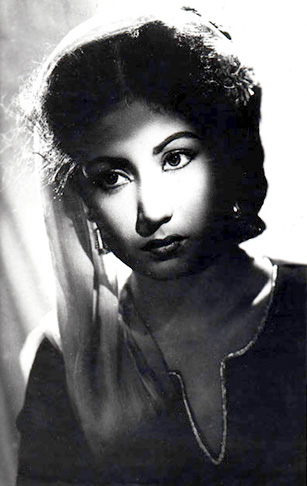
Mahajbeen began her career as a child artiste in Vijay Bhatt's film Leatherface in the year 1939, she being the sole breadwinner of the family she continued to act in films throughout 1940's...Her early adult roles were mainly in mythological films like Ganesh mahima, Veer gatotgach(1950) and fantacies like Alladin and the Wonderful lamp(1952)...
Meena kumari hit the big time in her mentor Vijay Bhatt's classic Baiju Bawra ....the suffering Indian woman found a new face in Meena kumari( her new screen name).Her performance fetched her the Inagural Filmfare Best Actress award in 1953.With Parineeta, Daera,Ek hi Rasta, Sharda and Dil Apna aur Preet parayi Meena went from strength to strength playing the suffering woman, martyr to perfection...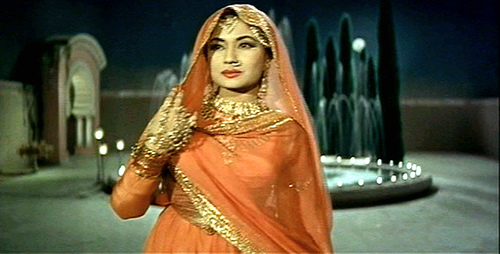
It was a pity that Meena kumari was known for her Tragic roles and she chose more such roles to cultivate the tragedieenne image,because in the few light-hearted films that she did in between Azad,Kohinoor,Miss Mary , Shararat she displayed an uninhibitedness that was refreshing...in thes films her physical movements were free and unrestrained and her dialouge delivery absolutely normal, a stark contrast to the
studied mannerisms and passive posturs of her tragic roles...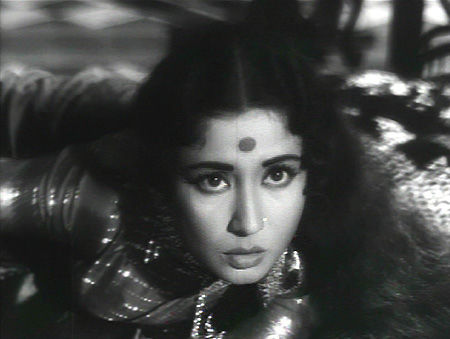
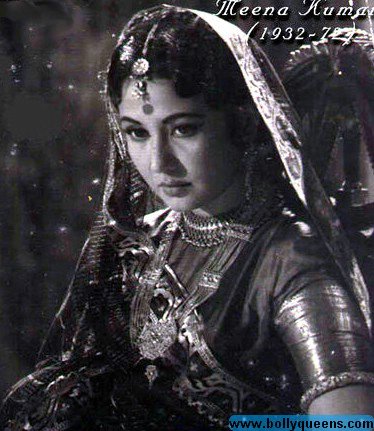
It was Tragedy however which saw Meena Kumari's Greatest ever performance and immortalized her. The film was Sahib Bibi aur Ghulam produced by Guru Dutt. It is considered as one of the Greatest performance ever on the Indian screen.....That year Menna Kumari made history by as she garnered all the three best actress nominations for the Filmfare Award- For Aarti, Main chup rahoongi and of course Sahib bibi aur ghulam for which she won the award...She went on to win 4 Filmfare awrds in all
for Baiju Bawra, Parineeta,Sahib bibi aur Ghulam and Kajal
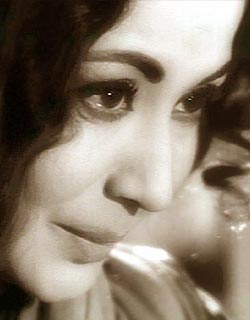
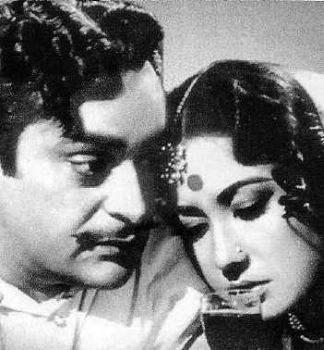
On the sets of one of her films Meena Kumari fell in love with kamal Amrohi one of the the Greatest Film producer/director.He was married and 15 years older than her....They married and she acted in four of his films including Pakeezah which took 14 years to (1958-1972) to hit the silver screen.....
Meena kumari and Kamal amrohi both being highly accomplished and successful , soon began to have differences and relations began to grow sour and finally ended in a divorce in 1964.Meena Kumari increasingly relied on the intimate kindness offered by younger men like Dharmendra and often dulled her senses with liquor....professionally she had hits like Dil ek Mandir, Kajal and Phool aur Patthar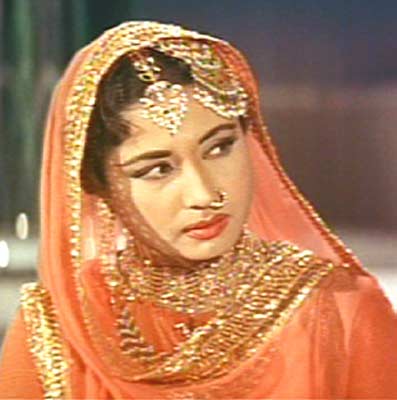
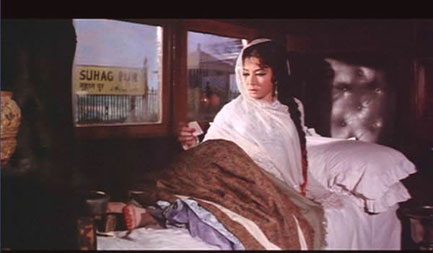
In her later years Menna kumari had lost her looks due to heavy drinking and she began to play character roles in films like Mere apne,Dushman,Jawab, Gomti ke kinare.
She was a talented poetess, and has recorded a disc of her urdu poems- I write I recite
She went on to complete Pakeezah realising that she had limited time...Released in 1972,Pakeezah went on to become a Cult Classic..Meena Kumari gave a stunning performance in a dual role of mother and daughter.
The film was released in February 1972 to a lukewarm response, but after her death on March 31, 1972 the film went on to become a huge success and is regarded as one of her best films
Meena kumari acted in 94 films in a career spanning 33 years...
most memorable films
Baiju Bawara
Daera
Parineeta
Naya andaz
Azad
Ek hi Rasta
Yahudi
sharda
Dil apna aur preet parati
Kohinoor
Babi ki chudiyan
Savera
Saanj aur savera
Aarti
Chitraleka
Dil ek mandir
Kajal
Bahu begum
Phool aur patthar
Mere apne
Pakeezah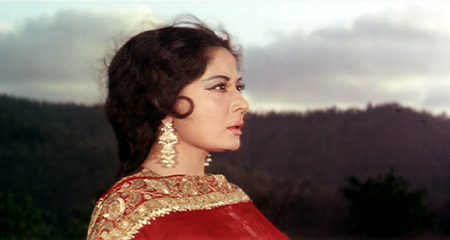
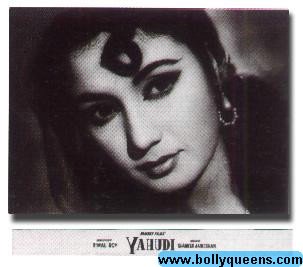
On March 31 , 1972 ,Meena kumari was extremely sick , suffering from Cirrohsis of the Liver and died after being hospitalised where she was on oxygen for four hours...
Meena kumari remained the ultimate Tragedy queen in cinema and in real life ......
Posted by: Reeth Apr 24 2007, 05:00 PM
SURAIYA (June 15, 1929 - January 31, 2004
Suriya was perhaps the last of the Great singing stars...Born in Lahore, she was an only child.She began her acting career by playing bit roles as a child artiste,between the years 1937-1941.Her major film was TajMahal in 1941.....She did playback as a 13 year old for actress Mehtaab in Sharda(1942)
She was launched as a singing star in Bombay talkies Hamaari Baat(1943).She initially started by playing powerful secondary roles in films like Phool, Anmol Ghadi and Dard,..Her singing career found a mentor in music maestro naushad...K.L.Saigal recommended her as heroine for Tadbir in 1945,she co starred with Saigal in Omar Khayyam and Parwana. In 1947 after the partition when Major actresses Noor jehan and Khurshid migrated to Pakistan, more opportunities appeared for Suraiya....



The Year 1948 - 1949 were the best for her career...She had three major hits Pyar ki Jeet, Badi bahen and Dillagi and she became the highest paid Female Star.At her peak Suriaya generated hysteria among the masses...Her songs were a craze....Her songs like Tere nainon ne chori kiya, Woh paas rahe ya door rahe...Bigdi bananewale, murliwale murli bajaa were hummed in every nook and corner of the country..


while shooting for the film Vidya Suraiya fell in love with Dev Anand and the two of them did six films together....Afsar,shayar,Do sitare,Jeet,Nili , none of them hits, suraiya had no regrets as their love flourished...But suraiya's grandmother opposed the relationship . Suraiya remained unmarried all her life...Their love story was the stuff legends are made of...


She made a hit pair with Talat mehmood in movies like Maalik and Waris.... In 1954 she gave her finest dramatic performance in Mirza Ghalib, in the role of a courtesan, the married Ghalib's lover.....her songs in this film are eternal classics...Yeh na thi hamare kismat, Dil e naadan tujhe hua kya hai..
Some of her memorable films
Anmolghadi pyar ki jeet
Waris
Afsar
Sanam
Malik
Mirza Ghalib
Deewana
Mashooqa
Vidya
Shama
Rustom Sohrab


Suraiya's films startrd flopping in the fifties.....followed some indifferent films, and finally in 1963 after acting in Rustom Soharb with Prithviraj Kapoor she bade farewell to the studios....
She retreated into a world surrounded by her close family..
She died in 2004 ,at the age of 75....



Suriya's Films and songs continue to thrive on speculations,lore and memories....
Suraiya was born in Gujranwala... not Lahore. I haven't seen Mirza Ghalib, but my favorite Suraiya's movie as an actress is Dastaan with Raj Kapoor. As a singer... I like most of her movies.
Anmol Ghadi was also a nice movie... I also find Suraiya more charming than Noor Jehan in this film + I liked Suraiya's songs better than Noor Jehan. Noor Jehan was pregnant at that time I think, and she looks plumpy and bubbly and her acting was completely wooden in the movie.
Noor Jehan best movies (as an actress) came after partition and she looks very pretty in Koel and Intezar.
I have referred to several sources and by all accounts she was born in lahore and later moved to Bombay....wikipedia is the only site on where her birth place is mentioned as Gujranwala, Punjab...
Yeah I know that and it is commonly believed that she was born in Lahore... but that is false. She was born in Gujranwala and her father had a furniture shop there. Later she moved to Lahore and then to Bombay.
SURAIYA (June 15, 1929 - January 31, 2004
Suriya was perhaps the last of the Great singing stars...Born in Lahore, she was an only child.She began her acting career by playing bit roles as a child artiste,between the years 1937-1941.Her major film was TajMahal in 1941.....She did playback as a 13 year old for actress Mehtaab in Sharda(1942)
She was launched as a singing star in Bombay talkies Hamaari Baat(1943).She initially started by playing powerful secondary roles in films like Phool, Anmol Ghadi and Dard,..Her singing career found a mentor in music maestro naushad...K.L.Saigal recommended her as heroine for Tadbir in 1945,she co starred with Saigal in Omar Khayyam and Parwana. In 1947 after the partition when Major actresses Noor jehan and Khurshid migrated to Pakistan, more opportunities appeared for Suraiya....



The Year 1948 - 1949 were the best for her career...She had three major hits Pyar ki Jeet, Badi bahen and Dillagi and she became the highest paid Female Star.At her peak Suriaya generated hysteria among the masses...Her songs were a craze....Her songs like Tere nainon ne chori kiya, Woh paas rahe ya door rahe...Bigdi bananewale, murliwale murli bajaa were hummed in every nook and corner of the country..


while shooting for the film Vidya Suraiya fell in love with Dev Anand and the two of them did six films together....Afsar,shayar,Do sitare,Jeet,Nili , none of them hits, suraiya had no regrets as their love flourished...But suraiya's grandmother opposed the relationship . Suraiya remained unmarried all her life...Their love story was the stuff legends are made of...


She made a hit pair with Talat mehmood in movies like Maalik and Waris.... In 1954 she gave her finest dramatic performance in Mirza Ghalib, in the role of a courtesan, the married Ghalib's lover.....her songs in this film are eternal classics...Yeh na thi hamare kismat, Dil e naadan tujhe hua kya hai..
Some of her memorable films
Anmolghadi pyar ki jeet
Waris
Afsar
Sanam
Malik
Mirza Ghalib
Deewana
Mashooqa
Vidya
Shama
Rustom Sohrab


Suraiya's films startrd flopping in the fifties.....followed some indifferent films, and finally in 1963 after acting in Rustom Soharb with Prithviraj Kapoor she bade farewell to the studios....
She retreated into a world surrounded by her close family..
She died in 2004 ,at the age of 75....



Suriya's Films and songs continue to thrive on speculations,lore and memories....
Suraiya was born in Gujranwala... not Lahore. I haven't seen Mirza Ghalib, but my favorite Suraiya's movie as an actress is Dastaan with Raj Kapoor. As a singer... I like most of her movies.
Anmol Ghadi was also a nice movie... I also find Suraiya more charming than Noor Jehan in this film + I liked Suraiya's songs better than Noor Jehan. Noor Jehan was pregnant at that time I think, and she looks plumpy and bubbly and her acting was completely wooden in the movie.
Noor Jehan best movies (as an actress) came after partition and she looks very pretty in Koel and Intezar.
I have referred to several sources and by all accounts she was born in lahore and later moved to Bombay....wikipedia is the only site on where her birth place is mentioned as Gujranwala, Punjab...
Yeah I know that and it is commonly believed that she was born in Lahore... but that is false. She was born in Gujranwala and her father had a furniture shop there. Later she moved to Lahore and then to Bombay.
One more correction... Dev Anand and Suraiya did 7 films together, not 6.
Vidya, Jeet, Sanam, Afsar, Shair, Nili and Do Sitare. I have seen Vidya, Jeet, Sanam and Shair... all of them were mediocre or below average films... except their music.
Posted by: NATURE Apr 24 2007, 07:36 PM
thank you very much reeth for the article on meena kumari, mahajabeen bano was truly beautiful,
a sweet person and a fantastic actor. she lacks absolutely nothing. i recall many and so many things,
bits and bytes of her life my mom used to tell when i was a child/teenager.
her "Chandan ka Palna" is one of her movies that i cherish.
one fact, that i always felt sad is that she was a tragic queen in her real life.
please put more and more about her including pics.
looking forward to your elegant articles. 






Posted by: nasir Apr 24 2007, 11:23 PM
The Tragedy Queen - that was Meena Kumari - both in reel life as well as real life. It's pity that she lost interest in life. She was also, it seems, desirous of having children. But that was not to be.
Dharmendra's first big hit came in PHOOL AUR PATTHAR, opposite Meena Kumari. Yes, she was instrumental, somehow or the other, in establishing the struggling Dharmendra. It is significant that Dharmendra maintained silence recently in an interview on a TV Channel though Meena Kumari's name was mentioned to him.
PAKEEZA would have been a flop if it were not for untimely death. She was buried in a Qabrastaan near Mazagaon, Bombay. Her funeral procession was a huge one, showing the love of the people. It wes only after her death that Pakeeza picked up the box office collections and became a super-hit.
It was said that Meena Kumari's little finger in one of her hands (don't remember which) was slightly cut. In her movies it will be seen that she very cleverly hid it under the Sari's hem or some such clothing. The other unique thing about her was her voice and style of dialogue which was totally different from that of other heroines.
All in all, Meena Kumari is still an inspiration for younger generation of movie stars. One such movie star was Manisha Koirala.
NASIR.
Posted by: maheshks Apr 25 2007, 01:30 AM
Visited this thread today only...thanks reeth for the inputs...though many of
them are not correct...but still a good effort considering that you have
ventured into this subject very recently....
Janaab Nasir Saheb....Meena Kumari had six fingers in her right hand and
no other abnormality.
Posted by: maheshks Apr 25 2007, 01:39 AM
Did you know that it was Devika Rani's b'day on the 30th of March? That was yesterday!
Here is some more info on her gathered from the Net:
D.O.B - 30th March 1908
Devika Rani came from a distinguished background, grand-niece of the Nobel Laureate Rabindranath Tagore, her father, Col. M.N. Chaudhuri, was the first Indian Surgeon-General of Madras.
She completed her early schooling in the early 1920s. She then studied drama at the Royal Academy of Dramatic Art (RADA) and the Royal Academy of Music in London where she won scholarships. In addition, she studied architecture, textile and decor design and apprenticed under Elizabeth Arden.
She married Indian producer and actor Himansu Rai in 1929. Together they starred in Karma the first Hindi sound film. They soon founded Bombay Talkies whose films challenged the caste system.
There she met Himanshu Rai and agreed to design the sets of his first production Light of Asia (1925).
They got married and after marriage they left for Germany where Rai made A Throw of Dice (1929) in collaboration with Germany's famous UFA Studio.
Rai made a bilingual Karma (1933) with Devika Rani in the lead and the two came to India. Here Rai and Devika Rani set up the famous Bombay Talkies Studio.
Under the painstaking supervision of Himanshu Rai, it purchased the most modern equipment from Germany. Franz Osten, director and a handful of technicians came down from England and Germany. By 1935, stream of Hindi productions began to emerge from Bombay Talkies Ltd. beginning with Jawani ki Hawa (1935), a murder mystery.
Devika Rani played the lead in most of these early productions. Their films were of a high technical standard and had a glossy look to them reminiscent of the films of MGM. (Devika Rani was lit up in a manner not unlike Greta Garbo!) In 1958, the President of India honoured Devika with a "Padma Shri". In 1970, she became the first recipient of the prestigious film prize Dadasaheb Phalke Award.
Devika Rani formed a successful team with Ashok Kumar, which ironically started due to a scandal as she eloped with her hero of Jawani ki Hawa, Najam-ul-Hussain. Rai found her and got her to come back and forgave her but not Hussain and Bombay Talkies Ltd. needed a new leading man. Rai's eyes fell on his laboratory assistant, Ashok Kumar.
The two of them starred in a series of films starting with Jeevan Naiya (1936) but it was Achut Kanya (1936), which capitulated Devika Rani and Ashok Kumar to big time fame. The love story between an untouchable girl and a Brahmin boy was both a critical and commercial success with critics going in raptures over Devika's performance.
Going with the trend she even sang her own songs in films with Main Ban Ki Chidiya with Ashok Kumar from Achut Kanya remembered till today. Devika Rani continued acting till 1943 and when Rai died in 1940 she took over the reins at Bombay Talkies. Among her discoveries at Bombay Talkies was Dilip Kumar.
But eventually the economics of filmmaking and tussles with other studio executives led her to take voluntary retirement. She married famed Russian painter Svetoslav Roerich and stayed at their huge estate near Bangalore in South India.
For her contribution to Indian Cinema, Devika Rani was the first ever recipient of the prestigious Dadasaheb Phalke award in 1970. She remained in Bangalore till her death in 1994. At her funeral Devika was given full state honours.
Here's a B/W still from one of her old movies.

Noorie
Noorie a bit of more information on your post...the man in the picture is nazmul hasan..with whom she eloped momentarily.
Posted by: maheshks Apr 25 2007, 01:55 AM
Wot on earth did she see in RK that she did not see in DK?
A Million Dollar question YAARMERE....
What indeed she see in him - a much married man while DK was the most eligible bachelor till as late he celebrated his 44th birthday.
This calls for analysis based on their performance together right from 1948 MELA, then 1949 ANDAAZ, JOGAN and BABUL 1950 and DEEDAR 1951, BABUL 1952 where Dilip keeps on losing her. So also in HULCHAL. Much has also to do with AAN 1952.
NASIR.
Wot on earth did she see in RK that she did not see in DK?
A Million Dollar question YAARMERE....
What indeed she see in him - a much married man while DK was the most eligible bachelor till as late he celebrated his 44th birthday.
This calls for analysis based on their performance together right from 1948 MELA, then 1949 ANDAAZ, JOGAN and BABUL 1950 and DEEDAR 1951, BABUL 1952 where Dilip keeps on losing her. So also in HULCHAL. Much has also to do with AAN 1952.
NASIR.
I guess we will never know. As they say love is blind. Other than the fact that Rk was married and DK was
bachelor, they were both powerful personalites. DK it seems could not decide who he wanted to be with.
If I am not wrong he had affairs with Kamini Kaushal (married ??), Madhubala etc. Just when people thougt
he would settle down with Waheeda Rehman ( would have been nice couple) he marries Saira??
But the fate willed that DK marry Saira. And what a lovely couple they made. They both deserved each other. Many film personalities could not even digest the thought. (A friend of mine who was in the Baraat did hear some snide remarks from an eminent film personality). But as they say: KOI JAL GAYA AUR KISI NE DUA' DEE.....May this pair bloom for many many years to come.
NASIR.
Nasir Saheb you are very much right here. Nargis was a much stronger personality
than DK at that time. T J S George, who wrote the book "Life and Times of Nargis"
has beautifully analysed her life. It is worth reading.....
COMMERCIAL cinema today puts the accent on commercial, not on cinema. Its star component reflects the general culture. For one thing, body-building is the dominant element in the Net Asset Value of a male lead who, invariably, prefers to go shirtless as often as possible. For another, stars are available on rent to political parties looking for opportunistic propaganda boost and a campaign romp or two. From both artistic and sociological perspectives, it is worth pondering why even an Amitabh Bachchan could achieve only success, not significance. Could it be an inability to see the difference, or a tendency to equate the one with the other? Could it be the absence of a purposeful mission, social or aesthetic, without which success becomes essentially vain-glorious?
The world was different in the 1950s. Idealism energised talent and talent inspired idealism. Technology had not become a substitute for ability. There was no ‘special effects’ department that could make a terminator out of Schwarzenegger, no morphological tricks that could convert a Kamal Hasan into an instant hydra. An actor had to act. It was part of the folk wisdom of the time that dramatic actors like Dilip Kumar and Balraj Sahni, as well as character artistes like Lalita Pawar and Achla Sachdev, would spend hours studying their parts and perfecting the nuances of their performance.
Not surprisingly a thousand flowers bloomed in the years that immediately followed independence. Directors like Bimal Roy and K.A. Abbas pioneered the romantic-neorealist genre of cinema, directly influenced by European masters in general and Vittorio De Sica in particular. Composers like Naushad endowed music with classical dimensions. Lyricists like Sahir Ludhianwi and Shakeel Badayuni were not just film lyricists, but poets of considerable worth. The erratic Kishore Kumar’s simultaneous brilliance in different departments was something of a marvel. For that matter, where has there been a comedian who could rival the versatility and finesse of Johny Walker?
If this sounds like a throwback to the old-is-gold cliche, so be it. The 1950s were indeed a Golden Age, described as such and compared to the Golden Age of the 1930s when New Theatres, Bombay Talkies and Prabhat lit up the skies and filled them with stars of the calibre of Devika Rani and K.L. Saigal. Those decades attained a measure of significance because cinema then recognised its social responsibility. Pictures like Shantaram’s Amrita Manthan (1934), Bombay Talkies’ Acchut Kanya (1936) and Mehboob Khan’s Ek Hi Rasta (1939) found worthy successors in the second Golden Age with Zia Sarhadi’s Humlog (1951), Bimal Roy’s Do Bigha Zamin (1953) and Mehboob’s Mother India (1957). A good deal of trash came out of those years, but the thinkers made up for the titillators.
The stars kept pace. On the female side as well as the male. It took a dedicated producer-director-bureaucrat named Mohan Bhavnani to help break the social taboo that kept ‘respectable women’ out of cinema. In Vasant Sena which he produced in 1931, he scored a triumph for which he is yet to be fully recognised; he persuaded the socially prominent Kamaladevi Chattopadhyaya and Enakshi Rama Rau to appear before the camera. But that was not enough for him. He wanted an educated lady to take to films as a profession and thereby set an example. This he achieved when Durga Khote, the Cathedral School-educated wife of the upper-crust lawyer Viswas Khote, agreed to star in Bhavnani’s Trapped (1931).
That debut led to an opening of the floodgates. Devika Rani, who had teamed up with Himanshu Rai two years earlier in Germany, became the queen of the first Golden Age not only because of her histrionic capabilities, but also her aristocratic pedigree. She was the daughter of Col. M.N. Chowdury, Surgeon-General, who had sent her off to England at the age of nine in order to bring her up as a proper English lady. Trained at the Royal Academy of Dramatic Arts and later in Germany, she was as educated as anyone could be. She was now joined by a galaxy of stars – Shanta Apte, Leela Chitnis, Shobhana Samarth, Kannanbala, Sadhana Bose. The 1950s saw a lineup just as glittering – Meena Kumari, Madhubala, Kamini Kaushal, Geeta Bali, Waheeda Rahman, Nutan.
And Nargis. How did this progeny of the kothewali class of professional singers transcend her custom-ordained destiny, rise above her extraordinarily gifted fellow artistes, rise even above the aristocratic Devika Rani and become the First Lady of the second Golden Age? K.A. Abbas had noted that she was not a great actress to start with. Yet she became not only ‘the greatest star of our film industry,’ as Balraj Sahni described her, but also an icon of her times with an assured place among the Great Women of India.
Genes certainly had something to do with it, genes and a natural ambition for excellence that grew out of them. Her mother Jaddan Bai, imperious and colourful, was the one who sensed early on that life ought to be more than singing and dancing for the entertainment of northern India’s zamindars. She became so proficient in singing, especially thumri, that when she was on a visit to Calcutta K.L. Saigal listened to her and told friends about the classical character of her music.
Another Punjabi who attended that soiree was smitten by the singer as well as the song. Uttamchand Mohanchand (Mohan Babu) from Rawalpindi was on his way to England to study medicine. He cancelled all plans and persuaded Jaddan Bai, already a mother of two boys, to marry him. From him, daughter Nargis inherited a capacity to both love profoundly and develop a sensitive attachment to books and education. These traits, combined with an ability to dream which she imbibed from her mother, formed the foundations of Nargis’s personality.
It was of course the aesthetic side of that personality that made her a star. But there were other aspects to her life that made her unlike any other star. She made contributions of her own as a woman, as a mother and wife, as a citizen and as a committed social worker. Her multiple involvements gave her a sense of direction which several of her talented contemporaries missed. Waheeda Rahman was one of the few who found fulfilment in her career and went into graceful retirement. Madhubala and Nutan were overtaken by illnesses while Meena Kumari fell prey to excesses with the bottle. Nargis always had worthy causes to pursue. That was why, even though cancer brought her life to a painful end, she filled the 52 years of her life with accomplishments of a lasting kind.
First and foremost she was an artiste. Her appearance in her mother’s production Talashe Haq in 1935 at the age of six may be considered no more than a matter of record. (Her name appeared in the credits as Baby Rani. Among family and close friends she was always known by the pet name of Baby.) At 14 she was dreaming of joining college and becoming a doctor. It took a full day for Mehboob to persuade her to accept the role of heroine in his Taqdeer (1943). Mehboob also gave her a new screen name. She obviously could not be featured as Baby Rani. Nor was her official name, Fatima Abdul Rashid, attractive enough for cinema. Her father had named her Tejeswari Mohan. That too was considered unsuitable. Mehboob finally chose the one-word name, Nargis. Half a dozen indifferent films followed. Then came milestones in the history of Hindi cinema, beginning with Aag in 1948 and Andaz and Barsaat in 1949. The magic had begun.
Any consideration of Nargis’s film career should take two of its essential ingredients into account – the temper of India in the 1950s and the creativity of her association with Raj Kapoor. The euphoria of a newly independent country had a salutary impact on cinema. As a dramatic art that blends myriad skills into a single compendium of experience, cinema needs a confluence of talents and a commitment of the talented.
The artists, technicians and the visionaries who converged in cinema in the years immediately following independence could not have asked for a more propitious moment in terms of opportunities. Despite Gandhian leaders who saw cinema as sinful, optimism was the prevailing mood and everyone was a reformist. Liberal themes, imaginative treatment and creative virtuosity could expect instant acceptance. There was a great coming together of mood and man. There was an all-round striving towards fresh goals, an urge to venture into new areas. Cinema became inspirational.
It was in such an atmosphere that destiny brought Nargis and Raj Kapoor together. No hero-heroine team has given more electric moments to Indian cinema than this pair. There were other pairings like Dev Anand and Suraiya, Dilip Kumar and Kamini Kaushal. But Nargis and Raj Kapoor complemented each other, brought out the best in each other as no other star team did. Nargis told an interviewer in 1954: ‘Before I started work with Raj, my ideas were bottled up. There was no one with whom I could discuss them freely. With Raj it is different. We seem to have practically the same views and ideas, the same outlook on all subjects.’
Raj Kapoor for his part was too conscious of his prerogatives as a man to concede much to a woman. But there can be no doubt that Nargis was the finest artistic asset he had under his R.K. Films banner. This became clear after the two broke up around 1957. Nargis went on to make Mother India that year, considered by many as the zenith of her career. By contrast, not a single film of note came out of R.K. Studios after Nargis left it. Indeed, Ab Dilli Dur Nahi which came out in the year of the break-up, is generally considered the poorest of R.K. Films offerings. Jis Desh Mein Ganga Behti Hai (1960) had the usual formula ingredients but without the easy spontaneity that made the earlier movies so heart-warming. Actually, this film pointed to a fundamental shift in Raj Kapoor’s very approach to cinema. He now found a tawdry resort to sex appeal necessary. Padmini’s assets were used with a blatancy never seen during the Nargis phase.
Clearly the Nargis-Raj Kapoor combination was good for cinema just as their break-up was bad for Raj Kapoor’s cinema. While it lasted, it was the most celebrated love affair of the time. So perfect was the chemistry between them that even ordinary poses struck instinctively by them became classic images of India’s entertainment lore. One became the famous logo of R.K. Films with Nargis flowing over the arm of a violin-bearing Raj. Another, a simple shot from Shree 420 showing the two of them sheltering under an umbrella in heavy rain, tugs at hearts for completely inexplicable reasons.
What is undeniable is that Nargis and Raj Kapoor brought to screen romance an unprecedented openness. Meena Kumari, the prototype of the romantic heroine, was forever sacrificing and suffering. She was aptly described as the tragedy queen because romance was inseparable from tragedy.
Nargis and Raj Kapoor revolutionised the concept of romance by boldly projecting love as a prerogative of the young. They looked as though they were made for the part. She was vulnerably feminine if also happily submissive. He was impishly masculine if also happily submissive. Adoring each other unabashedly, they turned romance into a joyous celebration. Instead of feeling guilty, they revelled in it. They did retain the concept of pain as part of the ecstasy of love; it would not be Indian otherwise. But the Nargis heroine was proud of her emotions, full of self-esteem and ready to fight for her right to love and be loved.
In Barsaat an entirely new idiom of screen romance was at work. His fingers tenderly probing around her mouth, her head tilting in a gesture of total submission, his hands fondly rustling her hair, her eyes catching fire as she looked at him – this was intuitive romancing, honest and unpremeditated. In the sixteen pictures in which they starred together, love was not always the central theme. Yet the wondrous aura surrounding the pair gave the films an extraordinary pitch and panache.
Raj Kapoor’s place in Indian cinema is historical, entrenched and unique. It may therefore seem invidious to suggest that his artistic wellsprings were not as deep as Nargis’s. Yet that conclusion is inevitable when their contrasting trajectories after the break-up are taken into consideration. Mother India is proof of Nargis’s unmatched ability to summon up inner reserves of inspiration and propel herself to new levels of excellence, Raj Kapoor or no Raj Kapoor. Her role covered the entire span of life, from a young wife to an old woman. It called for a complete range of emotions, from romance and rustic toughness to a manifestation of womanly resolve that would prompt her to shoot her own son when he tried to abduct a girl. She brought a raw power to bear on her performance. It was a Nargis who had attained the fullness of artistic maturity.
That Nargis scaled the summit of achievement with her performance in Mother India was acknowledged by all. Abroad, she won an award at the Karlovy Vary festival. At home, Dilip Kumar said: ‘Her best picture is Mother India. Her second best picture is Mother India. Her third best picture is Mother India.’ Thirty years after the picture was released, a reviewer wrote: ‘Mother India is to Nargis what The Godfather is to Marlon Brando and The Sound of Music to Julie Andrews. The role and the film are inextricably entwined in the mind of the public so much so that the two are almost one.’
When Mother India was made, Nargis was two years short of 30. The woman in her had been yearning for fulfilment of a different kind and it was not forthcoming from Raj Kapoor. She knew he was married and had children of his own, yet she hoped to marry him and raise a family. She never looked upon her relationship with him as an affair because she was always serious about it. Her intentions were honourable. She wanted to raise a family the right and proper way. Arrangements of convenience such as the Hema Malinis of a later generation would accept were not good enough for her. She had to go about it without compromising her dignity as a woman. But by 1956 it was clear that nothing of the sort was possible with Raj Kapoor. When his attention was openly diverted to ‘variety from the south’, she decided to end the relationship.
Initially the parting must have wrenched her emotionally. But the challenge of Mother India gave her something to concentrate on. Her own strength of character shored her up. Work and personal resoluteness helped her emerge rapidly as a complete woman. She went through a renewal. On the sets of Mother India she met Sunil Dutt. His genuineness and simplicity made an impression on her. Her compassion for his sick sister moved him. In early 1958 they got married according to Arya Samaj rites.
From Nargis’s point of view, the importance of that union cannot be overstated. There was nothing in life she wanted more than marriage and children. As a teenager, she was a tomboy but she used to spend every spare moment with the children of her two brothers in their Marine Drive flat. When she began acting in the early films, she took charge of the children, financing and supervising their education, choosing their clothes and toys, organising their outings. Her sense of family was as strong as her maternal instincts. With Sunil Dutt now as husband, she could at last realise her lifelong ambition. As her friend and co-star K.N. Singh put it: ‘With marriage, it was like she had reached home. She thought God had come to earth in the form of Sunil Dutt. So much did she worship him.’ Nargis, the heart-throb of a generation, would glow with excitement if someone called her ‘Mrs Dutt’.
She did make a film or two after marriage. This was to help her brothers. These exceptions apart, her retirement from the film industry was real. Sunil Dutt would not have it any other way for he was conventional enough to insist that, as husband, it was his duty to be the family’s provider. Nargis’s own resolve to remain a wife and mother was beautifully underlined by her when the great S.S. Vasan of Gemini Studios in Madras approached her with a film offer. Vasan was a kind of King Emperor of cinema. He never approached a star directly. He flew to Bombay to make an exception of Nargis, hoping that the gesture alone would clinch the matter. He gave her a blank cheque leaf as well. Nargis teased him for a while and then said: ‘Vasan Saab, I am completely tied up with three films right now. They are called Sanju, Anju and Priya. I just cannot do another film now.’ Vasan was speechless for a moment.
The award of Padma Shri to her in 1958 kindled a latent desire in husband and wife to play an active role in public life. In separate and different ways, both had already come under the influence of Jawaharlal Nehru and Indira Gandhi. Sunil Dutt was inspired by what he perceived as idealism in Nehru. Nargis became close to Indira so much so that she and her husband remained steadfast supporters of the Emergency and of Indira when she was out in the wilderness after the electoral defeat that followed it. In time Nargis would become a nominated member of the Rajya Sabha and Sunil Dutt an elected member of the Lok Sabha. But both essentially were political innocents, motivated only by their friendship with Indira on the one hand and their desire to be of some service to the country on the other.
Eventually it was not in politics but in work for the handicapped that they found their forte. There was a strong instinct in Nargis to acquire medical qualifications. Perhaps it was a continuation of her father’s aborted ambitions to become a doctor. Even after marriage, Sunil Dutt recalled, she had expressed a desire to go abroad and become a qualified nurse so that she could attend to the sick and needy.
In the event, she found herself involved in social work focused on underprivileged children and the handicapped. She discovered that it was an interest that absorbed her husband as well. Together they set up a school for poor children in a plot of land they bought in Bandra. They also set up the Centre for Special Education for Spastics. When the Spastics Society of India was established in Bombay, she was nominated as one of the promoters. Neither she nor Sunil Dutt took this work as mere social feathers in their caps. They were seriously committed to it. Nargis conducted herself as a nurse when she was involved in the care of spastic children. She was, in the opinion of colleagues, ‘professional’ in her approach. Never missing a committee meeting, she always studied the files, understood the details and was ready with ideas on how to expand and improve the Spastics Society’s work.
She also immersed herself in the activities of the Bharat Scouts and Guides, the War Widows Association and the Meena Kumari Memorial for the Blind. This kind of social service was rare then, rarer today. Among the busiest stars of the time, Nargis and Sunil Dutt found the time to work for the less privileged, often spending their own money to see the programmes through. It was an approach to life that contrasted with the approach of today’s stars, be they of film or cricket, who make more money but have less interest in the suffering of their fellow humans.
For Nargis life was incomplete without her social work. The way she threw herself into it was indicative of the transformation of her persona after marriage. Only now did she seem to have come into her own. It was a new Nargis, a complete Nargis, happy and satisfied in a way she never was when she was at the pinnacle of filmic glamour. The film star had metamorphosed into an independent woman with clearcut views about life, people and priorities. Nargis had found herself.
But the sense of fullness was short-lived. Tragedy struck in 1979 when Nargis was diagnosed as having, first, obstructive jaundice and then, cancer of the pancreas. The best of treatment in New York brought only temporary relief. Nargis was in prolonged pain necessitating sedation. Her plight turned pitiable with her beloved son, Sanjay Dutt, sinking into the half-life of hallucinogens. In time he would bounce back and become a health freak and a macho screen hero. But Nargis was denied the pleasure of witnessing her son’s triumph. All she had in her last days was the feeling that the idyll of her family life was crumbling around her even as she lay fighting for her life. It was a fight she could not win. She slipped into the silence of her final sleep on 3 May 1981.
Arundhati Roy has said that thirty-one is a viable die-able age. Maybe it is. But fifty-two certainly was not a die-able age. Not when the life that death snatched belonged to someone like Nargis who was still brimming with promise and plans. When it did happen, it seemed to highlight not so much the majesty of human suffering as its pointlessness. But in a poignant kind of way, even the shadow of death brought out the uniqueness of Nargis’s mind.
After weeks of despair in the cancer ward in New York, with kidney and heart complications adding to the hopelessness of the situation, with five surgical operations shattering her mentally as well as physically, the Dutts could only think of going home where she could at least die in the bosom of her family. When the doctors allowed them to travel, they spent a few days preparing for the long flight home. On one of their outings, she surprised her husband with the remark, ‘You never did the right thing in bringing me here.’ Pressed to explain, she said: ‘There must be millions of sufferers in our country who must be as important to their families as I am to you. But they don’t get medical facilities like I got... If I live, I must take this up with the government and with Madam Gandhi. Such facilities must become available in India.’
The human qualities that added value to Nargis’s work as a film personality were emphasised by all the public figures, film industry leaders and editorial writers who assessed her career after her passing. No star of her time – indeed, no star of any time – devoted time and attention to public and social causes as Nargis did. Compassion came naturally to her. At one level, she was famous for getting from home oversize food containers so that light boys and stage hands on the set could get a hearty meal during lunch breaks. At another, news that a colleague’s wife or child was sick would see Nargis taking charge of the patient until recovery was assured. If a child was handicapped in any way, she would drop everything and make arrangements for the child’s care and treatment. This was a humanist who happened to become a star.
That the connections and resources she garnered as a star were used for her humanitarian programmes was the key to Nargis’s success as a social worker. That was also part of the importance she achieved in the context of her time. But of course the main plank of that importance was her contribution as an artiste. She embodied the period in which Indian cinema grew out of its staginess and took its place on the world scene. The romantic-neorealist genre of cinema reached its apotheosis through the authenticity imparted to its portrayal by stars like Nargis.
Substance in cinema is considered to be the natural domain of directors, not actors. Yet, stars who give wing to new concepts in their metier exert influence not inferior to that of directors. It would be difficult, for example, to look upon Marlon Brando as just another actor who did well in his time. This is more so in Indian cinema because stars often participate in the conceptualisation of story development. Nargis’s contribution to the making of the R.K. Films classics was by no means inconsequential. The achievements of Raj Kapoor were, without exception, the achievements of the Raj-Nargis team. Without her, the R.K. banner simply lost its wind.
The significance of stars who go beyond their immediate career demands and become part of a larger artistic current, be they Greta Garbo or Humphrey Bogart, Devika Rani or Nargis, needs to be examined in a context that transcends the exigencies of popular taste and the particular years of their action. Nargis’s effectiveness as an artiste was related to, and enhanced by, her integrity as an individual. By embracing a wider domain than her contemporaries did, she became larger than the sum of her parts. The best actors embody the characteristics of their own cultures. Nargis epitomised the Indian woman in both her strengths and her weaknesses, her aspirations and her inherent dignity. Inasmuch as these are deathless values, her representative status is unrestricted by time. She lives.
Posted by: noorie Apr 25 2007, 02:05 AM
Did you know that it was Devika Rani's b'day on the 30th of March? That was yesterday!
Here is some more info on her gathered from the Net:
D.O.B - 30th March 1908
Devika Rani came from a distinguished background, grand-niece of the Nobel Laureate Rabindranath Tagore, her father, Col. M.N. Chaudhuri, was the first Indian Surgeon-General of Madras.
She completed her early schooling in the early 1920s. She then studied drama at the Royal Academy of Dramatic Art (RADA) and the Royal Academy of Music in London where she won scholarships. In addition, she studied architecture, textile and decor design and apprenticed under Elizabeth Arden.
She married Indian producer and actor Himansu Rai in 1929. Together they starred in Karma the first Hindi sound film. They soon founded Bombay Talkies whose films challenged the caste system.
There she met Himanshu Rai and agreed to design the sets of his first production Light of Asia (1925).
They got married and after marriage they left for Germany where Rai made A Throw of Dice (1929) in collaboration with Germany's famous UFA Studio.
Rai made a bilingual Karma (1933) with Devika Rani in the lead and the two came to India. Here Rai and Devika Rani set up the famous Bombay Talkies Studio.
Under the painstaking supervision of Himanshu Rai, it purchased the most modern equipment from Germany. Franz Osten, director and a handful of technicians came down from England and Germany. By 1935, stream of Hindi productions began to emerge from Bombay Talkies Ltd. beginning with Jawani ki Hawa (1935), a murder mystery.
Devika Rani played the lead in most of these early productions. Their films were of a high technical standard and had a glossy look to them reminiscent of the films of MGM. (Devika Rani was lit up in a manner not unlike Greta Garbo!) In 1958, the President of India honoured Devika with a "Padma Shri". In 1970, she became the first recipient of the prestigious film prize Dadasaheb Phalke Award.
Devika Rani formed a successful team with Ashok Kumar, which ironically started due to a scandal as she eloped with her hero of Jawani ki Hawa, Najam-ul-Hussain. Rai found her and got her to come back and forgave her but not Hussain and Bombay Talkies Ltd. needed a new leading man. Rai's eyes fell on his laboratory assistant, Ashok Kumar.
The two of them starred in a series of films starting with Jeevan Naiya (1936) but it was Achut Kanya (1936), which capitulated Devika Rani and Ashok Kumar to big time fame. The love story between an untouchable girl and a Brahmin boy was both a critical and commercial success with critics going in raptures over Devika's performance.
Going with the trend she even sang her own songs in films with Main Ban Ki Chidiya with Ashok Kumar from Achut Kanya remembered till today. Devika Rani continued acting till 1943 and when Rai died in 1940 she took over the reins at Bombay Talkies. Among her discoveries at Bombay Talkies was Dilip Kumar.
But eventually the economics of filmmaking and tussles with other studio executives led her to take voluntary retirement. She married famed Russian painter Svetoslav Roerich and stayed at their huge estate near Bangalore in South India.
For her contribution to Indian Cinema, Devika Rani was the first ever recipient of the prestigious Dadasaheb Phalke award in 1970. She remained in Bangalore till her death in 1994. At her funeral Devika was given full state honours.
Here's a B/W still from one of her old movies.

Noorie
Noorie a bit of more information on your post...the man in the picture is nazmul hasan..with whom she eloped momentarily.
Thanks 4 the info Mahesh.
Noorie
Posted by: noorie Apr 25 2007, 02:14 AM
Wot on earth did she see in RK that she did not see in DK?
A Million Dollar question YAARMERE....
What indeed she see in him - a much married man while DK was the most eligible bachelor till as late he celebrated his 44th birthday.
This calls for analysis based on their performance together right from 1948 MELA, then 1949 ANDAAZ, JOGAN and BABUL 1950 and DEEDAR 1951, BABUL 1952 where Dilip keeps on losing her. So also in HULCHAL. Much has also to do with AAN 1952.
NASIR.
Wot on earth did she see in RK that she did not see in DK?
A Million Dollar question YAARMERE....
What indeed she see in him - a much married man while DK was the most eligible bachelor till as late he celebrated his 44th birthday.
This calls for analysis based on their performance together right from 1948 MELA, then 1949 ANDAAZ, JOGAN and BABUL 1950 and DEEDAR 1951, BABUL 1952 where Dilip keeps on losing her. So also in HULCHAL. Much has also to do with AAN 1952.
NASIR.
I guess we will never know. As they say love is blind. Other than the fact that Rk was married and DK was
bachelor, they were both powerful personalites. DK it seems could not decide who he wanted to be with.
If I am not wrong he had affairs with Kamini Kaushal (married ??), Madhubala etc. Just when people thougt
he would settle down with Waheeda Rehman ( would have been nice couple) he marries Saira??
But the fate willed that DK marry Saira. And what a lovely couple they made. They both deserved each other. Many film personalities could not even digest the thought. (A friend of mine who was in the Baraat did hear some snide remarks from an eminent film personality). But as they say: KOI JAL GAYA AUR KISI NE DUA' DEE.....May this pair bloom for many many years to come.
NASIR.
Nasir Saheb you are very much right here. Nargis was a much stronger personality
than DK at that time. T J S George, who wrote the book "Life and Times of Nargis"
has beautifully analysed her life. It is worth reading.....
COMMERCIAL cinema today puts the accent on commercial, not on cinema. Its star component reflects the general culture. For one thing, body-building is the dominant element in the Net Asset Value of a male lead who, invariably, prefers to go shirtless as often as possible. For another, stars are available on rent to political parties looking for opportunistic propaganda boost and a campaign romp or two. From both artistic and sociological perspectives, it is worth pondering why even an Amitabh Bachchan could achieve only success, not significance. Could it be an inability to see the difference, or a tendency to equate the one with the other? Could it be the absence of a purposeful mission, social or aesthetic, without which success becomes essentially vain-glorious?
The world was different in the 1950s. Idealism energised talent and talent inspired idealism. Technology had not become a substitute for ability. There was no ‘special effects’ department that could make a terminator out of Schwarzenegger, no morphological tricks that could convert a Kamal Hasan into an instant hydra. An actor had to act. It was part of the folk wisdom of the time that dramatic actors like Dilip Kumar and Balraj Sahni, as well as character artistes like Lalita Pawar and Achla Sachdev, would spend hours studying their parts and perfecting the nuances of their performance.
Not surprisingly a thousand flowers bloomed in the years that immediately followed independence. Directors like Bimal Roy and K.A. Abbas pioneered the romantic-neorealist genre of cinema, directly influenced by European masters in general and Vittorio De Sica in particular. Composers like Naushad endowed music with classical dimensions. Lyricists like Sahir Ludhianwi and Shakeel Badayuni were not just film lyricists, but poets of considerable worth. The erratic Kishore Kumar’s simultaneous brilliance in different departments was something of a marvel. For that matter, where has there been a comedian who could rival the versatility and finesse of Johny Walker?
If this sounds like a throwback to the old-is-gold cliche, so be it. The 1950s were indeed a Golden Age, described as such and compared to the Golden Age of the 1930s when New Theatres, Bombay Talkies and Prabhat lit up the skies and filled them with stars of the calibre of Devika Rani and K.L. Saigal. Those decades attained a measure of significance because cinema then recognised its social responsibility. Pictures like Shantaram’s Amrita Manthan (1934), Bombay Talkies’ Acchut Kanya (1936) and Mehboob Khan’s Ek Hi Rasta (1939) found worthy successors in the second Golden Age with Zia Sarhadi’s Humlog (1951), Bimal Roy’s Do Bigha Zamin (1953) and Mehboob’s Mother India (1957). A good deal of trash came out of those years, but the thinkers made up for the titillators.
The stars kept pace. On the female side as well as the male. It took a dedicated producer-director-bureaucrat named Mohan Bhavnani to help break the social taboo that kept ‘respectable women’ out of cinema. In Vasant Sena which he produced in 1931, he scored a triumph for which he is yet to be fully recognised; he persuaded the socially prominent Kamaladevi Chattopadhyaya and Enakshi Rama Rau to appear before the camera. But that was not enough for him. He wanted an educated lady to take to films as a profession and thereby set an example. This he achieved when Durga Khote, the Cathedral School-educated wife of the upper-crust lawyer Viswas Khote, agreed to star in Bhavnani’s Trapped (1931).
That debut led to an opening of the floodgates. Devika Rani, who had teamed up with Himanshu Rai two years earlier in Germany, became the queen of the first Golden Age not only because of her histrionic capabilities, but also her aristocratic pedigree. She was the daughter of Col. M.N. Chowdury, Surgeon-General, who had sent her off to England at the age of nine in order to bring her up as a proper English lady. Trained at the Royal Academy of Dramatic Arts and later in Germany, she was as educated as anyone could be. She was now joined by a galaxy of stars – Shanta Apte, Leela Chitnis, Shobhana Samarth, Kannanbala, Sadhana Bose. The 1950s saw a lineup just as glittering – Meena Kumari, Madhubala, Kamini Kaushal, Geeta Bali, Waheeda Rahman, Nutan.
And Nargis. How did this progeny of the kothewali class of professional singers transcend her custom-ordained destiny, rise above her extraordinarily gifted fellow artistes, rise even above the aristocratic Devika Rani and become the First Lady of the second Golden Age? K.A. Abbas had noted that she was not a great actress to start with. Yet she became not only ‘the greatest star of our film industry,’ as Balraj Sahni described her, but also an icon of her times with an assured place among the Great Women of India.
Genes certainly had something to do with it, genes and a natural ambition for excellence that grew out of them. Her mother Jaddan Bai, imperious and colourful, was the one who sensed early on that life ought to be more than singing and dancing for the entertainment of northern India’s zamindars. She became so proficient in singing, especially thumri, that when she was on a visit to Calcutta K.L. Saigal listened to her and told friends about the classical character of her music.
Another Punjabi who attended that soiree was smitten by the singer as well as the song. Uttamchand Mohanchand (Mohan Babu) from Rawalpindi was on his way to England to study medicine. He cancelled all plans and persuaded Jaddan Bai, already a mother of two boys, to marry him. From him, daughter Nargis inherited a capacity to both love profoundly and develop a sensitive attachment to books and education. These traits, combined with an ability to dream which she imbibed from her mother, formed the foundations of Nargis’s personality.
It was of course the aesthetic side of that personality that made her a star. But there were other aspects to her life that made her unlike any other star. She made contributions of her own as a woman, as a mother and wife, as a citizen and as a committed social worker. Her multiple involvements gave her a sense of direction which several of her talented contemporaries missed. Waheeda Rahman was one of the few who found fulfilment in her career and went into graceful retirement. Madhubala and Nutan were overtaken by illnesses while Meena Kumari fell prey to excesses with the bottle. Nargis always had worthy causes to pursue. That was why, even though cancer brought her life to a painful end, she filled the 52 years of her life with accomplishments of a lasting kind.
First and foremost she was an artiste. Her appearance in her mother’s production Talashe Haq in 1935 at the age of six may be considered no more than a matter of record. (Her name appeared in the credits as Baby Rani. Among family and close friends she was always known by the pet name of Baby.) At 14 she was dreaming of joining college and becoming a doctor. It took a full day for Mehboob to persuade her to accept the role of heroine in his Taqdeer (1943). Mehboob also gave her a new screen name. She obviously could not be featured as Baby Rani. Nor was her official name, Fatima Abdul Rashid, attractive enough for cinema. Her father had named her Tejeswari Mohan. That too was considered unsuitable. Mehboob finally chose the one-word name, Nargis. Half a dozen indifferent films followed. Then came milestones in the history of Hindi cinema, beginning with Aag in 1948 and Andaz and Barsaat in 1949. The magic had begun.
Any consideration of Nargis’s film career should take two of its essential ingredients into account – the temper of India in the 1950s and the creativity of her association with Raj Kapoor. The euphoria of a newly independent country had a salutary impact on cinema. As a dramatic art that blends myriad skills into a single compendium of experience, cinema needs a confluence of talents and a commitment of the talented.
The artists, technicians and the visionaries who converged in cinema in the years immediately following independence could not have asked for a more propitious moment in terms of opportunities. Despite Gandhian leaders who saw cinema as sinful, optimism was the prevailing mood and everyone was a reformist. Liberal themes, imaginative treatment and creative virtuosity could expect instant acceptance. There was a great coming together of mood and man. There was an all-round striving towards fresh goals, an urge to venture into new areas. Cinema became inspirational.
It was in such an atmosphere that destiny brought Nargis and Raj Kapoor together. No hero-heroine team has given more electric moments to Indian cinema than this pair. There were other pairings like Dev Anand and Suraiya, Dilip Kumar and Kamini Kaushal. But Nargis and Raj Kapoor complemented each other, brought out the best in each other as no other star team did. Nargis told an interviewer in 1954: ‘Before I started work with Raj, my ideas were bottled up. There was no one with whom I could discuss them freely. With Raj it is different. We seem to have practically the same views and ideas, the same outlook on all subjects.’
Raj Kapoor for his part was too conscious of his prerogatives as a man to concede much to a woman. But there can be no doubt that Nargis was the finest artistic asset he had under his R.K. Films banner. This became clear after the two broke up around 1957. Nargis went on to make Mother India that year, considered by many as the zenith of her career. By contrast, not a single film of note came out of R.K. Studios after Nargis left it. Indeed, Ab Dilli Dur Nahi which came out in the year of the break-up, is generally considered the poorest of R.K. Films offerings. Jis Desh Mein Ganga Behti Hai (1960) had the usual formula ingredients but without the easy spontaneity that made the earlier movies so heart-warming. Actually, this film pointed to a fundamental shift in Raj Kapoor’s very approach to cinema. He now found a tawdry resort to sex appeal necessary. Padmini’s assets were used with a blatancy never seen during the Nargis phase.
Clearly the Nargis-Raj Kapoor combination was good for cinema just as their break-up was bad for Raj Kapoor’s cinema. While it lasted, it was the most celebrated love affair of the time. So perfect was the chemistry between them that even ordinary poses struck instinctively by them became classic images of India’s entertainment lore. One became the famous logo of R.K. Films with Nargis flowing over the arm of a violin-bearing Raj. Another, a simple shot from Shree 420 showing the two of them sheltering under an umbrella in heavy rain, tugs at hearts for completely inexplicable reasons.
What is undeniable is that Nargis and Raj Kapoor brought to screen romance an unprecedented openness. Meena Kumari, the prototype of the romantic heroine, was forever sacrificing and suffering. She was aptly described as the tragedy queen because romance was inseparable from tragedy.
Nargis and Raj Kapoor revolutionised the concept of romance by boldly projecting love as a prerogative of the young. They looked as though they were made for the part. She was vulnerably feminine if also happily submissive. He was impishly masculine if also happily submissive. Adoring each other unabashedly, they turned romance into a joyous celebration. Instead of feeling guilty, they revelled in it. They did retain the concept of pain as part of the ecstasy of love; it would not be Indian otherwise. But the Nargis heroine was proud of her emotions, full of self-esteem and ready to fight for her right to love and be loved.
In Barsaat an entirely new idiom of screen romance was at work. His fingers tenderly probing around her mouth, her head tilting in a gesture of total submission, his hands fondly rustling her hair, her eyes catching fire as she looked at him – this was intuitive romancing, honest and unpremeditated. In the sixteen pictures in which they starred together, love was not always the central theme. Yet the wondrous aura surrounding the pair gave the films an extraordinary pitch and panache.
Raj Kapoor’s place in Indian cinema is historical, entrenched and unique. It may therefore seem invidious to suggest that his artistic wellsprings were not as deep as Nargis’s. Yet that conclusion is inevitable when their contrasting trajectories after the break-up are taken into consideration. Mother India is proof of Nargis’s unmatched ability to summon up inner reserves of inspiration and propel herself to new levels of excellence, Raj Kapoor or no Raj Kapoor. Her role covered the entire span of life, from a young wife to an old woman. It called for a complete range of emotions, from romance and rustic toughness to a manifestation of womanly resolve that would prompt her to shoot her own son when he tried to abduct a girl. She brought a raw power to bear on her performance. It was a Nargis who had attained the fullness of artistic maturity.
That Nargis scaled the summit of achievement with her performance in Mother India was acknowledged by all. Abroad, she won an award at the Karlovy Vary festival. At home, Dilip Kumar said: ‘Her best picture is Mother India. Her second best picture is Mother India. Her third best picture is Mother India.’ Thirty years after the picture was released, a reviewer wrote: ‘Mother India is to Nargis what The Godfather is to Marlon Brando and The Sound of Music to Julie Andrews. The role and the film are inextricably entwined in the mind of the public so much so that the two are almost one.’
When Mother India was made, Nargis was two years short of 30. The woman in her had been yearning for fulfilment of a different kind and it was not forthcoming from Raj Kapoor. She knew he was married and had children of his own, yet she hoped to marry him and raise a family. She never looked upon her relationship with him as an affair because she was always serious about it. Her intentions were honourable. She wanted to raise a family the right and proper way. Arrangements of convenience such as the Hema Malinis of a later generation would accept were not good enough for her. She had to go about it without compromising her dignity as a woman. But by 1956 it was clear that nothing of the sort was possible with Raj Kapoor. When his attention was openly diverted to ‘variety from the south’, she decided to end the relationship.
Initially the parting must have wrenched her emotionally. But the challenge of Mother India gave her something to concentrate on. Her own strength of character shored her up. Work and personal resoluteness helped her emerge rapidly as a complete woman. She went through a renewal. On the sets of Mother India she met Sunil Dutt. His genuineness and simplicity made an impression on her. Her compassion for his sick sister moved him. In early 1958 they got married according to Arya Samaj rites.
From Nargis’s point of view, the importance of that union cannot be overstated. There was nothing in life she wanted more than marriage and children. As a teenager, she was a tomboy but she used to spend every spare moment with the children of her two brothers in their Marine Drive flat. When she began acting in the early films, she took charge of the children, financing and supervising their education, choosing their clothes and toys, organising their outings. Her sense of family was as strong as her maternal instincts. With Sunil Dutt now as husband, she could at last realise her lifelong ambition. As her friend and co-star K.N. Singh put it: ‘With marriage, it was like she had reached home. She thought God had come to earth in the form of Sunil Dutt. So much did she worship him.’ Nargis, the heart-throb of a generation, would glow with excitement if someone called her ‘Mrs Dutt’.
She did make a film or two after marriage. This was to help her brothers. These exceptions apart, her retirement from the film industry was real. Sunil Dutt would not have it any other way for he was conventional enough to insist that, as husband, it was his duty to be the family’s provider. Nargis’s own resolve to remain a wife and mother was beautifully underlined by her when the great S.S. Vasan of Gemini Studios in Madras approached her with a film offer. Vasan was a kind of King Emperor of cinema. He never approached a star directly. He flew to Bombay to make an exception of Nargis, hoping that the gesture alone would clinch the matter. He gave her a blank cheque leaf as well. Nargis teased him for a while and then said: ‘Vasan Saab, I am completely tied up with three films right now. They are called Sanju, Anju and Priya. I just cannot do another film now.’ Vasan was speechless for a moment.
The award of Padma Shri to her in 1958 kindled a latent desire in husband and wife to play an active role in public life. In separate and different ways, both had already come under the influence of Jawaharlal Nehru and Indira Gandhi. Sunil Dutt was inspired by what he perceived as idealism in Nehru. Nargis became close to Indira so much so that she and her husband remained steadfast supporters of the Emergency and of Indira when she was out in the wilderness after the electoral defeat that followed it. In time Nargis would become a nominated member of the Rajya Sabha and Sunil Dutt an elected member of the Lok Sabha. But both essentially were political innocents, motivated only by their friendship with Indira on the one hand and their desire to be of some service to the country on the other.
Eventually it was not in politics but in work for the handicapped that they found their forte. There was a strong instinct in Nargis to acquire medical qualifications. Perhaps it was a continuation of her father’s aborted ambitions to become a doctor. Even after marriage, Sunil Dutt recalled, she had expressed a desire to go abroad and become a qualified nurse so that she could attend to the sick and needy.
In the event, she found herself involved in social work focused on underprivileged children and the handicapped. She discovered that it was an interest that absorbed her husband as well. Together they set up a school for poor children in a plot of land they bought in Bandra. They also set up the Centre for Special Education for Spastics. When the Spastics Society of India was established in Bombay, she was nominated as one of the promoters. Neither she nor Sunil Dutt took this work as mere social feathers in their caps. They were seriously committed to it. Nargis conducted herself as a nurse when she was involved in the care of spastic children. She was, in the opinion of colleagues, ‘professional’ in her approach. Never missing a committee meeting, she always studied the files, understood the details and was ready with ideas on how to expand and improve the Spastics Society’s work.
She also immersed herself in the activities of the Bharat Scouts and Guides, the War Widows Association and the Meena Kumari Memorial for the Blind. This kind of social service was rare then, rarer today. Among the busiest stars of the time, Nargis and Sunil Dutt found the time to work for the less privileged, often spending their own money to see the programmes through. It was an approach to life that contrasted with the approach of today’s stars, be they of film or cricket, who make more money but have less interest in the suffering of their fellow humans.
For Nargis life was incomplete without her social work. The way she threw herself into it was indicative of the transformation of her persona after marriage. Only now did she seem to have come into her own. It was a new Nargis, a complete Nargis, happy and satisfied in a way she never was when she was at the pinnacle of filmic glamour. The film star had metamorphosed into an independent woman with clearcut views about life, people and priorities. Nargis had found herself.
But the sense of fullness was short-lived. Tragedy struck in 1979 when Nargis was diagnosed as having, first, obstructive jaundice and then, cancer of the pancreas. The best of treatment in New York brought only temporary relief. Nargis was in prolonged pain necessitating sedation. Her plight turned pitiable with her beloved son, Sanjay Dutt, sinking into the half-life of hallucinogens. In time he would bounce back and become a health freak and a macho screen hero. But Nargis was denied the pleasure of witnessing her son’s triumph. All she had in her last days was the feeling that the idyll of her family life was crumbling around her even as she lay fighting for her life. It was a fight she could not win. She slipped into the silence of her final sleep on 3 May 1981.
Arundhati Roy has said that thirty-one is a viable die-able age. Maybe it is. But fifty-two certainly was not a die-able age. Not when the life that death snatched belonged to someone like Nargis who was still brimming with promise and plans. When it did happen, it seemed to highlight not so much the majesty of human suffering as its pointlessness. But in a poignant kind of way, even the shadow of death brought out the uniqueness of Nargis’s mind.
After weeks of despair in the cancer ward in New York, with kidney and heart complications adding to the hopelessness of the situation, with five surgical operations shattering her mentally as well as physically, the Dutts could only think of going home where she could at least die in the bosom of her family. When the doctors allowed them to travel, they spent a few days preparing for the long flight home. On one of their outings, she surprised her husband with the remark, ‘You never did the right thing in bringing me here.’ Pressed to explain, she said: ‘There must be millions of sufferers in our country who must be as important to their families as I am to you. But they don’t get medical facilities like I got... If I live, I must take this up with the government and with Madam Gandhi. Such facilities must become available in India.’
The human qualities that added value to Nargis’s work as a film personality were emphasised by all the public figures, film industry leaders and editorial writers who assessed her career after her passing. No star of her time – indeed, no star of any time – devoted time and attention to public and social causes as Nargis did. Compassion came naturally to her. At one level, she was famous for getting from home oversize food containers so that light boys and stage hands on the set could get a hearty meal during lunch breaks. At another, news that a colleague’s wife or child was sick would see Nargis taking charge of the patient until recovery was assured. If a child was handicapped in any way, she would drop everything and make arrangements for the child’s care and treatment. This was a humanist who happened to become a star.
That the connections and resources she garnered as a star were used for her humanitarian programmes was the key to Nargis’s success as a social worker. That was also part of the importance she achieved in the context of her time. But of course the main plank of that importance was her contribution as an artiste. She embodied the period in which Indian cinema grew out of its staginess and took its place on the world scene. The romantic-neorealist genre of cinema reached its apotheosis through the authenticity imparted to its portrayal by stars like Nargis.
Substance in cinema is considered to be the natural domain of directors, not actors. Yet, stars who give wing to new concepts in their metier exert influence not inferior to that of directors. It would be difficult, for example, to look upon Marlon Brando as just another actor who did well in his time. This is more so in Indian cinema because stars often participate in the conceptualisation of story development. Nargis’s contribution to the making of the R.K. Films classics was by no means inconsequential. The achievements of Raj Kapoor were, without exception, the achievements of the Raj-Nargis team. Without her, the R.K. banner simply lost its wind.
The significance of stars who go beyond their immediate career demands and become part of a larger artistic current, be they Greta Garbo or Humphrey Bogart, Devika Rani or Nargis, needs to be examined in a context that transcends the exigencies of popular taste and the particular years of their action. Nargis’s effectiveness as an artiste was related to, and enhanced by, her integrity as an individual. By embracing a wider domain than her contemporaries did, she became larger than the sum of her parts. The best actors embody the characteristics of their own cultures. Nargis epitomised the Indian woman in both her strengths and her weaknesses, her aspirations and her inherent dignity. Inasmuch as these are deathless values, her representative status is unrestricted by time. She lives.
Beautifully written. Loved reading it.
Thanks 4 sharing it.
Noorie
Posted by: Reeth Apr 25 2007, 02:15 AM
Thanks a lot for all the invaluable inputs mahesh..... ![]()
Visited this thread today only...thanks reeth for the inputs...though many of them are not correct...but still a good effort considering that you have
ventured into this subject very recently....
Janaab Nasir Saheb....Meena Kumari had six fingers in her right hand and
no other abnormality.
You will have to be more specific......afterall one has to refer either the net sources or old magazines for gathering info....not possible to have first hand knowledge......
Posted by: RafiKiAwaaz Apr 25 2007, 04:41 AM
Wot on earth did she see in RK that she did not see in DK?
A Million Dollar question YAARMERE....
What indeed she see in him - a much married man while DK was the most eligible bachelor till as late he celebrated his 44th birthday.
This calls for analysis based on their performance together right from 1948 MELA, then 1949 ANDAAZ, JOGAN and BABUL 1950 and DEEDAR 1951, BABUL 1952 where Dilip keeps on losing her. So also in HULCHAL. Much has also to do with AAN 1952.
NASIR.
Wot on earth did she see in RK that she did not see in DK?
A Million Dollar question YAARMERE....
What indeed she see in him - a much married man while DK was the most eligible bachelor till as late he celebrated his 44th birthday.
This calls for analysis based on their performance together right from 1948 MELA, then 1949 ANDAAZ, JOGAN and BABUL 1950 and DEEDAR 1951, BABUL 1952 where Dilip keeps on losing her. So also in HULCHAL. Much has also to do with AAN 1952.
NASIR.
I guess we will never know. As they say love is blind. Other than the fact that Rk was married and DK was
bachelor, they were both powerful personalites. DK it seems could not decide who he wanted to be with.
If I am not wrong he had affairs with Kamini Kaushal (married ??), Madhubala etc. Just when people thougt
he would settle down with Waheeda Rehman ( would have been nice couple) he marries Saira??
But the fate willed that DK marry Saira. And what a lovely couple they made. They both deserved each other. Many film personalities could not even digest the thought. (A friend of mine who was in the Baraat did hear some snide remarks from an eminent film personality). But as they say: KOI JAL GAYA AUR KISI NE DUA' DEE.....May this pair bloom for many many years to come.
NASIR.
Nasir Saheb you are very much right here. Nargis was a much stronger personality
than DK at that time. T J S George, who wrote the book "Life and Times of Nargis"
has beautifully analysed her life. It is worth reading.....
COMMERCIAL cinema today puts the accent on commercial, not on cinema. Its star component reflects the general culture. For one thing, body-building is the dominant element in the Net Asset Value of a male lead who, invariably, prefers to go shirtless as often as possible. For another, stars are available on rent to political parties looking for opportunistic propaganda boost and a campaign romp or two. From both artistic and sociological perspectives, it is worth pondering why even an Amitabh Bachchan could achieve only success, not significance. Could it be an inability to see the difference, or a tendency to equate the one with the other? Could it be the absence of a purposeful mission, social or aesthetic, without which success becomes essentially vain-glorious?
The world was different in the 1950s. Idealism energised talent and talent inspired idealism. Technology had not become a substitute for ability. There was no ‘special effects’ department that could make a terminator out of Schwarzenegger, no morphological tricks that could convert a Kamal Hasan into an instant hydra. An actor had to act. It was part of the folk wisdom of the time that dramatic actors like Dilip Kumar and Balraj Sahni, as well as character artistes like Lalita Pawar and Achla Sachdev, would spend hours studying their parts and perfecting the nuances of their performance.
Not surprisingly a thousand flowers bloomed in the years that immediately followed independence. Directors like Bimal Roy and K.A. Abbas pioneered the romantic-neorealist genre of cinema, directly influenced by European masters in general and Vittorio De Sica in particular. Composers like Naushad endowed music with classical dimensions. Lyricists like Sahir Ludhianwi and Shakeel Badayuni were not just film lyricists, but poets of considerable worth. The erratic Kishore Kumar’s simultaneous brilliance in different departments was something of a marvel. For that matter, where has there been a comedian who could rival the versatility and finesse of Johny Walker?
If this sounds like a throwback to the old-is-gold cliche, so be it. The 1950s were indeed a Golden Age, described as such and compared to the Golden Age of the 1930s when New Theatres, Bombay Talkies and Prabhat lit up the skies and filled them with stars of the calibre of Devika Rani and K.L. Saigal. Those decades attained a measure of significance because cinema then recognised its social responsibility. Pictures like Shantaram’s Amrita Manthan (1934), Bombay Talkies’ Acchut Kanya (1936) and Mehboob Khan’s Ek Hi Rasta (1939) found worthy successors in the second Golden Age with Zia Sarhadi’s Humlog (1951), Bimal Roy’s Do Bigha Zamin (1953) and Mehboob’s Mother India (1957). A good deal of trash came out of those years, but the thinkers made up for the titillators.
The stars kept pace. On the female side as well as the male. It took a dedicated producer-director-bureaucrat named Mohan Bhavnani to help break the social taboo that kept ‘respectable women’ out of cinema. In Vasant Sena which he produced in 1931, he scored a triumph for which he is yet to be fully recognised; he persuaded the socially prominent Kamaladevi Chattopadhyaya and Enakshi Rama Rau to appear before the camera. But that was not enough for him. He wanted an educated lady to take to films as a profession and thereby set an example. This he achieved when Durga Khote, the Cathedral School-educated wife of the upper-crust lawyer Viswas Khote, agreed to star in Bhavnani’s Trapped (1931).
That debut led to an opening of the floodgates. Devika Rani, who had teamed up with Himanshu Rai two years earlier in Germany, became the queen of the first Golden Age not only because of her histrionic capabilities, but also her aristocratic pedigree. She was the daughter of Col. M.N. Chowdury, Surgeon-General, who had sent her off to England at the age of nine in order to bring her up as a proper English lady. Trained at the Royal Academy of Dramatic Arts and later in Germany, she was as educated as anyone could be. She was now joined by a galaxy of stars – Shanta Apte, Leela Chitnis, Shobhana Samarth, Kannanbala, Sadhana Bose. The 1950s saw a lineup just as glittering – Meena Kumari, Madhubala, Kamini Kaushal, Geeta Bali, Waheeda Rahman, Nutan.
And Nargis. How did this progeny of the kothewali class of professional singers transcend her custom-ordained destiny, rise above her extraordinarily gifted fellow artistes, rise even above the aristocratic Devika Rani and become the First Lady of the second Golden Age? K.A. Abbas had noted that she was not a great actress to start with. Yet she became not only ‘the greatest star of our film industry,’ as Balraj Sahni described her, but also an icon of her times with an assured place among the Great Women of India.
Genes certainly had something to do with it, genes and a natural ambition for excellence that grew out of them. Her mother Jaddan Bai, imperious and colourful, was the one who sensed early on that life ought to be more than singing and dancing for the entertainment of northern India’s zamindars. She became so proficient in singing, especially thumri, that when she was on a visit to Calcutta K.L. Saigal listened to her and told friends about the classical character of her music.
Another Punjabi who attended that soiree was smitten by the singer as well as the song. Uttamchand Mohanchand (Mohan Babu) from Rawalpindi was on his way to England to study medicine. He cancelled all plans and persuaded Jaddan Bai, already a mother of two boys, to marry him. From him, daughter Nargis inherited a capacity to both love profoundly and develop a sensitive attachment to books and education. These traits, combined with an ability to dream which she imbibed from her mother, formed the foundations of Nargis’s personality.
It was of course the aesthetic side of that personality that made her a star. But there were other aspects to her life that made her unlike any other star. She made contributions of her own as a woman, as a mother and wife, as a citizen and as a committed social worker. Her multiple involvements gave her a sense of direction which several of her talented contemporaries missed. Waheeda Rahman was one of the few who found fulfilment in her career and went into graceful retirement. Madhubala and Nutan were overtaken by illnesses while Meena Kumari fell prey to excesses with the bottle. Nargis always had worthy causes to pursue. That was why, even though cancer brought her life to a painful end, she filled the 52 years of her life with accomplishments of a lasting kind.
First and foremost she was an artiste. Her appearance in her mother’s production Talashe Haq in 1935 at the age of six may be considered no more than a matter of record. (Her name appeared in the credits as Baby Rani. Among family and close friends she was always known by the pet name of Baby.) At 14 she was dreaming of joining college and becoming a doctor. It took a full day for Mehboob to persuade her to accept the role of heroine in his Taqdeer (1943). Mehboob also gave her a new screen name. She obviously could not be featured as Baby Rani. Nor was her official name, Fatima Abdul Rashid, attractive enough for cinema. Her father had named her Tejeswari Mohan. That too was considered unsuitable. Mehboob finally chose the one-word name, Nargis. Half a dozen indifferent films followed. Then came milestones in the history of Hindi cinema, beginning with Aag in 1948 and Andaz and Barsaat in 1949. The magic had begun.
Any consideration of Nargis’s film career should take two of its essential ingredients into account – the temper of India in the 1950s and the creativity of her association with Raj Kapoor. The euphoria of a newly independent country had a salutary impact on cinema. As a dramatic art that blends myriad skills into a single compendium of experience, cinema needs a confluence of talents and a commitment of the talented.
The artists, technicians and the visionaries who converged in cinema in the years immediately following independence could not have asked for a more propitious moment in terms of opportunities. Despite Gandhian leaders who saw cinema as sinful, optimism was the prevailing mood and everyone was a reformist. Liberal themes, imaginative treatment and creative virtuosity could expect instant acceptance. There was a great coming together of mood and man. There was an all-round striving towards fresh goals, an urge to venture into new areas. Cinema became inspirational.
It was in such an atmosphere that destiny brought Nargis and Raj Kapoor together. No hero-heroine team has given more electric moments to Indian cinema than this pair. There were other pairings like Dev Anand and Suraiya, Dilip Kumar and Kamini Kaushal. But Nargis and Raj Kapoor complemented each other, brought out the best in each other as no other star team did. Nargis told an interviewer in 1954: ‘Before I started work with Raj, my ideas were bottled up. There was no one with whom I could discuss them freely. With Raj it is different. We seem to have practically the same views and ideas, the same outlook on all subjects.’
Raj Kapoor for his part was too conscious of his prerogatives as a man to concede much to a woman. But there can be no doubt that Nargis was the finest artistic asset he had under his R.K. Films banner. This became clear after the two broke up around 1957. Nargis went on to make Mother India that year, considered by many as the zenith of her career. By contrast, not a single film of note came out of R.K. Studios after Nargis left it. Indeed, Ab Dilli Dur Nahi which came out in the year of the break-up, is generally considered the poorest of R.K. Films offerings. Jis Desh Mein Ganga Behti Hai (1960) had the usual formula ingredients but without the easy spontaneity that made the earlier movies so heart-warming. Actually, this film pointed to a fundamental shift in Raj Kapoor’s very approach to cinema. He now found a tawdry resort to sex appeal necessary. Padmini’s assets were used with a blatancy never seen during the Nargis phase.
Clearly the Nargis-Raj Kapoor combination was good for cinema just as their break-up was bad for Raj Kapoor’s cinema. While it lasted, it was the most celebrated love affair of the time. So perfect was the chemistry between them that even ordinary poses struck instinctively by them became classic images of India’s entertainment lore. One became the famous logo of R.K. Films with Nargis flowing over the arm of a violin-bearing Raj. Another, a simple shot from Shree 420 showing the two of them sheltering under an umbrella in heavy rain, tugs at hearts for completely inexplicable reasons.
What is undeniable is that Nargis and Raj Kapoor brought to screen romance an unprecedented openness. Meena Kumari, the prototype of the romantic heroine, was forever sacrificing and suffering. She was aptly described as the tragedy queen because romance was inseparable from tragedy.
Nargis and Raj Kapoor revolutionised the concept of romance by boldly projecting love as a prerogative of the young. They looked as though they were made for the part. She was vulnerably feminine if also happily submissive. He was impishly masculine if also happily submissive. Adoring each other unabashedly, they turned romance into a joyous celebration. Instead of feeling guilty, they revelled in it. They did retain the concept of pain as part of the ecstasy of love; it would not be Indian otherwise. But the Nargis heroine was proud of her emotions, full of self-esteem and ready to fight for her right to love and be loved.
In Barsaat an entirely new idiom of screen romance was at work. His fingers tenderly probing around her mouth, her head tilting in a gesture of total submission, his hands fondly rustling her hair, her eyes catching fire as she looked at him – this was intuitive romancing, honest and unpremeditated. In the sixteen pictures in which they starred together, love was not always the central theme. Yet the wondrous aura surrounding the pair gave the films an extraordinary pitch and panache.
Raj Kapoor’s place in Indian cinema is historical, entrenched and unique. It may therefore seem invidious to suggest that his artistic wellsprings were not as deep as Nargis’s. Yet that conclusion is inevitable when their contrasting trajectories after the break-up are taken into consideration. Mother India is proof of Nargis’s unmatched ability to summon up inner reserves of inspiration and propel herself to new levels of excellence, Raj Kapoor or no Raj Kapoor. Her role covered the entire span of life, from a young wife to an old woman. It called for a complete range of emotions, from romance and rustic toughness to a manifestation of womanly resolve that would prompt her to shoot her own son when he tried to abduct a girl. She brought a raw power to bear on her performance. It was a Nargis who had attained the fullness of artistic maturity.
That Nargis scaled the summit of achievement with her performance in Mother India was acknowledged by all. Abroad, she won an award at the Karlovy Vary festival. At home, Dilip Kumar said: ‘Her best picture is Mother India. Her second best picture is Mother India. Her third best picture is Mother India.’ Thirty years after the picture was released, a reviewer wrote: ‘Mother India is to Nargis what The Godfather is to Marlon Brando and The Sound of Music to Julie Andrews. The role and the film are inextricably entwined in the mind of the public so much so that the two are almost one.’
When Mother India was made, Nargis was two years short of 30. The woman in her had been yearning for fulfilment of a different kind and it was not forthcoming from Raj Kapoor. She knew he was married and had children of his own, yet she hoped to marry him and raise a family. She never looked upon her relationship with him as an affair because she was always serious about it. Her intentions were honourable. She wanted to raise a family the right and proper way. Arrangements of convenience such as the Hema Malinis of a later generation would accept were not good enough for her. She had to go about it without compromising her dignity as a woman. But by 1956 it was clear that nothing of the sort was possible with Raj Kapoor. When his attention was openly diverted to ‘variety from the south’, she decided to end the relationship.
Initially the parting must have wrenched her emotionally. But the challenge of Mother India gave her something to concentrate on. Her own strength of character shored her up. Work and personal resoluteness helped her emerge rapidly as a complete woman. She went through a renewal. On the sets of Mother India she met Sunil Dutt. His genuineness and simplicity made an impression on her. Her compassion for his sick sister moved him. In early 1958 they got married according to Arya Samaj rites.
From Nargis’s point of view, the importance of that union cannot be overstated. There was nothing in life she wanted more than marriage and children. As a teenager, she was a tomboy but she used to spend every spare moment with the children of her two brothers in their Marine Drive flat. When she began acting in the early films, she took charge of the children, financing and supervising their education, choosing their clothes and toys, organising their outings. Her sense of family was as strong as her maternal instincts. With Sunil Dutt now as husband, she could at last realise her lifelong ambition. As her friend and co-star K.N. Singh put it: ‘With marriage, it was like she had reached home. She thought God had come to earth in the form of Sunil Dutt. So much did she worship him.’ Nargis, the heart-throb of a generation, would glow with excitement if someone called her ‘Mrs Dutt’.
She did make a film or two after marriage. This was to help her brothers. These exceptions apart, her retirement from the film industry was real. Sunil Dutt would not have it any other way for he was conventional enough to insist that, as husband, it was his duty to be the family’s provider. Nargis’s own resolve to remain a wife and mother was beautifully underlined by her when the great S.S. Vasan of Gemini Studios in Madras approached her with a film offer. Vasan was a kind of King Emperor of cinema. He never approached a star directly. He flew to Bombay to make an exception of Nargis, hoping that the gesture alone would clinch the matter. He gave her a blank cheque leaf as well. Nargis teased him for a while and then said: ‘Vasan Saab, I am completely tied up with three films right now. They are called Sanju, Anju and Priya. I just cannot do another film now.’ Vasan was speechless for a moment.
The award of Padma Shri to her in 1958 kindled a latent desire in husband and wife to play an active role in public life. In separate and different ways, both had already come under the influence of Jawaharlal Nehru and Indira Gandhi. Sunil Dutt was inspired by what he perceived as idealism in Nehru. Nargis became close to Indira so much so that she and her husband remained steadfast supporters of the Emergency and of Indira when she was out in the wilderness after the electoral defeat that followed it. In time Nargis would become a nominated member of the Rajya Sabha and Sunil Dutt an elected member of the Lok Sabha. But both essentially were political innocents, motivated only by their friendship with Indira on the one hand and their desire to be of some service to the country on the other.
Eventually it was not in politics but in work for the handicapped that they found their forte. There was a strong instinct in Nargis to acquire medical qualifications. Perhaps it was a continuation of her father’s aborted ambitions to become a doctor. Even after marriage, Sunil Dutt recalled, she had expressed a desire to go abroad and become a qualified nurse so that she could attend to the sick and needy.
In the event, she found herself involved in social work focused on underprivileged children and the handicapped. She discovered that it was an interest that absorbed her husband as well. Together they set up a school for poor children in a plot of land they bought in Bandra. They also set up the Centre for Special Education for Spastics. When the Spastics Society of India was established in Bombay, she was nominated as one of the promoters. Neither she nor Sunil Dutt took this work as mere social feathers in their caps. They were seriously committed to it. Nargis conducted herself as a nurse when she was involved in the care of spastic children. She was, in the opinion of colleagues, ‘professional’ in her approach. Never missing a committee meeting, she always studied the files, understood the details and was ready with ideas on how to expand and improve the Spastics Society’s work.
She also immersed herself in the activities of the Bharat Scouts and Guides, the War Widows Association and the Meena Kumari Memorial for the Blind. This kind of social service was rare then, rarer today. Among the busiest stars of the time, Nargis and Sunil Dutt found the time to work for the less privileged, often spending their own money to see the programmes through. It was an approach to life that contrasted with the approach of today’s stars, be they of film or cricket, who make more money but have less interest in the suffering of their fellow humans.
For Nargis life was incomplete without her social work. The way she threw herself into it was indicative of the transformation of her persona after marriage. Only now did she seem to have come into her own. It was a new Nargis, a complete Nargis, happy and satisfied in a way she never was when she was at the pinnacle of filmic glamour. The film star had metamorphosed into an independent woman with clearcut views about life, people and priorities. Nargis had found herself.
But the sense of fullness was short-lived. Tragedy struck in 1979 when Nargis was diagnosed as having, first, obstructive jaundice and then, cancer of the pancreas. The best of treatment in New York brought only temporary relief. Nargis was in prolonged pain necessitating sedation. Her plight turned pitiable with her beloved son, Sanjay Dutt, sinking into the half-life of hallucinogens. In time he would bounce back and become a health freak and a macho screen hero. But Nargis was denied the pleasure of witnessing her son’s triumph. All she had in her last days was the feeling that the idyll of her family life was crumbling around her even as she lay fighting for her life. It was a fight she could not win. She slipped into the silence of her final sleep on 3 May 1981.
Arundhati Roy has said that thirty-one is a viable die-able age. Maybe it is. But fifty-two certainly was not a die-able age. Not when the life that death snatched belonged to someone like Nargis who was still brimming with promise and plans. When it did happen, it seemed to highlight not so much the majesty of human suffering as its pointlessness. But in a poignant kind of way, even the shadow of death brought out the uniqueness of Nargis’s mind.
After weeks of despair in the cancer ward in New York, with kidney and heart complications adding to the hopelessness of the situation, with five surgical operations shattering her mentally as well as physically, the Dutts could only think of going home where she could at least die in the bosom of her family. When the doctors allowed them to travel, they spent a few days preparing for the long flight home. On one of their outings, she surprised her husband with the remark, ‘You never did the right thing in bringing me here.’ Pressed to explain, she said: ‘There must be millions of sufferers in our country who must be as important to their families as I am to you. But they don’t get medical facilities like I got... If I live, I must take this up with the government and with Madam Gandhi. Such facilities must become available in India.’
The human qualities that added value to Nargis’s work as a film personality were emphasised by all the public figures, film industry leaders and editorial writers who assessed her career after her passing. No star of her time – indeed, no star of any time – devoted time and attention to public and social causes as Nargis did. Compassion came naturally to her. At one level, she was famous for getting from home oversize food containers so that light boys and stage hands on the set could get a hearty meal during lunch breaks. At another, news that a colleague’s wife or child was sick would see Nargis taking charge of the patient until recovery was assured. If a child was handicapped in any way, she would drop everything and make arrangements for the child’s care and treatment. This was a humanist who happened to become a star.
That the connections and resources she garnered as a star were used for her humanitarian programmes was the key to Nargis’s success as a social worker. That was also part of the importance she achieved in the context of her time. But of course the main plank of that importance was her contribution as an artiste. She embodied the period in which Indian cinema grew out of its staginess and took its place on the world scene. The romantic-neorealist genre of cinema reached its apotheosis through the authenticity imparted to its portrayal by stars like Nargis.
Substance in cinema is considered to be the natural domain of directors, not actors. Yet, stars who give wing to new concepts in their metier exert influence not inferior to that of directors. It would be difficult, for example, to look upon Marlon Brando as just another actor who did well in his time. This is more so in Indian cinema because stars often participate in the conceptualisation of story development. Nargis’s contribution to the making of the R.K. Films classics was by no means inconsequential. The achievements of Raj Kapoor were, without exception, the achievements of the Raj-Nargis team. Without her, the R.K. banner simply lost its wind.
The significance of stars who go beyond their immediate career demands and become part of a larger artistic current, be they Greta Garbo or Humphrey Bogart, Devika Rani or Nargis, needs to be examined in a context that transcends the exigencies of popular taste and the particular years of their action. Nargis’s effectiveness as an artiste was related to, and enhanced by, her integrity as an individual. By embracing a wider domain than her contemporaries did, she became larger than the sum of her parts. The best actors embody the characteristics of their own cultures. Nargis epitomised the Indian woman in both her strengths and her weaknesses, her aspirations and her inherent dignity. Inasmuch as these are deathless values, her representative status is unrestricted by time. She lives.
Wow!!! Great work, I enjoyed reading your article immensely. You have must have put tremedous effort in gathering this info. Thank You so much!!! Those days are great part of my life and find people of that era extremely magical.
RKA
Posted by: desai2rn Apr 25 2007, 11:34 AM
Wot on earth did she see in RK that she did not see in DK?
A Million Dollar question YAARMERE....
What indeed she see in him - a much married man while DK was the most eligible bachelor till as late he celebrated his 44th birthday.
This calls for analysis based on their performance together right from 1948 MELA, then 1949 ANDAAZ, JOGAN and BABUL 1950 and DEEDAR 1951, BABUL 1952 where Dilip keeps on losing her. So also in HULCHAL. Much has also to do with AAN 1952.
NASIR.
Wot on earth did she see in RK that she did not see in DK?
A Million Dollar question YAARMERE....
What indeed she see in him - a much married man while DK was the most eligible bachelor till as late he celebrated his 44th birthday.
This calls for analysis based on their performance together right from 1948 MELA, then 1949 ANDAAZ, JOGAN and BABUL 1950 and DEEDAR 1951, BABUL 1952 where Dilip keeps on losing her. So also in HULCHAL. Much has also to do with AAN 1952.
NASIR.
I guess we will never know. As they say love is blind. Other than the fact that Rk was married and DK was
bachelor, they were both powerful personalites. DK it seems could not decide who he wanted to be with.
If I am not wrong he had affairs with Kamini Kaushal (married ??), Madhubala etc. Just when people thougt
he would settle down with Waheeda Rehman ( would have been nice couple) he marries Saira??
But the fate willed that DK marry Saira. And what a lovely couple they made. They both deserved each other. Many film personalities could not even digest the thought. (A friend of mine who was in the Baraat did hear some snide remarks from an eminent film personality). But as they say: KOI JAL GAYA AUR KISI NE DUA' DEE.....May this pair bloom for many many years to come.
NASIR.
Nasir Saheb you are very much right here. Nargis was a much stronger personality
than DK at that time. T J S George, who wrote the book "Life and Times of Nargis"
has beautifully analysed her life. It is worth reading.....
COMMERCIAL cinema today puts the accent on commercial, not on cinema. Its star component reflects the general culture. For one thing, body-building is the dominant element in the Net Asset Value of a male lead who, invariably, prefers to go shirtless as often as possible. For another, stars are available on rent to political parties looking for opportunistic propaganda boost and a campaign romp or two. From both artistic and sociological perspectives, it is worth pondering why even an Amitabh Bachchan could achieve only success, not significance. Could it be an inability to see the difference, or a tendency to equate the one with the other? Could it be the absence of a purposeful mission, social or aesthetic, without which success becomes essentially vain-glorious?
The world was different in the 1950s. Idealism energised talent and talent inspired idealism. Technology had not become a substitute for ability. There was no ‘special effects’ department that could make a terminator out of Schwarzenegger, no morphological tricks that could convert a Kamal Hasan into an instant hydra. An actor had to act. It was part of the folk wisdom of the time that dramatic actors like Dilip Kumar and Balraj Sahni, as well as character artistes like Lalita Pawar and Achla Sachdev, would spend hours studying their parts and perfecting the nuances of their performance.
Not surprisingly a thousand flowers bloomed in the years that immediately followed independence. Directors like Bimal Roy and K.A. Abbas pioneered the romantic-neorealist genre of cinema, directly influenced by European masters in general and Vittorio De Sica in particular. Composers like Naushad endowed music with classical dimensions. Lyricists like Sahir Ludhianwi and Shakeel Badayuni were not just film lyricists, but poets of considerable worth. The erratic Kishore Kumar’s simultaneous brilliance in different departments was something of a marvel. For that matter, where has there been a comedian who could rival the versatility and finesse of Johny Walker?
If this sounds like a throwback to the old-is-gold cliche, so be it. The 1950s were indeed a Golden Age, described as such and compared to the Golden Age of the 1930s when New Theatres, Bombay Talkies and Prabhat lit up the skies and filled them with stars of the calibre of Devika Rani and K.L. Saigal. Those decades attained a measure of significance because cinema then recognised its social responsibility. Pictures like Shantaram’s Amrita Manthan (1934), Bombay Talkies’ Acchut Kanya (1936) and Mehboob Khan’s Ek Hi Rasta (1939) found worthy successors in the second Golden Age with Zia Sarhadi’s Humlog (1951), Bimal Roy’s Do Bigha Zamin (1953) and Mehboob’s Mother India (1957). A good deal of trash came out of those years, but the thinkers made up for the titillators.
The stars kept pace. On the female side as well as the male. It took a dedicated producer-director-bureaucrat named Mohan Bhavnani to help break the social taboo that kept ‘respectable women’ out of cinema. In Vasant Sena which he produced in 1931, he scored a triumph for which he is yet to be fully recognised; he persuaded the socially prominent Kamaladevi Chattopadhyaya and Enakshi Rama Rau to appear before the camera. But that was not enough for him. He wanted an educated lady to take to films as a profession and thereby set an example. This he achieved when Durga Khote, the Cathedral School-educated wife of the upper-crust lawyer Viswas Khote, agreed to star in Bhavnani’s Trapped (1931).
That debut led to an opening of the floodgates. Devika Rani, who had teamed up with Himanshu Rai two years earlier in Germany, became the queen of the first Golden Age not only because of her histrionic capabilities, but also her aristocratic pedigree. She was the daughter of Col. M.N. Chowdury, Surgeon-General, who had sent her off to England at the age of nine in order to bring her up as a proper English lady. Trained at the Royal Academy of Dramatic Arts and later in Germany, she was as educated as anyone could be. She was now joined by a galaxy of stars – Shanta Apte, Leela Chitnis, Shobhana Samarth, Kannanbala, Sadhana Bose. The 1950s saw a lineup just as glittering – Meena Kumari, Madhubala, Kamini Kaushal, Geeta Bali, Waheeda Rahman, Nutan.
And Nargis. How did this progeny of the kothewali class of professional singers transcend her custom-ordained destiny, rise above her extraordinarily gifted fellow artistes, rise even above the aristocratic Devika Rani and become the First Lady of the second Golden Age? K.A. Abbas had noted that she was not a great actress to start with. Yet she became not only ‘the greatest star of our film industry,’ as Balraj Sahni described her, but also an icon of her times with an assured place among the Great Women of India.
Genes certainly had something to do with it, genes and a natural ambition for excellence that grew out of them. Her mother Jaddan Bai, imperious and colourful, was the one who sensed early on that life ought to be more than singing and dancing for the entertainment of northern India’s zamindars. She became so proficient in singing, especially thumri, that when she was on a visit to Calcutta K.L. Saigal listened to her and told friends about the classical character of her music.
Another Punjabi who attended that soiree was smitten by the singer as well as the song. Uttamchand Mohanchand (Mohan Babu) from Rawalpindi was on his way to England to study medicine. He cancelled all plans and persuaded Jaddan Bai, already a mother of two boys, to marry him. From him, daughter Nargis inherited a capacity to both love profoundly and develop a sensitive attachment to books and education. These traits, combined with an ability to dream which she imbibed from her mother, formed the foundations of Nargis’s personality.
It was of course the aesthetic side of that personality that made her a star. But there were other aspects to her life that made her unlike any other star. She made contributions of her own as a woman, as a mother and wife, as a citizen and as a committed social worker. Her multiple involvements gave her a sense of direction which several of her talented contemporaries missed. Waheeda Rahman was one of the few who found fulfilment in her career and went into graceful retirement. Madhubala and Nutan were overtaken by illnesses while Meena Kumari fell prey to excesses with the bottle. Nargis always had worthy causes to pursue. That was why, even though cancer brought her life to a painful end, she filled the 52 years of her life with accomplishments of a lasting kind.
First and foremost she was an artiste. Her appearance in her mother’s production Talashe Haq in 1935 at the age of six may be considered no more than a matter of record. (Her name appeared in the credits as Baby Rani. Among family and close friends she was always known by the pet name of Baby.) At 14 she was dreaming of joining college and becoming a doctor. It took a full day for Mehboob to persuade her to accept the role of heroine in his Taqdeer (1943). Mehboob also gave her a new screen name. She obviously could not be featured as Baby Rani. Nor was her official name, Fatima Abdul Rashid, attractive enough for cinema. Her father had named her Tejeswari Mohan. That too was considered unsuitable. Mehboob finally chose the one-word name, Nargis. Half a dozen indifferent films followed. Then came milestones in the history of Hindi cinema, beginning with Aag in 1948 and Andaz and Barsaat in 1949. The magic had begun.
Any consideration of Nargis’s film career should take two of its essential ingredients into account – the temper of India in the 1950s and the creativity of her association with Raj Kapoor. The euphoria of a newly independent country had a salutary impact on cinema. As a dramatic art that blends myriad skills into a single compendium of experience, cinema needs a confluence of talents and a commitment of the talented.
The artists, technicians and the visionaries who converged in cinema in the years immediately following independence could not have asked for a more propitious moment in terms of opportunities. Despite Gandhian leaders who saw cinema as sinful, optimism was the prevailing mood and everyone was a reformist. Liberal themes, imaginative treatment and creative virtuosity could expect instant acceptance. There was a great coming together of mood and man. There was an all-round striving towards fresh goals, an urge to venture into new areas. Cinema became inspirational.
It was in such an atmosphere that destiny brought Nargis and Raj Kapoor together. No hero-heroine team has given more electric moments to Indian cinema than this pair. There were other pairings like Dev Anand and Suraiya, Dilip Kumar and Kamini Kaushal. But Nargis and Raj Kapoor complemented each other, brought out the best in each other as no other star team did. Nargis told an interviewer in 1954: ‘Before I started work with Raj, my ideas were bottled up. There was no one with whom I could discuss them freely. With Raj it is different. We seem to have practically the same views and ideas, the same outlook on all subjects.’
Raj Kapoor for his part was too conscious of his prerogatives as a man to concede much to a woman. But there can be no doubt that Nargis was the finest artistic asset he had under his R.K. Films banner. This became clear after the two broke up around 1957. Nargis went on to make Mother India that year, considered by many as the zenith of her career. By contrast, not a single film of note came out of R.K. Studios after Nargis left it. Indeed, Ab Dilli Dur Nahi which came out in the year of the break-up, is generally considered the poorest of R.K. Films offerings. Jis Desh Mein Ganga Behti Hai (1960) had the usual formula ingredients but without the easy spontaneity that made the earlier movies so heart-warming. Actually, this film pointed to a fundamental shift in Raj Kapoor’s very approach to cinema. He now found a tawdry resort to sex appeal necessary. Padmini’s assets were used with a blatancy never seen during the Nargis phase.
Clearly the Nargis-Raj Kapoor combination was good for cinema just as their break-up was bad for Raj Kapoor’s cinema. While it lasted, it was the most celebrated love affair of the time. So perfect was the chemistry between them that even ordinary poses struck instinctively by them became classic images of India’s entertainment lore. One became the famous logo of R.K. Films with Nargis flowing over the arm of a violin-bearing Raj. Another, a simple shot from Shree 420 showing the two of them sheltering under an umbrella in heavy rain, tugs at hearts for completely inexplicable reasons.
What is undeniable is that Nargis and Raj Kapoor brought to screen romance an unprecedented openness. Meena Kumari, the prototype of the romantic heroine, was forever sacrificing and suffering. She was aptly described as the tragedy queen because romance was inseparable from tragedy.
Nargis and Raj Kapoor revolutionised the concept of romance by boldly projecting love as a prerogative of the young. They looked as though they were made for the part. She was vulnerably feminine if also happily submissive. He was impishly masculine if also happily submissive. Adoring each other unabashedly, they turned romance into a joyous celebration. Instead of feeling guilty, they revelled in it. They did retain the concept of pain as part of the ecstasy of love; it would not be Indian otherwise. But the Nargis heroine was proud of her emotions, full of self-esteem and ready to fight for her right to love and be loved.
In Barsaat an entirely new idiom of screen romance was at work. His fingers tenderly probing around her mouth, her head tilting in a gesture of total submission, his hands fondly rustling her hair, her eyes catching fire as she looked at him – this was intuitive romancing, honest and unpremeditated. In the sixteen pictures in which they starred together, love was not always the central theme. Yet the wondrous aura surrounding the pair gave the films an extraordinary pitch and panache.
Raj Kapoor’s place in Indian cinema is historical, entrenched and unique. It may therefore seem invidious to suggest that his artistic wellsprings were not as deep as Nargis’s. Yet that conclusion is inevitable when their contrasting trajectories after the break-up are taken into consideration. Mother India is proof of Nargis’s unmatched ability to summon up inner reserves of inspiration and propel herself to new levels of excellence, Raj Kapoor or no Raj Kapoor. Her role covered the entire span of life, from a young wife to an old woman. It called for a complete range of emotions, from romance and rustic toughness to a manifestation of womanly resolve that would prompt her to shoot her own son when he tried to abduct a girl. She brought a raw power to bear on her performance. It was a Nargis who had attained the fullness of artistic maturity.
That Nargis scaled the summit of achievement with her performance in Mother India was acknowledged by all. Abroad, she won an award at the Karlovy Vary festival. At home, Dilip Kumar said: ‘Her best picture is Mother India. Her second best picture is Mother India. Her third best picture is Mother India.’ Thirty years after the picture was released, a reviewer wrote: ‘Mother India is to Nargis what The Godfather is to Marlon Brando and The Sound of Music to Julie Andrews. The role and the film are inextricably entwined in the mind of the public so much so that the two are almost one.’
When Mother India was made, Nargis was two years short of 30. The woman in her had been yearning for fulfilment of a different kind and it was not forthcoming from Raj Kapoor. She knew he was married and had children of his own, yet she hoped to marry him and raise a family. She never looked upon her relationship with him as an affair because she was always serious about it. Her intentions were honourable. She wanted to raise a family the right and proper way. Arrangements of convenience such as the Hema Malinis of a later generation would accept were not good enough for her. She had to go about it without compromising her dignity as a woman. But by 1956 it was clear that nothing of the sort was possible with Raj Kapoor. When his attention was openly diverted to ‘variety from the south’, she decided to end the relationship.
Initially the parting must have wrenched her emotionally. But the challenge of Mother India gave her something to concentrate on. Her own strength of character shored her up. Work and personal resoluteness helped her emerge rapidly as a complete woman. She went through a renewal. On the sets of Mother India she met Sunil Dutt. His genuineness and simplicity made an impression on her. Her compassion for his sick sister moved him. In early 1958 they got married according to Arya Samaj rites.
From Nargis’s point of view, the importance of that union cannot be overstated. There was nothing in life she wanted more than marriage and children. As a teenager, she was a tomboy but she used to spend every spare moment with the children of her two brothers in their Marine Drive flat. When she began acting in the early films, she took charge of the children, financing and supervising their education, choosing their clothes and toys, organising their outings. Her sense of family was as strong as her maternal instincts. With Sunil Dutt now as husband, she could at last realise her lifelong ambition. As her friend and co-star K.N. Singh put it: ‘With marriage, it was like she had reached home. She thought God had come to earth in the form of Sunil Dutt. So much did she worship him.’ Nargis, the heart-throb of a generation, would glow with excitement if someone called her ‘Mrs Dutt’.
She did make a film or two after marriage. This was to help her brothers. These exceptions apart, her retirement from the film industry was real. Sunil Dutt would not have it any other way for he was conventional enough to insist that, as husband, it was his duty to be the family’s provider. Nargis’s own resolve to remain a wife and mother was beautifully underlined by her when the great S.S. Vasan of Gemini Studios in Madras approached her with a film offer. Vasan was a kind of King Emperor of cinema. He never approached a star directly. He flew to Bombay to make an exception of Nargis, hoping that the gesture alone would clinch the matter. He gave her a blank cheque leaf as well. Nargis teased him for a while and then said: ‘Vasan Saab, I am completely tied up with three films right now. They are called Sanju, Anju and Priya. I just cannot do another film now.’ Vasan was speechless for a moment.
The award of Padma Shri to her in 1958 kindled a latent desire in husband and wife to play an active role in public life. In separate and different ways, both had already come under the influence of Jawaharlal Nehru and Indira Gandhi. Sunil Dutt was inspired by what he perceived as idealism in Nehru. Nargis became close to Indira so much so that she and her husband remained steadfast supporters of the Emergency and of Indira when she was out in the wilderness after the electoral defeat that followed it. In time Nargis would become a nominated member of the Rajya Sabha and Sunil Dutt an elected member of the Lok Sabha. But both essentially were political innocents, motivated only by their friendship with Indira on the one hand and their desire to be of some service to the country on the other.
Eventually it was not in politics but in work for the handicapped that they found their forte. There was a strong instinct in Nargis to acquire medical qualifications. Perhaps it was a continuation of her father’s aborted ambitions to become a doctor. Even after marriage, Sunil Dutt recalled, she had expressed a desire to go abroad and become a qualified nurse so that she could attend to the sick and needy.
In the event, she found herself involved in social work focused on underprivileged children and the handicapped. She discovered that it was an interest that absorbed her husband as well. Together they set up a school for poor children in a plot of land they bought in Bandra. They also set up the Centre for Special Education for Spastics. When the Spastics Society of India was established in Bombay, she was nominated as one of the promoters. Neither she nor Sunil Dutt took this work as mere social feathers in their caps. They were seriously committed to it. Nargis conducted herself as a nurse when she was involved in the care of spastic children. She was, in the opinion of colleagues, ‘professional’ in her approach. Never missing a committee meeting, she always studied the files, understood the details and was ready with ideas on how to expand and improve the Spastics Society’s work.
She also immersed herself in the activities of the Bharat Scouts and Guides, the War Widows Association and the Meena Kumari Memorial for the Blind. This kind of social service was rare then, rarer today. Among the busiest stars of the time, Nargis and Sunil Dutt found the time to work for the less privileged, often spending their own money to see the programmes through. It was an approach to life that contrasted with the approach of today’s stars, be they of film or cricket, who make more money but have less interest in the suffering of their fellow humans.
For Nargis life was incomplete without her social work. The way she threw herself into it was indicative of the transformation of her persona after marriage. Only now did she seem to have come into her own. It was a new Nargis, a complete Nargis, happy and satisfied in a way she never was when she was at the pinnacle of filmic glamour. The film star had metamorphosed into an independent woman with clearcut views about life, people and priorities. Nargis had found herself.
But the sense of fullness was short-lived. Tragedy struck in 1979 when Nargis was diagnosed as having, first, obstructive jaundice and then, cancer of the pancreas. The best of treatment in New York brought only temporary relief. Nargis was in prolonged pain necessitating sedation. Her plight turned pitiable with her beloved son, Sanjay Dutt, sinking into the half-life of hallucinogens. In time he would bounce back and become a health freak and a macho screen hero. But Nargis was denied the pleasure of witnessing her son’s triumph. All she had in her last days was the feeling that the idyll of her family life was crumbling around her even as she lay fighting for her life. It was a fight she could not win. She slipped into the silence of her final sleep on 3 May 1981.
Arundhati Roy has said that thirty-one is a viable die-able age. Maybe it is. But fifty-two certainly was not a die-able age. Not when the life that death snatched belonged to someone like Nargis who was still brimming with promise and plans. When it did happen, it seemed to highlight not so much the majesty of human suffering as its pointlessness. But in a poignant kind of way, even the shadow of death brought out the uniqueness of Nargis’s mind.
After weeks of despair in the cancer ward in New York, with kidney and heart complications adding to the hopelessness of the situation, with five surgical operations shattering her mentally as well as physically, the Dutts could only think of going home where she could at least die in the bosom of her family. When the doctors allowed them to travel, they spent a few days preparing for the long flight home. On one of their outings, she surprised her husband with the remark, ‘You never did the right thing in bringing me here.’ Pressed to explain, she said: ‘There must be millions of sufferers in our country who must be as important to their families as I am to you. But they don’t get medical facilities like I got... If I live, I must take this up with the government and with Madam Gandhi. Such facilities must become available in India.’
The human qualities that added value to Nargis’s work as a film personality were emphasised by all the public figures, film industry leaders and editorial writers who assessed her career after her passing. No star of her time – indeed, no star of any time – devoted time and attention to public and social causes as Nargis did. Compassion came naturally to her. At one level, she was famous for getting from home oversize food containers so that light boys and stage hands on the set could get a hearty meal during lunch breaks. At another, news that a colleague’s wife or child was sick would see Nargis taking charge of the patient until recovery was assured. If a child was handicapped in any way, she would drop everything and make arrangements for the child’s care and treatment. This was a humanist who happened to become a star.
That the connections and resources she garnered as a star were used for her humanitarian programmes was the key to Nargis’s success as a social worker. That was also part of the importance she achieved in the context of her time. But of course the main plank of that importance was her contribution as an artiste. She embodied the period in which Indian cinema grew out of its staginess and took its place on the world scene. The romantic-neorealist genre of cinema reached its apotheosis through the authenticity imparted to its portrayal by stars like Nargis.
Substance in cinema is considered to be the natural domain of directors, not actors. Yet, stars who give wing to new concepts in their metier exert influence not inferior to that of directors. It would be difficult, for example, to look upon Marlon Brando as just another actor who did well in his time. This is more so in Indian cinema because stars often participate in the conceptualisation of story development. Nargis’s contribution to the making of the R.K. Films classics was by no means inconsequential. The achievements of Raj Kapoor were, without exception, the achievements of the Raj-Nargis team. Without her, the R.K. banner simply lost its wind.
The significance of stars who go beyond their immediate career demands and become part of a larger artistic current, be they Greta Garbo or Humphrey Bogart, Devika Rani or Nargis, needs to be examined in a context that transcends the exigencies of popular taste and the particular years of their action. Nargis’s effectiveness as an artiste was related to, and enhanced by, her integrity as an individual. By embracing a wider domain than her contemporaries did, she became larger than the sum of her parts. The best actors embody the characteristics of their own cultures. Nargis epitomised the Indian woman in both her strengths and her weaknesses, her aspirations and her inherent dignity. Inasmuch as these are deathless values, her representative status is unrestricted by time. She lives.
Thanks Maheshbahi. Very informative and intersesting reading.
Posted by: Reeth Apr 26 2007, 03:03 AM
thank you very much reeth for the article on meena kumari, mahajabeen bano was truly beautiful,
a sweet person and a fantastic actor. she lacks absolutely nothing. i recall many and so many things,
bits and bytes of her life my mom used to tell when i was a child/teenager.
her "Chandan ka Palna" is one of her movies that i cherish.
one fact, that i always felt sad is that she was a tragic queen in her real life.
please put more and more about her including pics.
looking forward to your elegant articles.







Thanks a lot Nature for all the lovely pics ...
I have seen quite a few of Meena kumari's films along wit my mom who is a great fan of hers...
i liked Kohinoor, Yahudi, Azad among the lighter ones and Pakeezah definitely one of her best movies, Sahib bibi aur ghulam , phool aur patthar, Aarti and few more.....The most depressing of the lot was 'Daera' directed by Kamal Amrohi.....but it had a classy song, a bhajan'devta tum ho mera sahara......great song sung by Mohammad rafi and mubarak begum....
Posted by: jassi Apr 26 2007, 02:59 PM
all were great...i like all nargis,madhubala,meena kumari,nutan,geeta bali,vyajaynthimala,waheeda rehmaan etc
i dont like beena rai(i guess she was even not deserving best actress award for ghoonghat,madhubala was 1000 times better than her in mughle azam)..supporting actresses like nadira and nimmi were also good
Posted by: noorie Apr 26 2007, 07:17 PM
You are right Reeth, Daera was a really depressing movie. But I don't mind watching it again and again just 4 Meena ji's sake.
To be married 2 an old man and then find urself hopelessly in love with someone else; if that isn't a tragedy, I don't know what is. ![]()
Noorie
Posted by: noorie Apr 26 2007, 07:20 PM
all were great...i like all nargis,madhubala,meena kumari,nutan,geeta bali,vyajaynthimala,waheeda rehmaan etc
i dont like beena rai (i guess she was even not deserving best actress award for ghoonghat,madhubala was 1000 times better than her in mughle azam)..supporting actresses like nadira and nimmi were also good
Any particular reason 4 this dislike that u might want 2 share with us?
Noorie
Posted by: Reeth Apr 27 2007, 01:01 AM
all were great...i like all nargis,madhubala,meena kumari,nutan,geeta bali,vyajaynthimala,waheeda rehmaan etc
i dont like beena rai(i guess she was even not deserving best actress award for ghoonghat,madhubala was 1000 times better than her in mughle azam)..supporting actresses like nadira and nimmi were also good
Jassi, Bina rai is considered to be nearly as beautiful as Madhubala,talent???.....am not sure.. i have seen 3 of her movies Anarkali,Tajmahal and Vallah kya baat hai.....and believe me she is Gorgeous..
You are right Reeth, Daera was a really depressing movie. But I don't mind watching it again and again just 4 Meena ji's sake.
To be married 2 an old man and then find urself hopelessly in love with someone else; if that isn't a tragedy, I don't know what is.
Noorie
Posted by: Ummer Apr 27 2007, 10:58 AM
all were great...i like all nargis,madhubala,meena kumari,nutan,geeta bali,vyajaynthimala,waheeda rehmaan etc
i dont like beena rai(i guess she was even not deserving best actress award for ghoonghat,madhubala was 1000 times better than her in mughle azam)..supporting actresses like nadira and nimmi were also good
Jassi, Bina rai is considered to be nearly as beautiful as Madhubala,talent???.....am not sure.. i have seen 3 of her movies Anarkali,Tajmahal and Vallah kya baat hai.....and believe me she is Gorgeous..
You are right Reeth, Daera was a really depressing movie. But I don't mind watching it again and again just 4 Meena ji's sake.
To be married 2 an old man and then find urself hopelessly in love with someone else; if that isn't a tragedy, I don't know what is.
Noorie
I agree with Jassi..... I find Bina Roy as an annoying actress along with her dumb facial expressions. Anarkali (1953) technically + acting wise was poor film in my opinion, it was only because of its songs i think that the films did great business. Both Bina Roy and Pradeep Kumar were annoying in this film. Bina Roy was neither a good actress nor a good dancer.
Posted by: Ummer Apr 27 2007, 11:16 AM
SURAIYA (June 15, 1929 - January 31, 2004
Suriya was perhaps the last of the Great singing stars...Born in Lahore, she was an only child.She began her acting career by playing bit roles as a child artiste,between the years 1937-1941.Her major film was TajMahal in 1941.....She did playback as a 13 year old for actress Mehtaab in Sharda(1942)
She was launched as a singing star in Bombay talkies Hamaari Baat(1943).She initially started by playing powerful secondary roles in films like Phool, Anmol Ghadi and Dard,..Her singing career found a mentor in music maestro naushad...K.L.Saigal recommended her as heroine for Tadbir in 1945,she co starred with Saigal in Omar Khayyam and Parwana. In 1947 after the partition when Major actresses Noor jehan and Khurshid migrated to Pakistan, more opportunities appeared for Suraiya....



The Year 1948 - 1949 were the best for her career...She had three major hits Pyar ki Jeet, Badi bahen and Dillagi and she became the highest paid Female Star.At her peak Suriaya generated hysteria among the masses...Her songs were a craze....Her songs like Tere nainon ne chori kiya, Woh paas rahe ya door rahe...Bigdi bananewale, murliwale murli bajaa were hummed in every nook and corner of the country..


while shooting for the film Vidya Suraiya fell in love with Dev Anand and the two of them did six films together....Afsar,shayar,Do sitare,Jeet,Nili , none of them hits, suraiya had no regrets as their love flourished...But suraiya's grandmother opposed the relationship . Suraiya remained unmarried all her life...Their love story was the stuff legends are made of...


She made a hit pair with Talat mehmood in movies like Maalik and Waris.... In 1954 she gave her finest dramatic performance in Mirza Ghalib, in the role of a courtesan, the married Ghalib's lover.....her songs in this film are eternal classics...Yeh na thi hamare kismat, Dil e naadan tujhe hua kya hai..
Some of her memorable films
Anmolghadi pyar ki jeet
Waris
Afsar
Sanam
Malik
Mirza Ghalib
Deewana
Mashooqa
Vidya
Shama
Rustom Sohrab


Suraiya's films startrd flopping in the fifties.....followed some indifferent films, and finally in 1963 after acting in Rustom Soharb with Prithviraj Kapoor she bade farewell to the studios....
She retreated into a world surrounded by her close family..
She died in 2004 ,at the age of 75....



Suriya's Films and songs continue to thrive on speculations,lore and memories....
Suraiya was born in Gujranwala... not Lahore. I haven't seen Mirza Ghalib, but my favorite Suraiya's movie as an actress is Dastaan with Raj Kapoor. As a singer... I like most of her movies.
Anmol Ghadi was also a nice movie... I also find Suraiya more charming than Noor Jehan in this film + I liked Suraiya's songs better than Noor Jehan. Noor Jehan was pregnant at that time I think, and she looks plumpy and bubbly and her acting was completely wooden in the movie.
Noor Jehan best movies (as an actress) came after partition and she looks very pretty in Koel and Intezar.
I have referred to several sources and by all accounts she was born in lahore and later moved to Bombay....wikipedia is the only site on where her birth place is mentioned as Gujranwala, Punjab...
I dont think Suraiya started her career as early as 1937... her first film was as child artiste was Taj Mahal (1941). Incidentally,PrithivirajKapoor was the hero of her first and last film as heroine (Ishara - 1943 and Rustom Sohrab - 1963). She acted with three Kapoors (father + 2 sons) - Raj Kapoor in Dastaan, Shammi Kapoor in Shama Parwana and Prithviraj Kapoor as mentioned above. According to Devinder Bir Kaur "Thus, by the age of 12, she was doing the heroine’s role in Ishara. She was so skinny that they had to pad her all over! And, what was more, she was opposite the ‘grand old man of the Indian screen’, namely Prithviraj Kapoor, who was in his mid-40s. Like everyone in the unit, she too called him ‘Papaji’! Prithviraj admitted that it was difficult romancing with a girl he would call ‘daughter’ when the camera wasn’t whirring. "
Posted by: Ummer Apr 27 2007, 11:37 AM
Thanks so much REETH for those picture as well as information.
By the way, speaking of yesteryear actress, do you have anything on REHANA? I haven't seen her name being mentioned as yet since the time I joined HF a year ago.
NASIR.
Nasir this is what i found on the net about Rehana........
REHANA

She appeared on the silver screen sometime in the late 30's acting in minor roles but soon took the cine world by storm....Made her major debut as a leading lady in "Hum Ek Hain" with Dev Anand...which was incidentally his first film too ...
With the exception of Dilip Kumar Rehana acted with all top heroes of her era...
Dilruba with dev Ananad
Sargam
and
sunehre Din with Raj kapoor
Cham chama cham with Kishore kumar
Sagai with Premnath
Actress with prem Adeeb
Adaa with Shekar
Some of the best Lata Mangeshkar songs were picturised on her...
Koi kisika deewana na baney.....Sargam
Zamaney ka dastoor hai yeh.....Laajawab
Tum kya jaano tumhari yaad mein.....Shin shinaki babla boo
Preetam mere duniya mein....Adaa
Mohobat mein aise .....Sagaai
Her memrable movies were...
Shehnai
Saajan
Sunehra Din
Sargam
Sagaai
Adaa
Dilruba
Shin shinaki babla boo....
After completing her last films in 1956," Delhi Darbaar "and "Qeemat ", she migrated to Pakistan....
She acted in a few films in Pakistan, but failed to impress......later married a film poducer...
She is widowed and leading a life of seclusion in pakistan now...
Seems even the songs you mentioned above are all mellifluous. Not to speak of those well-known movies.
Of course I don't remember seeing those movies except SHIN SHINAKI BUBALA BOO as a very small kid at the Imperial Theatre or perhaps the Swatik. But don't remember a thing from it. The title song of this movie I do remember the line. I wonder whether this was a mythical movie and whether the swashbuckling RANJAN was her hero.
I specially asked for REHANA's info since my dad had informed me that he had purchased the house of Rehana before her migration to Pakistan.
NASIR.
According to Encyclopedia of Indian Cinema, Shin Shinaki Boobla Boo was orientalist fantasy. This film was the unlikely first victim of the censor board, an action enabled by the Indian Cinematograph Act passed that year. Given a Universal certificate by the censors, the Ministry of Information and Broadcasting banned the film because it `throws the glamour of romance and heroism over criminal characters, treats sacred subjects irreverently and is, in consequence, opposed to the interests of public decency and morality'. The ban was later revoked but ruined the film's commercial chances.
Rehana was a popular actress of those times, she was very good dancer too... but her acting was considered vulgar according to the standards of those days. Her bathtub scene in Dilruba + anyone who has seen Sunehre Din... Nigar Sultana and Rehana were too close in that film... looks like as if the film was portraying lesbianism to some extent. Lyricist P.L. Santoshi, was desperately, but unsuccessfully, in love with Rehana. It is said that he spent the entire night outside her closed door and the next morning gave vent to his feelings through the lyrics of "Tum kya jaano, tumhari yaad mein hum kitna royen".
Btw Reeth, the picture + article on Rehana was from my website.
Posted by: jassi Apr 27 2007, 11:56 AM
i m more madhubala fan,and i felt without a reason beena was always compared with legendry beauty
1.Madhubala was said to be having affair with premnath,but later he married beena rai..(i guess after madhubala's break up with dilip,prem was new man in her life,but he went for bina rai..well i too wud not have like madhubala n premnath together..but i do like premnath as an actor
2.Madhubala was all set to play anarkali when nargis walked out of mughle azam,but at the same time an another film was announced anarkali with bina rai..mughle azam took too much time to get complete..n anarkali come first and got success,but mughle azam which was declaired flop,became a big blockbuster
3.There were talks that both looks similer..there might be,but not for me,madhubala is lifetime beauty..
4.Most big thing which pinched me Filmfare Award,Madhubala was deserving this award,but it went to Beena Rai,she might be good in that film,but not at her best the way madhubala was..if u dont know abt ghoonghat,let me tell u ghar ghar ki kahani(1988)starring rishi,jayaprada,anita raj,govinda n farha was inspired from ghoonghat..but see tday we remember Madhubala n Mughle Azam,but nobody is knowing much abt Ghoonghat and Bina Rai
i give u 4 reasons why i dont like bina rai much
Posted by: Reeth Apr 27 2007, 02:17 PM
SURAIYA (June 15, 1929 - January 31, 2004
Suriya was perhaps the last of the Great singing stars...Born in Lahore, she was an only child.She began her acting career by playing bit roles as a child artiste,between the years 1937-1941.Her major film was TajMahal in 1941.....She did playback as a 13 year old for actress Mehtaab in Sharda(1942)
She was launched as a singing star in Bombay talkies Hamaari Baat(1943).She initially started by playing powerful secondary roles in films like Phool, Anmol Ghadi and Dard,..Her singing career found a mentor in music maestro naushad...K.L.Saigal recommended her as heroine for Tadbir in 1945,she co starred with Saigal in Omar Khayyam and Parwana. In 1947 after the partition when Major actresses Noor jehan and Khurshid migrated to Pakistan, more opportunities appeared for Suraiya....



The Year 1948 - 1949 were the best for her career...She had three major hits Pyar ki Jeet, Badi bahen and Dillagi and she became the highest paid Female Star.At her peak Suriaya generated hysteria among the masses...Her songs were a craze....Her songs like Tere nainon ne chori kiya, Woh paas rahe ya door rahe...Bigdi bananewale, murliwale murli bajaa were hummed in every nook and corner of the country..


while shooting for the film Vidya Suraiya fell in love with Dev Anand and the two of them did six films together....Afsar,shayar,Do sitare,Jeet,Nili , none of them hits, suraiya had no regrets as their love flourished...But suraiya's grandmother opposed the relationship . Suraiya remained unmarried all her life...Their love story was the stuff legends are made of...


She made a hit pair with Talat mehmood in movies like Maalik and Waris.... In 1954 she gave her finest dramatic performance in Mirza Ghalib, in the role of a courtesan, the married Ghalib's lover.....her songs in this film are eternal classics...Yeh na thi hamare kismat, Dil e naadan tujhe hua kya hai..
Some of her memorable films
Anmolghadi pyar ki jeet
Waris
Afsar
Sanam
Malik
Mirza Ghalib
Deewana
Mashooqa
Vidya
Shama
Rustom Sohrab


Suraiya's films startrd flopping in the fifties.....followed some indifferent films, and finally in 1963 after acting in Rustom Soharb with Prithviraj Kapoor she bade farewell to the studios....
She retreated into a world surrounded by her close family..
She died in 2004 ,at the age of 75....



Suriya's Films and songs continue to thrive on speculations,lore and memories....
Suraiya was born in Gujranwala... not Lahore. I haven't seen Mirza Ghalib, but my favorite Suraiya's movie as an actress is Dastaan with Raj Kapoor. As a singer... I like most of her movies.
Anmol Ghadi was also a nice movie... I also find Suraiya more charming than Noor Jehan in this film + I liked Suraiya's songs better than Noor Jehan. Noor Jehan was pregnant at that time I think, and she looks plumpy and bubbly and her acting was completely wooden in the movie.
Noor Jehan best movies (as an actress) came after partition and she looks very pretty in Koel and Intezar.
I have referred to several sources and by all accounts she was born in lahore and later moved to Bombay....wikipedia is the only site on where her birth place is mentioned as Gujranwala, Punjab...
I dont think Suraiya started her career as early as 1937... her first film was as child artiste was Taj Mahal [/b[b]] (1941). Incidentally,PrithivirajKapoor was the hero of her first and last film as heroine (Ishara - 1943 and Rustom Sohrab - 1963). She acted with three Kapoors (father + 2 sons) - Raj Kapoor in Dastaan, Shammi Kapoor in Shama Parwana and Prithviraj Kapoor as mentioned above. According to Devinder Bir Kaur "Thus, by the age of 12, she was doing the heroine’s role in Ishara. She was so skinny that they had to pad her all over! And, what was more, she was opposite the ‘grand old man of the Indian screen’, namely Prithviraj Kapoor, who was in his mid-40s. Like everyone in the unit, she too called him ‘Papaji’! Prithviraj admitted that it was difficult romancing with a girl he would call ‘daughter’ when the camera wasn’t whirring. "
Suraiya made her debut as a child artiste in Usne kya socha in 1937.Her films as a child artiste ran between 1937 and 1941.In 1941 she played the role of a young Mumtaz mahal in the film Taj Mahal....
(Ref:Wikipedia)
Posted by: Reeth Apr 27 2007, 02:20 PM
Thanks so much REETH for those picture as well as information.
By the way, speaking of yesteryear actress, do you have anything on REHANA? I haven't seen her name being mentioned as yet since the time I joined HF a year ago.
NASIR.
Nasir this is what i found on the net about Rehana........
REHANA

She appeared on the silver screen sometime in the late 30's acting in minor roles but soon took the cine world by storm....Made her major debut as a leading lady in "Hum Ek Hain" with Dev Anand...which was incidentally his first film too ...
With the exception of Dilip Kumar Rehana acted with all top heroes of her era...
Dilruba with dev Ananad
Sargam
and
sunehre Din with Raj kapoor
Cham chama cham with Kishore kumar
Sagai with Premnath
Actress with prem Adeeb
Adaa with Shekar
Some of the best Lata Mangeshkar songs were picturised on her...
Koi kisika deewana na baney.....Sargam
Zamaney ka dastoor hai yeh.....Laajawab
Tum kya jaano tumhari yaad mein.....Shin shinaki babla boo
Preetam mere duniya mein....Adaa
Mohobat mein aise .....Sagaai
Her memrable movies were...
Shehnai
Saajan
Sunehra Din
Sargam
Sagaai
Adaa
Dilruba
Shin shinaki babla boo....
After completing her last films in 1956," Delhi Darbaar "and "Qeemat ", she migrated to Pakistan....
She acted in a few films in Pakistan, but failed to impress......later married a film poducer...
She is widowed and leading a life of seclusion in pakistan now...
Seems even the songs you mentioned above are all mellifluous. Not to speak of those well-known movies.
Of course I don't remember seeing those movies except SHIN SHINAKI BUBALA BOO as a very small kid at the Imperial Theatre or perhaps the Swatik. But don't remember a thing from it. The title song of this movie I do remember the line. I wonder whether this was a mythical movie and whether the swashbuckling RANJAN was her hero.
I specially asked for REHANA's info since my dad had informed me that he had purchased the house of Rehana before her migration to Pakistan.
NASIR.
According to Encyclopedia of Indian Cinema, Shin Shinaki Boobla Boo was orientalist fantasy. This film was the unlikely first victim of the censor board, an action enabled by the Indian Cinematograph Act passed that year. Given a Universal certificate by the censors, the Ministry of Information and Broadcasting banned the film because it `throws the glamour of romance and heroism over criminal characters, treats sacred subjects irreverently and is, in consequence, opposed to the interests of public decency and morality'. The ban was later revoked but ruined the film's commercial chances.
Rehana was a popular actress of those times, she was very good dancer too... but her acting was considered vulgar according to the standards of those days. Her bathtub scene in Dilruba + anyone who has seen Sunehre Din... Nigar Sultana and Rehana were too close in that film... looks like as if the film was portraying lesbianism to some extent. Lyricist P.L. Santoshi, was desperately, but unsuccessfully, in love with Rehana. It is said that he spent the entire night outside her closed door and the next morning gave vent to his feelings through the lyrics of "Tum kya jaano, tumhari yaad mein hum kitna royen".
Btw Reeth, the picture + article on Rehana was from my website.
Thank you Ummer
Posted by: Reeth Apr 27 2007, 02:38 PM
all were great...i like all nargis,madhubala,meena kumari,nutan,geeta bali,vyajaynthimala,waheeda rehmaan etc
i dont like beena rai(i guess she was even not deserving best actress award for ghoonghat,madhubala was 1000 times better than her in mughle azam)..supporting actresses like nadira and nimmi were also good
Jassi, Bina rai is considered to be nearly as beautiful as Madhubala,talent???.....am not sure.. i have seen 3 of her movies Anarkali,Tajmahal and Vallah kya baat hai.....and believe me she is Gorgeous..
You are right Reeth, Daera was a really depressing movie. But I don't mind watching it again and again just 4 Meena ji's sake.
To be married 2 an old man and then find urself hopelessly in love with someone else; if that isn't a tragedy, I don't know what is.
Noorie
I agree with Jassi..... I find Bina Roy as an annoying actress along with her dumb facial expressions. Anarkali (1953) technically + acting wise was poor film in my opinion, it was only because of its songs i think that the films did great business. Both Bina Roy and Pradeep Kumar were annoying in this film. Bina Roy was neither a good actress nor a good dancer.
i m more madhubala fan,and i felt without a reason beena was always compared with legendry beauty
1.Madhubala was said to be having affair with premnath,but later he married beena rai..(i guess after madhubala's break up with dilip,prem was new man in her life,but he went for bina rai..well i too wud not have like madhubala n premnath together..but i do like premnath as an actor
2.Madhubala was all set to play anarkali when nargis walked out of mughle azam,but at the same time an another film was announced anarkali with bina rai..mughle azam took too much time to get complete..n anarkali come first and got success,but mughle azam which was declaired flop,became a big blockbuster
3.There were talks that both looks similer..there might be,but not for me,madhubala is lifetime beauty..
4.Most big thing which pinched me Filmfare Award,Madhubala was deserving this award,but it went to Beena Rai,she might be good in that film,but not at her best the way madhubala was..if u dont know abt ghoonghat,let me tell u ghar ghar ki kahani(1988)starring rishi,jayaprada,anita raj,govinda n farha was inspired from ghoonghat..but see tday we remember Madhubala n Mughle Azam,but nobody is knowing much abt Ghoonghat and Bina Rai
i give u 4 reasons why i dont like bina rai much
The only comparison with Madhubala is that Bina rai did resemble her from some angles and was indeed very beautiful,but Madhubala was a class apart ......probably the other thing they had in common was Premnth...
Bina Rai and Premnath starred in Aurat ,Shagufa,Samunder,Watan and Prisoner of Golconda
All of them were resounding flops...
But she did act in some good movies
Khali ghata
Meenar
Anarkali
Insaniyat
Durgesh nandini
Mera salaam
Bandi
Taj Mahal
Ghunghat
Daadi ma
with pradeep kumar in Taj Mahal
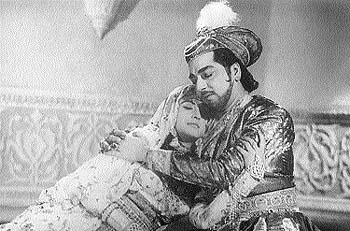
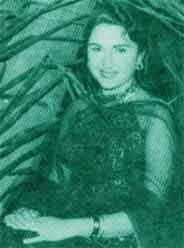
With Shammi Kapoor in Vallah Kya Baat hai
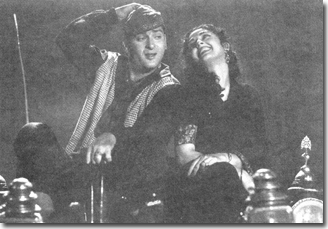
Posted by: jassi Apr 27 2007, 02:41 PM
i think in last pic its geeta bali..
Posted by: jassi Apr 27 2007, 02:45 PM

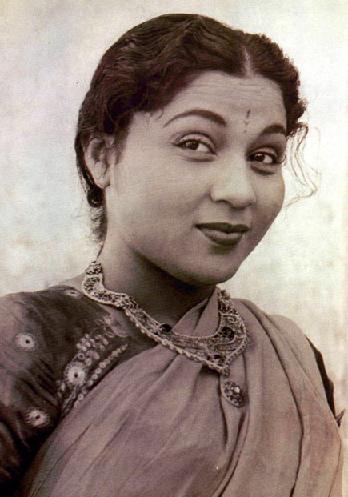
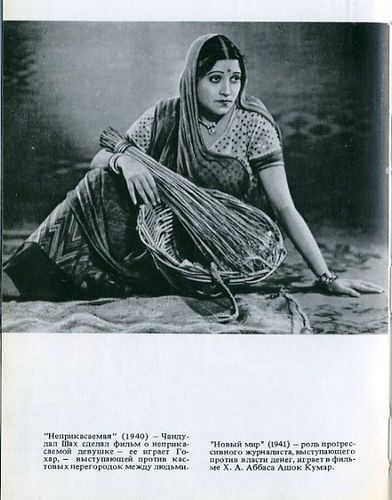
gohar,shobhana samarth n nirupa roy
Posted by: Reeth Apr 27 2007, 02:47 PM
It is Bina rai...i have seen the film Vallah kya baat hai and this is a song sequence..Ek to surat pyari....
Posted by: Reeth Apr 27 2007, 02:48 PM



gohar,shobhana samarth n nirupa roy
Thanks a lot Jassi....
Posted by: maheshks Apr 27 2007, 05:36 PM
SURAIYA (June 15, 1929 - January 31, 2004
Suriya was perhaps the last of the Great singing stars...Born in Lahore, she was an only child.She began her acting career by playing bit roles as a child artiste,between the years 1937-1941.Her major film was TajMahal in 1941.....She did playback as a 13 year old for actress Mehtaab in Sharda(1942)
She was launched as a singing star in Bombay talkies Hamaari Baat(1943).She initially started by playing powerful secondary roles in films like Phool, Anmol Ghadi and Dard,..Her singing career found a mentor in music maestro naushad...K.L.Saigal recommended her as heroine for Tadbir in 1945,she co starred with Saigal in Omar Khayyam and Parwana. In 1947 after the partition when Major actresses Noor jehan and Khurshid migrated to Pakistan, more opportunities appeared for Suraiya....



The Year 1948 - 1949 were the best for her career...She had three major hits Pyar ki Jeet, Badi bahen and Dillagi and she became the highest paid Female Star.At her peak Suriaya generated hysteria among the masses...Her songs were a craze....Her songs like Tere nainon ne chori kiya, Woh paas rahe ya door rahe...Bigdi bananewale, murliwale murli bajaa were hummed in every nook and corner of the country..


while shooting for the film Vidya Suraiya fell in love with Dev Anand and the two of them did six films together....Afsar,shayar,Do sitare,Jeet,Nili , none of them hits, suraiya had no regrets as their love flourished...But suraiya's grandmother opposed the relationship . Suraiya remained unmarried all her life...Their love story was the stuff legends are made of...


She made a hit pair with Talat mehmood in movies like Maalik and Waris.... In 1954 she gave her finest dramatic performance in Mirza Ghalib, in the role of a courtesan, the married Ghalib's lover.....her songs in this film are eternal classics...Yeh na thi hamare kismat, Dil e naadan tujhe hua kya hai..
Some of her memorable films
Anmolghadi pyar ki jeet
Waris
Afsar
Sanam
Malik
Mirza Ghalib
Deewana
Mashooqa
Vidya
Shama
Rustom Sohrab


Suraiya's films startrd flopping in the fifties.....followed some indifferent films, and finally in 1963 after acting in Rustom Soharb with Prithviraj Kapoor she bade farewell to the studios....
She retreated into a world surrounded by her close family..
She died in 2004 ,at the age of 75....



Suriya's Films and songs continue to thrive on speculations,lore and memories....
Suraiya was born in Gujranwala... not Lahore. I haven't seen Mirza Ghalib, but my favorite Suraiya's movie as an actress is Dastaan with Raj Kapoor. As a singer... I like most of her movies.
Anmol Ghadi was also a nice movie... I also find Suraiya more charming than Noor Jehan in this film + I liked Suraiya's songs better than Noor Jehan. Noor Jehan was pregnant at that time I think, and she looks plumpy and bubbly and her acting was completely wooden in the movie.
Noor Jehan best movies (as an actress) came after partition and she looks very pretty in Koel and Intezar.
I have referred to several sources and by all accounts she was born in lahore and later moved to Bombay....wikipedia is the only site on where her birth place is mentioned as Gujranwala, Punjab...
I dont think Suraiya started her career as early as 1937... her first film was as child artiste was Taj Mahal (1941). Incidentally,PrithivirajKapoor was the hero of her first and last film as heroine (Ishara - 1943 and Rustom Sohrab - 1963). She acted with three Kapoors (father + 2 sons) - Raj Kapoor in Dastaan, Shammi Kapoor in Shama Parwana and Prithviraj Kapoor as mentioned above. According to Devinder Bir Kaur "Thus, by the age of 12, she was doing the heroine’s role in Ishara. She was so skinny that they had to pad her all over! And, what was more, she was opposite the ‘grand old man of the Indian screen’, namely Prithviraj Kapoor, who was in his mid-40s. Like everyone in the unit, she too called him ‘Papaji’! Prithviraj admitted that it was difficult romancing with a girl he would call ‘daughter’ when the camera wasn’t whirring. "
Ummer I think Suraiya's first role in the movies was in "Station Master". It appears
that Mumtaj Mahal got released first. Refer to Naushad Saab's comments at her death
and of the late VijayBhatt of Prakash Pictures. They both said it was for the
movie "station master" that suraiya was introduced as singing child star.
The production of the movie started in 1940. You must have downloaded
the video clip of her first song that I uploaded in my thread.
Posted by: jassi Apr 27 2007, 06:21 PM
Suraiya was mainly 40s star,in 50s she was fading actress,i never got to watch any of her film
i guess she was something against dilip kumar,coz i read somewhere she refused to work with dilip kumar in some film called jaanwar by saying that main kisi jaanwar ke saath kaam nahi karungi(i m not goin to work with any jaanwar aka animal) and also refused devdas...
Posted by: noorie Apr 27 2007, 06:42 PM
i m more madhubala fan,and i felt without a reason beena was always compared with legendry beauty
1.Madhubala was said to be having affair with premnath,but later he married beena rai..(i guess after madhubala's break up with dilip,prem was new man in her life,but he went for bina rai..well i too wud not have like madhubala n premnath together.. but i do like premnath as an actor
2.Madhubala was all set to play anarkali when nargis walked out of mughle azam,but at the same time an another film was announced anarkali with bina rai..mughle azam took too much time to get complete..n anarkali come first and got success,but mughle azam which was declaired flop,became a big blockbuster
3.There were talks that both looks similer..there might be,but not for me,madhubala is lifetime beauty..
4.Most big thing which pinched me Filmfare Award,Madhubala was deserving this award,but it went to Beena Rai,she might be good in that film,but not at her best the way madhubala was..if u dont know abt ghoonghat,let me tell u ghar ghar ki kahani(1988)starring rishi,jayaprada,anita raj,govinda n farha was inspired from ghoonghat..but see tday we remember Madhubala n Mughle Azam,but nobody is knowing much abt Ghoonghat and Bina Rai
i give u 4 reasons why i dont like bina rai much
Jassi, has it ever occurred 2 you that you might be just a little prejudiced?
Bina Rai is allright, but she shows a little too much teeth at times;
As 4 Ghunghat, I've seen the movie too. She plays the role of Pradeep Kr's wife while he is deeply in love with Asha Parekh. Very stale concept, and her's was no meaty role that she shud be expected 2 produce Meena ji style histrionics.
Have you seen her in Aurat? She stars opp her real life hubby Premnath.
I don't mind revealing here that to me he comfortably fits in the ugly as hell category.
Reeth is quite familiar with the other famous names on that list.
Noorie
Posted by: jassi Apr 27 2007, 06:57 PM
may be u r right..i have not got to watch much of her work..and there is not enough information abt her availble on net too
Premnath was fine actor..may be not as leading but as character actor he was simply grt..in raj kapoor,raj kumar kohli,firoze khan n manoj kumar's films
Posted by: maheshks Apr 27 2007, 07:31 PM
OK now recognise this lady ![]()
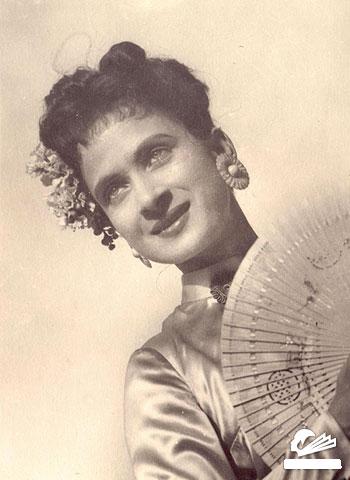
Posted by: Ummer Apr 28 2007, 08:12 AM
OK now recognise this lady

Never seen her before... pretty eyes though
Posted by: Ummer Apr 28 2007, 08:16 AM
may be u r right..i have not got to watch much of her work..and there is not enough information abt her availble on net too
Premnath was fine actor..may be not as leading but as character actor he was simply grt..in raj kapoor,raj kumar kohli,firoze khan n manoj kumar's films
After Bina Roy's marriage with Prem Nath, they both decided that they will only work as pair and their films started to flop. After marriage she tried to make a come back, but that freshness was gone. It is said that Bina's urge to face the camera + fame was so strong that even in old age she was dreaming about it.
There was an article on the net long time ago that Bina Roy-PremNath granddaughter is making her debut in Bollywood, I dont know what happened to her.
Posted by: Ummer Apr 28 2007, 08:34 AM
Suraiya was mainly 40s star,in 50s she was fading actress,i never got to watch any of her film
i guess she was something against dilip kumar,coz i read somewhere she refused to work with dilip kumar in some film called jaanwar by saying that main kisi jaanwar ke saath kaam nahi karungi(i m not goin to work with any jaanwar aka animal) and also refused devdas...
Except Mirza Ghalib, all of Suraiya's movies in the 50's flopped. Many reasons are cited for this... arrival of Lata as playback singer and end of singing star era, failed romance with Dev Anand, Suraiya gaining weight and making wrong decisions in the selections of films. "Nagin" which established Vyjantimala was offered first to Suraiya, but she declined...
Also her rivalry with Nargis was the most famous one... both couldn't tolerate each other. Lots and lots have been written about their rivalry, Suraiya and Nargis Moms were bitter arch rivals. Suraiya Mom's commented that Nargis looks like Papaya and Nargis Mom made similar remark about Suraiya. Suraiya mentioned that Nargis was very envious of her... in the 40s when Nargis was struggling actress and Suraiya was big star. Ofcourse it all changed after the arrival of Lata and the release of Andaz.
According to Raju Bharatan book on Lata, there were also rumours that Suraiya tried to destroy Lata's voice by offering her poisoned meetha paan. Suraiya ofcourse shrugged these rumors off, and Lata after the death of Suraiya paid rich tributes to her and said, some people tried to create bad blood between us, but thanks God me and Suraiya always remained in good terms. In Lata's Biography, Suraiya also paid rich tributes to Lata and how Suraiya was amazed at Lata's singing ability when they recorded their first duet together "O pardesi Musafir". Suraiya said "NOOR JEHAN WAS BORN GREAT, LATA ACHIEVED GREATNESS AND SINGING GREATNESS WAS THRUST UPON ME".
According to the book on Madhubala, in "Mahal" Suraiya was replaced by Madhubala and because of that Suraiya never forgave Madhubala. During the shooting of Singaar (their only film together), if Suraiya asked for one close up, Madhubala made sure that she got 3 close ups and all that stuff.. It was the producer/director of this film who ended up with getting headache in the end.
Posted by: Ummer Apr 28 2007, 08:37 AM
SURAIYA (June 15, 1929 - January 31, 2004
Suriya was perhaps the last of the Great singing stars...Born in Lahore, she was an only child.She began her acting career by playing bit roles as a child artiste,between the years 1937-1941.Her major film was TajMahal in 1941.....She did playback as a 13 year old for actress Mehtaab in Sharda(1942)
She was launched as a singing star in Bombay talkies Hamaari Baat(1943).She initially started by playing powerful secondary roles in films like Phool, Anmol Ghadi and Dard,..Her singing career found a mentor in music maestro naushad...K.L.Saigal recommended her as heroine for Tadbir in 1945,she co starred with Saigal in Omar Khayyam and Parwana. In 1947 after the partition when Major actresses Noor jehan and Khurshid migrated to Pakistan, more opportunities appeared for Suraiya....



The Year 1948 - 1949 were the best for her career...She had three major hits Pyar ki Jeet, Badi bahen and Dillagi and she became the highest paid Female Star.At her peak Suriaya generated hysteria among the masses...Her songs were a craze....Her songs like Tere nainon ne chori kiya, Woh paas rahe ya door rahe...Bigdi bananewale, murliwale murli bajaa were hummed in every nook and corner of the country..


while shooting for the film Vidya Suraiya fell in love with Dev Anand and the two of them did six films together....Afsar,shayar,Do sitare,Jeet,Nili , none of them hits, suraiya had no regrets as their love flourished...But suraiya's grandmother opposed the relationship . Suraiya remained unmarried all her life...Their love story was the stuff legends are made of...


She made a hit pair with Talat mehmood in movies like Maalik and Waris.... In 1954 she gave her finest dramatic performance in Mirza Ghalib, in the role of a courtesan, the married Ghalib's lover.....her songs in this film are eternal classics...Yeh na thi hamare kismat, Dil e naadan tujhe hua kya hai..
Some of her memorable films
Anmolghadi pyar ki jeet
Waris
Afsar
Sanam
Malik
Mirza Ghalib
Deewana
Mashooqa
Vidya
Shama
Rustom Sohrab


Suraiya's films startrd flopping in the fifties.....followed some indifferent films, and finally in 1963 after acting in Rustom Soharb with Prithviraj Kapoor she bade farewell to the studios....
She retreated into a world surrounded by her close family..
She died in 2004 ,at the age of 75....



Suriya's Films and songs continue to thrive on speculations,lore and memories....
Suraiya was born in Gujranwala... not Lahore. I haven't seen Mirza Ghalib, but my favorite Suraiya's movie as an actress is Dastaan with Raj Kapoor. As a singer... I like most of her movies.
Anmol Ghadi was also a nice movie... I also find Suraiya more charming than Noor Jehan in this film + I liked Suraiya's songs better than Noor Jehan. Noor Jehan was pregnant at that time I think, and she looks plumpy and bubbly and her acting was completely wooden in the movie.
Noor Jehan best movies (as an actress) came after partition and she looks very pretty in Koel and Intezar.
I have referred to several sources and by all accounts she was born in lahore and later moved to Bombay....wikipedia is the only site on where her birth place is mentioned as Gujranwala, Punjab...
I dont think Suraiya started her career as early as 1937... her first film was as child artiste was Taj Mahal (1941). Incidentally,PrithivirajKapoor was the hero of her first and last film as heroine (Ishara - 1943 and Rustom Sohrab - 1963). She acted with three Kapoors (father + 2 sons) - Raj Kapoor in Dastaan, Shammi Kapoor in Shama Parwana and Prithviraj Kapoor as mentioned above. According to Devinder Bir Kaur "Thus, by the age of 12, she was doing the heroine’s role in Ishara. She was so skinny that they had to pad her all over! And, what was more, she was opposite the ‘grand old man of the Indian screen’, namely Prithviraj Kapoor, who was in his mid-40s. Like everyone in the unit, she too called him ‘Papaji’! Prithviraj admitted that it was difficult romancing with a girl he would call ‘daughter’ when the camera wasn’t whirring. "
Ummer I think Suraiya's first role in the movies was in "Station Master". It appears
that Mumtaj Mahal got released first. Refer to Naushad Saab's comments at her death
and of the late VijayBhatt of Prakash Pictures. They both said it was for the
movie "station master" that suraiya was introduced as singing child star.
The production of the movie started in 1940. You must have downloaded
the video clip of her first song that I uploaded in my thread.
Yeah Mahesh Bhai you are right... In any case, she didn't start her career in 1937.
Posted by: Ummer Apr 28 2007, 08:45 AM
thank you very much reeth for the article on meena kumari, mahajabeen bano was truly beautiful,
a sweet person and a fantastic actor. she lacks absolutely nothing. i recall many and so many things,
bits and bytes of her life my mom used to tell when i was a child/teenager.
her "Chandan ka Palna" is one of her movies that i cherish.
one fact, that i always felt sad is that she was a tragic queen in her real life.
please put more and more about her including pics.
looking forward to your elegant articles.







Thanks a lot Nature for all the lovely pics ...
I have seen quite a few of Meena kumari's films along wit my mom who is a great fan of hers...
i liked Kohinoor, Yahudi, Azad among the lighter ones and Pakeezah definitely one of her best movies, Sahib bibi aur ghulam , phool aur patthar, Aarti and few more.....The most depressing of the lot was 'Daera' directed by Kamal Amrohi.....but it had a classy song, a bhajan'devta tum ho mera sahara......great song sung by Mohammad rafi and mubarak begum....
Just a passing info... Kamal Amrohi's niece (Kamal's brother's daughter) was librarian at our school in Kuwait. Her name was Hasnaini. Their family was settled in Karachi.
Posted by: Reeth Apr 28 2007, 09:43 AM
i m more madhubala fan,and i felt without a reason beena was always compared with legendry beauty
1.Madhubala was said to be having affair with premnath,but later he married beena rai..(i guess after madhubala's break up with dilip,prem was new man in her life,but he went for bina rai..well i too wud not have like madhubala n premnath together.. but i do like premnath as an actor
2.Madhubala was all set to play anarkali when nargis walked out of mughle azam,but at the same time an another film was announced anarkali with bina rai..mughle azam took too much time to get complete..n anarkali come first and got success,but mughle azam which was declaired flop,became a big blockbuster
3.There were talks that both looks similer..there might be,but not for me,madhubala is lifetime beauty..
4.Most big thing which pinched me Filmfare Award,Madhubala was deserving this award,but it went to Beena Rai,she might be good in that film,but not at her best the way madhubala was..if u dont know abt ghoonghat,let me tell u ghar ghar ki kahani(1988)starring rishi,jayaprada,anita raj,govinda n farha was inspired from ghoonghat..but see tday we remember Madhubala n Mughle Azam,but nobody is knowing much abt Ghoonghat and Bina Rai
i give u 4 reasons why i dont like bina rai much
Jassi, has it ever occurred 2 you that you might be just a little prejudiced?
Bina Rai is allright, but she shows a little too much teeth at times;
As 4 Ghunghat, I've seen the movie too. She plays the role of Pradeep Kr's wife while he is deeply in love with Asha Parekh. Very stale concept, and her's was no meaty role that she shud be expected 2 produce Meena ji style histrionics.
Have you seen her in Aurat? She stars opp her real life hubby Premnath.
I don't mind revealing here that to me he comfortably fits in the ugly as hell category.
Reeth is quite familiar with the other famous names on that list.
Posted by: Reeth Apr 28 2007, 09:46 AM
SURAIYA (June 15, 1929 - January 31, 2004
Suriya was perhaps the last of the Great singing stars...Born in Lahore, she was an only child.She began her acting career by playing bit roles as a child artiste,between the years 1937-1941.Her major film was TajMahal in 1941.....She did playback as a 13 year old for actress Mehtaab in Sharda(1942)
She was launched as a singing star in Bombay talkies Hamaari Baat(1943).She initially started by playing powerful secondary roles in films like Phool, Anmol Ghadi and Dard,..Her singing career found a mentor in music maestro naushad...K.L.Saigal recommended her as heroine for Tadbir in 1945,she co starred with Saigal in Omar Khayyam and Parwana. In 1947 after the partition when Major actresses Noor jehan and Khurshid migrated to Pakistan, more opportunities appeared for Suraiya....



The Year 1948 - 1949 were the best for her career...She had three major hits Pyar ki Jeet, Badi bahen and Dillagi and she became the highest paid Female Star.At her peak Suriaya generated hysteria among the masses...Her songs were a craze....Her songs like Tere nainon ne chori kiya, Woh paas rahe ya door rahe...Bigdi bananewale, murliwale murli bajaa were hummed in every nook and corner of the country..


while shooting for the film Vidya Suraiya fell in love with Dev Anand and the two of them did six films together....Afsar,shayar,Do sitare,Jeet,Nili , none of them hits, suraiya had no regrets as their love flourished...But suraiya's grandmother opposed the relationship . Suraiya remained unmarried all her life...Their love story was the stuff legends are made of...


She made a hit pair with Talat mehmood in movies like Maalik and Waris.... In 1954 she gave her finest dramatic performance in Mirza Ghalib, in the role of a courtesan, the married Ghalib's lover.....her songs in this film are eternal classics...Yeh na thi hamare kismat, Dil e naadan tujhe hua kya hai..
Some of her memorable films
Anmolghadi pyar ki jeet
Waris
Afsar
Sanam
Malik
Mirza Ghalib
Deewana
Mashooqa
Vidya
Shama
Rustom Sohrab


Suraiya's films startrd flopping in the fifties.....followed some indifferent films, and finally in 1963 after acting in Rustom Soharb with Prithviraj Kapoor she bade farewell to the studios....
She retreated into a world surrounded by her close family..
She died in 2004 ,at the age of 75....



Suriya's Films and songs continue to thrive on speculations,lore and memories....
Suraiya was born in Gujranwala... not Lahore. I haven't seen Mirza Ghalib, but my favorite Suraiya's movie as an actress is Dastaan with Raj Kapoor. As a singer... I like most of her movies.
Anmol Ghadi was also a nice movie... I also find Suraiya more charming than Noor Jehan in this film + I liked Suraiya's songs better than Noor Jehan. Noor Jehan was pregnant at that time I think, and she looks plumpy and bubbly and her acting was completely wooden in the movie.
Noor Jehan best movies (as an actress) came after partition and she looks very pretty in Koel and Intezar.
I have referred to several sources and by all accounts she was born in lahore and later moved to Bombay....wikipedia is the only site on where her birth place is mentioned as Gujranwala, Punjab...
I dont think Suraiya started her career as early as 1937... her first film was as child artiste was Taj Mahal (1941). Incidentally,PrithivirajKapoor was the hero of her first and last film as heroine (Ishara - 1943 and Rustom Sohrab - 1963). She acted with three Kapoors (father + 2 sons) - Raj Kapoor in Dastaan, Shammi Kapoor in Shama Parwana and Prithviraj Kapoor as mentioned above. According to Devinder Bir Kaur "Thus, by the age of 12, she was doing the heroine’s role in Ishara. She was so skinny that they had to pad her all over! And, what was more, she was opposite the ‘grand old man of the Indian screen’, namely Prithviraj Kapoor, who was in his mid-40s. Like everyone in the unit, she too called him ‘Papaji’! Prithviraj admitted that it was difficult romancing with a girl he would call ‘daughter’ when the camera wasn’t whirring. "
Ummer I think Suraiya's first role in the movies was in "Station Master". It appears
that Mumtaj Mahal got released first. Refer to Naushad Saab's comments at her death
and of the late VijayBhatt of Prakash Pictures. They both said it was for the
movie "station master" that suraiya was introduced as singing child star.
The production of the movie started in 1940. You must have downloaded
the video clip of her first song that I uploaded in my thread.
Yeah Mahesh Bhai you are right... In any case, she didn't start her career in 1937
You seem very stubborn in your belief...so be it......tho' as per all the sources she did start her career in 1937 as a child artite...
Posted by: jassi Apr 28 2007, 10:04 AM
OK now recognise this lady

Never seen her before... pretty eyes though
i guess durga khote..
Posted by: jassi Apr 28 2007, 10:06 AM
but why suraiya refused to work with dilip kumar..if it was becoz of dev anand..like nargis too walked out some of films starring dilip..its said bcoz of raj kapoor...
Posted by: jassi Apr 28 2007, 10:09 AM
bina rai's granddaughter made her debut in 2002 with her father's home production(prem kishan,i guess he did dulhan wohi jo piya mann bhaye)..yeh mohabbat hai..film was flopped...later she was seen in films like loc and garv...she is married now
Posted by: jassi Apr 28 2007, 10:11 AM
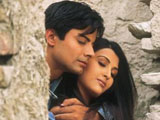
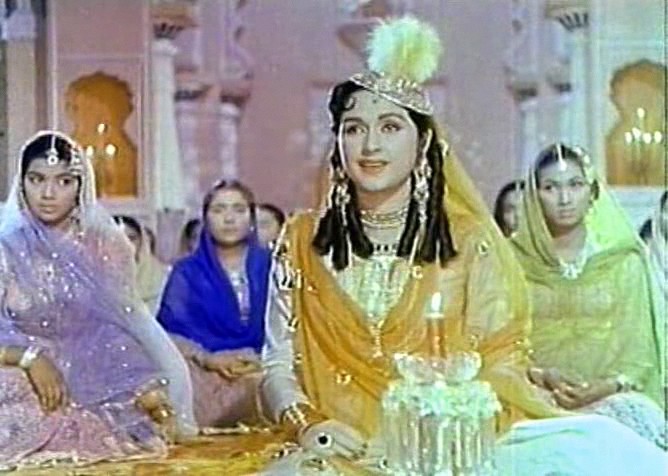
bina rai and her grand daughter akansha
Posted by: jassi Apr 28 2007, 10:13 AM

guess who she is
Posted by: Reeth Apr 28 2007, 10:28 AM
Is it Begum Para??
Posted by: jassi Apr 28 2007, 10:33 AM
right sir
Posted by: maheshks Apr 28 2007, 09:42 PM
OK now recognise this lady

Never seen her before... pretty eyes though
OK now recognise this lady

Never seen her before... pretty eyes though
i guess durga khote..
Maar khaa gaye bachoo. She was a famous heroine during late 30s and early 40s.
Was the heroine of a block buster released during early 40s. All of you have
seen that movie. Here is another photograph of her :

Posted by: noorie Apr 28 2007, 10:29 PM
It isn't 'Fearless' Nadia, is it? ![]()
Noorie
Posted by: Ummer Apr 29 2007, 12:19 AM
but why suraiya refused to work with dilip kumar..if it was becoz of dev anand..like nargis too walked out some of films starring dilip..its said bcoz of raj kapoor...
Maybe bcoz Dilip Kumar was known for his rude behavior? He said to Nadira that she was the most despicable creature he ever met on the sets of Aan. And he also made a similar comment about Lata's Urdu pronounciation as Lata was Marathi.
Posted by: Ummer Apr 29 2007, 12:25 AM
It isn't 'Fearless' Nadia, is it?
Noorie
O ho! Noorie... How could it be Fearless Nadia?
Posted by: Ummer Apr 29 2007, 12:27 AM

guess who she is
Begum Para!
Posted by: sbfan Apr 29 2007, 12:29 AM
can anyone tell something more about begum para
Posted by: noorie Apr 29 2007, 12:32 AM
but why suraiya refused to work with dilip kumar..if it was becoz of dev anand..like nargis too walked out some of films starring dilip..its said bcoz of raj kapoor...
Maybe bcoz Dilip Kumar was known for his rude behavior? He said to Nadira that she was the most despicable creature he ever met on the sets of Aan. And he also made a similar comment about Lata's Urdu pronounciation as Lata was Marathi.
"Rude" ? I wudn't agree Ummer.
I like his outspokenness. It's a pleasing quality according to me.
Evidently other women thought so too;.....................Madhubala, Saira Bano
Noorie
Posted by: Ummer Apr 29 2007, 12:39 AM
SURAIYA (June 15, 1929 - January 31, 2004
Suriya was perhaps the last of the Great singing stars...Born in Lahore, she was an only child.She began her acting career by playing bit roles as a child artiste,between the years 1937-1941.Her major film was TajMahal in 1941.....She did playback as a 13 year old for actress Mehtaab in Sharda(1942)
She was launched as a singing star in Bombay talkies Hamaari Baat(1943).She initially started by playing powerful secondary roles in films like Phool, Anmol Ghadi and Dard,..Her singing career found a mentor in music maestro naushad...K.L.Saigal recommended her as heroine for Tadbir in 1945,she co starred with Saigal in Omar Khayyam and Parwana. In 1947 after the partition when Major actresses Noor jehan and Khurshid migrated to Pakistan, more opportunities appeared for Suraiya....



The Year 1948 - 1949 were the best for her career...She had three major hits Pyar ki Jeet, Badi bahen and Dillagi and she became the highest paid Female Star.At her peak Suriaya generated hysteria among the masses...Her songs were a craze....Her songs like Tere nainon ne chori kiya, Woh paas rahe ya door rahe...Bigdi bananewale, murliwale murli bajaa were hummed in every nook and corner of the country..


while shooting for the film Vidya Suraiya fell in love with Dev Anand and the two of them did six films together....Afsar,shayar,Do sitare,Jeet,Nili , none of them hits, suraiya had no regrets as their love flourished...But suraiya's grandmother opposed the relationship . Suraiya remained unmarried all her life...Their love story was the stuff legends are made of...


She made a hit pair with Talat mehmood in movies like Maalik and Waris.... In 1954 she gave her finest dramatic performance in Mirza Ghalib, in the role of a courtesan, the married Ghalib's lover.....her songs in this film are eternal classics...Yeh na thi hamare kismat, Dil e naadan tujhe hua kya hai..
Some of her memorable films
Anmolghadi pyar ki jeet
Waris
Afsar
Sanam
Malik
Mirza Ghalib
Deewana
Mashooqa
Vidya
Shama
Rustom Sohrab


Suraiya's films startrd flopping in the fifties.....followed some indifferent films, and finally in 1963 after acting in Rustom Soharb with Prithviraj Kapoor she bade farewell to the studios....
She retreated into a world surrounded by her close family..
She died in 2004 ,at the age of 75....



Suriya's Films and songs continue to thrive on speculations,lore and memories....
Suraiya was born in Gujranwala... not Lahore. I haven't seen Mirza Ghalib, but my favorite Suraiya's movie as an actress is Dastaan with Raj Kapoor. As a singer... I like most of her movies.
Anmol Ghadi was also a nice movie... I also find Suraiya more charming than Noor Jehan in this film + I liked Suraiya's songs better than Noor Jehan. Noor Jehan was pregnant at that time I think, and she looks plumpy and bubbly and her acting was completely wooden in the movie.
Noor Jehan best movies (as an actress) came after partition and she looks very pretty in Koel and Intezar.
I have referred to several sources and by all accounts she was born in lahore and later moved to Bombay....wikipedia is the only site on where her birth place is mentioned as Gujranwala, Punjab...
I dont think Suraiya started her career as early as 1937... her first film was as child artiste was Taj Mahal (1941). Incidentally,PrithivirajKapoor was the hero of her first and last film as heroine (Ishara - 1943 and Rustom Sohrab - 1963). She acted with three Kapoors (father + 2 sons) - Raj Kapoor in Dastaan, Shammi Kapoor in Shama Parwana and Prithviraj Kapoor as mentioned above. According to Devinder Bir Kaur "Thus, by the age of 12, she was doing the heroine’s role in Ishara. She was so skinny that they had to pad her all over! And, what was more, she was opposite the ‘grand old man of the Indian screen’, namely Prithviraj Kapoor, who was in his mid-40s. Like everyone in the unit, she too called him ‘Papaji’! Prithviraj admitted that it was difficult romancing with a girl he would call ‘daughter’ when the camera wasn’t whirring. "
Ummer I think Suraiya's first role in the movies was in "Station Master". It appears
that Mumtaj Mahal got released first. Refer to Naushad Saab's comments at her death
and of the late VijayBhatt of Prakash Pictures. They both said it was for the
movie "station master" that suraiya was introduced as singing child star.
The production of the movie started in 1940. You must have downloaded
the video clip of her first song that I uploaded in my thread.
Yeah Mahesh Bhai you are right... In any case, she didn't start her career in 1937
You seem very stubborn in your belief...so be it......tho' as per all the sources she did start her career in 1937 as a child artite...
I am not stubborn in my belief Reeth. There were other Suraiya's working in the film industry at that time too including Suraiya Chaudary and Suraiya Shamsi. It is very common to mix-up the films of the well known Stars with obscure film stars of the same name. It happened with the filmography of Noor Jehan too as there was another Noor Jehan working in the film industry in films like Laila and Sophia etc. Suraiya herself mentioned that she made her debut in 1941 and was discovered by Naushad.
Suraiya - by Sultan Arshad (Images Dawn, Pakistani Newspaper).
I had the privilege of meeting actress Suraiya and having lengthy conversations with her on several occasions during my tenure as chief representative of our national airline in Bombay, in the nineties. It was during those meetings that she narrated several interesting anecdotes concerning different phases of her career and the impact of some of the master composers on her style of singing. Such as how Anil'da (Biswas) taught her to breathe in while singing so that it was not caught by the microphone or how Khwaja Saheb (Khursheed Anwer) would lean over the harmonium, with his long hair covering half of his face, while singing a tune to her: Naushad Saheb put her to rigorous rehearsals even when she used to be dead tired after marathon shooting schedules: or how while recording her first song as a child she was made to stand on a wooden stool in order to reach the height of the microphone.
She often recalled fondly the days when as a child from her Marine Drive residence she would walk down to All India Radio (A.I.R.) studio to participate in the children's programme in which Raj Kapoor and Madan Mohan who later attained fame as an actor, a film maker and music director respectively, used to be her co-artists. The legendary Z.A.Bukhari was then the station director at the A.I.R. Bombay.
Suraiya entered the film industry as a child actress with Taj Mahal (1941), for which maestro S.D. Burman, who was till then known for his Bengali songs, rendered his first Hindi song Prem ki pyaari nishani under the musical baton of Madhulal Master. Suraiya's next assignment was for Tamanna (1942), for which she also rendered her first song (Jaago aayi usha), a duet with then budding singer Mannadey. It was tuned by Manna's uncle the well known singer, music director and actor K.C. Dey.
After few other rather insignificant singing and acting assignments (Ujala, Station Master) maestro Naushad selected her as the playback voice for leading lady Mehtab in Sharda (1942). The movie became a turning point in Suraiya's career as a singer, with two of her songs Panchhi ja, peechhe raha hai bachpan mera and Mere dil ko sajan samjhado becoming very popular. Incidentally, Mehtab was the only actress to whom Suraiya lent her voice in three movies (Sharda, Qanoon and Sanjog). It was quite an incidence per force, that many years later in a female duet situation in Shama (1961) besides singing for herself, she became the ghost voice for Nimmi as well when the other singer Suman Kalyanpur failed to dub her portion of the song. Also two of her songs (Hawa uda kar layi, O bewafa karke jafa - music: Dhani Ram) recorded for an incomplete movie of her's, were later included in another film Taqdeer (1958) and picturized on its leading lady Shyama.
Suraiya graduated to adult roles with Ishara (1943), playing second lead opposite small-timer Satish with Prithviraj Kapoor and Swarnlata playing the leading roles. In this movie she had only two songs to her credit, a solo (Panghat pe muraliya baaje) and a duet (Baaghon mein koyal boli) with Satish. In Station Master and Ishara her voice was used for the character she played. In Anmol Ghadi she was the third angle of the love triangle, the other two being Noor Jehan and Surendranath. She sang three songs in it.
There is no denying the fact that Naushad Ali, Husnlal - Bhagat Ram and Khursheed Anwer played significant roles in Suraiya's career but such stalwarts as Anil Biswas, S.D. Burman and Ghulam Mohammad also enhanced her popularity as a singer. Then there were other music directors she teamed up with just once or twice but rendered some extremely melodious though not so popular numbers.
In a career spanning 22 years, Suraiya sung in five or six films and acted in approximately 65 movies which do not include the incomplete ones like Jaanwar (with Dilip Kumar) and Paagal Khaana (with Bharat Bhushan).
From the late forties to the early fifties she remained the highest paid as well as the most worshipped star of the Indian cinema. Even now when she makes a rare appearance in a public function, bejewelled and bedecked, she is revered and admired more than most of the stars of today. The aura remains.
Posted by: Ummer Apr 29 2007, 12:44 AM
but why suraiya refused to work with dilip kumar..if it was becoz of dev anand..like nargis too walked out some of films starring dilip..its said bcoz of raj kapoor...
Maybe bcoz Dilip Kumar was known for his rude behavior? He said to Nadira that she was the most despicable creature he ever met on the sets of Aan. And he also made a similar comment about Lata's Urdu pronounciation as Lata was Marathi.
"Rude" ? I wudn't agree Ummer.
I like his outspokenness. It's a pleasing quality according to me.
Evidently other women thought so too;.....................Madhubala, Saira Bano
Noorie
Calling someone despicable is outspokenness?
Posted by: noorie Apr 29 2007, 12:49 AM
It isn't 'Fearless' Nadia, is it?
Noorie
O ho! Noorie... How could it be Fearless Nadia?
You are right Ummer, I think it cud be Leela Chitnis.
Please confirm Mahesh.
Else my mind will start playing tricks on me and even imagine that it is Shobhna Samarth.
Noorie
Posted by: noorie Apr 29 2007, 12:51 AM
but why suraiya refused to work with dilip kumar..if it was becoz of dev anand..like nargis too walked out some of films starring dilip..its said bcoz of raj kapoor...
Maybe bcoz Dilip Kumar was known for his rude behavior? He said to Nadira that she was the most despicable creature he ever met on the sets of Aan. And he also made a similar comment about Lata's Urdu pronounciation as Lata was Marathi.
"Rude" ? I wudn't agree Ummer.
I like his outspokenness. It's a pleasing quality according to me.
Evidently other women thought so too;.....................Madhubala, Saira Bano
Noorie
Calling someone despicable is outspokenness?
A Maharashtrian, speaking Urdu 'zubaan', wud retain the flavor of "daal-bhaat"( dal and rice ) - read vegetarian.
Lata ji proved him wrong, didn't she?
Noorie
Posted by: Ummer Apr 29 2007, 12:54 AM
can anyone tell something more about begum para
Begum Para was a B-Grade actress mostly paired with Sheikh Mukhtar in films like Ustad Pedro etc. After partition she along with Mehboob Khan and some other established film stars visited Karachi-Pakistan to see if the condition was right to work there. But seeing the non-existent film industry they all went back to India. Although Mehboob Khan's younger brother Pyare Khan and Begum Para's sister stayed back. Here is the detailed interview of Begum Para
MS OOMPH - by V Gangadhar
Somewhere in 1953, Fort Cochin in Kerala was hit by a bomb. I was then in school there and thoroughly enjoyed the experience.
The bomb was called Begum Para. And it came packaged in a Hindi film, Ustad Pedro, produced and directed by the then well-known actor, Sheikh Mukhtar. Mukhtar was tall, well-built and ruggedly handsome. But he had very stiff competition in Begum Para, unanimously acknowledged to be Bollywood's sex bomb.
The film magazines called her the oomph girl, the girl with 'it'. Whatever she had, Para set my blood flowing. She had sultry, come-hither looks, an eye-popping figure, one she was not afraid to show off. She wore trousers, tight dresses and danced enticingly to the tunes of western music.
Ustad Pedro was a fun film. It was packed with action, romance, stunts and, of course, that wonderful, curvaceous woman. As Sheikh Mukhtar carried off the prized heroine at the end of the film, all the boys watching the film sighed enviously.
Hindi screen had its quota of women with smouldering good looks, who dressed seductively and who were ready to respond positively to a pass from the admiring male. But such women were normally cast as vamps because most heroines had to look virginal and god-fearing and play second fiddle to the heroes.
Not Begum Para. Her sexuality on the screen was electric. Film magazines of those days wrote endlessly about the frank utterances and open lifestyles of Begim Para and her sister-in-law, Protima Dasgupta. She was not a hypocrite, she always called a spade a spade.
I learnt this when I dropped in at her small flat in suburban Versova. The cool breeze from the sea was welcome, but not the stench of drying fish. The drawing room was full of photographs. Of Para's late husband Nasir Khan, her two sons and daughter. There are books everywhere. Enid Blyton for the grand-daughter along with classics -- theIliad, the Odyssey, the works of D H Lawrence as well as pulp fiction by Ludlum and Collins.
The passage of time had taken its toll. Begum Para had bloated up, the hair has greyed and she moved around with difficulty. There was little sign of who she once was. But once she began to speak, the old magic reappeared like abracadbra.
She had endured a lot in recent years. Nasir Khan died in 1974. He was just 49 and she had to bring up three children on her own. For years there was a long misunderstanding with her brother-in-law Dilip Kumar (she refused to talk about it) and the family bungalow on upmarket Carter Road had to be sold. One son, Ayub, works in films (he was most recently seen in Mrityudand), another son and her daughter are in advertising. Life had not been easy for the family, but then Begum Para, by all accounts, had always been a fighter.
The early days, though, were peaceful and happy. The family came from Jalandhar but moved to Bikaner, where her father Mian-Ehsan-Ul-Haque became the chief justice. The family was large, 10 in all, but they had lots of fun and the indulgent parents often joined in.
Para went to school and then college at Aligarh. Hostel life was quite pleasant. While sticking to tradition, her family was quite broad-minded. "We never wore purdah or anything like that," she explains.
"We were allowed to watch films and I enjoyed the experience." One of her earliest heroes, was the debonair Motilal. "I wrote fan letters to him, and he always replied. Later, when I joined films, we became good friends."
Still in her early teens, Begum Para came to Bombay to spend her holidays with sister-in-law Protima Dasgupta who was already acting in films like Court Dancer. Her home was frequented by film people. Perky, pretty Para invited instant attention and producers promptly offered her roles. Dasgupta persuaded her to accept some of the offers.
"My family was not very happy," recalls Para. "But finally, Protima and I convinced them." Born plain Para, she added a Begum to her name.
Thus it was that a nervous, excited, young girl of 17 faced the camera for the first time in her life on the sets of Chand. Her co-star was Prem Adib, a famous hero in those days. The film was shot at Prabhat Studio in Pune and was a family social.
"Oh, I had no acting experience at all," she laughs. "But director B D Kashyap was very understanding and patient, and made me feel at ease."
Did you have any love scenes, I asked. "Oh, very innocent ones," she smiled. "The lead pair looked at each other, sang songs and perhaps held hands. Films in those days were so different. But everyone on the sets, including Prem Adib, were very co-operative."
Chand was fairly successful. Para did not look back and settled down to a film career in Bombay, sharing a flat with her sister-in-law at Worli Sea Face. From 1945, for over 10 years, she made several movies -- Sohini Mahiwal, Mehendi, Shama, Pedro, Dada, Dara, the last three with the swashbuckling Sheikh Mukhtar. The films did well at the box office.
"I played emotional roles and also essayed roles of fashionable women," she remembers. The "it" image was a big thing in those days. Para often wore pants and jeans, dressed provocatively and championed an unconventional lifestyle. Naturally, she was regularly featured in film magazines.
"I had a good figure, and I knew I had one," she laughed. "And if the magazines wanted to feature me in provocative poses, I did not mind".
While her career was going strong, she met Nasir Khan (Dilip Kumar's brother) on the sets of Lootera. Nasir had made a name for himself with some good films with Nutan. "We liked each other, but it was not love at first sight."
They began meeting more often and got married in 1958. Did their families support the marriage, I asked.
"Oh, we were old enough to do what we wanted." she replied diplomatically.
Nasir Khan did not want her to act and she quit the screen. "I was quite happy to stay at home and look after the family," she says. Nasir Khan had a heart condition which he chose to neglect, and a heart attack claimed him in 1974.
It was a shattering blow and she had to face the crisis alone. For about 18 months, she went to Karachi and lived with her sister, who had settled down in Pakistan. "But India was my home and I was back to bring up my children," she explained.
It was then she missed her work in films. As long as Nasir Khan was alive, life had been smooth. But now many adjustments had to be made. But she managed to bring up her children and settle them in life.
Looking back on her career in films, she says she had not taken it very seriously. "It was fun and interesting while it lasted."
She cherished her friendships formed during those days. Nargis and Geeta Bali were close friends. So were, Motilal, Nimmi, Nirupa Roy, Nadira, Shyama and Manorama.
A couple of days before our meeting. Nirupa, Nimmi and Shyama had dropped in for a chat. "We meet quite often," laughed Begum Para. "We talk, gossip, laugh... They are wonderful people". While I was chatting with her, the telephone rang. It was another friend, kathak queen Sitara Devi. They agreed to meet later that evening.
She thinks highly of Motilal, Dilip Kumar, Amitabh Bachchan and Naseeruddin Shah. Among today's heroines, she says Kajol is the best. "Oh, that girl lights up the screen with her presence," she exclaims.
It was time to leave. We had chatted for nearly two hours. But I was certain about one thing. In my book of interesting people she goes down as Genuine Stuff!
Posted by: sbfan Apr 29 2007, 12:54 AM
actually when naushad made lata meet dilip by saying that this is new girl marathi one as singer. then he commented ke narathi singers se daal bhaat ki boo aati hai..
Posted by: Ummer Apr 29 2007, 01:00 AM
actually when naushad made lata meet dilip by saying that this is new girl marathi one as singer. then he commented ke narathi singers se daal bhaat ki boo aati hai..
Yeah that comment! It was Anil Biswas not Naushad.
Posted by: sbfan Apr 29 2007, 01:02 AM
and it was some meeting on railway station or train??
Posted by: parag_sankla Apr 29 2007, 01:04 AM
Ummer bhai, thanks for interesting info on Beghum Para.
There is always more to a person than the on-screen image !
Cheers
Parag
Posted by: noorie Apr 29 2007, 01:11 AM
can anyone tell something more about begum para
Begum Para was a B-Grade actress mostly paired with Sheikh Mukhtar in films like Ustad Pedro etc. After partition she along with Mehboob Khan and some other established film stars visited Karachi-Pakistan to see if the condition was right to work there. But seeing the non-existent film industry they all went back to India. Although Mehboob Khan's younger brother Pyare Khan and Begum Para's sister stayed back. Here is the detailed interview of Begum Para
MS OOMPH - by V Gangadhar
Somewhere in 1953, Fort Cochin in Kerala was hit by a bomb. I was then in school there and thoroughly enjoyed the experience.
The bomb was called Begum Para. And it came packaged in a Hindi film, Ustad Pedro, produced and directed by the then well-known actor, Sheikh Mukhtar. Mukhtar was tall, well-built and ruggedly handsome. But he had very stiff competition in Begum Para, unanimously acknowledged to be Bollywood's sex bomb.
The film magazines called her the oomph girl, the girl with 'it'. Whatever she had, Para set my blood flowing. She had sultry, come-hither looks, an eye-popping figure, one she was not afraid to show off. She wore trousers, tight dresses and danced enticingly to the tunes of western music.
Ustad Pedro was a fun film. It was packed with action, romance, stunts and, of course, that wonderful, curvaceous woman. As Sheikh Mukhtar carried off the prized heroine at the end of the film, all the boys watching the film sighed enviously.
Hindi screen had its quota of women with smouldering good looks, who dressed seductively and who were ready to respond positively to a pass from the admiring male. But such women were normally cast as vamps because most heroines had to look virginal and god-fearing and play second fiddle to the heroes.
Not Begum Para. Her sexuality on the screen was electric. Film magazines of those days wrote endlessly about the frank utterances and open lifestyles of Begim Para and her sister-in-law, Protima Dasgupta. She was not a hypocrite, she always called a spade a spade.
I learnt this when I dropped in at her small flat in suburban Versova. The cool breeze from the sea was welcome, but not the stench of drying fish. The drawing room was full of photographs. Of Para's late husband Nasir Khan, her two sons and daughter. There are books everywhere. Enid Blyton for the grand-daughter along with classics -- theIliad, the Odyssey, the works of D H Lawrence as well as pulp fiction by Ludlum and Collins.
The passage of time had taken its toll. Begum Para had bloated up, the hair has greyed and she moved around with difficulty. There was little sign of who she once was. But once she began to speak, the old magic reappeared like abracadbra.
She had endured a lot in recent years. Nasir Khan died in 1974. He was just 49 and she had to bring up three children on her own. For years there was a long misunderstanding with her brother-in-law Dilip Kumar (she refused to talk about it) and the family bungalow on upmarket Carter Road had to be sold. One son, Ayub, works in films (he was most recently seen in Mrityudand), another son and her daughter are in advertising. Life had not been easy for the family, but then Begum Para, by all accounts, had always been a fighter.
The early days, though, were peaceful and happy. The family came from Jalandhar but moved to Bikaner, where her father Mian-Ehsan-Ul-Haque became the chief justice. The family was large, 10 in all, but they had lots of fun and the indulgent parents often joined in.
Para went to school and then college at Aligarh. Hostel life was quite pleasant. While sticking to tradition, her family was quite broad-minded. "We never wore purdah or anything like that," she explains.
"We were allowed to watch films and I enjoyed the experience." One of her earliest heroes, was the debonair Motilal. "I wrote fan letters to him, and he always replied. Later, when I joined films, we became good friends."
Still in her early teens, Begum Para came to Bombay to spend her holidays with sister-in-law Protima Dasgupta who was already acting in films like Court Dancer. Her home was frequented by film people. Perky, pretty Para invited instant attention and producers promptly offered her roles. Dasgupta persuaded her to accept some of the offers.
"My family was not very happy," recalls Para. "But finally, Protima and I convinced them." Born plain Para, she added a Begum to her name.
Thus it was that a nervous, excited, young girl of 17 faced the camera for the first time in her life on the sets of Chand. Her co-star was Prem Adib, a famous hero in those days. The film was shot at Prabhat Studio in Pune and was a family social.
"Oh, I had no acting experience at all," she laughs. "But director B D Kashyap was very understanding and patient, and made me feel at ease."
Did you have any love scenes, I asked. "Oh, very innocent ones," she smiled. "The lead pair looked at each other, sang songs and perhaps held hands. Films in those days were so different. But everyone on the sets, including Prem Adib, were very co-operative."
Chand was fairly successful. Para did not look back and settled down to a film career in Bombay, sharing a flat with her sister-in-law at Worli Sea Face. From 1945, for over 10 years, she made several movies -- Sohini Mahiwal, Mehendi, Shama, Pedro, Dada, Dara, the last three with the swashbuckling Sheikh Mukhtar. The films did well at the box office.
"I played emotional roles and also essayed roles of fashionable women," she remembers. The "it" image was a big thing in those days. Para often wore pants and jeans, dressed provocatively and championed an unconventional lifestyle. Naturally, she was regularly featured in film magazines.
"I had a good figure, and I knew I had one," she laughed. "And if the magazines wanted to feature me in provocative poses, I did not mind".
While her career was going strong, she met Nasir Khan (Dilip Kumar's brother) on the sets of Lootera. Nasir had made a name for himself with some good films with Nutan. "We liked each other, but it was not love at first sight."
They began meeting more often and got married in 1958. Did their families support the marriage, I asked.
"Oh, we were old enough to do what we wanted." she replied diplomatically.
Nasir Khan did not want her to act and she quit the screen. "I was quite happy to stay at home and look after the family," she says. Nasir Khan had a heart condition which he chose to neglect, and a heart attack claimed him in 1974.
It was a shattering blow and she had to face the crisis alone. For about 18 months, she went to Karachi and lived with her sister, who had settled down in Pakistan. "But India was my home and I was back to bring up my children," she explained.
It was then she missed her work in films. As long as Nasir Khan was alive, life had been smooth. But now many adjustments had to be made. But she managed to bring up her children and settle them in life.
Looking back on her career in films, she says she had not taken it very seriously. "It was fun and interesting while it lasted."
She cherished her friendships formed during those days. Nargis and Geeta Bali were close friends. So were, Motilal, Nimmi, Nirupa Roy, Nadira, Shyama and Manorama.
A couple of days before our meeting. Nirupa, Nimmi and Shyama had dropped in for a chat. "We meet quite often," laughed Begum Para. "We talk, gossip, laugh... They are wonderful people". While I was chatting with her, the telephone rang. It was another friend, kathak queen Sitara Devi. They agreed to meet later that evening.
She thinks highly of Motilal, Dilip Kumar, Amitabh Bachchan and Naseeruddin Shah. Among today's heroines, she says Kajol is the best. "Oh, that girl lights up the screen with her presence," she exclaims.
It was time to leave. We had chatted for nearly two hours. But I was certain about one thing. In my book of interesting people she goes down as Genuine Stuff!
Thanks Ummer.
Has anyone read Khushwant Singh’s autobiography, Truth, Love and a Little Malice ?
There's a very interesting
Noorie
Posted by: sbfan Apr 29 2007, 01:13 AM
CINEMA
The return of Begum Para
V. GANGADHAR
The siren of the 1950s Hindi cinema talks of her comeback to the silver screen — as a grandmother this time.
The sparkle remains: Begum Para in her heyday.
IT'S probably the longest ever break from acting? The news is that Begum Para, the sex siren of the 1950s, is returning to Bollywood. Though the sparkle in her eyes remains, the svelte, sexy figure is gone; so have the quicksilver movements. These do not matter as Begum Para is playing a grandmother in Sanjay Leela Bansali's next film, "Sawariya" starring newcomers, Ranbir Rishi Kapoor and Sonam Anil Kapoor. She has not faced the camera after her last film, "Kar Bala" with Bhagwan Dada in the early 1960s.
While still at the peak of her career, Begum Para married Nasir Khan, Dilip Kumar's brother, in 1958 and quit acting. Nasir saab died in 1974 and Begum Para had a tough time bringing up her three children. Today, son Ayub Khan is in films while the former star lives with her daughter and grandchildren in Versova, Mumbai.
No regrets
She has no regrets at the disruption of her career. Begum Para never thought of a comeback because she had heard reports of star tantrums and lack of respect to senior actors on the sets. "I had heard horror stories on this topic," she observed. "But Sanjay Bansali, whom I had known from his childhood, assured me nothing like that would happen on his sets and I agreed."
Still the news of her return took fans by surprise. Suddenly TV channels were focusing on her career and her image as a sex symbol. Sometime back, I met her for a long chat and found her charming and articulate. "I had a good figure and did not mind wearing trousers, skirts and shirts which emphasised it," she explained. "I always had some kind of a bindaas image." Film magazines focused on her "oomph and smouldering "come hither" look. As a schoolboy in 1953, I watched "Ustad Pedro" and envied the swashbuckling hero, Sheikh Mukhtar, who carryied her away at the end!
Heroine at 17
A native of Jalandhar but brought up in Bikaner, Para (she added the `Begum' later) belonged to a liberal Muslim family. "No purdah for us," she recollected. "We were even allowed to watch films. I wrote fan letters to my favourite, Motilal, later a good friend." During a holiday in Bombay, Para's sister-in-law Protima Das Gupta — who was already in films — persuaded her to accept offers to act. Her family reluctantly agreed. At 17, she was the heroine of "Chand" where the romantic scenes with hero, Prem Adib, included looking into his eyes and holding hands briefly! "I had absolutely no acting experience," admitted Begum Para. "But it was fun, the director, co-stars were all very kind and co o perative."
Settling down in Bombay in 1945, Para acted in dozens of films including, "Sohini Mahiwal", "Mehendi", "Shama", "Pedro", "Dada" and "Dara" — the last three with action hero, Sheikh Mukthar. The glamour in the films of those days was reserved for the vamp and prevented Para from getting more A-grade films where the long-suffering heroine had to be a "Sati-Savitri".
Para always dressed according to the latest fashion and was a photographer's delight. She was a hit with male audiences and her arrival on the screen was always greeted with wolf whistles. "It was fun," she recollected. "You see, I did not take my career seriously and accepted whatever roles came my way."
On the sets of "Lootera" Begum Para met Nasir Khan. It was not love at first sight but they got married, which meant the end of her career. After Nasir's death, she spent sometime with her sister in Pakistan but India was home. Because of her independent nature, she did not get along with Dilip Kumar, though now the misunderstandings have been sorted out.
Wonderful friends
Bollywood brought her wonderful friends like Shyama, Nadira, Nargis, Motilal and dancer Sitara Devi. I spotted a wide variety of books in the flat — Enid Blyton, classics including The Iliad and The Odyssey, D.H. Lawrence, Robert Ludlum...
Begum Para now spends much of her time with her grandchildren, watching movies. The current excess of violence and sex in movies, the suggestive lyrics do not appeal to her. Most of the heroines look alike and wear too much make up, she says, but she admires Amitabh Bachchan, Naseeruddin Shah and Kajol. "How she glows on the screen," she exclaims. Though Begum Para is excited about "Sawariya", she has no long-term plans for her comeback. "I just want to have some fun," she smiled. That had always been her approach to acting.
Attached image(s)
Posted by: sbfan Apr 29 2007, 01:15 AM
noorie plz share that incident
Posted by: sbfan Apr 29 2007, 01:21 AM
 begum para with mukesh as per singermukesh.com but i cant trace her
begum para with mukesh as per singermukesh.com but i cant trace her
here is about her new movie saanawariya
http://en.wikipedia.org/wiki/Saawariya
Posted by: Ummer Apr 29 2007, 01:21 AM
and it was some meeting on railway station or train??
yeah lol.
Posted by: Ummer Apr 29 2007, 01:23 AM
 begum para with mukesh as per singermukesh.com but i cant trace her
begum para with mukesh as per singermukesh.com but i cant trace herhere is about her new movie saanawariya
http://en.wikipedia.org/wiki/Saawariya
She is in front with dopatta on her shoulder. Begum Para with Sunil Dutt :-
Attached image(s)
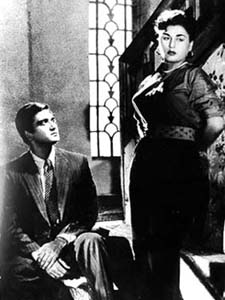
Posted by: sbfan Apr 29 2007, 01:24 AM
o really she is extremely beautiful..
Posted by: Ummer Apr 29 2007, 01:54 AM
can anyone tell something more about begum para
Begum Para was a B-Grade actress mostly paired with Sheikh Mukhtar in films like Ustad Pedro etc. After partition she along with Mehboob Khan and some other established film stars visited Karachi-Pakistan to see if the condition was right to work there. But seeing the non-existent film industry they all went back to India. Although Mehboob Khan's younger brother Pyare Khan and Begum Para's sister stayed back. Here is the detailed interview of Begum Para
MS OOMPH - by V Gangadhar
Somewhere in 1953, Fort Cochin in Kerala was hit by a bomb. I was then in school there and thoroughly enjoyed the experience.
The bomb was called Begum Para. And it came packaged in a Hindi film, Ustad Pedro, produced and directed by the then well-known actor, Sheikh Mukhtar. Mukhtar was tall, well-built and ruggedly handsome. But he had very stiff competition in Begum Para, unanimously acknowledged to be Bollywood's sex bomb.
The film magazines called her the oomph girl, the girl with 'it'. Whatever she had, Para set my blood flowing. She had sultry, come-hither looks, an eye-popping figure, one she was not afraid to show off. She wore trousers, tight dresses and danced enticingly to the tunes of western music.
Ustad Pedro was a fun film. It was packed with action, romance, stunts and, of course, that wonderful, curvaceous woman. As Sheikh Mukhtar carried off the prized heroine at the end of the film, all the boys watching the film sighed enviously.
Hindi screen had its quota of women with smouldering good looks, who dressed seductively and who were ready to respond positively to a pass from the admiring male. But such women were normally cast as vamps because most heroines had to look virginal and god-fearing and play second fiddle to the heroes.
Not Begum Para. Her sexuality on the screen was electric. Film magazines of those days wrote endlessly about the frank utterances and open lifestyles of Begim Para and her sister-in-law, Protima Dasgupta. She was not a hypocrite, she always called a spade a spade.
I learnt this when I dropped in at her small flat in suburban Versova. The cool breeze from the sea was welcome, but not the stench of drying fish. The drawing room was full of photographs. Of Para's late husband Nasir Khan, her two sons and daughter. There are books everywhere. Enid Blyton for the grand-daughter along with classics -- theIliad, the Odyssey, the works of D H Lawrence as well as pulp fiction by Ludlum and Collins.
The passage of time had taken its toll. Begum Para had bloated up, the hair has greyed and she moved around with difficulty. There was little sign of who she once was. But once she began to speak, the old magic reappeared like abracadbra.
She had endured a lot in recent years. Nasir Khan died in 1974. He was just 49 and she had to bring up three children on her own. For years there was a long misunderstanding with her brother-in-law Dilip Kumar (she refused to talk about it) and the family bungalow on upmarket Carter Road had to be sold. One son, Ayub, works in films (he was most recently seen in Mrityudand), another son and her daughter are in advertising. Life had not been easy for the family, but then Begum Para, by all accounts, had always been a fighter.
The early days, though, were peaceful and happy. The family came from Jalandhar but moved to Bikaner, where her father Mian-Ehsan-Ul-Haque became the chief justice. The family was large, 10 in all, but they had lots of fun and the indulgent parents often joined in.
Para went to school and then college at Aligarh. Hostel life was quite pleasant. While sticking to tradition, her family was quite broad-minded. "We never wore purdah or anything like that," she explains.
"We were allowed to watch films and I enjoyed the experience." One of her earliest heroes, was the debonair Motilal. "I wrote fan letters to him, and he always replied. Later, when I joined films, we became good friends."
Still in her early teens, Begum Para came to Bombay to spend her holidays with sister-in-law Protima Dasgupta who was already acting in films like Court Dancer. Her home was frequented by film people. Perky, pretty Para invited instant attention and producers promptly offered her roles. Dasgupta persuaded her to accept some of the offers.
"My family was not very happy," recalls Para. "But finally, Protima and I convinced them." Born plain Para, she added a Begum to her name.
Thus it was that a nervous, excited, young girl of 17 faced the camera for the first time in her life on the sets of Chand. Her co-star was Prem Adib, a famous hero in those days. The film was shot at Prabhat Studio in Pune and was a family social.
"Oh, I had no acting experience at all," she laughs. "But director B D Kashyap was very understanding and patient, and made me feel at ease."
Did you have any love scenes, I asked. "Oh, very innocent ones," she smiled. "The lead pair looked at each other, sang songs and perhaps held hands. Films in those days were so different. But everyone on the sets, including Prem Adib, were very co-operative."
Chand was fairly successful. Para did not look back and settled down to a film career in Bombay, sharing a flat with her sister-in-law at Worli Sea Face. From 1945, for over 10 years, she made several movies -- Sohini Mahiwal, Mehendi, Shama, Pedro, Dada, Dara, the last three with the swashbuckling Sheikh Mukhtar. The films did well at the box office.
"I played emotional roles and also essayed roles of fashionable women," she remembers. The "it" image was a big thing in those days. Para often wore pants and jeans, dressed provocatively and championed an unconventional lifestyle. Naturally, she was regularly featured in film magazines.
"I had a good figure, and I knew I had one," she laughed. "And if the magazines wanted to feature me in provocative poses, I did not mind".
While her career was going strong, she met Nasir Khan (Dilip Kumar's brother) on the sets of Lootera. Nasir had made a name for himself with some good films with Nutan. "We liked each other, but it was not love at first sight."
They began meeting more often and got married in 1958. Did their families support the marriage, I asked.
"Oh, we were old enough to do what we wanted." she replied diplomatically.
Nasir Khan did not want her to act and she quit the screen. "I was quite happy to stay at home and look after the family," she says. Nasir Khan had a heart condition which he chose to neglect, and a heart attack claimed him in 1974.
It was a shattering blow and she had to face the crisis alone. For about 18 months, she went to Karachi and lived with her sister, who had settled down in Pakistan. "But India was my home and I was back to bring up my children," she explained.
It was then she missed her work in films. As long as Nasir Khan was alive, life had been smooth. But now many adjustments had to be made. But she managed to bring up her children and settle them in life.
Looking back on her career in films, she says she had not taken it very seriously. "It was fun and interesting while it lasted."
She cherished her friendships formed during those days. Nargis and Geeta Bali were close friends. So were, Motilal, Nimmi, Nirupa Roy, Nadira, Shyama and Manorama.
A couple of days before our meeting. Nirupa, Nimmi and Shyama had dropped in for a chat. "We meet quite often," laughed Begum Para. "We talk, gossip, laugh... They are wonderful people". While I was chatting with her, the telephone rang. It was another friend, kathak queen Sitara Devi. They agreed to meet later that evening.
She thinks highly of Motilal, Dilip Kumar, Amitabh Bachchan and Naseeruddin Shah. Among today's heroines, she says Kajol is the best. "Oh, that girl lights up the screen with her presence," she exclaims.
It was time to leave. We had chatted for nearly two hours. But I was certain about one thing. In my book of interesting people she goes down as Genuine Stuff!
Thanks Ummer.
Has anyone read Khushwant Singh’s autobiography, Truth, Love and a Little Malice ?
There's a very interesting
Noorie
Yeah share it plzzz.... is it something bad?
Posted by: maheshks Apr 29 2007, 08:29 AM
OK now recognise this lady

She is from Maharashtra. Born in 1915. Participated in freedom struggle also.
Was very close to Aruna Asaf Ali. Still alive. She has to her credit one
of the best Marathi Movie for which she recieved Presidential Award.
Played a historical characted "RUKHSANA" in the hindi block buster.
Posted by: parag_sankla Apr 29 2007, 09:26 AM
OK now recognise this lady

She is from Maharashtra. Born in 1915. Participated in freedom struggle also.
Was very close to Aruna Asaf Ali. Still alive. She has to her credit one
of the best Marathi Movie for which she recieved Presidential Award.
Played a historical characted "RUKHSANA" in the hindi block buster.
Kya Mahesh ji, bachchon ki jaan loge...
Bata bhi do please...
Can't fingure out the name from the clues..!
Cheers
Parag
Posted by: Reeth Apr 30 2007, 01:32 AM
can anyone tell something more about begum para
Begum Para was a B-Grade actress mostly paired with Sheikh Mukhtar in films like Ustad Pedro etc. After partition she along with Mehboob Khan and some other established film stars visited Karachi-Pakistan to see if the condition was right to work there. But seeing the non-existent film industry they all went back to India. Although Mehboob Khan's younger brother Pyare Khan and Begum Para's sister stayed back. Here is the detailed interview of Begum Para
MS OOMPH - by V Gangadhar
Somewhere in 1953, Fort Cochin in Kerala was hit by a bomb. I was then in school there and thoroughly enjoyed the experience.
The bomb was called Begum Para. And it came packaged in a Hindi film, Ustad Pedro, produced and directed by the then well-known actor, Sheikh Mukhtar. Mukhtar was tall, well-built and ruggedly handsome. But he had very stiff competition in Begum Para, unanimously acknowledged to be Bollywood's sex bomb.
The film magazines called her the oomph girl, the girl with 'it'. Whatever she had, Para set my blood flowing. She had sultry, come-hither looks, an eye-popping figure, one she was not afraid to show off. She wore trousers, tight dresses and danced enticingly to the tunes of western music.
Ustad Pedro was a fun film. It was packed with action, romance, stunts and, of course, that wonderful, curvaceous woman. As Sheikh Mukhtar carried off the prized heroine at the end of the film, all the boys watching the film sighed enviously.
Hindi screen had its quota of women with smouldering good looks, who dressed seductively and who were ready to respond positively to a pass from the admiring male. But such women were normally cast as vamps because most heroines had to look virginal and god-fearing and play second fiddle to the heroes.
Not Begum Para. Her sexuality on the screen was electric. Film magazines of those days wrote endlessly about the frank utterances and open lifestyles of Begim Para and her sister-in-law, Protima Dasgupta. She was not a hypocrite, she always called a spade a spade.
I learnt this when I dropped in at her small flat in suburban Versova. The cool breeze from the sea was welcome, but not the stench of drying fish. The drawing room was full of photographs. Of Para's late husband Nasir Khan, her two sons and daughter. There are books everywhere. Enid Blyton for the grand-daughter along with classics -- theIliad, the Odyssey, the works of D H Lawrence as well as pulp fiction by Ludlum and Collins.
The passage of time had taken its toll. Begum Para had bloated up, the hair has greyed and she moved around with difficulty. There was little sign of who she once was. But once she began to speak, the old magic reappeared like abracadbra.
She had endured a lot in recent years. Nasir Khan died in 1974. He was just 49 and she had to bring up three children on her own. For years there was a long misunderstanding with her brother-in-law Dilip Kumar (she refused to talk about it) and the family bungalow on upmarket Carter Road had to be sold. One son, Ayub, works in films (he was most recently seen in Mrityudand), another son and her daughter are in advertising. Life had not been easy for the family, but then Begum Para, by all accounts, had always been a fighter.
The early days, though, were peaceful and happy. The family came from Jalandhar but moved to Bikaner, where her father Mian-Ehsan-Ul-Haque became the chief justice. The family was large, 10 in all, but they had lots of fun and the indulgent parents often joined in.
Para went to school and then college at Aligarh. Hostel life was quite pleasant. While sticking to tradition, her family was quite broad-minded. "We never wore purdah or anything like that," she explains.
"We were allowed to watch films and I enjoyed the experience." One of her earliest heroes, was the debonair Motilal. "I wrote fan letters to him, and he always replied. Later, when I joined films, we became good friends."
Still in her early teens, Begum Para came to Bombay to spend her holidays with sister-in-law Protima Dasgupta who was already acting in films like Court Dancer. Her home was frequented by film people. Perky, pretty Para invited instant attention and producers promptly offered her roles. Dasgupta persuaded her to accept some of the offers.
"My family was not very happy," recalls Para. "But finally, Protima and I convinced them." Born plain Para, she added a Begum to her name.
Thus it was that a nervous, excited, young girl of 17 faced the camera for the first time in her life on the sets of Chand. Her co-star was Prem Adib, a famous hero in those days. The film was shot at Prabhat Studio in Pune and was a family social.
"Oh, I had no acting experience at all," she laughs. "But director B D Kashyap was very understanding and patient, and made me feel at ease."
Did you have any love scenes, I asked. "Oh, very innocent ones," she smiled. "The lead pair looked at each other, sang songs and perhaps held hands. Films in those days were so different. But everyone on the sets, including Prem Adib, were very co-operative."
Chand was fairly successful. Para did not look back and settled down to a film career in Bombay, sharing a flat with her sister-in-law at Worli Sea Face. From 1945, for over 10 years, she made several movies -- Sohini Mahiwal, Mehendi, Shama, Pedro, Dada, Dara, the last three with the swashbuckling Sheikh Mukhtar. The films did well at the box office.
"I played emotional roles and also essayed roles of fashionable women," she remembers. The "it" image was a big thing in those days. Para often wore pants and jeans, dressed provocatively and championed an unconventional lifestyle. Naturally, she was regularly featured in film magazines.
"I had a good figure, and I knew I had one," she laughed. "And if the magazines wanted to feature me in provocative poses, I did not mind".
While her career was going strong, she met Nasir Khan (Dilip Kumar's brother) on the sets of Lootera. Nasir had made a name for himself with some good films with Nutan. "We liked each other, but it was not love at first sight."
They began meeting more often and got married in 1958. Did their families support the marriage, I asked.
"Oh, we were old enough to do what we wanted." she replied diplomatically.
Nasir Khan did not want her to act and she quit the screen. "I was quite happy to stay at home and look after the family," she says. Nasir Khan had a heart condition which he chose to neglect, and a heart attack claimed him in 1974.
It was a shattering blow and she had to face the crisis alone. For about 18 months, she went to Karachi and lived with her sister, who had settled down in Pakistan. "But India was my home and I was back to bring up my children," she explained.
It was then she missed her work in films. As long as Nasir Khan was alive, life had been smooth. But now many adjustments had to be made. But she managed to bring up her children and settle them in life.
Looking back on her career in films, she says she had not taken it very seriously. "It was fun and interesting while it lasted."
She cherished her friendships formed during those days. Nargis and Geeta Bali were close friends. So were, Motilal, Nimmi, Nirupa Roy, Nadira, Shyama and Manorama.
A couple of days before our meeting. Nirupa, Nimmi and Shyama had dropped in for a chat. "We meet quite often," laughed Begum Para. "We talk, gossip, laugh... They are wonderful people". While I was chatting with her, the telephone rang. It was another friend, kathak queen Sitara Devi. They agreed to meet later that evening.
She thinks highly of Motilal, Dilip Kumar, Amitabh Bachchan and Naseeruddin Shah. Among today's heroines, she says Kajol is the best. "Oh, that girl lights up the screen with her presence," she exclaims.
It was time to leave. We had chatted for nearly two hours. But I was certain about one thing. In my book of interesting people she goes down as Genuine Stuff!
CINEMA
The return of Begum Para
V. GANGADHAR
The siren of the 1950s Hindi cinema talks of her comeback to the silver screen — as a grandmother this time.
The sparkle remains: Begum Para in her heyday.
IT'S probably the longest ever break from acting? The news is that Begum Para, the sex siren of the 1950s, is returning to Bollywood. Though the sparkle in her eyes remains, the svelte, sexy figure is gone; so have the quicksilver movements. These do not matter as Begum Para is playing a grandmother in Sanjay Leela Bansali's next film, "Sawariya" starring newcomers, Ranbir Rishi Kapoor and Sonam Anil Kapoor. She has not faced the camera after her last film, "Kar Bala" with Bhagwan Dada in the early 1960s.
While still at the peak of her career, Begum Para married Nasir Khan, Dilip Kumar's brother, in 1958 and quit acting. Nasir saab died in 1974 and Begum Para had a tough time bringing up her three children. Today, son Ayub Khan is in films while the former star lives with her daughter and grandchildren in Versova, Mumbai.
No regrets
She has no regrets at the disruption of her career. Begum Para never thought of a comeback because she had heard reports of star tantrums and lack of respect to senior actors on the sets. "I had heard horror stories on this topic," she observed. "But Sanjay Bansali, whom I had known from his childhood, assured me nothing like that would happen on his sets and I agreed."
Still the news of her return took fans by surprise. Suddenly TV channels were focusing on her career and her image as a sex symbol. Sometime back, I met her for a long chat and found her charming and articulate. "I had a good figure and did not mind wearing trousers, skirts and shirts which emphasised it," she explained. "I always had some kind of a bindaas image." Film magazines focused on her "oomph and smouldering "come hither" look. As a schoolboy in 1953, I watched "Ustad Pedro" and envied the swashbuckling hero, Sheikh Mukhtar, who carryied her away at the end!
Heroine at 17
A native of Jalandhar but brought up in Bikaner, Para (she added the `Begum' later) belonged to a liberal Muslim family. "No purdah for us," she recollected. "We were even allowed to watch films. I wrote fan letters to my favourite, Motilal, later a good friend." During a holiday in Bombay, Para's sister-in-law Protima Das Gupta — who was already in films — persuaded her to accept offers to act. Her family reluctantly agreed. At 17, she was the heroine of "Chand" where the romantic scenes with hero, Prem Adib, included looking into his eyes and holding hands briefly! "I had absolutely no acting experience," admitted Begum Para. "But it was fun, the director, co-stars were all very kind and co o perative."
Settling down in Bombay in 1945, Para acted in dozens of films including, "Sohini Mahiwal", "Mehendi", "Shama", "Pedro", "Dada" and "Dara" — the last three with action hero, Sheikh Mukthar. The glamour in the films of those days was reserved for the vamp and prevented Para from getting more A-grade films where the long-suffering heroine had to be a "Sati-Savitri".
Para always dressed according to the latest fashion and was a photographer's delight. She was a hit with male audiences and her arrival on the screen was always greeted with wolf whistles. "It was fun," she recollected. "You see, I did not take my career seriously and accepted whatever roles came my way."
On the sets of "Lootera" Begum Para met Nasir Khan. It was not love at first sight but they got married, which meant the end of her career. After Nasir's death, she spent sometime with her sister in Pakistan but India was home. Because of her independent nature, she did not get along with Dilip Kumar, though now the misunderstandings have been sorted out.
Wonderful friends
Bollywood brought her wonderful friends like Shyama, Nadira, Nargis, Motilal and dancer Sitara Devi. I spotted a wide variety of books in the flat — Enid Blyton, classics including The Iliad and The Odyssey, D.H. Lawrence, Robert Ludlum...
Begum Para now spends much of her time with her grandchildren, watching movies. The current excess of violence and sex in movies, the suggestive lyrics do not appeal to her. Most of the heroines look alike and wear too much make up, she says, but she admires Amitabh Bachchan, Naseeruddin Shah and Kajol. "How she glows on the screen," she exclaims. Though Begum Para is excited about "Sawariya", she has no long-term plans for her comeback. "I just want to have some fun," she smiled. That had always been her approach to acting.
Thanks a lot Ummer,sbfan........
Posted by: jassi Apr 30 2007, 03:44 PM
may be sardaar akhtar..
Posted by: jassi Apr 30 2007, 03:52 PM
They speak from eyes
In 20s male actors were on declain,and british and anglo indian girls joined films,they changed their names.Cinema was silent so there was no language.Name of films were in English and Hindi too for eg.Cinema Queen is Cinema ki Rani,Divorce is Talaq etc.
Patience Cooper-Born in 1905,She was first female star of Indian Cinema,she was a British girl.She mostly did romantic films.She faced probblems when talkies were being made.So she did not get work,coz she was not knowing language.Nal Damyanti,Patni Pratap,Noorjehan,Pati Bhakti,Kashmiri Sundari were some of her Major Films.She died in 1983.
Ermiline-Born in 1909,She was a British Girl.She made her debut in last of 20s oppocite Prithvi Raj Kapoor,She was successful as an actress.But her stardom was for little time.Talkies movies were started and now language was a probblem and she did not get any film and her career came to an End.Cinema Girl(Cinema Ki Rani),Childern of the Storm etc were her Major Films.
Gohar-Born in 1910,she started her career in 1926,she acted for Director Chandulal Shah s Production.Both got married.Her family films were doing well.But Chandulal was habbit of gambling,he spent couple of money on Horse Races and he became bankrupt.Films were flopping and he died after sometime.Later Gohar did some other films,but she too fade away.Telephone Girl,Gunhasundari,Miss 1933,Keemti Aansoo,Achoot were some of her Major Films.She died in 1985.
Sulochana-Born in 1907 in Pune,This christian girl was telephone operater before joining films,Her original name was Ruby Mayors.She did a long smooch scene in a film,comparison to today s films it was said to be much long.Soon She got stardom and she was one of highest paid star of that era about 5000 for a film.Later she played mother s role in some films including Anarkali,Jagte Raho,Nagin etc.In a film Wild Cat of Bombay she played eight chacractors.She was part of all 3 Anarkali films.In two of film she played title role and in other one she played the role of mother.Pujarin,Typist Girl,Heer Ranjha,Wild Cat of Bombay etc were some of her Major Films.She died in 1983.
Sabita Devi-She was also an anglo indian girl,she joined films in last of 20s.Her pair with Moti lal was very succesful.Silver King,Ladies Only,Amarpali,Kokila were some of her Major films.
Seeta Devi-Born in 1905,Her real name was Renee Smith,she was stage actress.She made debut with Light of Asia with Dhiren Ganguly,Later she did 18-20 films with that Banner.She too faced language probblem.Light of Asia,Prem Sanyas,Shiraz etc were some of her Major films.She died in 1982.
Zubeida-Born in 1913,She was belonged from Muslim Rich family,Her mother Fatima was also an actress.Her sisters were also actresses.She mostly played courtesan s roles of Muslim Society.Veer Abhimanyo,Heer Ranjha,Bulbal e Paristan,Alam Ara were some of her Major films.She retired from films in mid of 30s,later she again started playing xtra kinda very small roles in some films.She died in 1990.
Fatima Begum-Born in 1900,she was married to a Nawab Sachin,She started working in films,when her teenage doughters were also going to join films.She launched a Film Banner as Victoria Fatma Films.She was first female Director of Indian Cinema.She directed her doughters and herself in films.Veer Abhimanyo,Gul e Bakawali,Kala Naag were some of her Major Films.She died in mid of 70s.
Posted by: jassi Apr 30 2007, 03:57 PM
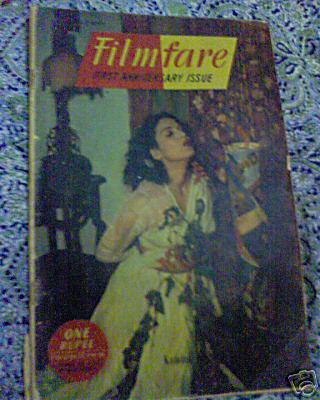
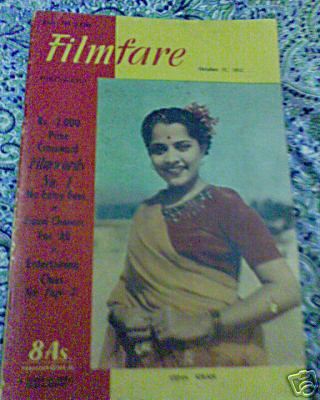
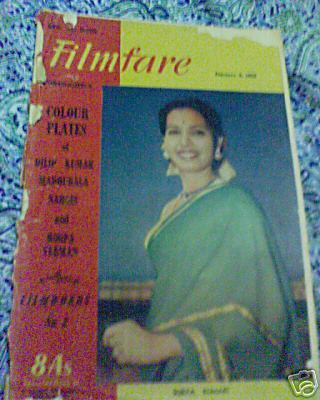
kamini kaushal,usha kiran(she did few films as leading lady,later played om parkash s wife in chupke chupke) n who is last one
Posted by: Reeth Apr 30 2007, 04:33 PM



kamini kaushal,usha kiran(she did few films as leading lady,later played om parkash s wife in chupke chupke) n who is last one
Is it the lady who acted in Uran khatola in the queen's role...
Posted by: jassi Apr 30 2007, 04:45 PM
she looked like nimmi too..no idea
Posted by: Ummer May 1 2007, 07:37 AM
OK now recognise this lady

She is from Maharashtra. Born in 1915. Participated in freedom struggle also.
Was very close to Aruna Asaf Ali. Still alive. She has to her credit one
of the best Marathi Movie for which she recieved Presidential Award.
Played a historical characted "RUKHSANA" in the hindi block buster.
I tried searching the net with the clues you gave, still have no idea. I have never seen her before, otherwise I would recognize. If you are talking about some blockbuster movie in regional language, then it would be hard to guess. I thought she worked in some hindi blockbuster movie of the 40s. Taking few other random names... Shanta Apte, Durga Khote, Shobhana Samrath... all three were Mahashatrians... but I dont think this woman is anyone of them...
Posted by: jassi May 1 2007, 12:07 PM
there are sadhana bose(bengali),meenakshi shirodkar(marathi) etc..
Posted by: maheshks May 1 2007, 02:16 PM
OK now recognise this lady

She is from Maharashtra. Born in 1915. Participated in freedom struggle also.
Was very close to Aruna Asaf Ali. Still alive. She has to her credit one
of the best Marathi Movie for which she recieved Presidential Award.
Played a historical characted "RUKHSANA" in the hindi block buster.
I tried searching the net with the clues you gave, still have no idea. I have never seen her before, otherwise I would recognize. If you are talking about some blockbuster movie in regional language, then it would be hard to guess. I thought she worked in some hindi blockbuster movie of the 40s. Taking few other random names... Shanta Apte, Durga Khote, Shobhana Samrath... all three were Mahashatrians... but I dont think this woman is anyone of them...
She is Vanmala...heroine of the movie "Sikandar( 1941)". Her marathi movie was
"shyamchi aai". You have surely seen her. I had uploaded the videos of the songs
from her movie "parbat pe apna dera (1944).
Posted by: jassi May 1 2007, 03:10 PM
never heard of her..
anyways leela chitnis is said to be first lux face of india,followed by sadhana bose,after that there was an actress called nain tara..i never heard abt this actress any idea..
Posted by: Reeth May 2 2007, 12:29 AM



kamini kaushal,usha kiran(she did few films as leading lady,later played om parkash s wife in chupke chupke) n who is last one
Is it the lady who acted in Uran khatola in the queen's role...
I think her name is Surya Kumari......am almost sure it's her..
Posted by: noorie May 2 2007, 07:55 AM
OK now recognise this lady

She is from Maharashtra. Born in 1915. Participated in freedom struggle also.
Was very close to Aruna Asaf Ali. Still alive. She has to her credit one
of the best Marathi Movie for which she recieved Presidential Award.
Played a historical characted "RUKHSANA" in the hindi block buster.
I tried searching the net with the clues you gave, still have no idea. I have never seen her before, otherwise I would recognize. If you are talking about some blockbuster movie in regional language, then it would be hard to guess. I thought she worked in some hindi blockbuster movie of the 40s. Taking few other random names... Shanta Apte, Durga Khote, Shobhana Samrath... all three were Mahashatrians... but I dont think this woman is anyone of them...
She is Vanmala...heroine of the movie "Sikandar( 1941)". Her marathi movie was
"shyamchi aai". You have surely seen her. I had uploaded the videos of the songs
from her movie "parbat pe apna dera (1944).
Noorie
Posted by: Ummer May 2 2007, 11:24 AM
OK now recognise this lady

She is from Maharashtra. Born in 1915. Participated in freedom struggle also.
Was very close to Aruna Asaf Ali. Still alive. She has to her credit one
of the best Marathi Movie for which she recieved Presidential Award.
Played a historical characted "RUKHSANA" in the hindi block buster.
I tried searching the net with the clues you gave, still have no idea. I have never seen her before, otherwise I would recognize. If you are talking about some blockbuster movie in regional language, then it would be hard to guess. I thought she worked in some hindi blockbuster movie of the 40s. Taking few other random names... Shanta Apte, Durga Khote, Shobhana Samrath... all three were Mahashatrians... but I dont think this woman is anyone of them...
She is Vanmala...heroine of the movie "Sikandar( 1941)". Her marathi movie was
"shyamchi aai". You have surely seen her. I had uploaded the videos of the songs
from her movie "parbat pe apna dera (1944).
Noorie
Yeah me either. But now that Mahesh has mentioned her name, I remember seeing her pic in some magazine. Her eyes really stand out. Yeah Mahesh, I have seen the songs that you uploaded, but somehow my mind couldn't recall her name immediately maybe bcoz she is not a well known name. I haven't seen Sikander, otherwise I would have guessed immediately.
Posted by: harihar May 2 2007, 12:05 PM
Still going strong n pretty
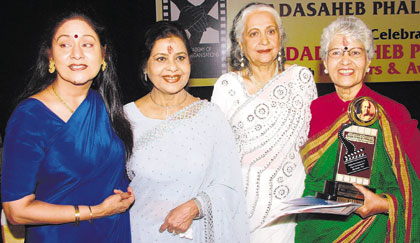

Posted by: Ummer May 2 2007, 01:26 PM
Still going strong n pretty

Bina Rai still alive...
Posted by: maheshks May 2 2007, 02:24 PM
Still going strong n pretty

Bina Rai still alive...
Yes stays most of the time at Nainital.
Posted by: jassi May 2 2007, 04:10 PM
oh god,they left top actresses..and giving awards to supporting actresses..ofcourse these actresses deserve it too..but what abt mala sinha,nanda,sadhana etc..infact mala,nanda,sadhana etc even could not get filmfare lifetime achievement awards
Posted by: Reeth May 2 2007, 05:57 PM
Kamini Kaushal
Kamini kaushal was one of the first well educated heroines in hindi cinema( BA in English).Her original name was Uma and she came from a well to do background.Her Father was a Botany professor at Lahore University.She was a stage artiste before she joined films and worked as a Radio artiste before she was discovered by Chetan Anand as the lead for his film Neecha Nagar(1945)one of the earliest art film to be made in India.Some time in 1946 her sister died leaving behind very young children and Uma was made to marry her sister's husband Mr.Sood , an officer in the Bombay Port Trust.....After Neecha nagar and marriage Kamini kaushal worked with all the top leading men of her time such as Ashok kumar,Raj kapoor,dev Anand and Dilip Kumar
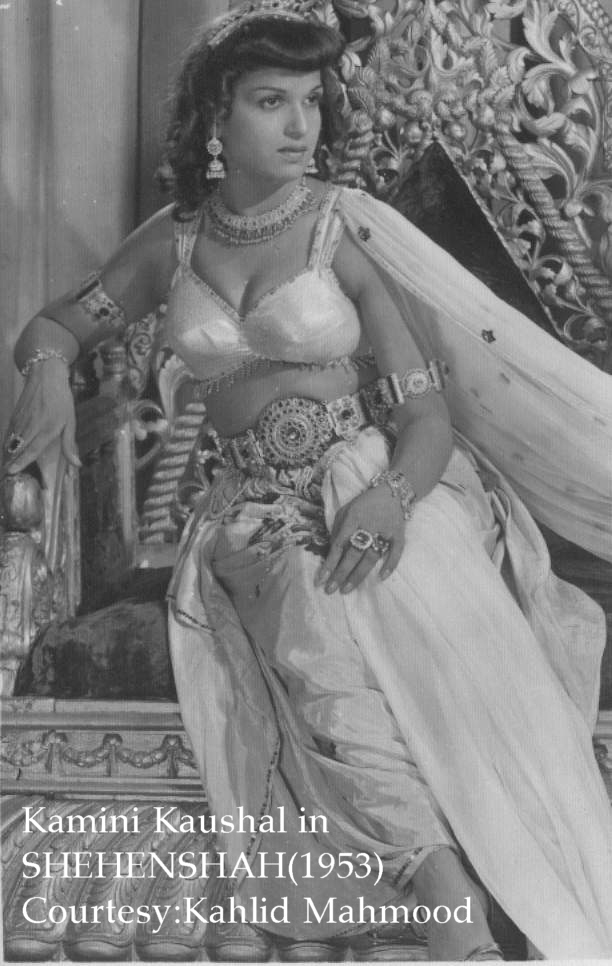
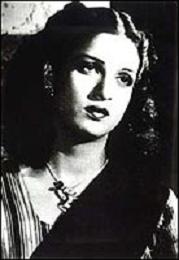
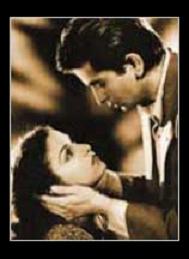

Commercial success came her way after Do Bhai(1947),aided by Geeta Roy's impasioned singing of the classic Mera sundar sapna beet gaya which , incidentally, was shot in a single take.Then came films like Nadiya ke paar, Shaheed, Shabnam,Ziddi, Namoona.....
Her team with Dilip kumar was much talked about in the late 1940's...The audience loved the star-crossed lovers .They fell in love...it was an intense, excruciatinlgy emotional and hopeless love from its very first pangs to its last dying embers, because Kamini was already married...Dilip kumar in his biography has said that she was his first love...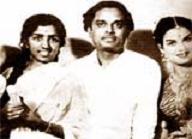
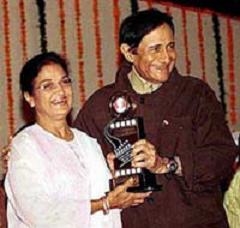
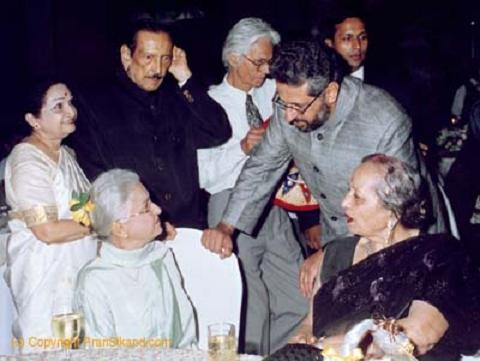
Some memorable films:
Neecha nagar
Shaheed
Aag
Aarzoo
Shabnam
Namoona
Do bhai
Aansoo
Aas
Shair
Bikhre moti
Nadiya ke paar
Aabroo
Biraj bahu
Bade sarkar
Poonam
Sangam
Godaan
Upkaar
Vsihwas
Meri bhabi
Waris
Yakeen
Beti
Do raaste
Dharti
shor...
She acted in nearly 80 films in a career spanning 55 years..
The first issue of Filmfare Dated March 7, 1952 featured Kamini kaushal on the cover and she was again on their anniversary cover in 1953...
She won the Filmfare Best Actress Award for her role in 'Biraj bahu' in 1955.She received the Dada Palkhe Life term achievement award in 2002..
Kamini kaushal moved on to playing strong character roles after Shaheed( manoj kumar) in 1965.She became a fixture in many of Manoj kumar's films after her power packed performance in Upkaar, went on to act in 7 of his films...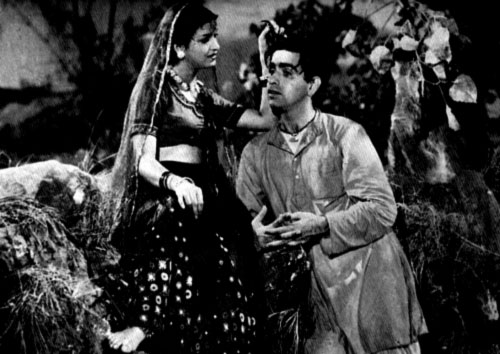
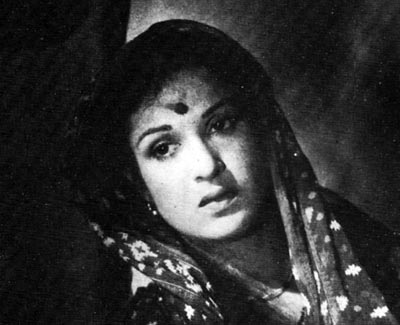

Some memorable songs picturised on her..
Mera sundar sapna beet gaya.....Geeta dutt.....Do bhai
Yaad karoge yaad karoge.......Geeta dutt ......Do bhai
Badnaam na ho jaaye.....Uma devi, Surinder kaur .......Shaheed
Papihe se kaho......Aarzoo
Sun mere saajna re.....Lata mangeshkar, Mohammad rafi.....Aansoo
Chahe naina churao......Lata mangeshkar, Talat mehmood.....aas
Chanda ki chandni mein jhoome ......Lata mangeshkar....Poonam
with film personalities Pran,Nimmi and Tanuja
From the 1980's she has largely concenterated on her family acting only occassionally...
She has written children's stories, made television serials for children and her doll making abilities are a legend...
At present she is working in a popular serial'Shanno ki shaadi' on Star plus...
Attached image(s)
Posted by: maheshks May 2 2007, 10:56 PM
The songs chaahe naina churaao....aas and
chandaa ki chaandni main jhoome jhoome dil mera..poonam...were not picturised on her.
How did you forget to mention her first commericially successful movie.
It had some memorable songs sung by sitara kanpuri.
[attachmentid=120037]
Posted by: Reeth May 3 2007, 01:21 AM
The songs chaahe naina churaao....aas and
chandaa ki chaandni main jhoome jhoome dil mera..poonam...were not picturised on her.
How did you forget to mention her first commericially successful movie.
It had some memorable songs sung by sitara kanpuri.
[attachmentid=120037]
Mahesh it was an oversight....... so also another movie that need to be mentioned 'Jailyatra'...
I have a request mahesh plz plz share your vast knowledge here, it will benefit all the people who are interested....
Unfortunately i am unable to d/l the song....can u plz mail it to me at reeth_appanna@yahoo.co.in
Posted by: Ummer May 3 2007, 03:18 AM
The songs chaahe naina churaao....aas and
chandaa ki chaandni main jhoome jhoome dil mera..poonam...were not picturised on her.
How did you forget to mention her first commericially successful movie.
It had some memorable songs sung by sitara kanpuri.
[attachmentid=120037]
Mahesh,
If i remember correctly, Chanda ki chandni mein jhoomey jhoomey dil mera was picturized on Kamini Kaushal.
Posted by: maheshks May 3 2007, 01:46 PM
Oh ho...got confused with...hum se naa poochho koi pyar kya hai pyar kya hai...
kali ghata (1951)..both movies featuring asha mathur with SJ as music director and
somewhat similar type of songs sung by lata.
Posted by: jassi May 3 2007, 04:39 PM
kamini's life was little similer to mala sinha's character of gumrah..in real life kamini too married her sister's husband.
Posted by: nasir May 4 2007, 12:36 AM
kamini's life was little similer to mala sinha's character of gumrah..in real life kamini too married her sister's husband.
Now that's something Jassi. Good analogy.
NASIR.
Posted by: Reeth May 4 2007, 04:14 PM
Adding some more information on Kamini kaushal..

Kamini kaushal was a thinking actress because of her education and background...
When she was offered Biraj bahu, she realised that it was an exceptional role and she is supposed to have read the book 20 times to understand the character thoroughly.....this role won her the Filmfare and the National Award.......
After acting in 3 fims in the year 2003 Har dil jo pyar karega, Chori chori , Hawayein she quit films....
Posted by: YaarMere May 4 2007, 05:22 PM
Didnt her brother shoot himself coz she was in love with Dilip? Even threatened to kill both of them if they didnt back off. Dilip did love her 4 real tho... she broke his heart.
Posted by: maheshks May 4 2007, 11:39 PM
It was an intense, excruciatingly emotional — and hopeless — love from its very first pangs to its last dying embers, because Uma Sood (alias Kamini Kaushal — ed) was already committed to a marriage with her sister’s husband and there could be no ‘and-they-happily-ever-after’ end to this fairy tale.
According to Sitara Devi, Uma was the only woman Yusuf truly loved. He was a completely broken man when they parted.
Talking to Sushma Shelly (Super, July 1980), the late veteran film producer-director P.N. Arora recounted:
‘When Kamini Kaushal was working in my film Pugree (1948), she was also doing Shaheed with Dilip Kumar. She was already a married woman. Her husband, Mr Sood, was a senior officer in Bombay Port Trust, and had been allotted a beautiful bungalow behind the Docks. Such marriages were an accepted thing in those days, as it was believed, there could be no better stepmother than the mousi (maternal aunt) herself for the motherless children. Kamini Kaushal had earlier been working on the Delhi stage and had convinced her husband to let her join films.
‘Dilip Kumar visited her very often during the shooting of Pugree; but it was their personal affair and I didn’t think it my business to interfere. But one day, Kamini’s brother, a military man, strode on to the sets. He took out a pistol and threatened to shoot Kamini if she didn’t put a stop to her clandestine affair with Dilip Kumar.
‘It was then agreed that Kamini would be allowed to complete only the film on hand, and no more new films for her. No more acting. Kamini, who suspected me to have tattled to her people, was annoyed with me, though I don’t know from where she got that impression.
‘Anyway, since there was only about five to six days’ work left on Pugree, I didn’t have any problem. After that, we went our individual ways.’
Posted by: Ummer May 5 2007, 10:53 PM
Here is a recent interview of one of the most popular actresses of 40's and 50's i.e. Swaranlata. Sawaranlata will always be remembered as the heroine of Rattan (1944). According to boxofficeindia, Rattan along with Kismet (1943) still remains one of the biggest blockbusters in Indian Cinema History (controlling for such factors as inflation etc). Rattan also established Naushad's career as music director. Swaranlata was Sikh, but during the shooting of Laila Majnu (where Rafi also made cameo apperance), Swaranlata and Nazir fell in love and Swaranlata converted to Islam. After partition she migrated to Pakistan and helped established a dead film industry of Lahore. Their first effort in Pakistan was "Heer Ranjha" whose negative was accidentally destroyed. After that they produced/directed first Punjabi film "Pheray" (1949) and it became first hit film of Pakistan thus securing Pakistani film industry. Later Nazir/Swaranlata team produced/directed many hit films. Some of her memorable films include Tasweer (1943), Ishara (1943), Rattan (1944), Laila Majnu (1945), Pheray (1949), Shehri Babu (1953), Heer (1955), Naukar (1955), Khatoon (1955), Noor-e-Islam (1957). She has acted with all top of heroes of her time including Motilal, Dilip Kumar, Pirhviraj Kapoor, Nazir, Darpan and Santosh. She has been given Lifetime achievement award for her contributions to Lollywood.
The years gone by: Swaran Lata
By Fariha Rashed
When one speaks of legends, the mind instantly paints a picture of grandeur. Consider an actress who was labelled ‘tragedy queen’ for her moving performances, and a thespian who took the world of Indian cinema by storm with her dark eastern looks. Swaran Lata, of the Nazir-Swaran Lata duo, began her journey with the multi talented actor/producer/director Nazir, in the pre-Partition hit, Laila-Majnoo. They continued as a husband and wife team across the border in the then newly formed, independent Pakistan film industry.
The fledgling industry owed much to this remarkably talented couple who showed commitment and determination in spite of the initial problems they had to face while commencing their careers in Pakistan. “We had no money when we first came here; we left everything behind in India. Our good friend, Bari, gave us food and a place to stay. I then returned to India and brought back some of my things and Nazir Sahib and I subsequently began working,” says Swaran. However, having stood her ground, to this day, she maintains the reputation of being a star whose dialogue delivery and haunting voice has been the hallmark of her success.
Swaran Lata, now almost 80, a great-grandmother and in great shape for her age, cannot recall exactly how many movies she has acted in, but when asked to name a few she says: “Before Partition, I starred in Laila Majnoo, Vamikh Azra, Ratan, Maa Baap Ki Laaj, Pratigya and Tasveer”. Afterwards, she remembers acting in Phairai, Larai, Shehri Baboo, Heer, Khatoon and Sachayee. Of course, unforgettable is the famous song from Swaran’s film, Heer, Asaan jaan ke meet laye ankh we, which has recently, in a very contemporary style, been sung and remixed by singer Annie in her debut album.
‘Our films had no vulgarity and the story line was powerful yet simple. Everything has changed now in both the Pakistani and Indian film industries. New people have come in and everything is glamourised. I refuse to watch any of the latest films,’ says Swaran Lata
The original song was an instant hit and to this day, is a hot favourite among music lovers. Furthermore, according to Swaran, her late husband produced and directed quite a few films in Pakistan such as Noor-i-Islam, Azmat-i-Islam, Naukar, Sawaal and Heer and she states very confidently that “all his movies were a success.” In her lifetime, Swaran has worked with great names like Prithvi Raj Kapoor, Moti Lal and Dilip Kumar in India and with Santosh Kumar, Darpan, Inayat Hussein Bhatti and Habib in Pakistan. This portfolio can stand to impress anyone who has the slightest idea about old cinema and its top actors.
An exceptional and wondrous story about how she entered the realm of acting trails Swaran. Sadly, her parents passed away when she was very young and she lived most of her adolescent life with her elder brother, whom she recalls “was very strict.” However, it is the story of how she got discovered that Swaran tells with great passion: “I was a student at college in Lucknow, India. When I was travelling from Delhi to Lucknow, a few directors saw me. They approached me to act in films but I was not interested at first. One of them then went to my elder brother with the offer, and to my utmost surprise he agreed. I then started my career as an actress in Poona where after my first movie, the studio closed down. I went to Bombay where I got good work. From 1946 onwards I became very popular and was known as one of the top artistes around.
“After Partition, my husband and I came to Lahore and I stopped working in movies after Nazir Sahib’s first heart attack.” She is adamant about never taking up acting again, “I have retired. I’ve given interviews on TV programmes like Aap Ka Zameer by Zameer Sahib. That was an excellent interview and I enjoyed it. However, now I take pleasure in being at home with my children, grand children and great grand children.” She is not a social person by nature and happily reveals that she does not mingle with people from the film industry anymore. “I like to keep to myself,” she says.
Having witnessed a huge change in the workings of cinema since she first started out as an actress, Swaran is not very happy with the state of affairs at present. “Our films had no vulgarity. They could be watched sitting with families and the story line was powerful yet simple. Everything has changed now in both the Pakistani and Indian film industries. New people have come in and everything is glamourised. The elements of nudity and heavy make-up have crept in whereas at my time, our films were successful without all of this. I don’t want to comment too much on what I think because I refuse to watch any of the latest films as it is.”
Swaran believes that the production style and quality of movies has also shifted to a great extent and that a new trend is being followed. Although technology has aided production immensely, the vision and calibre of producers from her time is unmatchable. Commenting upon the type of audiences that watch films nowadays, Swaran says, “At our time, movie watching was enjoyed by the gentry. Now it is the masses who watch films and they prefer watching Punjabi movies, which I don’t like at all.”
She is also disappointed because she feels that “movie-makers are too commercial now. There is less attention on the story and more stress on love scenes and dances.” The Pakistani censor board, in her view, is a joke. “I was on the censor board but I quickly left because whatever we, as the board members, recommended was never followed. Strange films were passed as fit for showing and a lot of people on the board were bought off.”
Being a staunch believer in hard work and dedication, Swaran stresses on continuous practice and self-training for anyone who is striving to be a great actress. “I used to spend hours perfecting my role for each film. My dialogue delivery was known to be incredibly controlled and in sync with my facial expressions. I used to become one with my character. Being an actress requires great discipline,” she says. Swaran shrewdly advises: “An actress needs to know how to speak well and carry herself. I used to dress very simply in a white sari and blouse. I did not like being over dressed in public and my make-up was light at all times. Actresses in my time possessed a natural beauty which, I feel, has now been overshadowed with the application of heavy and unnecessary make-up and styling. Every actress looks the same and their individuality is being lost.”
What does Swaran translate this passion for sheer discipline into now? For one, even at her age, she still does cardiovascular exercises every morning and a yoga routine every evening. She keeps herself fit and active and still cooks for her children and grand children who live with her. “I think a person should maintain their health throughout their life, otherwise at my age I could have been bed-ridden,” she says.
Having been blessed with an exciting and fulfilling life, she looks back contently at everything she has achieved. “Sometimes I feel sorry that I left India and came to Pakistan because a lot of sacrifice was involved. However, I have settled in very well and the best thing is that I am respected by everyone. I am proud of all my children, grand children and in turn great grand children. My life is now very simple and I just look forward to spending time with my family in Lahore.”
Getting a little teary eyed at the end, Swaran goes on to say: “I must mention my dear friend Najma who I miss very much since she passed away and I must thank my friends Bari and his wife Saloni with whom I now spend a lot of time at their home.”
One thing is for certain, Swaran Lata’s story of fame and success will be told by every successive generation of her family. The government should honour such artistes who have rendered significant services to the film industry with their hard work and dedication, creating an infrastructure for future generations.
Attached image(s)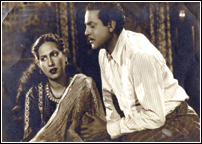
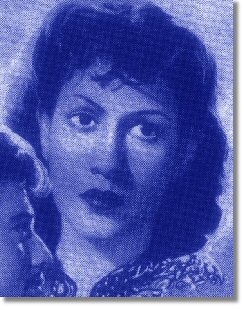
Posted by: Reeth May 6 2007, 01:00 AM
It was an intense, excruciatingly emotional — and hopeless — love from its very first pangs to its last dying embers, because Uma Sood (alias Kamini Kaushal — ed) was already committed to a marriage with her sister’s husband and there could be no ‘and-they-happily-ever-after’ end to this fairy tale.
According to Sitara Devi, Uma was the only woman Yusuf truly loved. He was a completely broken man when they parted.
Talking to Sushma Shelly (Super, July 1980), the late veteran film producer-director P.N. Arora recounted:
‘When Kamini Kaushal was working in my film Pugree (1948), she was also doing Shaheed with Dilip Kumar. She was already a married woman. Her husband, Mr Sood, was a senior officer in Bombay Port Trust, and had been allotted a beautiful bungalow behind the Docks. Such marriages were an accepted thing in those days, as it was believed, there could be no better stepmother than the mousi (maternal aunt) herself for the motherless children. Kamini Kaushal had earlier been working on the Delhi stage and had convinced her husband to let her join films.
‘Dilip Kumar visited her very often during the shooting of Pugree; but it was their personal affair and I didn’t think it my business to interfere. But one day, Kamini’s brother, a military man, strode on to the sets. He took out a pistol and threatened to shoot Kamini if she didn’t put a stop to her clandestine affair with Dilip Kumar.
‘It was then agreed that Kamini would be allowed to complete only the film on hand, and no more new films for her. No more acting. Kamini, who suspected me to have tattled to her people, was annoyed with me, though I don’t know from where she got that impression.
‘Anyway, since there was only about five to six days’ work left on Pugree, I didn’t have any problem. After that, we went our individual ways.’
Thanks a lot mahesh .....
Here is a recent interview of one of the most popular actresses of 40's and 50's i.e. Swaranlata. Sawaranlata will always be remembered as the heroine of Rattan (1944). According to boxofficeindia, Rattan along with Kismet (1943) still remains one of the biggest blockbusters in Indian Cinema History (controlling for such factors as inflation etc). Rattan also established Naushad's career as music director. Swaranlata was Sikh, but during the shooting of Laila Majnu (where Rafi also made cameo apperance), Swaranlata and Nazir fell in love and Swaranlata converted to Islam. After partition she migrated to Pakistan and helped established a dead film industry of Lahore. Their first effort in Pakistan was "Heer Ranjha" whose negative was accidentally destroyed. After that they produced/directed first Punjabi film "Pheray" (1949) and it became first hit film of Pakistan thus securing Pakistani film industry. Later Nazir/Swaranlata team produced/directed many hit films. Some of her memorable films include Tasweer (1943), Ishara (1943), Rattan (1944), Laila Majnu (1945), Pheray (1949), Shehri Babu (1953), Heer (1955), Naukar (1955), Khatoon (1955), Noor-e-Islam (1957). She has acted with all top of heroes of her time including Motilal, Dilip Kumar, Pirhviraj Kapoor, Nazir, Darpan and Santosh. She has been given Lifetime achievement award for her contributions to Lollywood.
The years gone by: Swaran Lata
By Fariha Rashed
When one speaks of legends, the mind instantly paints a picture of grandeur. Consider an actress who was labelled ‘tragedy queen’ for her moving performances, and a thespian who took the world of Indian cinema by storm with her dark eastern looks. Swaran Lata, of the Nazir-Swaran Lata duo, began her journey with the multi talented actor/producer/director Nazir, in the pre-Partition hit, Laila-Majnoo. They continued as a husband and wife team across the border in the then newly formed, independent Pakistan film industry.
The fledgling industry owed much to this remarkably talented couple who showed commitment and determination in spite of the initial problems they had to face while commencing their careers in Pakistan. “We had no money when we first came here; we left everything behind in India. Our good friend, Bari, gave us food and a place to stay. I then returned to India and brought back some of my things and Nazir Sahib and I subsequently began working,” says Swaran. However, having stood her ground, to this day, she maintains the reputation of being a star whose dialogue delivery and haunting voice has been the hallmark of her success.
Swaran Lata, now almost 80, a great-grandmother and in great shape for her age, cannot recall exactly how many movies she has acted in, but when asked to name a few she says: “Before Partition, I starred in Laila Majnoo, Vamikh Azra, Ratan, Maa Baap Ki Laaj, Pratigya and Tasveer”. Afterwards, she remembers acting in Phairai, Larai, Shehri Baboo, Heer, Khatoon and Sachayee. Of course, unforgettable is the famous song from Swaran’s film, Heer, Asaan jaan ke meet laye ankh we, which has recently, in a very contemporary style, been sung and remixed by singer Annie in her debut album.
‘Our films had no vulgarity and the story line was powerful yet simple. Everything has changed now in both the Pakistani and Indian film industries. New people have come in and everything is glamourised. I refuse to watch any of the latest films,’ says Swaran Lata
The original song was an instant hit and to this day, is a hot favourite among music lovers. Furthermore, according to Swaran, her late husband produced and directed quite a few films in Pakistan such as Noor-i-Islam, Azmat-i-Islam, Naukar, Sawaal and Heer and she states very confidently that “all his movies were a success.” In her lifetime, Swaran has worked with great names like Prithvi Raj Kapoor, Moti Lal and Dilip Kumar in India and with Santosh Kumar, Darpan, Inayat Hussein Bhatti and Habib in Pakistan. This portfolio can stand to impress anyone who has the slightest idea about old cinema and its top actors.
An exceptional and wondrous story about how she entered the realm of acting trails Swaran. Sadly, her parents passed away when she was very young and she lived most of her adolescent life with her elder brother, whom she recalls “was very strict.” However, it is the story of how she got discovered that Swaran tells with great passion: “I was a student at college in Lucknow, India. When I was travelling from Delhi to Lucknow, a few directors saw me. They approached me to act in films but I was not interested at first. One of them then went to my elder brother with the offer, and to my utmost surprise he agreed. I then started my career as an actress in Poona where after my first movie, the studio closed down. I went to Bombay where I got good work. From 1946 onwards I became very popular and was known as one of the top artistes around.
“After Partition, my husband and I came to Lahore and I stopped working in movies after Nazir Sahib’s first heart attack.” She is adamant about never taking up acting again, “I have retired. I’ve given interviews on TV programmes like Aap Ka Zameer by Zameer Sahib. That was an excellent interview and I enjoyed it. However, now I take pleasure in being at home with my children, grand children and great grand children.” She is not a social person by nature and happily reveals that she does not mingle with people from the film industry anymore. “I like to keep to myself,” she says.
Having witnessed a huge change in the workings of cinema since she first started out as an actress, Swaran is not very happy with the state of affairs at present. “Our films had no vulgarity. They could be watched sitting with families and the story line was powerful yet simple. Everything has changed now in both the Pakistani and Indian film industries. New people have come in and everything is glamourised. The elements of nudity and heavy make-up have crept in whereas at my time, our films were successful without all of this. I don’t want to comment too much on what I think because I refuse to watch any of the latest films as it is.”
Swaran believes that the production style and quality of movies has also shifted to a great extent and that a new trend is being followed. Although technology has aided production immensely, the vision and calibre of producers from her time is unmatchable. Commenting upon the type of audiences that watch films nowadays, Swaran says, “At our time, movie watching was enjoyed by the gentry. Now it is the masses who watch films and they prefer watching Punjabi movies, which I don’t like at all.”
She is also disappointed because she feels that “movie-makers are too commercial now. There is less attention on the story and more stress on love scenes and dances.” The Pakistani censor board, in her view, is a joke. “I was on the censor board but I quickly left because whatever we, as the board members, recommended was never followed. Strange films were passed as fit for showing and a lot of people on the board were bought off.”
Being a staunch believer in hard work and dedication, Swaran stresses on continuous practice and self-training for anyone who is striving to be a great actress. “I used to spend hours perfecting my role for each film. My dialogue delivery was known to be incredibly controlled and in sync with my facial expressions. I used to become one with my character. Being an actress requires great discipline,” she says. Swaran shrewdly advises: “An actress needs to know how to speak well and carry herself. I used to dress very simply in a white sari and blouse. I did not like being over dressed in public and my make-up was light at all times. Actresses in my time possessed a natural beauty which, I feel, has now been overshadowed with the application of heavy and unnecessary make-up and styling. Every actress looks the same and their individuality is being lost.”
What does Swaran translate this passion for sheer discipline into now? For one, even at her age, she still does cardiovascular exercises every morning and a yoga routine every evening. She keeps herself fit and active and still cooks for her children and grand children who live with her. “I think a person should maintain their health throughout their life, otherwise at my age I could have been bed-ridden,” she says.
Having been blessed with an exciting and fulfilling life, she looks back contently at everything she has achieved. “Sometimes I feel sorry that I left India and came to Pakistan because a lot of sacrifice was involved. However, I have settled in very well and the best thing is that I am respected by everyone. I am proud of all my children, grand children and in turn great grand children. My life is now very simple and I just look forward to spending time with my family in Lahore.”
Getting a little teary eyed at the end, Swaran goes on to say: “I must mention my dear friend Najma who I miss very much since she passed away and I must thank my friends Bari and his wife Saloni with whom I now spend a lot of time at their home.”
One thing is for certain, Swaran Lata’s story of fame and success will be told by every successive generation of her family. The government should honour such artistes who have rendered significant services to the film industry with their hard work and dedication, creating an infrastructure for future generations.
Thank you ummer for this in depth write up.....i had never heard of Swaran Lata until now....
Posted by: Reeth May 6 2007, 03:05 AM
GEETA BALI ( 1930 - 1965)
Some actresses are destined to become and remain fond memories in the eyes of their peers and fans.
Their name and persona's attain near legendary status because of an untimely death or a life of stellar personal integrity and struggle...On both accounts Geeta Bali was such an actress.....
Geeta Bali's dancing eyes and her animated expressive face which mirrored her soul were her most outstanding features, yet life was snatched away from this vibrant personality at an achingly young age
of 35...
She was born in pre partition punjab as Harkirtan kaur.She was a Sikh, her family moved to Bomabay
and were living in near poverty and she decided to join films...she had earlier done a few small time
dancing roles in punjabi films like Badnami before moving to Bombay.Impressed by her off-screen vivacity Noted film Producer Kidar Sharma cast Geeta in his Suhaag Raat(1948)...Audience related to her instantly nad Geeta was offered many film roles and she accepted most...she won rave reviews even for her supporting roles in films like Badi Bahen and Dulari....
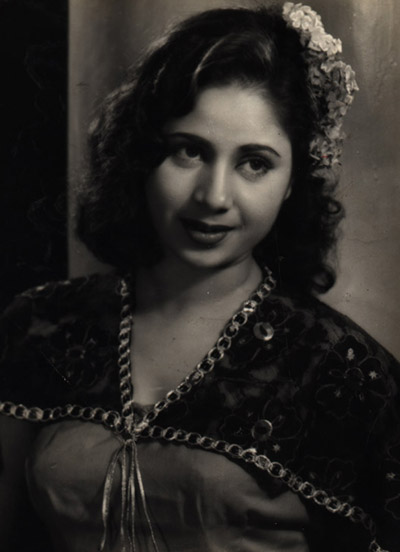
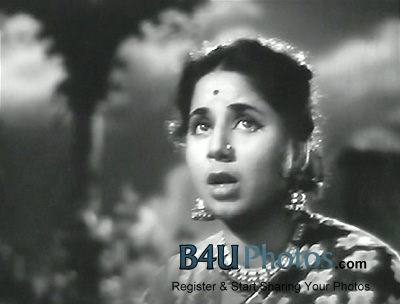
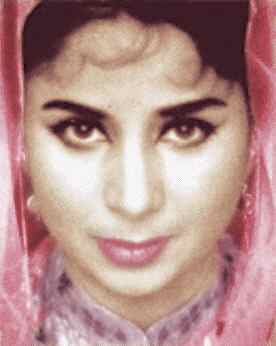
She became a star in the 1950's after Baazi(1951) Guru dutt s first hit where she played
the role of Gangster's moll with gay abandon dancing to the tunes of Geeta dutts, Tadbeer se
bigdi huyi taqdeer banale she went on to do three more films under his direction...including
Jaal with Dev anand which is remembered to this day for its music by S.D.Burman
and the song Yeh raat yeh chandni phir kahan....She was equally good in the tragic Bawre nain with Raj kapoor...followed another super successful film Albela ....Albela had swinging C.Ramchandra compositions like Shola jo badke dil mera dhadke and Sham dhale mere khidki tale popular to this day...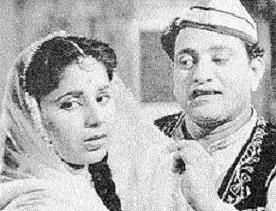
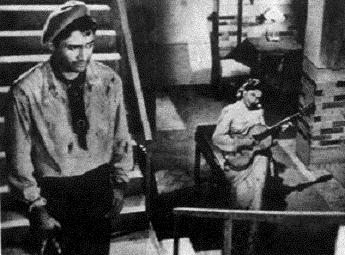
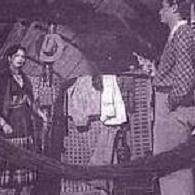
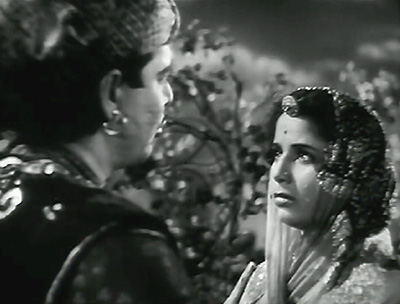
Geeta's reputation as an actress rests more on her performance than her role.Natural ,Spontaniousandgifted with a spot-on sense of comic timing, she never really found a vehicle worthy of her talent...Largely she frittered away her talent in B grade movies.Famously down to earth despite
her star status she was the antithesis of the coy 1950's heroine....
Those who knew her personally claim that she was a Samaritan who touched the lives of whoever she met.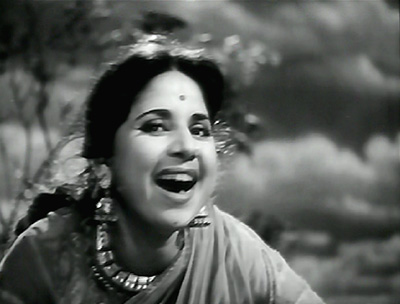

Shammi Kapoor entered her life when they worked in Miss coca cola and Coffehouse she was 24 and he was 23......Later while shooting for Kedar Sharm's Rangeen Raaten they fell in love while they were shooting at Ranikhet.....
Back in Bomaby they realised that they could not live without each other.....and after four months of agony, tears,non-togetherness and desperation they decided to get married, however they were unsure about the reaction of his family...they went ahead and got married at Banganga temple at 4 am,on the 23rd August 1955 with the help of Producer-director Hari Walia....It has become for Bollywood the most romantic of story book elopements and weddings, one that could be placed with ease into a film..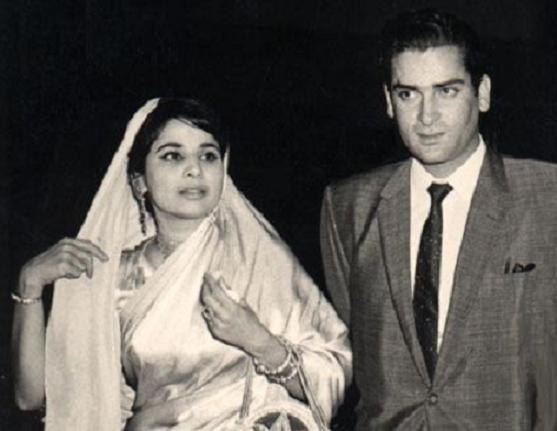


It is some consolation that Geeta crammed a lot into her short life...70 odd films ina ten year career..
Some memorable ones
Suhag Raat
Badi Bahen
Dulari
Jal tarang
Baazi
Bawre nain
Albela
Lachak
Anand math
Jaal
Neelam pari
Raag rang
Ferry
Milap
Faraar
Pocketmaar
Sailaab
Coffe house
Aji bas shukriyan
Jailor
Mohar
Sapan suhane
Jalti nishani
Nai rahen
Jabse tumhe dekha hai
Geeta continued to work after her marriage in a few films like Jailor, Mohar, Sapan suhane and Jabse tumhe dekha hai(1963) which was her last released film...Shammi kapoor had become a huge star by then and after the birth of her two children Aditya and Kanchan she eased her work load.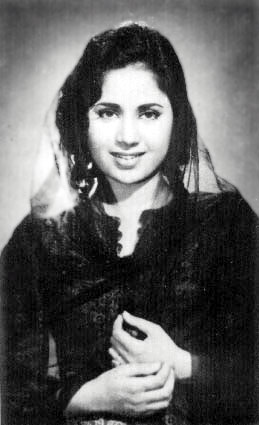
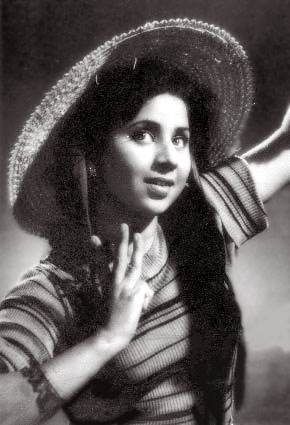

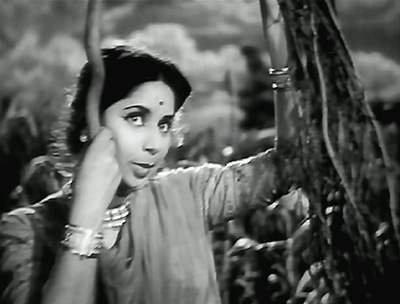
But the desire to do that one fulfilling role for which he would be remembered for prompted Geeta to attempt the production of a classic for herself.She started Rano, based on Rajinder Singh Bedi's famous novel Ek Chaddar Maili Si based on a widow's remarriage to her brother-in-law.Upcoming star Dharmendra played the hero.
While shooting the film, Geeta who had not been vaccinated for small pox contacted the dreaded disease, bet care was rushed to her, but Geeta bali passed away on January 21, 1965 leaving behind an eight year old son and three year old daughter in the care of a devastated Shammi kapoor Ironically she was cremated in Banganga not far from where she was married....
Pradeep kumar her co star in many films has said that 'Geeta was the fairy of histronics who wore a human form'
Having sung countless songs for Geeta Bali,Lata Mangeshkar always had a soft spot for Geeta bali......
Attached image(s)
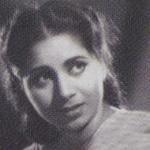
Posted by: parag_sankla May 6 2007, 03:47 AM
Lovely article and nice pics Reeth. Thank you so much
Parag
Posted by: jassi May 6 2007, 11:34 AM
what a lady geeta bali was,i heard when she came to mumbai with her family,at a rent they were staying in bathroom..my god..so painful
very few knows that geeta bali was all set to play widow in film based on ek chadar maili si,and dharmendra was to play her devar,but film could not complete..years later dharmender's wife hema malini played same role..geeta bali's husband shammi kapoor's nephew played hema malini's devar..
what a fact
Posted by: noorie May 8 2007, 01:21 AM
can anyone tell something more about begum para
Begum Para was a B-Grade actress mostly paired with Sheikh Mukhtar in films like Ustad Pedro etc. After partition she along with Mehboob Khan and some other established film stars visited Karachi-Pakistan to see if the condition was right to work there. But seeing the non-existent film industry they all went back to India. Although Mehboob Khan's younger brother Pyare Khan and Begum Para's sister stayed back. Here is the detailed interview of Begum Para
MS OOMPH - by V Gangadhar
Somewhere in 1953, Fort Cochin in Kerala was hit by a bomb. I was then in school there and thoroughly enjoyed the experience.
The bomb was called Begum Para. And it came packaged in a Hindi film, Ustad Pedro, produced and directed by the then well-known actor, Sheikh Mukhtar. Mukhtar was tall, well-built and ruggedly handsome. But he had very stiff competition in Begum Para, unanimously acknowledged to be Bollywood's sex bomb.
The film magazines called her the oomph girl, the girl with 'it'. Whatever she had, Para set my blood flowing. She had sultry, come-hither looks, an eye-popping figure, one she was not afraid to show off. She wore trousers, tight dresses and danced enticingly to the tunes of western music.
Ustad Pedro was a fun film. It was packed with action, romance, stunts and, of course, that wonderful, curvaceous woman. As Sheikh Mukhtar carried off the prized heroine at the end of the film, all the boys watching the film sighed enviously.
Hindi screen had its quota of women with smouldering good looks, who dressed seductively and who were ready to respond positively to a pass from the admiring male. But such women were normally cast as vamps because most heroines had to look virginal and god-fearing and play second fiddle to the heroes.
Not Begum Para. Her sexuality on the screen was electric. Film magazines of those days wrote endlessly about the frank utterances and open lifestyles of Begim Para and her sister-in-law, Protima Dasgupta. She was not a hypocrite, she always called a spade a spade.
I learnt this when I dropped in at her small flat in suburban Versova. The cool breeze from the sea was welcome, but not the stench of drying fish. The drawing room was full of photographs. Of Para's late husband Nasir Khan, her two sons and daughter. There are books everywhere. Enid Blyton for the grand-daughter along with classics -- theIliad, the Odyssey, the works of D H Lawrence as well as pulp fiction by Ludlum and Collins.
The passage of time had taken its toll. Begum Para had bloated up, the hair has greyed and she moved around with difficulty. There was little sign of who she once was. But once she began to speak, the old magic reappeared like abracadbra.
She had endured a lot in recent years. Nasir Khan died in 1974. He was just 49 and she had to bring up three children on her own. For years there was a long misunderstanding with her brother-in-law Dilip Kumar (she refused to talk about it) and the family bungalow on upmarket Carter Road had to be sold. One son, Ayub, works in films (he was most recently seen in Mrityudand), another son and her daughter are in advertising. Life had not been easy for the family, but then Begum Para, by all accounts, had always been a fighter.
The early days, though, were peaceful and happy. The family came from Jalandhar but moved to Bikaner, where her father Mian-Ehsan-Ul-Haque became the chief justice. The family was large, 10 in all, but they had lots of fun and the indulgent parents often joined in.
Para went to school and then college at Aligarh. Hostel life was quite pleasant. While sticking to tradition, her family was quite broad-minded. "We never wore purdah or anything like that," she explains.
"We were allowed to watch films and I enjoyed the experience." One of her earliest heroes, was the debonair Motilal. "I wrote fan letters to him, and he always replied. Later, when I joined films, we became good friends."
Still in her early teens, Begum Para came to Bombay to spend her holidays with sister-in-law Protima Dasgupta who was already acting in films like Court Dancer. Her home was frequented by film people. Perky, pretty Para invited instant attention and producers promptly offered her roles. Dasgupta persuaded her to accept some of the offers.
"My family was not very happy," recalls Para. "But finally, Protima and I convinced them." Born plain Para, she added a Begum to her name.
Thus it was that a nervous, excited, young girl of 17 faced the camera for the first time in her life on the sets of Chand. Her co-star was Prem Adib, a famous hero in those days. The film was shot at Prabhat Studio in Pune and was a family social.
"Oh, I had no acting experience at all," she laughs. "But director B D Kashyap was very understanding and patient, and made me feel at ease."
Did you have any love scenes, I asked. "Oh, very innocent ones," she smiled. "The lead pair looked at each other, sang songs and perhaps held hands. Films in those days were so different. But everyone on the sets, including Prem Adib, were very co-operative."
Chand was fairly successful. Para did not look back and settled down to a film career in Bombay, sharing a flat with her sister-in-law at Worli Sea Face. From 1945, for over 10 years, she made several movies -- Sohini Mahiwal, Mehendi, Shama, Pedro, Dada, Dara, the last three with the swashbuckling Sheikh Mukhtar. The films did well at the box office.
"I played emotional roles and also essayed roles of fashionable women," she remembers. The "it" image was a big thing in those days. Para often wore pants and jeans, dressed provocatively and championed an unconventional lifestyle. Naturally, she was regularly featured in film magazines.
"I had a good figure, and I knew I had one," she laughed. "And if the magazines wanted to feature me in provocative poses, I did not mind".
While her career was going strong, she met Nasir Khan (Dilip Kumar's brother) on the sets of Lootera. Nasir had made a name for himself with some good films with Nutan. "We liked each other, but it was not love at first sight."
They began meeting more often and got married in 1958. Did their families support the marriage, I asked.
"Oh, we were old enough to do what we wanted." she replied diplomatically.
Nasir Khan did not want her to act and she quit the screen. "I was quite happy to stay at home and look after the family," she says. Nasir Khan had a heart condition which he chose to neglect, and a heart attack claimed him in 1974.
It was a shattering blow and she had to face the crisis alone. For about 18 months, she went to Karachi and lived with her sister, who had settled down in Pakistan. "But India was my home and I was back to bring up my children," she explained.
It was then she missed her work in films. As long as Nasir Khan was alive, life had been smooth. But now many adjustments had to be made. But she managed to bring up her children and settle them in life.
Looking back on her career in films, she says she had not taken it very seriously. "It was fun and interesting while it lasted."
She cherished her friendships formed during those days. Nargis and Geeta Bali were close friends. So were, Motilal, Nimmi, Nirupa Roy, Nadira, Shyama and Manorama.
A couple of days before our meeting. Nirupa, Nimmi and Shyama had dropped in for a chat. "We meet quite often," laughed Begum Para. "We talk, gossip, laugh... They are wonderful people". While I was chatting with her, the telephone rang. It was another friend, kathak queen Sitara Devi. They agreed to meet later that evening.
She thinks highly of Motilal, Dilip Kumar, Amitabh Bachchan and Naseeruddin Shah. Among today's heroines, she says Kajol is the best. "Oh, that girl lights up the screen with her presence," she exclaims.
It was time to leave. We had chatted for nearly two hours. But I was certain about one thing. In my book of interesting people she goes down as Genuine Stuff!
Thanks Ummer.
Has anyone read Khushwant Singh’s autobiography, Truth, Love and a Little Malice ?
There's a very interesting
Noorie
Yeah share it plzzz.... is it something bad?
You could say so!
Ummer, Sb fan, Reeth and everyone else who frequents this thread, here's that account of writer Khushwant Singh's meeting with yesteryears' siren Begum Para that i promised you.
The reason I took this long is because I had to type it all from the book Truth, love & a little malice.
Well anyway, here's Khushwant Singh with his version of the Truth!
Noorie
Begum Para one time super vamp of the Indian screen had put on a lot of weight after she married Nasir Khan ( brother of super star Yusuf, alias Dilip Kumar) and borne him two beautiful children, a daughter and a son. Her husband died leaving her with very little beside a flat in Bandra and a couple of films. She felt she had a right to some of the millions that her brother-in-law was making.She also had a considerable inheritance in Pakistan waiting to be claimed by her. I met her through Rukhsana Sultana, her sister’s daughter. I saw quite a lot of Begum Para and her children in Bombay. Mnay Sunday mornings the family joined me at the Gymkhana Club bathing pool to swim and have breakfast. Begum Para often brought up the question of money. If anyone could loan her Rs 40 –50,000 she could have her old films re-screened and make a fortune. I didn’t take the hint.
In sheer desperation she migrated to Pakistan to stake her claim to her inheritance. Twoe of her brothers were in high places, one a minister in Bhutto’s govt. It didn’t take her long to discover that her relatives were not willing to part with anything, and she was on weak ground having earlier opted for India. She earned a little by flogging films she had brought with her and appearing on TV. Her children were unhappy. After the free and easy atmosphere of Bombay, the girl who was rapidly growing into a beautiful young lady, found the puritanical atmosphere of Pakistan very stifling. Begum Para wrote me several letters asking for help in returning to India. I werote back that I would be coming to Karachi soon and we could talk over the matter.
I arrived in Karachi early in the evening. Begum Para nad her children were there at the airport to receive me. So was the Chief of Protocol – because I was a guest of the govt. We were conducted to the V.I.P.lounge. The children had their fill of cakes and biscuits and were sent home. Begum Para aceepted my invitation to dine with me at the hotel where I was to stay the night, before catching the morning flight o Islamabad. The Chief of Protocol dropped us at my hotel. Begum Para came with me to my room. I ordered soda and ice and took out the bottle of Scotch I had brought with me. At that time there was no prohibition in Pakistan. I had heard stories about Begum Para’s drink problem. She had to cut down on it because of the price:a bottle of Scotch cost twice as much in Pakistan as it did in India. ‘Would you like a drink’? I asked her, not sure whether she was still a drinking woman. ‘I’ll take a little’, she replied. ‘I haven’t seen genuine Scotch for ages.’
I pored out two stiff whiskys and handed her one.We resumed talking in Punjabi. I was not halfway through my glass when I saw her’s was empty. I poured out another one for her. She tossed it down and I had to refill it before I resumed drinking my own. By the time I had finished my quota of three large whiskys, Begum Para had had nine. The bottle was almost empty. I told her we must eat soon as I had to catch the early morning flight. Reluctantly she got up to accompany me to the dining room.
The dining room was on the first floor. We had to climb up a spiral marble staircase to get to it. The place was crowded. As usual in Pakistan, there were very few women in the room. People recognized Begum Para because of her appearances on TV. They were intrigued to see her in the company of a Sikh.
We were shown to a table for two. We ordered our meal. 'Would you like to have something to drink while waiting for your meal?’ asked the waiter. ‘Nothing for me,’ I replied and looked at Begum Para. ‘I’ll have another Scotch and soda’, she said. She had another two before soup was served. She began to slur over her words, her eyes took on a glazed look. She wanted to have yet another drink with her meal. I put my foot down firmly.
At long last the meal came to an end. I got up to assist Begum Para with her chair. She stood up, swayed a little, and collapsed on the carpet. The waiters came running to help her walk to the stairs. All eyes in the dining room were turned on us. I was doubly careful going down the spiral staircase. I gripped her fat arm and ordered her: ‘one step at a time’. We made it to the foyer. I ordered a taxi for her and waited patiently for the ordeal to be over. A taxi drew up in the portico. I gave the driver a hundred rupee note and told him to take the lady home. He recognized Begum Para and knew where she lived. I opened the rear door of the taxi and went back to help Begum Para.
As she stepped forward, she missed her step and once agin collapsed on the ground, this time with a loud fart.
She sprained her ankle and began to howl with pain. ‘Hi Rabba Main Mar Gayee!’- O God I’ve killed myself. A crowd gathered.
Being a Muslim country no unrelated male would touch a woman. I did my best to haul her up to her feet. Shw was far too heavy for me. I pleaded with the cab-driver for help. My advance tip came in handy. We got her on her feet and pushed her into the seat. I slammed the door and bid her a hurried farewell.
I got through the crowd and made for my room as fast as I could.
Posted by: desai2rn May 8 2007, 10:35 AM
Reeth, thanks for article on Geetabali. She seemed a very natural
in the few movies that I had a chance to see. The one I liked the
most was Albela with Bhagwandas.
Urmila reminds me of Geetabali. Looks and style to some extent.
Posted by: parag_sankla May 8 2007, 10:41 AM
IMHO, Geeta Bali was one of the most natural and spontaneous actresses of the forties and fifties.
It was very unfortunate that except for a few movies with Dev Anand, she was delegated to B grade movies and never made it to the top despite of immense talent.
Its been said by Lata ji that she had a special soft corner for Geeta Bali. Also, my favorite singer, another Geeta (Geeta Dutt) has also sang some beautiful songs for Geeta Bali.
I have really loved her performances in the movies Baware Nain, Jaal, Baazi and Baaz.
Thanks to Reeth for presenting a lovely article with beautiful pics of Geeta Bali.
Cheers
Parag
Posted by: Ummer May 8 2007, 10:56 AM
IMHO, Geeta Bali was one of the most natural and spontaneous actresses of the forties and fifties.
It was very unfortunate that except for a few movies with Dev Anand, she was delegated to B grade movies and never made it to the top despite of immense talent.
Its been said by Lata ji that she had a special soft corner for Geeta Bali. Also, my favorite singer, another Geeta (Geeta Dutt) has also sang some beautiful songs for Geeta Bali.
I have really loveed her performances in the movies Baware Nain, Jaal, Baazi and Baaz.
Thanks to Reeth for presenting a lovely article with beautiful pics of Geeta Bali.
Cheers
Parag
I love Geeta Bali too. If I have time I will quote what her mentor Kidar Sharma had to say about her in his Book. According to Kidar Sharma Geeta Bali had some resemblance with his wife.
As far as working in mostly B-Grade films, I think it was Geeta's own choice. She preferred quantity over quality and ended up with 70 films in her short career. Geeta Bali was cast as a boy in Rangeen Raatien and she also sang few lines with Shamshad Begum - Mein Ek Shola, Aag Bagola! Geeta Bali worked in few films in Lahore as a dancer before her lead role in Suhhag Raat (1948). It is said that most actresses refused to work with Bhagwan in Albela, but Geeta Bali agreed and it became one of the biggest hits of her career.
Posted by: Reeth May 8 2007, 02:47 PM
Lovely article and nice pics Reeth. Thank you so much
Parag
Most welcome parag
IMHO, Geeta Bali was one of the most natural and spontaneous actresses of the forties and fifties.
It was very unfortunate that except for a few movies with Dev Anand, she was delegated to B grade movies and never made it to the top despite of immense talent.
Its been said by Lata ji that she had a special soft corner for Geeta Bali. Also, my favorite singer, another Geeta (Geeta Dutt) has also sang some beautiful songs for Geeta Bali.
I have really loved her performances in the movies Baware Nain, Jaal, Baazi and Baaz.
Thanks to Reeth for presenting a lovely article with beautiful pics of Geeta Bali.
Cheers
Parag
I too like watching her movies....i have seen Jaal,Baazi,Albela ,Jailor and jabse tumhe dekha hai.......no matter who the co-stars are? or for that matter even her role doesn't seem important when you watch her perform......she is at ease with any kind of role and is such a pleasure to watch........Love her dancing in Shola jo badke and chori chori meri ghali aana hai burah...
Posted by: Reeth May 8 2007, 02:50 PM
Reeth, thanks for article on Geetabali. She seemed a very natural
in the few movies that I had a chance to see. The one I liked the
most was Albela with Bhagwandas.
Urmila reminds me of Geetabali. Looks and style to some extent.
Welcome Ramesh......I have not seen Urmila's movies just the one Bhoot ...actually one more with the song 'Kambhakt ishq..( cant recollect the name)......where she was o;k....as u say she does resemble Geeta bali in cerain angles...
Posted by: Reeth May 8 2007, 02:57 PM
what a lady geeta bali was,i heard when she came to mumbai with her family,at a rent they were staying in bathroom..my god..so painful
very few knows that geeta bali was all set to play widow in film based on ek chadar maili si,and dharmendra was to play her devar,but film could not complete..years later dharmender's wife hema malini played same role..geeta bali's husband shammi kapoor's nephew played hema malini's devar..
what a fact
It is a well known fact Jassi....since she died while shooting for this film.....i have mentioned it in my article...
IMHO, Geeta Bali was one of the most natural and spontaneous actresses of the forties and fifties.
It was very unfortunate that except for a few movies with Dev Anand, she was delegated to B grade movies and never made it to the top despite of immense talent.
Its been said by Lata ji that she had a special soft corner for Geeta Bali. Also, my favorite singer, another Geeta (Geeta Dutt) has also sang some beautiful songs for Geeta Bali.
I have really loveed her performances in the movies Baware Nain, Jaal, Baazi and Baaz.
Thanks to Reeth for presenting a lovely article with beautiful pics of Geeta Bali.
Cheers
Parag
I love Geeta Bali too. If I have time I will quote what her mentor Kidar Sharma had to say about her in his Book. According to Kidar Sharma Geeta Bali had some resemblance with his wife.
As far as working in mostly B-Grade films, I think it was Geeta's own choice. She preferred quantity over quality and ended up with 70 films in her short career. Geeta Bali was cast as a boy in Rangeen Raatien and she also sang few lines with Shamshad Begum - Mein Ek Shola, Aag Bagola! Geeta Bali worked in few films in Lahore as a dancer before her lead role in Suhhag Raat (1948). It is said that most actresses refused to work with Bhagwan in Albela, but Geeta Bali agreed and it became one of the biggest hits of her career.
I think she was desperate for money in the beginning so, signed every film that came her way...
Incidentally she never worked with the Great Dilip Kumar....what a pity......She has worked with Pradeep kumar,Dev Anand, Balaraj sahni , Bharat bushsan and Ashok kumar in the maximum number of movies.....
Posted by: jassi May 8 2007, 03:11 PM
Sridevi,Aamir Khan,Urmila & Kareena are fans of Geeta Bali..
there was a time when she went to three premiers of her movies released on same day..
Posted by: Reeth May 8 2007, 03:13 PM
can anyone tell something more about begum para
Begum Para was a B-Grade actress mostly paired with Sheikh Mukhtar in films like Ustad Pedro etc. After partition she along with Mehboob Khan and some other established film stars visited Karachi-Pakistan to see if the condition was right to work there. But seeing the non-existent film industry they all went back to India. Although Mehboob Khan's younger brother Pyare Khan and Begum Para's sister stayed back. Here is the detailed interview of Begum Para
MS OOMPH - by V Gangadhar
Somewhere in 1953, Fort Cochin in Kerala was hit by a bomb. I was then in school there and thoroughly enjoyed the experience.
The bomb was called Begum Para. And it came packaged in a Hindi film, Ustad Pedro, produced and directed by the then well-known actor, Sheikh Mukhtar. Mukhtar was tall, well-built and ruggedly handsome. But he had very stiff competition in Begum Para, unanimously acknowledged to be Bollywood's sex bomb.
The film magazines called her the oomph girl, the girl with 'it'. Whatever she had, Para set my blood flowing. She had sultry, come-hither looks, an eye-popping figure, one she was not afraid to show off. She wore trousers, tight dresses and danced enticingly to the tunes of western music.
Ustad Pedro was a fun film. It was packed with action, romance, stunts and, of course, that wonderful, curvaceous woman. As Sheikh Mukhtar carried off the prized heroine at the end of the film, all the boys watching the film sighed enviously.
Hindi screen had its quota of women with smouldering good looks, who dressed seductively and who were ready to respond positively to a pass from the admiring male. But such women were normally cast as vamps because most heroines had to look virginal and god-fearing and play second fiddle to the heroes.
Not Begum Para. Her sexuality on the screen was electric. Film magazines of those days wrote endlessly about the frank utterances and open lifestyles of Begim Para and her sister-in-law, Protima Dasgupta. She was not a hypocrite, she always called a spade a spade.
I learnt this when I dropped in at her small flat in suburban Versova. The cool breeze from the sea was welcome, but not the stench of drying fish. The drawing room was full of photographs. Of Para's late husband Nasir Khan, her two sons and daughter. There are books everywhere. Enid Blyton for the grand-daughter along with classics -- theIliad, the Odyssey, the works of D H Lawrence as well as pulp fiction by Ludlum and Collins.
The passage of time had taken its toll. Begum Para had bloated up, the hair has greyed and she moved around with difficulty. There was little sign of who she once was. But once she began to speak, the old magic reappeared like abracadbra.
She had endured a lot in recent years. Nasir Khan died in 1974. He was just 49 and she had to bring up three children on her own. For years there was a long misunderstanding with her brother-in-law Dilip Kumar (she refused to talk about it) and the family bungalow on upmarket Carter Road had to be sold. One son, Ayub, works in films (he was most recently seen in Mrityudand), another son and her daughter are in advertising. Life had not been easy for the family, but then Begum Para, by all accounts, had always been a fighter.
The early days, though, were peaceful and happy. The family came from Jalandhar but moved to Bikaner, where her father Mian-Ehsan-Ul-Haque became the chief justice. The family was large, 10 in all, but they had lots of fun and the indulgent parents often joined in.
Para went to school and then college at Aligarh. Hostel life was quite pleasant. While sticking to tradition, her family was quite broad-minded. "We never wore purdah or anything like that," she explains.
"We were allowed to watch films and I enjoyed the experience." One of her earliest heroes, was the debonair Motilal. "I wrote fan letters to him, and he always replied. Later, when I joined films, we became good friends."
Still in her early teens, Begum Para came to Bombay to spend her holidays with sister-in-law Protima Dasgupta who was already acting in films like Court Dancer. Her home was frequented by film people. Perky, pretty Para invited instant attention and producers promptly offered her roles. Dasgupta persuaded her to accept some of the offers.
"My family was not very happy," recalls Para. "But finally, Protima and I convinced them." Born plain Para, she added a Begum to her name.
Thus it was that a nervous, excited, young girl of 17 faced the camera for the first time in her life on the sets of Chand. Her co-star was Prem Adib, a famous hero in those days. The film was shot at Prabhat Studio in Pune and was a family social.
"Oh, I had no acting experience at all," she laughs. "But director B D Kashyap was very understanding and patient, and made me feel at ease."
Did you have any love scenes, I asked. "Oh, very innocent ones," she smiled. "The lead pair looked at each other, sang songs and perhaps held hands. Films in those days were so different. But everyone on the sets, including Prem Adib, were very co-operative."
Chand was fairly successful. Para did not look back and settled down to a film career in Bombay, sharing a flat with her sister-in-law at Worli Sea Face. From 1945, for over 10 years, she made several movies -- Sohini Mahiwal, Mehendi, Shama, Pedro, Dada, Dara, the last three with the swashbuckling Sheikh Mukhtar. The films did well at the box office.
"I played emotional roles and also essayed roles of fashionable women," she remembers. The "it" image was a big thing in those days. Para often wore pants and jeans, dressed provocatively and championed an unconventional lifestyle. Naturally, she was regularly featured in film magazines.
"I had a good figure, and I knew I had one," she laughed. "And if the magazines wanted to feature me in provocative poses, I did not mind".
While her career was going strong, she met Nasir Khan (Dilip Kumar's brother) on the sets of Lootera. Nasir had made a name for himself with some good films with Nutan. "We liked each other, but it was not love at first sight."
They began meeting more often and got married in 1958. Did their families support the marriage, I asked.
"Oh, we were old enough to do what we wanted." she replied diplomatically.
Nasir Khan did not want her to act and she quit the screen. "I was quite happy to stay at home and look after the family," she says. Nasir Khan had a heart condition which he chose to neglect, and a heart attack claimed him in 1974.
It was a shattering blow and she had to face the crisis alone. For about 18 months, she went to Karachi and lived with her sister, who had settled down in Pakistan. "But India was my home and I was back to bring up my children," she explained.
It was then she missed her work in films. As long as Nasir Khan was alive, life had been smooth. But now many adjustments had to be made. But she managed to bring up her children and settle them in life.
Looking back on her career in films, she says she had not taken it very seriously. "It was fun and interesting while it lasted."
She cherished her friendships formed during those days. Nargis and Geeta Bali were close friends. So were, Motilal, Nimmi, Nirupa Roy, Nadira, Shyama and Manorama.
A couple of days before our meeting. Nirupa, Nimmi and Shyama had dropped in for a chat. "We meet quite often," laughed Begum Para. "We talk, gossip, laugh... They are wonderful people". While I was chatting with her, the telephone rang. It was another friend, kathak queen Sitara Devi. They agreed to meet later that evening.
She thinks highly of Motilal, Dilip Kumar, Amitabh Bachchan and Naseeruddin Shah. Among today's heroines, she says Kajol is the best. "Oh, that girl lights up the screen with her presence," she exclaims.
It was time to leave. We had chatted for nearly two hours. But I was certain about one thing. In my book of interesting people she goes down as Genuine Stuff!
Thanks Ummer.
Has anyone read Khushwant Singh’s autobiography, Truth, Love and a Little Malice ?
There's a very interesting
Noorie
Yeah share it plzzz.... is it something bad?
You could say so!
Ummer, Sb fan, Reeth and everyone else who frequents this thread, here's that account of writer Khushwant Singh's meeting with yesteryears' siren Begum Para that i promised you.
The reason I took this long is because I had to type it all from the book Truth, love & a little malice.
Well anyway, here's Khushwant Singh with his version of the Truth!
Noorie
Begum Para one time super vamp of the Indian screen had put on a lot of weight after she married Nasir Khan ( brother of super star Yusuf, alias Dilip Kumar) and borne him two beautiful children, a daughter and a son. Her husband died leaving her with very little beside a flat in Bandra and a couple of films. She felt she had a right to some of the millions that her brother-in-law was making.She also had a considerable inheritance in Pakistan waiting to be claimed by her. I met her through Rukhsana Sultana, her sister’s daughter. I saw quite a lot of Begum Para and her children in Bombay. Mnay Sunday mornings the family joined me at the Gymkhana Club bathing pool to swim and have breakfast. Begum Para often brought up the question of money. If anyone could loan her Rs 40 –50,000 she could have her old films re-screened and make a fortune. I didn’t take the hint.
In sheer desperation she migrated to Pakistan to stake her claim to her inheritance. Twoe of her brothers were in high places, one a minister in Bhutto’s govt. It didn’t take her long to discover that her relatives were not willing to part with anything, and she was on weak ground having earlier opted for India. She earned a little by flogging films she had brought with her and appearing on TV. Her children were unhappy. After the free and easy atmosphere of Bombay, the girl who was rapidly growing into a beautiful young lady, found the puritanical atmosphere of Pakistan very stifling. Begum Para wrote me several letters asking for help in returning to India. I werote back that I would be coming to Karachi soon and we could talk over the matter.
I arrived in Karachi early in the evening. Begum Para nad her children were there at the airport to receive me. So was the Chief of Protocol – because I was a guest of the govt. We were conducted to the V.I.P.lounge. The children had their fill of cakes and biscuits and were sent home. Begum Para aceepted my invitation to dine with me at the hotel where I was to stay the night, before catching the morning flight o Islamabad. The Chief of Protocol dropped us at my hotel. Begum Para came with me to my room. I ordered soda and ice and took out the bottle of Scotch I had brought with me. At that time there was no prohibition in Pakistan. I had heard stories about Begum Para’s drink problem. She had to cut down on it because of the price:a bottle of Scotch cost twice as much in Pakistan as it did in India. ‘Would you like a drink’? I asked her, not sure whether she was still a drinking woman. ‘I’ll take a little’, she replied. ‘I haven’t seen genuine Scotch for ages.’
me to
I pored out two stiff whiskys and handed her one.We resumed talking in Punjabi. I was not halfway through my glass when I saw her’s was empty. I poured out another one for her. She tossed it down and I had to refill it before I resumed drinking my own. By the time I had finished my quota of three large whiskys, Begum Para had had nine. The bottle was almost empty. I told her we must eat soon as I had to catch the early morning flight. Reluctantly she got up to accompany the dining room
The dining room was on the first floor. We had to climb up a spiral marble staircase to get to it. The place was crowded. As usual in Pakistan, there were very few women in the room. People recognized Begum Para because of her appearances on TV. They were intrigued to see her in the company of a Sikh.
We were shown to a table for two. We ordered our meal. 'Would you like to have something to drink while waiting for your meal?’ asked the waiter. ‘Nothing for me,’ I replied and looked at Begum Para. ‘I’ll have another Scotch and soda’, she said. She had another two before soup was served. She began to slur over her words, her eyes took on a glazed look. She wanted to have yet another drink with her meal. I put my foot down firmly.
At long last the meal came to an end. I got up to assist Begum Para with her chair. She stood up, swayed a little, and collapsed on the carpet. The waiters came running to help her walk to the stairs. All eyes in the dining room were turned on us. I was doubly careful going down the spiral staircase. I gripped her fat arm and ordered her: ‘one step at a time’. We made it to the foyer. I ordered a taxi for her and waited patiently for the ordeal to be over. A taxi drew up in the portico. I gave the driver a hundred rupee note and told him to take the lady home. He recognized Begum Para and knew where she lived. I opened the rear door of the taxi and went back to help Begum Para. As she stepped forward, she missed her step and once agin collapsed on the ground, this time with a loud fart.
She sprained her ankle and began to howl with pain. ‘Hi Rabba Main Mar Gayee!’- O God I’ve killed myself. A crowd gathered.
Being a Muslim country no unrelated male would touch a woman. I did my best to haul her up to her feet. Shw was far too heavy for me. I pleaded with the cab-driver for help. My advance tip came in handy. We got her on her feet and pushed her into the seat. I slammed the door and bid her a hurried farewell.
I got through the crowd and made for my room as fast as I could.
This is Hilarious i can't stop laughing..
Posted by: parag_sankla May 8 2007, 07:33 PM
Something more about Geeta Bali (Ohh..I can't stop writting about this lovely natural actress....)![]()
Surinder Kapoor (father of Anil Kapoor and Boney Kapoor) was secretary of Geeta Bali. Any movie produced by Boney Kapoor has a "Shradhdhanjali" to the memory of Geeta Bali. The portrait of Geeta Bali they show for a few seconds truly lights up the screen !
Parag
Posted by: urzung khan May 9 2007, 06:18 AM
can anyone tell something more about begum para
Begum Para was a B-Grade actress mostly paired with Sheikh Mukhtar in films like Ustad Pedro etc. After partition she along with Mehboob Khan and some other established film stars visited Karachi-Pakistan to see if the condition was right to work there. But seeing the non-existent film industry they all went back to India. Although Mehboob Khan's younger brother Pyare Khan and Begum Para's sister stayed back. Here is the detailed interview of Begum Para
MS OOMPH - by V Gangadhar
Somewhere in 1953, Fort Cochin in Kerala was hit by a bomb. I was then in school there and thoroughly enjoyed the experience.
The bomb was called Begum Para. And it came packaged in a Hindi film, Ustad Pedro, produced and directed by the then well-known actor, Sheikh Mukhtar. Mukhtar was tall, well-built and ruggedly handsome. But he had very stiff competition in Begum Para, unanimously acknowledged to be Bollywood's sex bomb.
The film magazines called her the oomph girl, the girl with 'it'. Whatever she had, Para set my blood flowing. She had sultry, come-hither looks, an eye-popping figure, one she was not afraid to show off. She wore trousers, tight dresses and danced enticingly to the tunes of western music.
Ustad Pedro was a fun film. It was packed with action, romance, stunts and, of course, that wonderful, curvaceous woman. As Sheikh Mukhtar carried off the prized heroine at the end of the film, all the boys watching the film sighed enviously.
Hindi screen had its quota of women with smouldering good looks, who dressed seductively and who were ready to respond positively to a pass from the admiring male. But such women were normally cast as vamps because most heroines had to look virginal and god-fearing and play second fiddle to the heroes.
Not Begum Para. Her sexuality on the screen was electric. Film magazines of those days wrote endlessly about the frank utterances and open lifestyles of Begim Para and her sister-in-law, Protima Dasgupta. She was not a hypocrite, she always called a spade a spade.
I learnt this when I dropped in at her small flat in suburban Versova. The cool breeze from the sea was welcome, but not the stench of drying fish. The drawing room was full of photographs. Of Para's late husband Nasir Khan, her two sons and daughter. There are books everywhere. Enid Blyton for the grand-daughter along with classics -- theIliad, the Odyssey, the works of D H Lawrence as well as pulp fiction by Ludlum and Collins.
The passage of time had taken its toll. Begum Para had bloated up, the hair has greyed and she moved around with difficulty. There was little sign of who she once was. But once she began to speak, the old magic reappeared like abracadbra.
She had endured a lot in recent years. Nasir Khan died in 1974. He was just 49 and she had to bring up three children on her own. For years there was a long misunderstanding with her brother-in-law Dilip Kumar (she refused to talk about it) and the family bungalow on upmarket Carter Road had to be sold. One son, Ayub, works in films (he was most recently seen in Mrityudand), another son and her daughter are in advertising. Life had not been easy for the family, but then Begum Para, by all accounts, had always been a fighter.
The early days, though, were peaceful and happy. The family came from Jalandhar but moved to Bikaner, where her father Mian-Ehsan-Ul-Haque became the chief justice. The family was large, 10 in all, but they had lots of fun and the indulgent parents often joined in.
Para went to school and then college at Aligarh. Hostel life was quite pleasant. While sticking to tradition, her family was quite broad-minded. "We never wore purdah or anything like that," she explains.
"We were allowed to watch films and I enjoyed the experience." One of her earliest heroes, was the debonair Motilal. "I wrote fan letters to him, and he always replied. Later, when I joined films, we became good friends."
Still in her early teens, Begum Para came to Bombay to spend her holidays with sister-in-law Protima Dasgupta who was already acting in films like Court Dancer. Her home was frequented by film people. Perky, pretty Para invited instant attention and producers promptly offered her roles. Dasgupta persuaded her to accept some of the offers.
"My family was not very happy," recalls Para. "But finally, Protima and I convinced them." Born plain Para, she added a Begum to her name.
Thus it was that a nervous, excited, young girl of 17 faced the camera for the first time in her life on the sets of Chand. Her co-star was Prem Adib, a famous hero in those days. The film was shot at Prabhat Studio in Pune and was a family social.
"Oh, I had no acting experience at all," she laughs. "But director B D Kashyap was very understanding and patient, and made me feel at ease."
Did you have any love scenes, I asked. "Oh, very innocent ones," she smiled. "The lead pair looked at each other, sang songs and perhaps held hands. Films in those days were so different. But everyone on the sets, including Prem Adib, were very co-operative."
Chand was fairly successful. Para did not look back and settled down to a film career in Bombay, sharing a flat with her sister-in-law at Worli Sea Face. From 1945, for over 10 years, she made several movies -- Sohini Mahiwal, Mehendi, Shama, Pedro, Dada, Dara, the last three with the swashbuckling Sheikh Mukhtar. The films did well at the box office.
"I played emotional roles and also essayed roles of fashionable women," she remembers. The "it" image was a big thing in those days. Para often wore pants and jeans, dressed provocatively and championed an unconventional lifestyle. Naturally, she was regularly featured in film magazines.
"I had a good figure, and I knew I had one," she laughed. "And if the magazines wanted to feature me in provocative poses, I did not mind".
While her career was going strong, she met Nasir Khan (Dilip Kumar's brother) on the sets of Lootera. Nasir had made a name for himself with some good films with Nutan. "We liked each other, but it was not love at first sight."
They began meeting more often and got married in 1958. Did their families support the marriage, I asked.
"Oh, we were old enough to do what we wanted." she replied diplomatically.
Nasir Khan did not want her to act and she quit the screen. "I was quite happy to stay at home and look after the family," she says. Nasir Khan had a heart condition which he chose to neglect, and a heart attack claimed him in 1974.
It was a shattering blow and she had to face the crisis alone. For about 18 months, she went to Karachi and lived with her sister, who had settled down in Pakistan. "But India was my home and I was back to bring up my children," she explained.
It was then she missed her work in films. As long as Nasir Khan was alive, life had been smooth. But now many adjustments had to be made. But she managed to bring up her children and settle them in life.
Looking back on her career in films, she says she had not taken it very seriously. "It was fun and interesting while it lasted."
She cherished her friendships formed during those days. Nargis and Geeta Bali were close friends. So were, Motilal, Nimmi, Nirupa Roy, Nadira, Shyama and Manorama.
A couple of days before our meeting. Nirupa, Nimmi and Shyama had dropped in for a chat. "We meet quite often," laughed Begum Para. "We talk, gossip, laugh... They are wonderful people". While I was chatting with her, the telephone rang. It was another friend, kathak queen Sitara Devi. They agreed to meet later that evening.
She thinks highly of Motilal, Dilip Kumar, Amitabh Bachchan and Naseeruddin Shah. Among today's heroines, she says Kajol is the best. "Oh, that girl lights up the screen with her presence," she exclaims.
It was time to leave. We had chatted for nearly two hours. But I was certain about one thing. In my book of interesting people she goes down as Genuine Stuff!
Thanks Ummer.
Has anyone read Khushwant Singh’s autobiography, Truth, Love and a Little Malice ?
There's a very interesting :rolleyes: account of Begum Para while she was living in Karachi.
Noorie
Yeah share it plzzz.... is it something bad? :P
You could say so! :P
Ummer, Sb fan, Reeth and everyone else who frequents this thread, here's that account of writer Khushwant Singh's meeting with yesteryears' siren Begum Para that i promised you.
The reason I took this long is because I had to type it all from the book Truth, love & a little malice.
Well anyway, here's Khushwant Singh with his version of the Truth! :rolleyes:
Noorie
Begum Para one time super vamp of the Indian screen had put on a lot of weight after she married Nasir Khan ( brother of super star Yusuf, alias Dilip Kumar) and borne him two beautiful children, a daughter and a son. Her husband died leaving her with very little beside a flat in Bandra and a couple of films. She felt she had a right to some of the millions that her brother-in-law was making.She also had a considerable inheritance in Pakistan waiting to be claimed by her. I met her through Rukhsana Sultana, her sister’s daughter. I saw quite a lot of Begum Para and her children in Bombay. Mnay Sunday mornings the family joined me at the Gymkhana Club bathing pool to swim and have breakfast. Begum Para often brought up the question of money. If anyone could loan her Rs 40 –50,000 she could have her old films re-screened and make a fortune. I didn’t take the hint.
In sheer desperation she migrated to Pakistan to stake her claim to her inheritance. Twoe of her brothers were in high places, one a minister in Bhutto’s govt. It didn’t take her long to discover that her relatives were not willing to part with anything, and she was on weak ground having earlier opted for India. She earned a little by flogging films she had brought with her and appearing on TV. Her children were unhappy. After the free and easy atmosphere of Bombay, the girl who was rapidly growing into a beautiful young lady, found the puritanical atmosphere of Pakistan very stifling. Begum Para wrote me several letters asking for help in returning to India. I werote back that I would be coming to Karachi soon and we could talk over the matter.
I arrived in Karachi early in the evening. Begum Para nad her children were there at the airport to receive me. So was the Chief of Protocol – because I was a guest of the govt. We were conducted to the V.I.P.lounge. The children had their fill of cakes and biscuits and were sent home. Begum Para aceepted my invitation to dine with me at the hotel where I was to stay the night, before catching the morning flight o Islamabad. The Chief of Protocol dropped us at my hotel. Begum Para came with me to my room. I ordered soda and ice and took out the bottle of Scotch I had brought with me. At that time there was no prohibition in Pakistan. I had heard stories about Begum Para’s drink problem. She had to cut down on it because of the price:a bottle of Scotch cost twice as much in Pakistan as it did in India. ‘Would you like a drink’? I asked her, not sure whether she was still a drinking woman. ‘I’ll take a little’, she replied. ‘I haven’t seen genuine Scotch for ages.’
I pored out two stiff whiskys and handed her one.We resumed talking in Punjabi. I was not halfway through my glass when I saw her’s was empty. I poured out another one for her. She tossed it down and I had to refill it before I resumed drinking my own. By the time I had finished my quota of three large whiskys, Begum Para had had nine. The bottle was almost empty. I told her we must eat soon as I had to catch the early morning flight. Reluctantly she got up to accompany me to the dining room.
The dining room was on the first floor. We had to climb up a spiral marble staircase to get to it. The place was crowded. As usual in Pakistan, there were very few women in the room. People recognized Begum Para because of her appearances on TV. They were intrigued to see her in the company of a Sikh.
We were shown to a table for two. We ordered our meal. 'Would you like to have something to drink while waiting for your meal?’ asked the waiter. ‘Nothing for me,’ I replied and looked at Begum Para. ‘I’ll have another Scotch and soda’, she said. She had another two before soup was served. She began to slur over her words, her eyes took on a glazed look. She wanted to have yet another drink with her meal. I put my foot down firmly.
At long last the meal came to an end. I got up to assist Begum Para with her chair. She stood up, swayed a little, and collapsed on the carpet. The waiters came running to help her walk to the stairs. All eyes in the dining room were turned on us. I was doubly careful going down the spiral staircase. I gripped her fat arm and ordered her: ‘one step at a time’. We made it to the foyer. I ordered a taxi for her and waited patiently for the ordeal to be over. A taxi drew up in the portico. I gave the driver a hundred rupee note and told him to take the lady home. He recognized Begum Para and knew where she lived. I opened the rear door of the taxi and went back to help Begum Para.
As she stepped forward, she missed her step and once agin collapsed on the ground, this time with a loud fart.
She sprained her ankle and began to howl with pain. ‘Hi Rabba Main Mar Gayee!’- O God I’ve killed myself. A crowd gathered.
Being a Muslim country no unrelated male would touch a woman. I did my best to haul her up to her feet. Shw was far too heavy for me. I pleaded with the cab-driver for help. My advance tip came in handy. We got her on her feet and pushed her into the seat. I slammed the door and bid her a hurried farewell.
I got through the crowd and made for my room as fast as I could. :P
ba.Dhaa bhii dete hai.n kuchh zeb-e-daastaa.n ke liye
Posted by: Reeth May 9 2007, 11:34 AM
NIMMI (born 1932)
Nimmi was the perennial and the ultimate 'unkissed' village beauty of Bollywood's
'Golden Era' of the 1950s.She was a vivacious untrained natural performer.Blesssed
to be part of Bollywood's Golden Era,Nimmi honed her histrionic abilities till she evolved
a mildly mannered yet highly individualistic style of performing for which she found a
loyal fan following......Physically Nimmi was possibly Hindi popular cinema's most dimunitive
heroine, she was just about 5 ft tall........with expressive saucer eyes an unpretentious
innocence, and an underlying eroticism that made her a favourite of the movie going public.
Nimmi was born in a small town in Fatehbad, in Utaar Pradesh in 1932. Her mother Wahidan
was a small time actress playing bit roles in minor films in the 1930's in Bomaby.
Nimmi was fortunate enough to get a break in Barsaat through Raj Kapoor where she
played the role of a pahadi girl to perfection...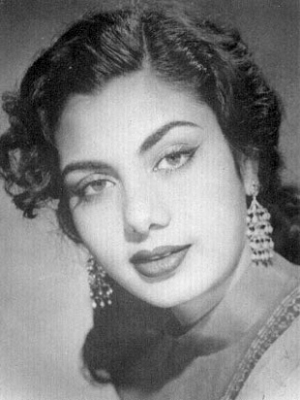
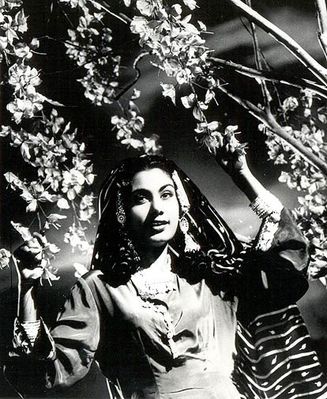

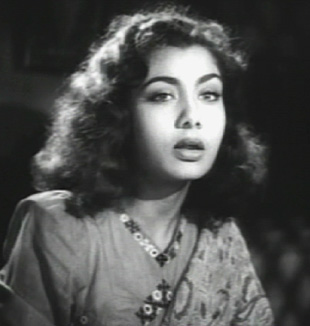
In Barsat Nimmi played the role of a naive hopelessly romantic ,innocent mountain girl
pining for the love of a city slicker (Premnath).The films title song Barsath mein humse/i]
[i]mile and Jiya bekaraar hai were picturised on Nimmi as well as the climax revolved around
Nimmi......Soon she was working with heroes like Dilip Kumar, Dev Anand and Raj Kapoor.She formed
a hit team with Dilip Kumar after Deedar where she played a second lead and Daag...in all
they acted together in five memorable films.......
She worked with most of the renowned directors of her time Chetan Anand,Vijay Bhatt, K.A.Abbas
and Mehboob Khan...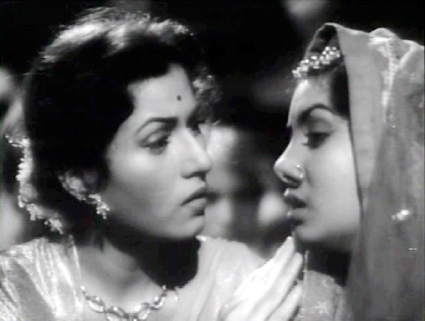

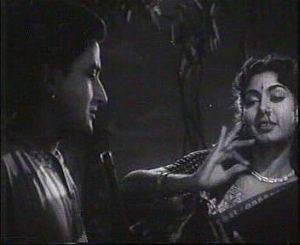

She acted in nearly 40 films...
some memorable ones
Barsaat
Wafaa
Deedar
Banwra
Sazaa
Buzdil
Daag
Aandhiyaan
Aan
Humdard
Amar
Udan Khatola
Kundan
Bhai bhai
Rajdhani
Sohni Mahiwal
Char dil Char raahein
Basant bahar
Shama
Mere mehboob
Akashdeep
With the advent of new heroines in the 1960's Nimmi's career went under a cloud...
She fell in love with Screen writer S.Ali Raza , who wrote the dialogues for her films Barsaat,Aan
and Andaz married him and settled down....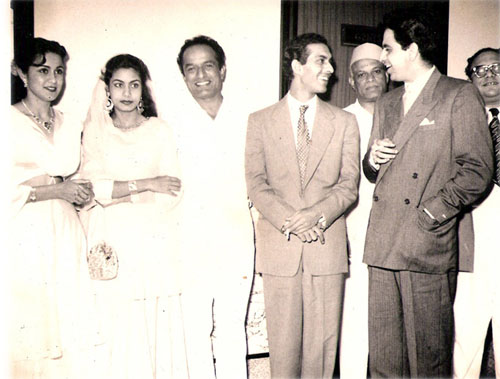

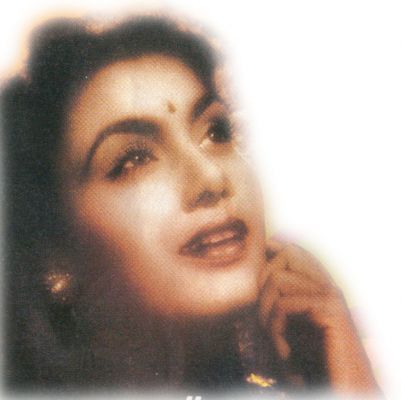
Director K.Asif had started Love and God , his version of the Laila Majnu legend
even before completing his tour de force Mughal e Azam.Guru Dutt was Nimmi's co-star in
the film and shooting got off the ground, this was to be Nimmi's claim to eternal fame courtesy
the director who immortalised Madhubala....Unfortunately for Nimmi Guru Dutt's untimely
death put a break on the film's shooting.........Sanjeev Kumar was chosen as his replacement but
yet again disaster struck when K.Asif passed away.....Nimmi had stopped acting in films for almost
two decades and Love and God was finally released in 1986 in a compromised form, a shadow
of what could have been...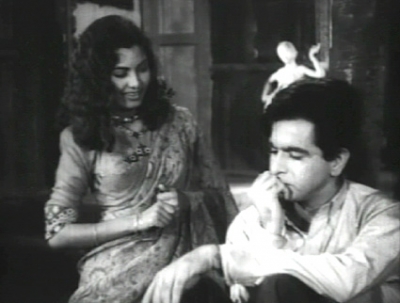

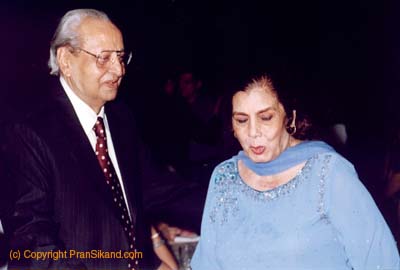
A fact that is little knnown today is that Nimmi was a singer in the film Bedardi(1951) in which
she also acted...
Some famous songs of Nimmi
Barsaat mein tumse mile hum
Tum na jaane kis jahan mein kho gaye
Aaj meri man mein sakhi bansuri bajaye
Preet yeh kaisi bol re duniya
Ik baat kahoo mere piya sunle agar tu
Hamare dil se na jaana
Mera salaam leja
Main piya teri tu maane ya na maane
Dil ka diya jhalake gaya
Allah bachaye naujawanon se
Today Nimmi lives next to her beloved Bombay Seafront in Worli with her Husband...
Attached image(s)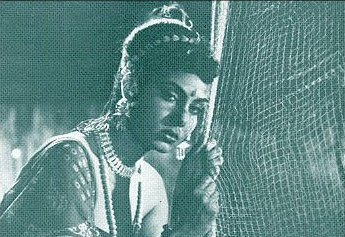

Posted by: jassi May 9 2007, 12:39 PM
apart from beena rai,nimmi is another actress i did not like earlier..but few days back i got to watch a film called pooja ke phool,i liked her voice..she was fine actress but i guess she was having attitude too..she refused b r chopra's sadhna coz she was not willing to play the role of prostitute or courtisian(she lost filmfare award too),but she played role of courtisian in mere mehboob and also accepted o p dutta's umrao jaan,which could not complete..
Posted by: jassi May 9 2007, 12:40 PM
she was an estiblised actress,but dunno why accpted second lead in aan,where newcomer nadira was playing lead role which was offered to nargis..
Posted by: jassi May 9 2007, 07:28 PM

Durga Khote
Brahmin film star whose appearance in Ayodhyecha Raja (1932) helped to legitimize respectable actresses performing in films.For a span of over 50 years, Durga Khote has been one of the most outstanding personalities of Indian Cinema, her unique career covering direction, production and acting. Her illustrious career commenced with the silent movies, Farebi Jaal, in 1931, just before the talkie was emerging. Her first talkie was the bi-lingual (Hindi & Marathi) Ayodhyecha Raja which was produced in 1932.With the studio system in vogue, she worked with Prabhat Film Co. Poona, New Theatres and East India (both at Calcutta), Prakash Pictures.She was an active participant of the Indian People's Theater Association (IPTA), a progressive, left-leaning movement of artists, writers and playwrights with links with the Communist Party and the Progressive Writers' Association (PWA), and which was incorporated as an all-Indian movement in 1943.She was committed to "democracy" as she understood it. Her family opposed and campaigned against Indira Gandhi's emergency (1977-1979) which suspended civil rights.As early as 1937, she produced and directed the feature film Saathi.She has acted in over 200 films in her career of 50 years plus. Her company continuous to produce these shorts, now headed by her daughter.Later she graduated to character roles, and remained active till the age of 80.She passed away in 1991.She received National Sangeet Academy Award,Dada Saheb Phalke Award,Padmashree State Award for Dhartichi Lekre (1970)and Filmfare Award for best supporting actress in Bidai (1974).
Her Performances-Ayodhyecha Raja(Govind Rao),Maya Machindra(Vinayak),Seeta(Prithvi Raj Kapoor),Amar Jyoti(Chandramohan,Shanta apte),Saathi(Mubarak),Bharat Milap(Prem Abid,Shobhna Samarth),Tasveer(Moti Lal),Mughle Aajam(Prithivi RK,Daleep K,Madhubala)(Rishi,Dimple),Bidai(Jeetendra,Leena),Khushbu(Jeetendra,Hema) & Karj(Rishi,Simmi,Tina M).
Posted by: jassi May 9 2007, 07:30 PM

Shobhana Samarth,mother of Nutan and Tanuja, grandmother of Kajol,Mohnish Behl & Tanisha. She is at the head of a family that has produced filmstars for three generations.But her entry into films was not simple.When her father passed away, Shobhana and her mother had to depend on her maternal uncle. He vehemently opposed the idea of Shobhana becoming an actress.Her uncle,whose daughter Nalini Jaywant later went on to became a well-known actress,justified his stand by saying that nobody would marry Shobhana if she became an actress. Then one day, her mother brought a proposal for her to marry Kumarsen Samarth, who had just returned from Germany having studied cinematography there.She asked him if he would object to her acting, he said, 'not at all.'becouse he was all set to do cinematography himself. So the two got married and thus began Shobhana's film career. Her first film, Nigahen Nafrat released in 1935, a few months after she was married. Her first daughter Nutan was born in June,After Nutan it was Tanuja,but they were willing to have son but after Tanuja it was again a doughter Chathura and finally a son Jaideep.Shobhana and her husband Kumarsen parted ways amicably. Their relationship became strained possibly because he couldn't take her success, even He made some films for her too.He visited his children and kept in touch with them till he passed away in the mid '70s.Her relationship with famous actor Motilal became the talk of the entire country,Everything about him resembled her father so much that she couldn't stop loving him.She even had some probblems with Nutan over some ecnomical issues,but all those things got solved when Nutan was on her last stage.Even at 84 she was having black hair( She never dyed it)She spent her last days very peacefully and even made an appearance on TV show Movers & Shakers(Host by Shekhar Suman) in 1999.She passed away in feb 2000.
She got Special Filmfare Award for her contribution to Indian Cinema in 1997.
Her Performances-Do Deewane ( Motilal and Yakub), Kokila (Motilal and Sabita Devi), Pati Patni (Wasti and Yakub), Sadhana ( Premadeeb), Apni Nagariya ( Nazir),Nayi Duniya (Jairaj), Savera (with Aroon who is actor Govinda's father)and Ram Rajya (with Prem Adip).
Posted by: Ummer May 10 2007, 03:40 AM
Can someone identify the people standing with Nimmi? One of them is Talat and other is Dilip Kumar. Who is the lady and the guy standing with Nimmi?
Attached image(s)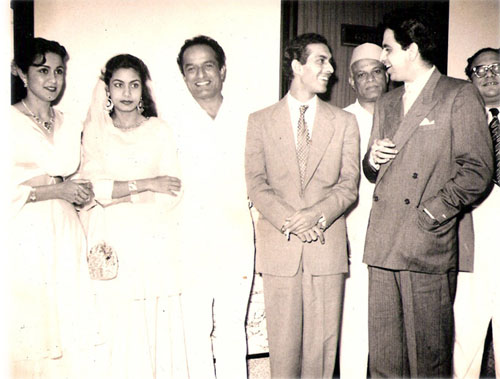
Posted by: jassi May 10 2007, 12:32 PM
my guess ismayil merchant and protima..
Posted by: nasir May 10 2007, 10:58 PM
apart from beena rai,nimmi is another actress i did not like earlier..but few days back i got to watch a film called pooja ke phool,i liked her voice..she was fine actress but i guess she was having attitude too..she refused b r chopra's sadhna coz she was not willing to play the role of prostitute or courtisian(she lost filmfare award too),but she played role of courtisian in mere mehboob and also accepted o p dutta's umrao jaan,which could not complete..
Jassi, in my opinion, Nimmi rightly turned down the role of a prostitute in SADHNA because only Vyjantimala could have performed the role of a dancing Tawaif. Nimmi was no dancer. As for her courtesan role in MERE MEHBOB , it was steeped in respectability and a very subdued one, a la 'Tehzeeb' of Lucknow.
Having seen her just a few days ago, she is a far cry from the Nimmi of the yore naturally.
NASIR.
Posted by: Reeth May 11 2007, 02:58 PM

Durga Khote
Brahmin film star whose appearance in Ayodhyecha Raja (1932) helped to legitimize respectable actresses performing in films.For a span of over 50 years, Durga Khote has been one of the most outstanding personalities of Indian Cinema, her unique career covering direction, production and acting. Her illustrious career commenced with the silent movies, Farebi Jaal, in 1931, just before the talkie was emerging. Her first talkie was the bi-lingual (Hindi & Marathi) Ayodhyecha Raja which was produced in 1932.With the studio system in vogue, she worked with Prabhat Film Co. Poona, New Theatres and East India (both at Calcutta), Prakash Pictures.She was an active participant of the Indian People's Theater Association (IPTA), a progressive, left-leaning movement of artists, writers and playwrights with links with the Communist Party and the Progressive Writers' Association (PWA), and which was incorporated as an all-Indian movement in 1943.She was committed to "democracy" as she understood it. Her family opposed and campaigned against Indira Gandhi's emergency (1977-1979) which suspended civil rights.As early as 1937, she produced and directed the feature film Saathi.She has acted in over 200 films in her career of 50 years plus. Her company continuous to produce these shorts, now headed by her daughter.Later she graduated to character roles, and remained active till the age of 80.She passed away in 1991.She received National Sangeet Academy Award,Dada Saheb Phalke Award,Padmashree State Award for Dhartichi Lekre (1970)and Filmfare Award for best supporting actress in Bidai (1974).
Her Performances-Ayodhyecha Raja(Govind Rao),Maya Machindra(Vinayak),Seeta(Prithvi Raj Kapoor),Amar Jyoti(Chandramohan,Shanta apte),Saathi(Mubarak),Bharat Milap(Prem Abid,Shobhna Samarth),Tasveer(Moti Lal),Mughle Aajam(Prithivi RK,Daleep K,Madhubala)(Rishi,Dimple),Bidai(Jeetendra,Leena),Khushbu(Jeetendra,Hema) & Karj(Rishi,Simmi,Tina M).

Shobhana Samarth,mother of Nutan and Tanuja, grandmother of Kajol,Mohnish Behl & Tanisha. She is at the head of a family that has produced filmstars for three generations.But her entry into films was not simple.When her father passed away, Shobhana and her mother had to depend on her maternal uncle. He vehemently opposed the idea of Shobhana becoming an actress.Her uncle,whose daughter Nalini Jaywant later went on to became a well-known actress,justified his stand by saying that nobody would marry Shobhana if she became an actress. Then one day, her mother brought a proposal for her to marry Kumarsen Samarth, who had just returned from Germany having studied cinematography there.She asked him if he would object to her acting, he said, 'not at all.'becouse he was all set to do cinematography himself. So the two got married and thus began Shobhana's film career. Her first film, Nigahen Nafrat released in 1935, a few months after she was married. Her first daughter Nutan was born in June,After Nutan it was Tanuja,but they were willing to have son but after Tanuja it was again a doughter Chathura and finally a son Jaideep.Shobhana and her husband Kumarsen parted ways amicably. Their relationship became strained possibly because he couldn't take her success, even He made some films for her too.He visited his children and kept in touch with them till he passed away in the mid '70s.Her relationship with famous actor Motilal became the talk of the entire country,Everything about him resembled her father so much that she couldn't stop loving him.She even had some probblems with Nutan over some ecnomical issues,but all those things got solved when Nutan was on her last stage.Even at 84 she was having black hair( She never dyed it)She spent her last days very peacefully and even made an appearance on TV show Movers & Shakers(Host by Shekhar Suman) in 1999.She passed away in feb 2000.
She got Special Filmfare Award for her contribution to Indian Cinema in 1997.
Her Performances-Do Deewane ( Motilal and Yakub), Kokila (Motilal and Sabita Devi), Pati Patni (Wasti and Yakub), Sadhana ( Premadeeb), Apni Nagariya ( Nazir),Nayi Duniya (Jairaj), Savera (with Aroon who is actor Govinda's father)and Ram Rajya (with Prem Adip).
Thank you jassi ....
Posted by: Reeth May 11 2007, 03:03 PM
Can someone identify the people standing with Nimmi? One of them is Talat and other is Dilip Kumar. Who is the lady and the guy standing with Nimmi?
Actress Peace Kanwal,Nimmi,V.Shantaram,Talat mahmood and Dilip kumar
Posted by: jassi May 11 2007, 06:27 PM
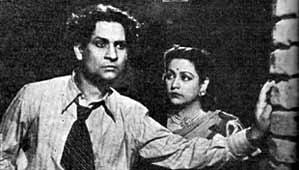
Naseem Bano
Said to be Bollywood s first female superstar known as "beauty queen" or Pari Chehra.Doughter of succesful singer Shamshad Begum and mother of succesful actress Saira Banu,Naseem Bano was also a succesful actress and singer.Her beauty attracted a myriad of film offers, but she had to resort to a hunger strike before her family would allow her to appear in movies. Naseem s entry to the movies was accidental when she visited Bombay and was offered a role in Hamlet,
which made her an overnight sensation. She shot Khoon ka Khoon, President, Divorce, Khan Bahadur, Meetha Zahar and Vasant but it was historical classic Minerva Movietone’s Pukar, in which, her leading role in Mughul-era spectacular gave her a tender performance as the monarch Noor Jehan that brought her success in 1930s hit. Before she retired in mid-1950 she also appeared in Sheesh Mahal, Chal Chal Re Naujawan, Naushirwan-e-Adil and other films. Naseem came from wealthy background, unlike most actresses of her era who rose from poverty. She joined the film industry when it was considered to be part of a very low profession.She retired in the mid-1950s so that she would not compete with the blossoming acting career of her daughter Saira Banu Instead, she turned her attention to designing clothing, especially intricately embroidered saris, until her death in 2002.
Her Performances-Hamlet(in hindi Khoon Ka Khoon),President(Prithviraj Kapoor),Meetha Zehar,Pukar( Sohrab Modi),Talaaq(Prem Adip),Begum(Ashok Kumar),Chal Chal Re Noujwan( Ashok Kumar,Jagdish Sethi),Door Chalen(Balraj Sahni),Anokhi Ada( Shyam,Cuckoo) etc.
Posted by: jassi May 11 2007, 06:30 PM

Also known as Lalitabai, started her career in 1928 as a child artiste with Aryan Films Company for a monthly salary of Rs.18.In a career spanning 72 years, she acted in more than 800 Hindi, Marathi, Gujarathi and Bhojpuri films. She was the leading lady of the regional silent era and, later, a character artiste till she retired from the celluoid.After she grew up and graduated to play the leading lady, she was known more as the "most ravishing beauty of the silent movies". Later, when she had her fill of lead roles, she switched over to doing character roles, some "vampish" roles came her way, but it was her enactment of wicked and tyrannical mother-in-law for which she is still remembered.She produced a film titled Kailash on a partnership basis, but couldn't resist the temptation to star in it. Hence she went ahead and did triple role of a heroine, the vamp, and the mother. Incidentally it was a silent film. In 1937, she produced another film, titled Duniya Kya Hai. Inspite of her career going great guns, a freak accident resulted in facial paralysis and an impairment of her eyesight. During the shooting of Jung-e-azadi, master Bhagwan had to slap her. Her left ear started bleeding profusely. The left part of her face was paralysed and she developed a squint in the left eye. It took her almost 4 years of vigorous and expensive treatment,She again made her re-entry and got success..Lalita spent her last days in her hometown Pune where she died alone(1998) and lonely. A sad end for a great star.
She got Filmfare supporting nomiees for Parvarish,Anari,Proffessor,Kohra,Deewana etc. She won the suporing actress award for Anari.
Raja Harishchandra(First talkie),Kirti(Jagdish Sethi),Dahej(Prithvi Raj),Mr & Mrs 55(Gurudutt,Madhubala),Shri 420(Raj K,Nargis,Nadira), Parvarish(Raj Kapoor,Mala Sinha),Anari(Raj K,Nutan),Jis desh me ganga behti hai(Raj K,Padmini),Proffessor(Shammi K,Kalpana),Kohra(Wahida R,Vishvajeet),Bahurani(Gurudutt,Mala S,Firoze K),Khaandaan(Suneel D,Nutan),Junglee(Shammi,Saira),Boond jo ban gayi moti(Jeetebdra,Mumtaj),Deewana(Raj K,Saira ![]() ,Neelkamal(Wahida R,Rajkumar,Manoj K),Saas bhi kabhi bahu thi(Sanjay K,Leena C) & Noukar(Sanjeev K,Jaya Bachan).
,Neelkamal(Wahida R,Rajkumar,Manoj K),Saas bhi kabhi bahu thi(Sanjay K,Leena C) & Noukar(Sanjeev K,Jaya Bachan).
Posted by: jassi May 11 2007, 06:34 PM
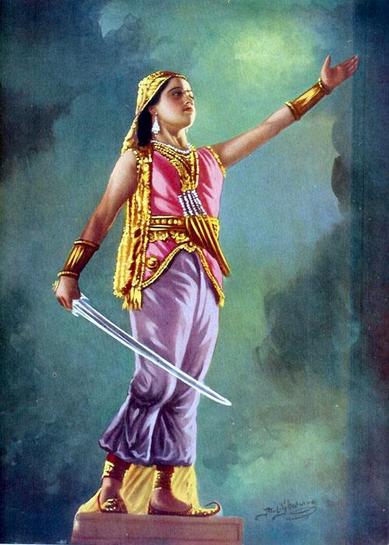
any idea abt this actress
Posted by: Ummer May 12 2007, 10:34 AM
she was an estiblised actress,but dunno why accpted second lead in aan,where newcomer nadira was playing lead role which was offered to nargis..
There are very few movies in which Nimmi was solo heroine. Nimmi once mentioned that she was mostly cast as "other" woman jilted in love. Udan Khatola, Aan, Deedar, Barsaat, Bhai Bhai, Amar, Alif Laila, Sazaa... Therefore, it is not surprising she played the second lead to Nadira in Aan... The problem with Lollywood and Bollywood is that artistes are typecasted in the same role again and again.
I think Reeth mentioned in one of his previous posts that Nadira wasn't a good actress and in Aan she mostly had to look at the hero with her eyes opened wide... It was not her fault... According to Nadira, Mehboob's directing skills were old fashioned and in Aan it was under Mehboob's direction that she had to look with her eyes opened wide because as per Mehboob it would make her look more "haughty"
Posted by: jassi May 12 2007, 06:53 PM
i guess its fine if she played second leads to her junier,but top actresses like mala,nanda n sadhana..but nadira was just a new girl and later become part of b grade films and did some strong supporting roles later..
nimmi could have become more memorable actresses(like madhubala,meena,nargis etc),if her film love n god wud have happened at right time..and if umrao jaan wud have completed..and refusing sadhana was also a mistake(ofcourse i too think vyajaythimala was perfect,but one cant ignore this that b r chopra was seeing his heroin in nimmi first)
Posted by: jassi May 12 2007, 07:04 PM
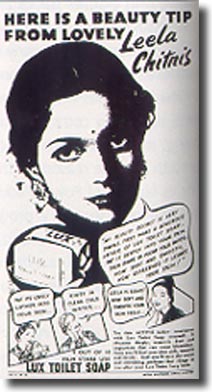
Leela Chitnis
Born in 1912 in Karnataka, Chitnis was closely associated with Marathi stage before she joined films as a junior artist. Her first role as a leading lady was in Master Vinayak’s Hindi melodrama ‘Chhaya’ in 1936 in which she played the title role. In ‘Kangan’ (1939), the first of the superhit films with Ashok Kumar, Chitnis was cast as the stereotypical village belle who pines for her beloved amidst great villainous hurdles. Her subsequent films with Ashok Kumar, ‘Bandhan’ (1940) and ‘Jhoola’ (1941), were also major successes. After a brief innings at the top, Chitnis switched to playing the role of mother in 1948 with the patriotic film ‘Shaheed’ in which she was cast as Dilip Kumar’s mother.She even directed a film Aaj Ki Baat .She later played Dilip Kumar’s mother again in the superhit ‘Ganga Jamuna,’ and also Dev Anand’s mother in two evergreen films, ‘Hum Dono’ and ‘Guide.’ She also directed a film, ‘Aaj Ki Baat,’ in 1955.Her image of the screen mother later adopted by other actresses like Sulochana and Nirupa Roy.Her last appearance was in the Kamal Haasan-starrer ‘Dil Tujhko Diya’ in 1985. Thereafter, she migrated to the United States, to be with her children, where she died in 90s.
She was the first Indian Brand Ambassedor of Lux soap, in 1941,She got Filmfare Nomination for film Sadhana in Supporting role.
Her Performances-Chhaya (Master Vinayak), Kangan,Jhoola,Azad,Bandhan (all with Ashok Kumar),Aaj Ki Baat(Ajit,Manmohan Krishna),Shaheed(Dalip K,Kamini K)Awara(Raj Kapoor,Nargis),Sadhana(Sunil Dutt,Vyjayntimala),Ganga Jamuna(Dalip K,Vyajantimala,Nasir Khan)Hum Dono(Dev,Nanda,Sadhana),Guide(Dev,Wahida) etc.
Posted by: maheshks May 13 2007, 02:25 AM

any idea abt this actress
She is Shanta Apte.
Posted by: jassi May 14 2007, 11:58 AM
yeah u r right..
its fine reeth,i ll keep posting such profiles
Posted by: Inaam May 16 2007, 02:31 AM
but why suraiya refused to work with dilip kumar..if it was becoz of dev anand..like nargis too walked out some of films starring dilip..its said bcoz of raj kapoor...
Maybe bcoz Dilip Kumar was known for his rude behavior? He said to Nadira that she was the most despicable creature he ever met on the sets of Aan. And he also made a similar comment about Lata's Urdu pronounciation as Lata was Marathi.
Ummer, Recently a book of senior film journalist Zakhmi Kanpuri 'Mujhe Yaad Hai Sab Zara Zara' has published from Karachi. I found following interesting quotation in the book about Suraiya & Dilip controversy.
"Ye uss zamaane ki baat hai jab Suraiya ka urooj tha. Jab bhi koi filmsaaz naii film signe karne Sariya ke ghar jaata toh Suraiya ki maa bade fakhr se kehti 'Beta aik Jubliee inko bhi de do'....Azeem adakaar Dilip Kumar ki shohrat ki ibtida thi.. K Asif se Dilip ki dosti misaali thi, Dilip K Asif ke saath 'Halchal' mein kaam karchuka tha, Dilip ne kaha kyun na aap mujhe Suraiya ke saath caste karein, chunacheh Asif ne 'Jaanwar' ke naam se aik naii film ka aaghaz kardiya. Iss film mein Dilip ke saath Suraiya ko caste kiya gaya. Ab Dilip ki iss khwahish ne iske andar ke jazbaat ko baahar nikalne per majboor kiya. Film ke scene ke mutaabiq Suraiya ki pindli per saanp kaat leta hai aur Hero Dilip Mumar saanp ka zehr apne moonh se choosta hai, iss scene ki rehearsal musalsal 4 roz tak jaari rahi. K Asif iss scene ko OK nahin kar rahe thay. 4 roz tak sirf issi scene ki rehearsal hoti rahi. Ab Suraiya ka maatha thanka ke iss scene ke pas-e-parda sirf aur sirf Dilip Kumar apne jazbaat ki taskeen karna chahta hai, jismein Asif iska hamnawa tha. Suraiya ne apni Maa se iska zikr kiya, uski Maa ne Suraiya ki hifaazat per maamoor uske moonh bole Maamoo Zahor se kaha ye sab kya ho raha hai? Zahore Sahab ki daadageeri uss zamane mein pore Bombay mein mashhoor thi, usne Suraiya ki Maa se kaha aap fikr na karein ab aisa nahin hoga. Doosre roz phir wohi scene huwa to Suraiya ne apni taang kheench li aur Dilip ko bura bhala kehna shuru kar diya. Zahor Dilip ki taraf bada lekin Asif ne darmiyaan mein aa kar baat badhne nahi di. Suraiya ne forun iss film mein kaam karne se inkaar kardiya. Asif ne kaha 'Khasaara kaun poora kare ga'? Suraiya ne forun purse mein se cheque book nikaal kar cheque kaata aur Asif ke hawaale kardiya aur set se chali aai. K Asif ne ye film windup kardi aur yun choti ke do adakaar yakja hone se reh gaye"
Posted by: jassi May 16 2007, 05:11 PM

Nirupa Roy has done over a hundred films as a heroine.She had nevar seen a movie till she came to Mumbai as 15 year old bride.She answered an advertisement for actors in a newspaper and got selected for a Gujrati Film Rankadevi.Her Husband supported her.By the next year.The Gujarati-Hindi bilingual, Gunsundari was Nirupa Roy's career-making film.When Bimal Roy chose her to play Balraj Sahni's wife in Do Bigha Zameen, Nirupa grabbed the chance to do something off-beat. She willingly wore unwashed clothes that had been bought from Bombay's Chor Bazaar.With the advent of the 1960s, the heroine roles dwindled and Nirupa got slotted as the mother.The crowning glory in Nirupa Roy's life however came in the 1970s when Vyjayanthimala turned down the chance to make a comeback with Yash Chopra's Deewar (1975). The author-backed role of a mother grappling with her son's (Amitabh Bachchan)'s transgressions and her own love for him came to Nirupa and she made it unquestionably her own.Nirupa's role was far superior to that of the heroines, Parveen Babi and Neetu Singh.She cut down on her work by the end of the 1980s and worked only intermittently in the 1990s.she had devoted a large part of her life to her profession.She passed away in 13 oct 2004 by heart attack.
she got so many supporting nominees of filmfare awards,she won awards for munimji,chaya and shehnai.
she got lifetime acheivment award in 2004.
Her performances-Gunsundari(Manhar Desai),Har Har Mahadev(Trilok Kapoor),Do Bigha Zameen(Balraj Sahni),Rani Rupmati(Bharat Bhushan),Bedard Zamana Kya Jaane( Ashok Kumar)Mujhe Jeene Do(Sunil Dutt,Wahida Rehmaan),Deewar(Amitabh,Shashi,Nitu,Parveen),Suhag(Shashi,Amitabh)Betaab(Sunny,A
mrita),Mard (Amitabh,Amrita)etc.
Posted by: jassi May 16 2007, 05:14 PM
i m surprised by this dilip-suraiya episode..dunno it was true or no,coz some writers just wrote all these things to get attention like inder mohan,who wrote so called biographies of meena kumari n rekha
Posted by: YaarMere May 16 2007, 05:17 PM
Maybe bcoz Dilip Kumar was known for his rude behavior? He said to Nadira that she was the most despicable creature he ever met on the sets of Aan.
Posted by: nasir May 16 2007, 09:52 PM
but why suraiya refused to work with dilip kumar..if it was becoz of dev anand..like nargis too walked out some of films starring dilip..its said bcoz of raj kapoor...
Maybe bcoz Dilip Kumar was known for his rude behavior? He said to Nadira that she was the most despicable creature he ever met on the sets of Aan. And he also made a similar comment about Lata's Urdu pronounciation as Lata was Marathi.
Ummer, Recently a book of senior film journalist Zakhmi Kanpuri 'Mujhe Yaad Hai Sab Zara Zara' has published from Karachi. I found following interesting quotation in the book about Suraiya & Dilip controversy.
"Ye uss zamaane ki baat hai jab Suraiya ka urooj tha. Jab bhi koi filmsaaz naii film signe karne Sariya ke ghar jaata toh Suraiya ki maa bade fakhr se kehti 'Beta aik Jubliee inko bhi de do'....Azeem adakaar Dilip Kumar ki shohrat ki ibtida thi.. K Asif se Dilip ki dosti misaali thi, Dilip K Asif ke saath 'Halchal' mein kaam karchuka tha, Dilip ne kaha kyun na aap mujhe Suraiya ke saath caste karein, chunacheh Asif ne 'Jaanwar' ke naam se aik naii film ka aaghaz kardiya. Iss film mein Dilip ke saath Suraiya ko caste kiya gaya. Ab Dilip ki iss khwahish ne iske andar ke jazbaat ko baahar nikalne per majboor kiya. Film ke scene ke mutaabiq Suraiya ki pindli per saanp kaat leta hai aur Hero Dilip Mumar saanp ka zehr apne moonh se choosta hai, iss scene ki rehearsal musalsal 4 roz tak jaari rahi. K Asif iss scene ko OK nahin kar rahe thay. 4 roz tak sirf issi scene ki rehearsal hoti rahi. Ab Suraiya ka maatha thanka ke iss scene ke pas-e-parda sirf aur sirf Dilip Kumar apne jazbaat ki taskeen karna chahta hai, jismein Asif iska hamnawa tha. Suraiya ne apni Maa se iska zikr kiya, uski Maa ne Suraiya ki hifaazat per maamoor uske moonh bole Maamoo Zahor se kaha ye sab kya ho raha hai? Zahore Sahab ki daadageeri uss zamane mein pore Bombay mein mashhoor thi, usne Suraiya ki Maa se kaha aap fikr na karein ab aisa nahin hoga. Doosre roz phir wohi scene huwa to Suraiya ne apni taang kheench li aur Dilip ko bura bhala kehna shuru kar diya. Zahor Dilip ki taraf bada lekin Asif ne darmiyaan mein aa kar baat badhne nahi di. Suraiya ne forun iss film mein kaam karne se inkaar kardiya. Asif ne kaha 'Khasaara kaun poora kare ga'? Suraiya ne forun purse mein se cheque book nikaal kar cheque kaata aur Asif ke hawaale kardiya aur set se chali aai. K Asif ne ye film windup kardi aur yun choti ke do adakaar yakja hone se reh gaye"
Very interesting info Inaam Bhai. Thanks.
NASIR.
Posted by: Ummer May 17 2007, 08:06 AM
i m surprised by this dilip-suraiya episode..dunno it was true or no,coz some writers just wrote all these things to get attention like inder mohan,who wrote so called biographies of meena kumari n rekha
I think it is true bcoz I have read about it in other sources too... Also the film Janwar still remains incomplete and Suraiya was quoted as saying "Mai Kisi Janwar kai saath kaam nahin karoun gi"... I wish we could all see the incomplete print of this film... where Dilip was ...
And Inaam thanks for the info...
Posted by: jassi May 17 2007, 10:43 AM
i could not stop laughing when i read abt suraiya's mother that arre beta inko bhi ek jubilee de do..
correct me guys i heard or read somewhere that nargis and suraiya's mothers were courtesans..
Posted by: maheshks May 17 2007, 11:06 PM
If K Asif was perfectionist then it was a case of poor acting by Dilip Kumar
who could not perform satisfactorily even after so many retakes....was
he such a poor actor?
The other point that comes to my mind is that if he was uncomfortable
doing the scene why he could not tell K Asif....was he such a weak
personality?
If he was doing that deliberately then suraiyya was correct in branding him.
Posted by: nasir May 17 2007, 11:25 PM
If K Asif was perfectionist then it was a case of poor acting by Dilip Kumar
who could not perform satisfactorily even after so many retakes....was
he such a poor actor?
The other point that comes to my mind is that if he was uncomfortable
doing the scene why he could not tell K Asif....was he such a weak
personality?
If he was doing that deliberately then suraiyya was correct in branding him.
It was not the case of poor acting by Dilip Kumar. Maybe Suraiya did not give proper expressions desired by K. Asif Sahaab. At the same time it has to be remembered that Suraiya was more of a better singer than actor.
NASIR.
Posted by: maheshks May 18 2007, 12:21 AM
I know you are a fan of Dilip Kumar...your comments are not free from bias...
Donot try to protect him. ![]()
Read my comments once again...read it properly ...
Do you agree with the two situations/questions I posed?
Do you think it is true or possible?...ponder over it
analyse with cool mind... donot jump to conclusions.
If the answer is no....then the episode is not true.
Posted by: YaarMere May 18 2007, 05:10 AM
Donot try to protect him.
Seen Ganga Jumna? In real life, Nasir Khan was "Ganga". You know that dont you? Usse pata chal gaya na ke Dilip ko tang kar rahe ho woh qabar apni se nikal aaya ga. Jaante nahin ho tum ke Nasir Khan kis mahlook ka naam hai aur meri baat maano na hi jaano toh accha.
Posted by: jassi May 18 2007, 10:47 AM
guys its abt actresses
and one should not think that his fav is saint..
actors are also like us..
i take intrest in only yesteryear stars's personal life(past),but i dont care abt present day stars's personal life..all i like to know abt their films..
Posted by: noorie May 18 2007, 07:21 PM
can anyone tell something more about begum para
Begum Para was a B-Grade actress mostly paired with Sheikh Mukhtar in films like Ustad Pedro etc. After partition she along with Mehboob Khan and some other established film stars visited Karachi-Pakistan to see if the condition was right to work there. But seeing the non-existent film industry they all went back to India. Although Mehboob Khan's younger brother Pyare Khan and Begum Para's sister stayed back. Here is the detailed interview of Begum Para
MS OOMPH - by V Gangadhar
Somewhere in 1953, Fort Cochin in Kerala was hit by a bomb. I was then in school there and thoroughly enjoyed the experience.
The bomb was called Begum Para. And it came packaged in a Hindi film, Ustad Pedro, produced and directed by the then well-known actor, Sheikh Mukhtar. Mukhtar was tall, well-built and ruggedly handsome. But he had very stiff competition in Begum Para, unanimously acknowledged to be Bollywood's sex bomb.
The film magazines called her the oomph girl, the girl with 'it'. Whatever she had, Para set my blood flowing. She had sultry, come-hither looks, an eye-popping figure, one she was not afraid to show off. She wore trousers, tight dresses and danced enticingly to the tunes of western music.
Ustad Pedro was a fun film. It was packed with action, romance, stunts and, of course, that wonderful, curvaceous woman. As Sheikh Mukhtar carried off the prized heroine at the end of the film, all the boys watching the film sighed enviously.
Hindi screen had its quota of women with smouldering good looks, who dressed seductively and who were ready to respond positively to a pass from the admiring male. But such women were normally cast as vamps because most heroines had to look virginal and god-fearing and play second fiddle to the heroes.
Not Begum Para. Her sexuality on the screen was electric. Film magazines of those days wrote endlessly about the frank utterances and open lifestyles of Begim Para and her sister-in-law, Protima Dasgupta. She was not a hypocrite, she always called a spade a spade.
I learnt this when I dropped in at her small flat in suburban Versova. The cool breeze from the sea was welcome, but not the stench of drying fish. The drawing room was full of photographs. Of Para's late husband Nasir Khan, her two sons and daughter. There are books everywhere. Enid Blyton for the grand-daughter along with classics -- theIliad, the Odyssey, the works of D H Lawrence as well as pulp fiction by Ludlum and Collins.
The passage of time had taken its toll. Begum Para had bloated up, the hair has greyed and she moved around with difficulty. There was little sign of who she once was. But once she began to speak, the old magic reappeared like abracadbra.
She had endured a lot in recent years. Nasir Khan died in 1974. He was just 49 and she had to bring up three children on her own. For years there was a long misunderstanding with her brother-in-law Dilip Kumar (she refused to talk about it) and the family bungalow on upmarket Carter Road had to be sold. One son, Ayub, works in films (he was most recently seen in Mrityudand), another son and her daughter are in advertising. Life had not been easy for the family, but then Begum Para, by all accounts, had always been a fighter.
The early days, though, were peaceful and happy. The family came from Jalandhar but moved to Bikaner, where her father Mian-Ehsan-Ul-Haque became the chief justice. The family was large, 10 in all, but they had lots of fun and the indulgent parents often joined in.
Para went to school and then college at Aligarh. Hostel life was quite pleasant. While sticking to tradition, her family was quite broad-minded. "We never wore purdah or anything like that," she explains.
"We were allowed to watch films and I enjoyed the experience." One of her earliest heroes, was the debonair Motilal. "I wrote fan letters to him, and he always replied. Later, when I joined films, we became good friends."
Still in her early teens, Begum Para came to Bombay to spend her holidays with sister-in-law Protima Dasgupta who was already acting in films like Court Dancer. Her home was frequented by film people. Perky, pretty Para invited instant attention and producers promptly offered her roles. Dasgupta persuaded her to accept some of the offers.
"My family was not very happy," recalls Para. "But finally, Protima and I convinced them." Born plain Para, she added a Begum to her name.
Thus it was that a nervous, excited, young girl of 17 faced the camera for the first time in her life on the sets of Chand. Her co-star was Prem Adib, a famous hero in those days. The film was shot at Prabhat Studio in Pune and was a family social.
"Oh, I had no acting experience at all," she laughs. "But director B D Kashyap was very understanding and patient, and made me feel at ease."
Did you have any love scenes, I asked. "Oh, very innocent ones," she smiled. "The lead pair looked at each other, sang songs and perhaps held hands. Films in those days were so different. But everyone on the sets, including Prem Adib, were very co-operative."
Chand was fairly successful. Para did not look back and settled down to a film career in Bombay, sharing a flat with her sister-in-law at Worli Sea Face. From 1945, for over 10 years, she made several movies -- Sohini Mahiwal, Mehendi, Shama, Pedro, Dada, Dara, the last three with the swashbuckling Sheikh Mukhtar. The films did well at the box office.
"I played emotional roles and also essayed roles of fashionable women," she remembers. The "it" image was a big thing in those days. Para often wore pants and jeans, dressed provocatively and championed an unconventional lifestyle. Naturally, she was regularly featured in film magazines.
"I had a good figure, and I knew I had one," she laughed. "And if the magazines wanted to feature me in provocative poses, I did not mind".
While her career was going strong, she met Nasir Khan (Dilip Kumar's brother) on the sets of Lootera. Nasir had made a name for himself with some good films with Nutan. "We liked each other, but it was not love at first sight."
They began meeting more often and got married in 1958. Did their families support the marriage, I asked.
"Oh, we were old enough to do what we wanted." she replied diplomatically.
Nasir Khan did not want her to act and she quit the screen. "I was quite happy to stay at home and look after the family," she says. Nasir Khan had a heart condition which he chose to neglect, and a heart attack claimed him in 1974.
It was a shattering blow and she had to face the crisis alone. For about 18 months, she went to Karachi and lived with her sister, who had settled down in Pakistan. "But India was my home and I was back to bring up my children," she explained.
It was then she missed her work in films. As long as Nasir Khan was alive, life had been smooth. But now many adjustments had to be made. But she managed to bring up her children and settle them in life.
Looking back on her career in films, she says she had not taken it very seriously. "It was fun and interesting while it lasted."
She cherished her friendships formed during those days. Nargis and Geeta Bali were close friends. So were, Motilal, Nimmi, Nirupa Roy, Nadira, Shyama and Manorama.
A couple of days before our meeting. Nirupa, Nimmi and Shyama had dropped in for a chat. "We meet quite often," laughed Begum Para. "We talk, gossip, laugh... They are wonderful people". While I was chatting with her, the telephone rang. It was another friend, kathak queen Sitara Devi. They agreed to meet later that evening.
She thinks highly of Motilal, Dilip Kumar, Amitabh Bachchan and Naseeruddin Shah. Among today's heroines, she says Kajol is the best. "Oh, that girl lights up the screen with her presence," she exclaims.
It was time to leave. We had chatted for nearly two hours. But I was certain about one thing. In my book of interesting people she goes down as Genuine Stuff!
Thanks Ummer.
Has anyone read Khushwant Singh’s autobiography, Truth, Love and a Little Malice ?
There's a very interesting
Noorie
Yeah share it plzzz.... is it something bad?
You could say so!
Ummer, Sb fan, Reeth and everyone else who frequents this thread, here's that account of writer Khushwant Singh's meeting with yesteryears' siren Begum Para that i promised you.
The reason I took this long is because I had to type it all from the book Truth, love & a little malice.
Well anyway, here's Khushwant Singh with his version of the Truth!
Noorie
Begum Para one time super vamp of the Indian screen had put on a lot of weight after she married Nasir Khan ( brother of super star Yusuf, alias Dilip Kumar) and borne him two beautiful children, a daughter and a son. Her husband died leaving her with very little beside a flat in Bandra and a couple of films. She felt she had a right to some of the millions that her brother-in-law was making.She also had a considerable inheritance in Pakistan waiting to be claimed by her. I met her through Rukhsana Sultana, her sister’s daughter. I saw quite a lot of Begum Para and her children in Bombay. Mnay Sunday mornings the family joined me at the Gymkhana Club bathing pool to swim and have breakfast. Begum Para often brought up the question of money. If anyone could loan her Rs 40 –50,000 she could have her old films re-screened and make a fortune. I didn’t take the hint.
In sheer desperation she migrated to Pakistan to stake her claim to her inheritance. Twoe of her brothers were in high places, one a minister in Bhutto’s govt. It didn’t take her long to discover that her relatives were not willing to part with anything, and she was on weak ground having earlier opted for India. She earned a little by flogging films she had brought with her and appearing on TV. Her children were unhappy. After the free and easy atmosphere of Bombay, the girl who was rapidly growing into a beautiful young lady, found the puritanical atmosphere of Pakistan very stifling. Begum Para wrote me several letters asking for help in returning to India. I werote back that I would be coming to Karachi soon and we could talk over the matter.
I arrived in Karachi early in the evening. Begum Para nad her children were there at the airport to receive me. So was the Chief of Protocol – because I was a guest of the govt. We were conducted to the V.I.P.lounge. The children had their fill of cakes and biscuits and were sent home. Begum Para aceepted my invitation to dine with me at the hotel where I was to stay the night, before catching the morning flight o Islamabad. The Chief of Protocol dropped us at my hotel. Begum Para came with me to my room. I ordered soda and ice and took out the bottle of Scotch I had brought with me. At that time there was no prohibition in Pakistan. I had heard stories about Begum Para’s drink problem. She had to cut down on it because of the price:a bottle of Scotch cost twice as much in Pakistan as it did in India. ‘Would you like a drink’? I asked her, not sure whether she was still a drinking woman. ‘I’ll take a little’, she replied. ‘I haven’t seen genuine Scotch for ages.’
me to
I pored out two stiff whiskys and handed her one.We resumed talking in Punjabi. I was not halfway through my glass when I saw her’s was empty. I poured out another one for her. She tossed it down and I had to refill it before I resumed drinking my own. By the time I had finished my quota of three large whiskys, Begum Para had had nine. The bottle was almost empty. I told her we must eat soon as I had to catch the early morning flight. Reluctantly she got up to accompany the dining room
The dining room was on the first floor. We had to climb up a spiral marble staircase to get to it. The place was crowded. As usual in Pakistan, there were very few women in the room. People recognized Begum Para because of her appearances on TV. They were intrigued to see her in the company of a Sikh.
We were shown to a table for two. We ordered our meal. 'Would you like to have something to drink while waiting for your meal?’ asked the waiter. ‘Nothing for me,’ I replied and looked at Begum Para. ‘I’ll have another Scotch and soda’, she said. She had another two before soup was served. She began to slur over her words, her eyes took on a glazed look. She wanted to have yet another drink with her meal. I put my foot down firmly.
At long last the meal came to an end. I got up to assist Begum Para with her chair. She stood up, swayed a little, and collapsed on the carpet. The waiters came running to help her walk to the stairs. All eyes in the dining room were turned on us. I was doubly careful going down the spiral staircase. I gripped her fat arm and ordered her: ‘one step at a time’. We made it to the foyer. I ordered a taxi for her and waited patiently for the ordeal to be over. A taxi drew up in the portico. I gave the driver a hundred rupee note and told him to take the lady home. He recognized Begum Para and knew where she lived. I opened the rear door of the taxi and went back to help Begum Para. As she stepped forward, she missed her step and once agin collapsed on the ground, this time with a loud fart.
She sprained her ankle and began to howl with pain. ‘Hi Rabba Main Mar Gayee!’- O God I’ve killed myself. A crowd gathered.
Being a Muslim country no unrelated male would touch a woman. I did my best to haul her up to her feet. Shw was far too heavy for me. I pleaded with the cab-driver for help. My advance tip came in handy. We got her on her feet and pushed her into the seat. I slammed the door and bid her a hurried farewell.
I got through the crowd and made for my room as fast as I could.
This is Hilarious i can't stop laughing..
Khushwant Singh is a 'rogue'.
My dad has these ancient collection of the now 'laid to rest' Illustrated weekly's, about the time when he had taken over as the editor, and some of the cartoons in it by Mario Miranda are scandalous ( not by today's standards ), though ticklishly funny too.
Have you ever chanced upon them Reeth?
Noorie
Posted by: jassi May 19 2007, 03:10 PM

Nadia born in Mary Evans to a Scot soldier with the British army and a Greek dancer with a touring theatre company, as she moves from Australia to Bombay to Peshawar and then back to Bombay.Blonde, blue-eyed Nadia wore daring shorts and tight, sleeveless blouses. She slashed villains with her whip, jumped from rooftops, swung from chandeliers, rode galloping horses, threw men about like toys - and became one of Hindi cinema's biggest stars in the 1930s and 40s.she begins her working life as a shop girl ,secretary in a law firm, joins a touring dance troupe, does time as a variety performer in a circus and finally into movies.She was introduced to films by J B H Wadia, the founder of Wadia Movietone, that behemoth of stunt and action films in the Bombay of 1930s.Nadia did over 30 films for the Wadias in the 1930s and 40s, with names like Hunterwali, Jungle Princess, Diamond Queen and Hurricane Hansa.But with passing time stunt movies could not attracted audience becouse social films were doing well now,So Wadia too produced social film Raj Nartaki(not starring Nadia as it was not action film),but film could not do well.Its failure coincided with the break up of the Company.Nadia and Homi Wadia fell in love, carried on an affair for years, and finally married only in the late Fifties, when Nadia was almost 52 years old. Nadia Hunterwali remains, even today, one of the great icons of Indian Cinema.She passed away in 1996.
Her Performances-Lal e Yaman with( Nazir),Hunterwali with (Jaidev),Desh Deepak and Frontier Mail with (John Cawes & Jaidev),Punjab Mail,Bambaiwali,Diamond Queen with (John Cawes & Boman Shroff),Jungle Queen,Delhi xpress etc.
Posted by: maheshks May 19 2007, 03:36 PM
Donot try to protect him.
Seen Ganga Jumna? In real life, Nasir Khan was "Ganga". You know that dont you? Usse pata chal gaya na ke Dilip ko tang kar rahe ho woh qabar apni se nikal aaya ga. Jaante nahin ho tum ke Nasir Khan kis mahlook ka naam hai aur meri baat maano na hi jaano toh accha.
YM...Janaab Nasir Saab is from the same city where I live..I know him better than you.
He is one of those members whose posts I often read. In age he is very senior to me
and much experienced as well. I feel very awkward when I find that in some posts he
flows with his emotions and goes erratic which I do not want because I never expect
seasoned people to go irrational and susceptible to attack. I want them to be perfectionists...
that is why I egg them on....off and on..off and on....
Posted by: Reeth May 20 2007, 12:15 AM
NALINI JAYWANT- Born 1926
Blessed with an extraordinarily serene face as innocent as a cherub's Nalini Jaywant was a huge star
in the fifties...
Dilip Kumar considers her the greatest actress he ever worked with,citing her instinct for grasping
the essence of a scene a second to none.Filmfare in their poll in the 1950s declared her one of the
most beautiful woman in the movies....yet when one talks of the legendery actresses of the Indian
screen, Nalini Jaywant's name hardly ever crops up, something that is grossly unfair to this extremely
good looking and multi faceted actress....
Nalini Jaywant was born in Bombay in 1926,The cousin of Famous actress Shobana Samarth.....Her first
prominent movie was mehboobs Bahen(1941), she starred in a handful of film hardly making an
impact till she was noticed in Anokha Pyaar(1948), then came more successful movies like Samadhi Sangram, Naujawan, Jadoo, Raahi ,Shikast....and she had become a top star...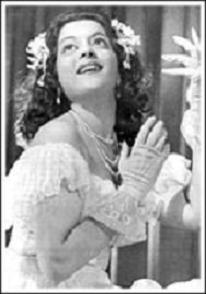
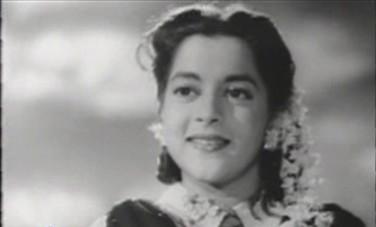
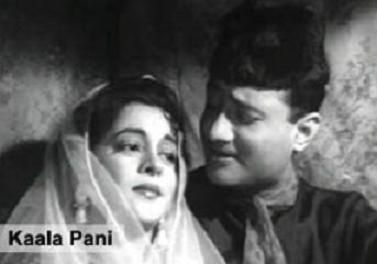
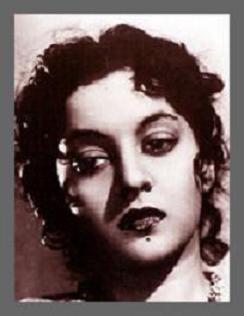
Nalini remained an important leading lady through to the mid fifties and acted opposite all the leading
actors of her time barring Raj Kapoor....Her movies were huge commercial sucesses...
Nalini left her mark with films like Samadhi and Sangram both with Ashok Kumar with whom she was
romantically involved,and went on to act in several films with him...Kafila(1952),Naubahar1952)
Saloni(1952),Sheroo and Mr.X (1957)...
She worked with directors like K.Abbas(Rahi), and Ramesh Saigal in Shikast,which is arguably
her career's best performance opposite Dilip Kumar....
Some of her memorable films
Radhika
Bahen
Anokha pyar
Samadhi
Sangram
Jaadu
Naujawan
Rahi
Shikast
Kavi
Nastik
Munimji
Railway platform
Awaz
Durgesh Nandini
Hum sab chor hai
Kaala paani
Zindgi aur hum
Bombay Race course
Toofan mein pyar kahan
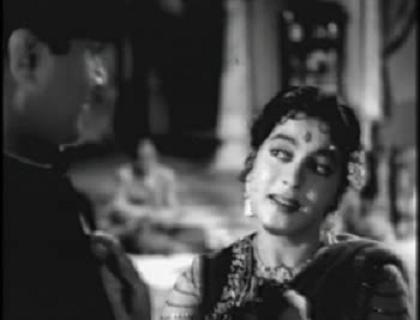
Her last Sucessful film was perhaps Raj Khosla's Kaala pAni(1958), she gave one of the best performance of her career as the nautch girl Kishori....playing a shaded character she stole a march
over the Heroine Madhubala and went on to win the Filmfare award for Best Supporting
Actress for the film.She is absolutely unforgettable in the film be it in the come-hither mujhra Nazar
Laage raaja or a she looks tearfully at Hero Dev Anand from across the room in that all time
great composition by SD Burman Hum Bekhudi mein....
Thereafter none of her films were really noteworthy with her last film being Bombay Race course
in 1965, after which she went into retirement.She made a comeback of sorts in Amitabh bachan's
Nastik where she played a blind woman....
Since then she has been living a reclusive life keeping all to herself...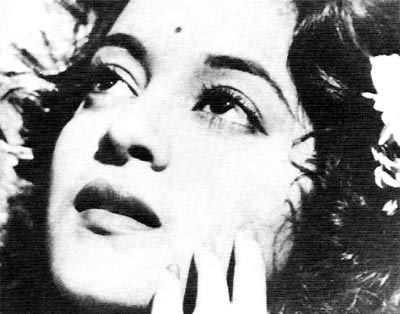
Posted by: nasir May 20 2007, 01:20 AM
Donot try to protect him.
Seen Ganga Jumna? In real life, Nasir Khan was "Ganga". You know that dont you? Usse pata chal gaya na ke Dilip ko tang kar rahe ho woh qabar apni se nikal aaya ga. Jaante nahin ho tum ke Nasir Khan kis mahlook ka naam hai aur meri baat maano na hi jaano toh accha.
YM...Janaab Nasir Saab is from the same city where I live..I know him better than you.
He is one of those members whose posts I often read. In age he is very senior to me
and much experienced as well. I feel very awkward when I find that in some posts he
flows with his emotions and goes erratic which I do not want because I never expect
seasoned people to go irrational and susceptible to attack. I want them to be perfectionists...
that is why I egg them on....off and on..off and on....
Maheshji, I think unwittingly I’ve been made a center of a controversy when none was intended. I take it as a compliment that you often read my post. Believe me, this again is not my intention. I just believe that the show must go on, the game should be made interesting whether for entertainment or information or even misinformation. I say “misinformation” because I do know that sometimes we genuinely make mistakes, come up with some wrong statement of facts unintentionally. Fortunately HF is endowed by very capable members and stalwarts such as yourself who, when time permits, take the pain to steer the ship on the right course. I thank you for that.
Having said that, I believe that not everyone can just do away with “Emotions.” I’m emotional. I do things with my heart rather than head. I cannot dissect myself in a clinical environment and try to be a “perfectionist.” You said you find me being “erratic” in some post. I wonder where though I have some faint inklings. Emotions are my forte and I cannot be a cold, calculating perfectionist. Aren't we all different?
Some flowers bloom early and wither away early too. Some bloom late and bloom for a long time. So the age factor has nothing to do with me since I am a late bloomer. I am what is termed as 30 plus (call this as being erractic, laugh if you must!) I prefer younger people for friends of 25 to 35. I am a believer in spontaneity. Therefore, I try to avoid older people, with respects, who think they know it all. Life is a continuous learning process irrespective of whatever age one might be. When we are all in a single classroom where does the question of age comes in?
If being "emotional" is against the HF discipline, please let me know.
NASIR.
Posted by: Reeth May 28 2007, 10:36 PM
Donot try to protect him.
Seen Ganga Jumna? In real life, Nasir Khan was "Ganga". You know that dont you? Usse pata chal gaya na ke Dilip ko tang kar rahe ho woh qabar apni se nikal aaya ga. Jaante nahin ho tum ke Nasir Khan kis mahlook ka naam hai aur meri baat maano na hi jaano toh accha.
YM...Janaab Nasir Saab is from the same city where I live..I know him better than you.
He is one of those members whose posts I often read. In age he is very senior to me
and much experienced as well. I feel very awkward when I find that in some posts he
flows with his emotions and goes erratic which I do not want because I never expect
seasoned people to go irrational and susceptible to attack. I want them to be perfectionists...
that is why I egg them on....off and on..off and on....
Maheshji, I think unwittingly I’ve been made a center of a controversy when none was intended. I take it as a compliment that you often read my post. Believe me, this again is not my intention. I just believe that the show must go on, the game should be made interesting whether for entertainment or information or even misinformation. I say “misinformation” because I do know that sometimes we genuinely make mistakes, come up with some wrong statement of facts unintentionally. Fortunately HF is endowed by very capable members and stalwarts such as yourself who, when time permits, take the pain to steer the ship on the right course. I thank you for that.
Having said that, I believe that not everyone can just do away with “Emotions.” I’m emotional. I do things with my heart rather than head. I cannot dissect myself in a clinical environment and try to be a “perfectionist.” You said you find me being “erratic” in some post. I wonder where though I have some faint inklings. Emotions are my forte and I cannot be a cold, calculating perfectionist. Aren't we all different?
Some flowers bloom early and wither away early too. Some bloom late and bloom for a long time. So the age factor has nothing to do with me since I am a late bloomer. I am what is termed as 30 plus (call this as being erractic, laugh if you must!) I prefer younger people for friends of 25 to 35. I am a believer in spontaneity. Therefore, I try to avoid older people, with respects, who think they know it all. Life is a continuous learning process irrespective of whatever age one might be. When we are all in a single classroom where does the question of age comes in? If being "emotional" is against the HF discipline, please let me know.
NASIR.
Posted by: HumTum May 28 2007, 10:49 PM
If you are passionate about something, why should you not be emotional? Nasirbhai, carry on. Like you say age is never a barrier for the learning process. Kudos! Keep it up.
Posted by: jassi May 29 2007, 04:43 PM
now this lady,nalini jaywant,i hardly watch 2-3 of her films kala pani n nastik,i was not impressed with her acting at all
in kala pani,she was having good role,but madhubala was grt,specially in second half,coz in first half she was not having much to do..
nalini was against shobhana's decision of joining films,but the she end up becoming an actress too
Posted by: Reeth May 30 2007, 04:12 PM
now this lady,nalini jaywant,i hardly watch 2-3 of her films kala pani n nastik,i was not impressed with her acting at all
in kala pani,she was having good role,but madhubala was grt,specially in second half,coz in first half she was not having much to do..
nalini was against shobhana's decision of joining films,but the she end up becoming an actress too
In Kala Pani Nalini was good jassi, and i find Madhubala equally good acting wise besides looking breathtakingly beautiful as she always does in all her movies........
I like Nalini jayawants's Munimji,was a lighthearted fun film with great music.....
Posted by: maheshks May 30 2007, 07:24 PM
Donot try to protect him.
Seen Ganga Jumna? In real life, Nasir Khan was "Ganga". You know that dont you? Usse pata chal gaya na ke Dilip ko tang kar rahe ho woh qabar apni se nikal aaya ga. Jaante nahin ho tum ke Nasir Khan kis mahlook ka naam hai aur meri baat maano na hi jaano toh accha.
YM...Janaab Nasir Saab is from the same city where I live..I know him better than you.
He is one of those members whose posts I often read. In age he is very senior to me
and much experienced as well. I feel very awkward when I find that in some posts he
flows with his emotions and goes erratic which I do not want because I never expect
seasoned people to go irrational and susceptible to attack. I want them to be perfectionists...
that is why I egg them on....off and on..off and on....
Maheshji, I think unwittingly I’ve been made a center of a controversy when none was intended. I take it as a compliment that you often read my post. Believe me, this again is not my intention. I just believe that the show must go on, the game should be made interesting whether for entertainment or information or even misinformation. I say “misinformation” because I do know that sometimes we genuinely make mistakes, come up with some wrong statement of facts unintentionally. Fortunately HF is endowed by very capable members and stalwarts such as yourself who, when time permits, take the pain to steer the ship on the right course. I thank you for that.
Having said that, I believe that not everyone can just do away with “Emotions.” I’m emotional. I do things with my heart rather than head. I cannot dissect myself in a clinical environment and try to be a “perfectionist.” You said you find me being “erratic” in some post. I wonder where though I have some faint inklings. Emotions are my forte and I cannot be a cold, calculating perfectionist. Aren't we all different?
Some flowers bloom early and wither away early too. Some bloom late and bloom for a long time. So the age factor has nothing to do with me since I am a late bloomer. I am what is termed as 30 plus (call this as being erractic, laugh if you must!) I prefer younger people for friends of 25 to 35. I am a believer in spontaneity. Therefore, I try to avoid older people, with respects, who think they know it all. Life is a continuous learning process irrespective of whatever age one might be. When we are all in a single classroom where does the question of age comes in?
If being "emotional" is against the HF discipline, please let me know.
NASIR.
Lesson No. 1 : To go astray because of emotions, more often then not, brings the
downfall of a person howsoever great he may be.
Lesson No. 2 : To commit frequent mistakes under emotions is a sign of poor personality.
Lesson No.3 : In your life do not act or follow a comet.....which shines and shines brightly
but within a short span of time....is relegated to the realm of obscurity.
Rely and try to become like a Pole Star...which shows the right path
year after year and never faulters or leaves its followers in the lurch.
NB : No further discussions and let us follow the thread as per its topic.
Posted by: Reeth May 30 2007, 07:33 PM
MADHBALA - (February 14 1933 - February 23 1969)
The name itself invokes so much enigma, that its just overwhelming....Madhubala, the Venus of the East
The most beautiful woman to adorn the Hindi film screen,Madhubala represents the era of Beauty
Romance and Tragedy associated with Hindi films. her Beauty had child like quality.....Fragile yet
Confident, her luminous eyes,Royal gait and that bewitching smile........Thirty eight years after her
death Madhubala's inordinate allure continues to evoke legends and inspire superlatives....hers
was no ordinary beauty.In all the brouhaha about Madhubala's porcelain exquisiteness often side
stepped is the fact that she was a mature intutive actress......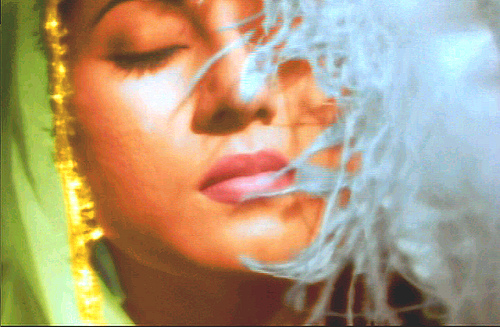


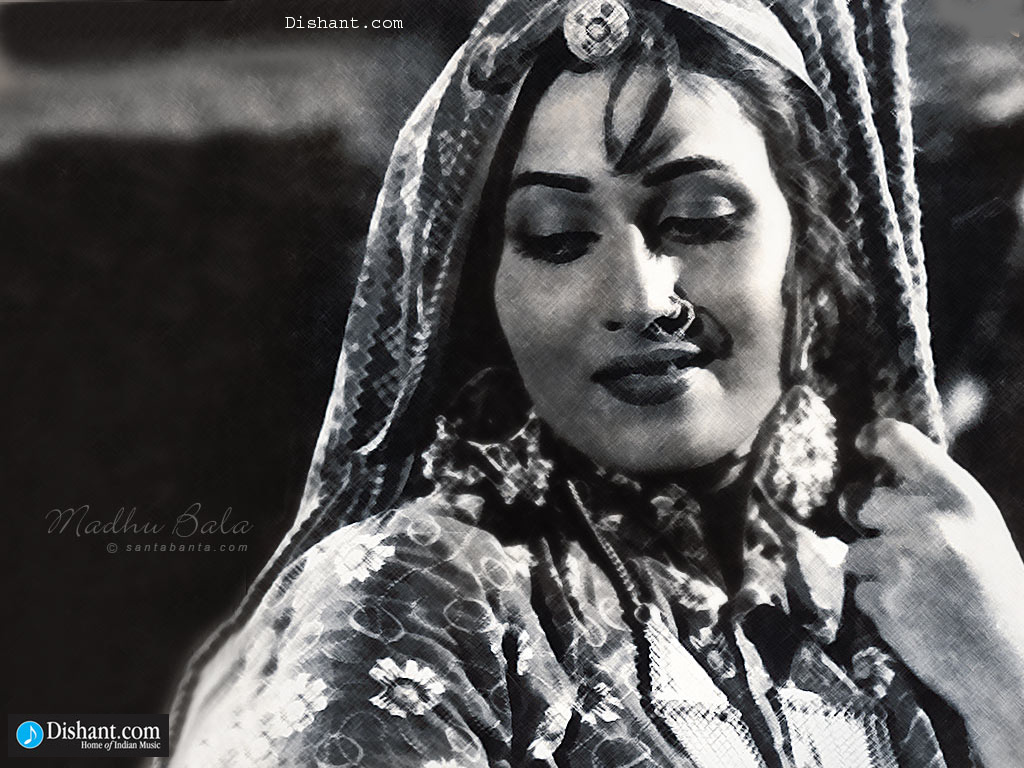
Madhbala was born Mumtaz Begum Jehan Dehlavi in Delhi the 5th child of a poor conservative Pashtun
Muslim family of 11 children.A muslim holy man is said to have predicted that the ypung Mumtaz would
earn fame and fortune, but would lead an unhappy life and die at a young age.Her father, Ataullah khan
was a coachman in Delhi migrated to Bombay searching for a better livelihood.The family struggled for
over ayear and Mumtaz entered bollywod as a child artiste under the name Baby Mumtaz...Her first film
was Basant(1942), Devika Rani was impressed by her and changed her name to Madhubala
She was to appear in Jwar bhata with Dilip Kumar in 1944, although she was unable to do
the role, it was her first meeting with Dilip Kumar...
It was Kidar Sharma who gave her a break as heroine opposite Raj kapoor in Neelkamal
in 1947.However it was with the Bombay tallkies suspense thriller Mahal(1949) that Madhubala
became a star....
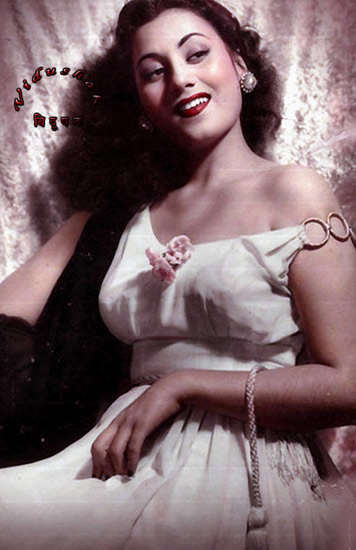
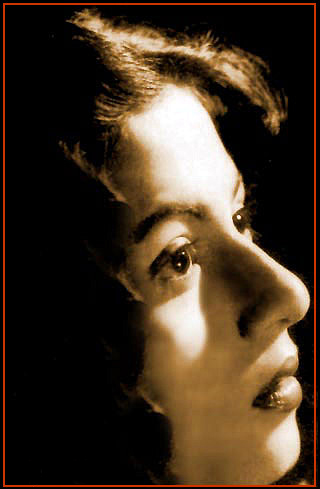
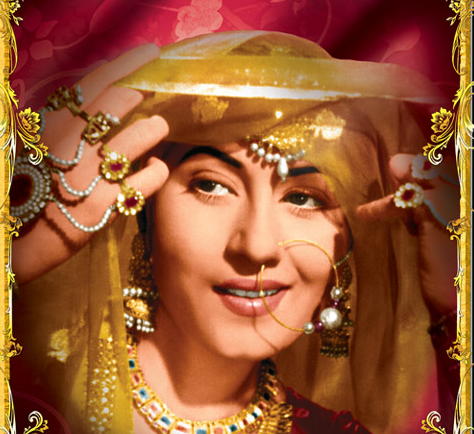
Over the next two years Madhubala blossomed into a captivating beauty,fans referred to her as the
Venus of the ndian screen..........She had spate of films opposite the leading men of the day
Ashok Kumar,Rehman,Dilip Kumar, Dev Anand.....but some of her films flopped including a major film
like Amar with Dilip Kumar, but she silencenced her critics in 1958 when 4 of her films
turned out to be superhits Phagun opposite Bharat bhushan, Howrah Bridge with Ashok Kumar, Kaala
Paani with Dev Anand and Chalti ka naam Ghadi with Kishore kumar......
In 1951 while shooting for Tarana Madhubala got involved with the leading man Dilip Kumar.
The Madhubala - Dilip Kumar affair lasted for 7 years between 1951-1958.During this time she had an
intimate relationship with Dilip and it was widely believed that the stunning pair would eventually get
married. However, It was ended by her father in a highly emotional and publicized court case( with regard to the B.R.Chopra film 'Naya Daur).They were forcibly seperated.
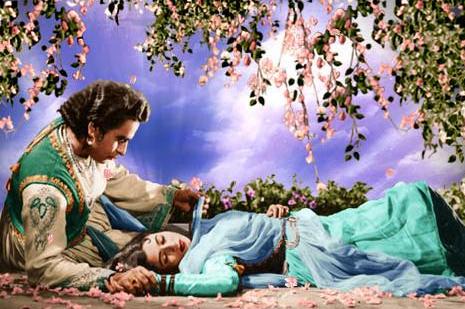

Madhbala's Heart problem was discovered in 1950 when Heart surgery was not available.Her illness
was kept a secret for many years....After her break up with Dilip Kumar she plunged into a loveless
marriage with Kishore kumar on the rebound accepting his proposal on the sets of Chalti ka naam
ghaadi,but his parents refused to attend the civil ceremony and never really
accepted her .....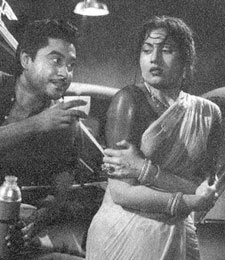
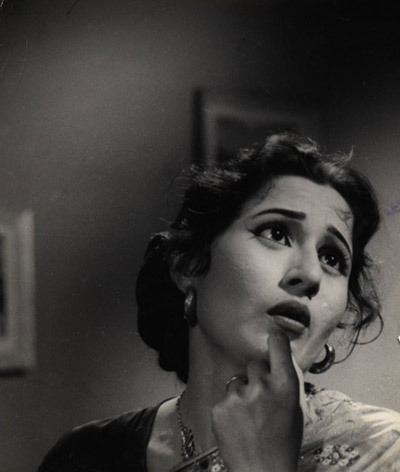
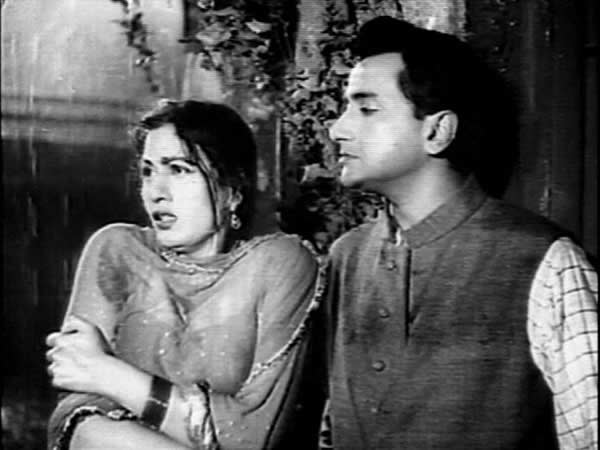
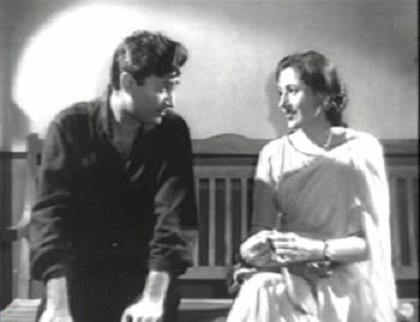
Some of her memorable films
Mahal
Dulari
Badal
Sangdil
Tarana
Armaan
Nirala
Ek saal
Sharabi
Amar
Mr. and Mrs 55
Gateway of India
Chalti ka naam ghadi
Jwala
passport
Phagun
Howrah Bridge
Kals paani
Barsaat ki Raat
Jhumroo
Mughal e azam
Half Ticket
Insaan jaag utha
In 1960 , it was Mughal-e-Azam which marked one of her Greatest performances as the doomed
courtesan Anarkali.The film showed off the finely modulated depth she could bring to her performance
if given an opportunity.It is an Outstanding performance in an Outstanding Film.
She did have some odd releases in the 1960's but she was mostly confined to bed because of her
illness.She was taken to London for Treatment, but the doctors refused to operate on her as they
thought she would die during the operation,she did survive for another year.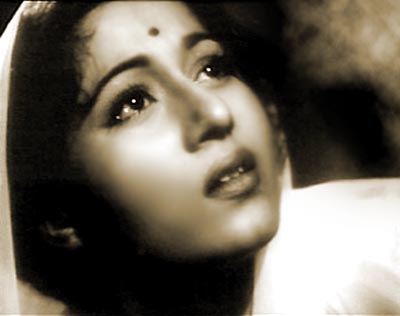
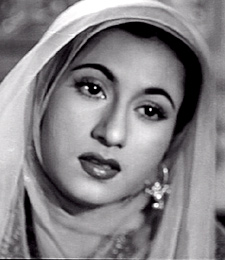
In 1964 she tried to make a comeback opposite Raj kapoor in Chalack , but she collapsed
on the first day of shooting and the film was shelved.
Her illness finally claimed her life in 1969, and she was buried in Santa Cruz Burial Ground along with
her Dairy.
In this short life she made over 70 films and t this day remains one of the most enduring legends
of the Indian cinema....Even today the very mention of the name Madhubala conjures up the image
of those dancing eyes, that lopsided smile.....She is held in awe and remains an icon of beauty and
glamour to scores of her fans.........
Attached image(s)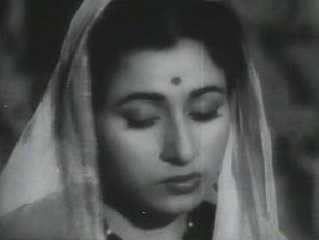
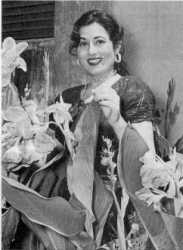
Posted by: RafiKiAwaaz May 31 2007, 12:20 AM
Thanks!!!! This was a another very touching piece on another unforgettable person in our lives. She was a precious jem as so many others!!!
RKA
Posted by: Reeth May 31 2007, 03:29 PM
Thanks!!!! This was a another very touching piece on another unforgettable person in our lives. She was a precious jem as so many others!!!
RKA
Madhubala : Indian Cinema's Tragic Beauty
Khalid Hasan
The Movie industry in the subcontinent is over eighty years old.Were someone to set about finding
who among the thousands of women who have passed across this shimmering dreamland was the
most stunning, the most beautiful, there would be little difference of opinion about that woman being
Mumtaz Begum, whom the world knew by her screen name Madhubala...
She died young, nine days after her thirty-seventh birthday.The 2 most important men in her life
only brought her immense pain, though they must have loved her in his own fashion.
The First was her Father, the authoritarian, hard driving Ataullah khan who in his frenzied bid to
control her life and career does not seem to have paid much attention to the Heart condition with
which she was born and which killed her.She was the toast of India and Pakistan and wherever else
movies made in India were seen, but she was like a prisoner in her own home. She was not allowed
to meet people unless they were pre-cleared by her father, nor was she permitted to be a part of the
industry to which her whole life was dedicated.It is hard to believe that this heartthroab of millions
was a defenseless young woman tyrannised over by a harsh father.
The other man in Madhbala's life who let her down was Dilip Kumar.They were in love and once it is
said he asked her to drop everything and just come with him, but she wanted her father's permission
which ofcourse was refused.Later, Dilip Kumar to his eternal shame, appeared as a witness against her
in a bitter court battle,that broke her heart...While Dilip was testifying against her she is supposed to have
turned to har lawyer R.D.Chadha and said 'I don't believe this is the man who was so in love with me and
whom i loved more than anyone or anything else in the world'.....
Madhubala made one last attempt to reach out to Dilip Kumar. She asked their mutual friend the movie
journalist Bunny Reuben to go to Dilip and tell him,how despite the court case she still loved him....the
moment Bunny mentioned why he was there, Dilip jumped at him angrily'What Rubbish? What love?'
Feeling lost and rejected Madhubala once and only time defied her father and married Kishore Kumar.
It was a disastrous marriage,it never worked....
Nature had given her unparalleld beauty, but it had also left a hole in her heart which in the 1960's was
considered a condition that could not be repaired........
She lies in the Santa Cruz graveyard in Bombay, where among others lie Mohammad Rafi and even
her father Ataullah Khan, who can no longer tyrannise her.
She rests in peace at last, still mourned by many.....
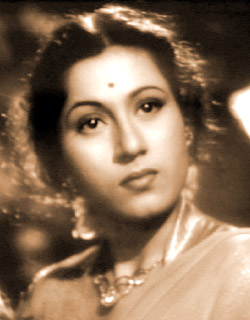
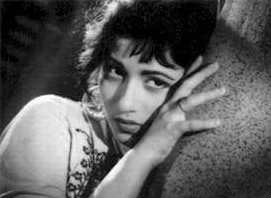
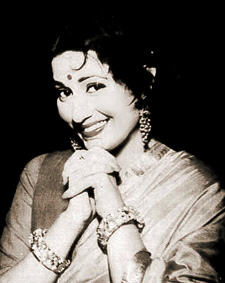
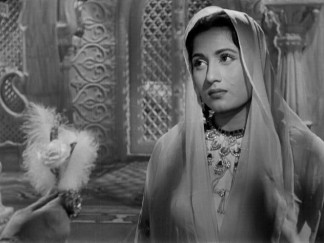
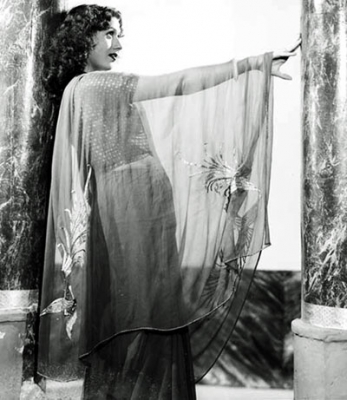
Posted by: jassi May 31 2007, 04:40 PM
what a grt lady she was..
Posted by: RafiKiAwaaz May 31 2007, 09:43 PM
Famous graveyard, though the remains of our beloved Rafi Shab and Madhubala are just dust but what a place to be buried. Yes rest in peace all, thanks for the memories!!!
RKA
Posted by: jassi Jun 1 2007, 03:10 PM

nalini with pran from chingari
Posted by: Reeth Jun 1 2007, 06:05 PM
what a grt lady she was..
She was indeed

nalini with pran from chingari
Thanks jassi
Posted by: Reeth Jun 1 2007, 06:05 PM
Famous graveyard, though the remains of our beloved Rafi Shab and Madhubala are just dust but what a place to be buried. Yes rest in peace all, thanks for the memories!!!
RKA
Posted by: noorie Jun 1 2007, 07:50 PM
I prefer the poker face better. ![]()
Noorie
Posted by: jassi Jun 2 2007, 04:23 PM
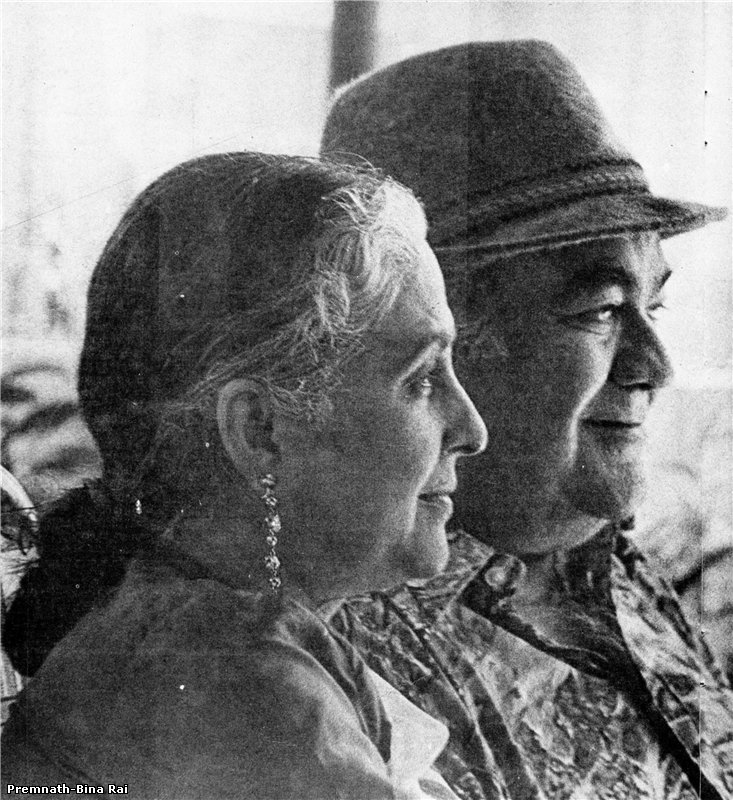
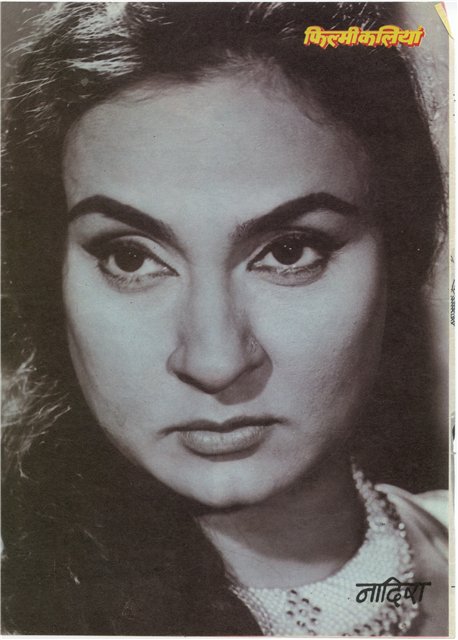
Posted by: nasir Jun 2 2007, 07:04 PM
M A D H U B A L A - Thee we remember.
Thanks Reeth for those beautiful pictures of hers and also the write up.
Millions of lives have been lost just because there was no treatment for the disease at a particular point of time. Madhubala's case is in point. If we watch the old movies we get this indication. For example, in JUGNU (1946) Noor Jahan dies of T.B. There seemed to have been no cure then. It was a dreaded disease. Many old movies showed one or the other character suffering from this disease. (Geeta Bali died of Small Pox). Movies of the Seventies showed the plight of the terminable disease CANCER. And now we have AIDS - but this disease is not being projected because of the attached stigma. There was just one movie PHIR MILENGE where the heroine's (Shilpa Shetty) world turn upside down on learning that she has tested HIV Positive. That millions still die of T.B. is because of its newer deadlier form and because of AIDS. So when the cure for Cancer and AIDS is found in future, those future generations would come up with similar observations that so many lives have been lost in the past.
Now, coming back to Madhubala (now this one is like MUJHE YAAD HAI ZARA ZARA) is it true that during the last days of her illness before death Madhubala had come to Dilip Kumar's house?
NASIR.
Posted by: nasir Jun 2 2007, 07:09 PM
If you are passionate about something, why should you not be emotional? Nasirbhai, carry on. Like you say age is never a barrier for the learning process. Kudos! Keep it up.
NASIR.
Posted by: Reeth Jun 2 2007, 08:16 PM

Nice pic jassi......they look very comfy together

Frankly she scares me
Posted by: Reeth Jun 2 2007, 08:24 PM
M A D H U B A L A - Thee we remember.
Thanks Reeth for those beautiful pictures of hers and also the write up.
Millions of lives have been lost just because there was no treatment for the disease at a particular point of time. Madhubala's case is in point. If we watch the old movies we get this indication. For example, in JUGNU (1946) Noor Jahan dies of T.B. There seemed to have been no cure then. It was a dreaded disease. Many old movies showed one or the other character suffering from this disease. (Geeta Bali died of Small Pox). Movies of the Seventies showed the plight of the terminable disease CANCER. And now we have AIDS - but this disease is not being projected because of the attached stigma. There was just one movie PHIR MILENGE where the heroine's (Shilpa Shetty) world turn upside down on learning that she has tested HIV Positive. That millions still die of T.B. is because of its newer deadlier form and because of AIDS. So when the cure for Cancer and AIDS is found in future, those future generations would come up with similar observations that so many lives have been lost in the past.
Now, coming back to Madhubala (now this one is like MUJHE YAAD HAI ZARA ZARA) is it true that during the last days of her illness before death Madhubala had come to Dilip Kumar's house?
NASIR.
I am not sure about the fact, but going by all accounts Madhubala never got over Dilip Kumar, and had he accepted her, she would have gladly married him......she married Kishore Kumar only after Dilip and Saira got married...........To be fair to Dilip Kumar.....He is supposed to have gone to her film sets and asked her to go with him , that a qazi was waiting at his home to perform the 'Nikhaa', but she was too timid to do so, and could never go against her Father's wishes, so she is supposed to have refused, this broke his heart and all else that followed was because of his bitterness towards her....
Posted by: nasir Jun 3 2007, 01:06 AM
M A D H U B A L A - Thee we remember.
Thanks Reeth for those beautiful pictures of hers and also the write up.
Millions of lives have been lost just because there was no treatment for the disease at a particular point of time. Madhubala's case is in point. If we watch the old movies we get this indication. For example, in JUGNU (1946) Noor Jahan dies of T.B. There seemed to have been no cure then. It was a dreaded disease. Many old movies showed one or the other character suffering from this disease. (Geeta Bali died of Small Pox). Movies of the Seventies showed the plight of the terminable disease CANCER. And now we have AIDS - but this disease is not being projected because of the attached stigma. There was just one movie PHIR MILENGE where the heroine's (Shilpa Shetty) world turn upside down on learning that she has tested HIV Positive. That millions still die of T.B. is because of its newer deadlier form and because of AIDS. So when the cure for Cancer and AIDS is found in future, those future generations would come up with similar observations that so many lives have been lost in the past.
Now, coming back to Madhubala (now this one is like MUJHE YAAD HAI ZARA ZARA) is it true that during the last days of her illness before death Madhubala had come to Dilip Kumar's house?
NASIR.
I am not sure about the fact, but going by all accounts Madhubala never got over Dilip Kumar, and had he accepted her, she would have gladly married him......she married Kishore Kumar only after Dilip and Saira got married...........To be fair to Dilip Kumar.....He is supposed to have gone to her film sets and asked her to go with him , that a qazi was waiting at his home to perform the 'Nikhaa', but she was too timid to do so, and could never go against her Father's wishes, so she is supposed to have refused, this broke his heart and all else that followed was because of his bitterness towards her....
That's a very pertinent info Reeth. Thanks.
It does appear that Dilip Kumar was truly in love with Madhubala. At this instance I'm reminded of a scene from MUGHAL-E-AZAM where Prince Salim slaps Anarkali thinking that the latter has betrayed him for wordly gains. And, despite the hard slap, she actually smiles knowingly, reassured of his passionate love. A similar real-life situation must have taken place between them.
NASIR.
Posted by: maheshks Jun 3 2007, 01:48 AM
Vanmala passed on 29th May in the age of 92 years. May God rest her soul in piece.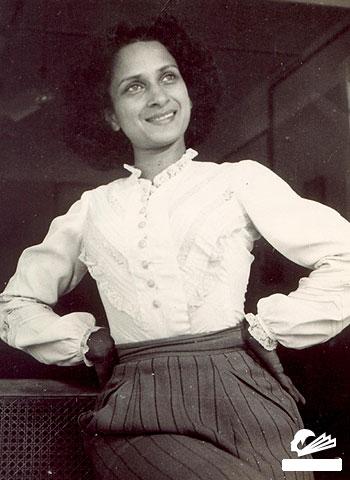
Posted by: Reeth Jun 4 2007, 12:38 AM
Vanmala passed on 29th May in the age of 92 years. May God rest her soul in piece.

Thanks for highlighting this mahesh
Vanmala Devi was a winner of the President's Award for best actress...
Born as Susheela devi pawar in 1915,she adopted the screen name Vanmala devi and acted in several marathi and hindi films.
She began her film career at the age of 21, when she was already a graduate and teacher.Her dreamy eyes won her the role of Roxana in Minerva movietone's blockbuster"Sikander" starring Sohrab modi and Prithviraj kapoor.
She was a staunsh nationalist and deeply involved in the freedom movement...
Even at the age of 92, she was running a school to train children in traditional Indian arts and culture.
Vanmala, who had been suffering from cancer, had undergone an operation about three months ago.
She died in Gwalior on Tuesday, May 29th , 2007.
She is survived by a brother N.R.Pawar.....
Posted by: Reeth Jun 16 2007, 05:35 PM
PADMINI - ( June 12 1932 - September 24,2006)
Padmini was a Top star in Bollywood as well as four other regional cinemas...Tamil,Telugu,
Malayalam and Kannada...
Padmini's charisma as a dancer allowed her to cross all regional boundaries and she
excelled in many different styles from Bharatnatyam to Western.Along with Vyjayantimala
her South Indian compatriot, Padmini could also be credited with popularizing, refining and setting
the standard and expectation for Indian popular cinema's psuedo-classical style of dance,that after
them have become a virtual prerequisite of every Bollywood and Indian Popular film.
Born and raised in the Princelty stae of Travancore in Kerala,Padmini was the second daughter....
Her sisters Lalitha and Ragini were also renowned dancers and actresses, and the threesome were
popularly known as the Travancore sisters.They were the disciples of the noted Indian dancer
Guru Gopinath...
At the age of 17 Padmini was cast as the heroine of Kalpana(1950),Uday Shankar's dance extravaganza,
and after that she went on to act in films for nearly 40 years...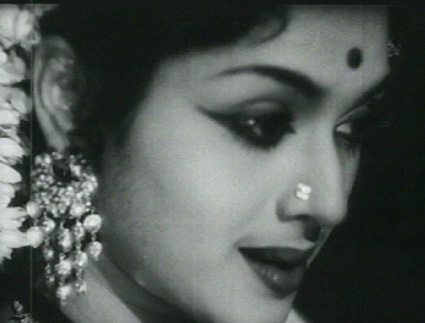
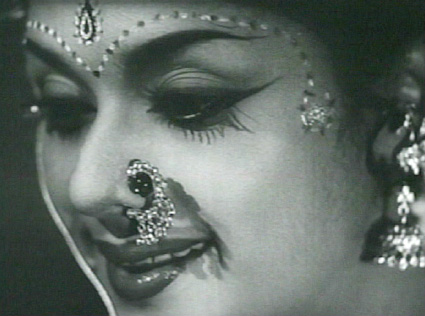
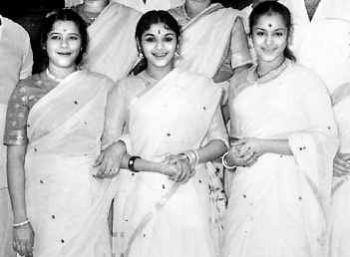

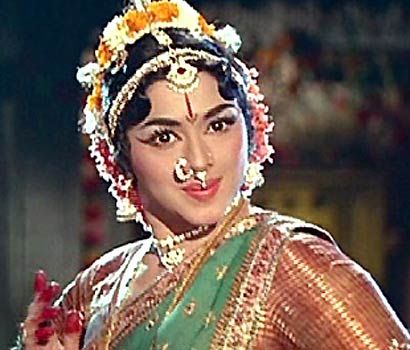
Padmini was renowned for her linguistic abilities and dubbed her own voice onto her movies in Tamil
Telugu,Malayalam and Hindi.This cross cultural linguistic ability made her a very significant figure in
the history of 20th century Indian cinema.
She co-starred with several of the most well known actors in Indian cinema...Sivaji Ganeshan,Prem
Nazir,Gemini Ganeshan,Raj Kapoor, MGR, Ashok Kumar, Sunil Dutt,Dharmendra,Sanjeev Kumar...
She acted in nearly 550 films of which 400 were in Tamil...
In two of her most popular films 'Jis desh mein Ganga behti hai' and 'Mera naam joker' she was
paired against the legendary Raj Kapoor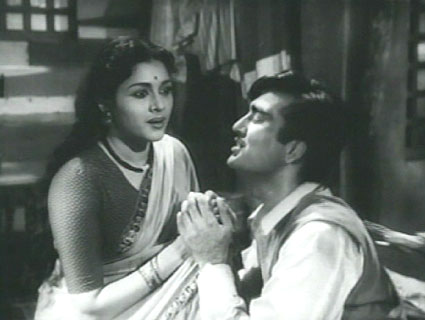
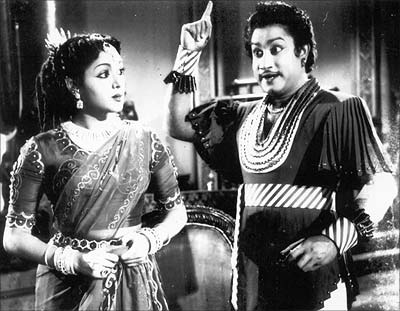
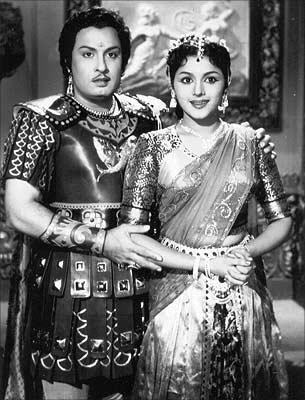

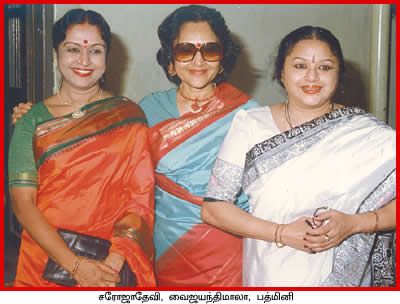
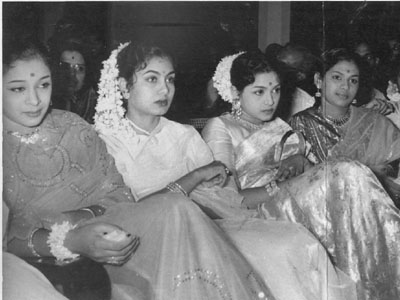
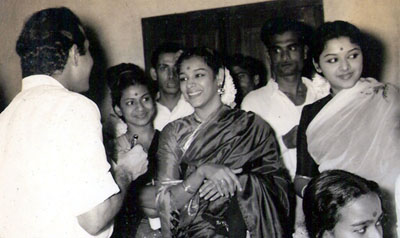
Some of her memorable films
Kalpana(Dance drama)
Mr Sampath
Payal
Jis Desh mein ganga behti hai
Apsara
Aashiq
Raj Tilak
Qaidi
Singapore
Pardesi
Kalpana
Bindiya
Kaajal
Nanha farishta
Afsana
Aurat
Vaasna
Bhai bahen
Chanda aur Bijli

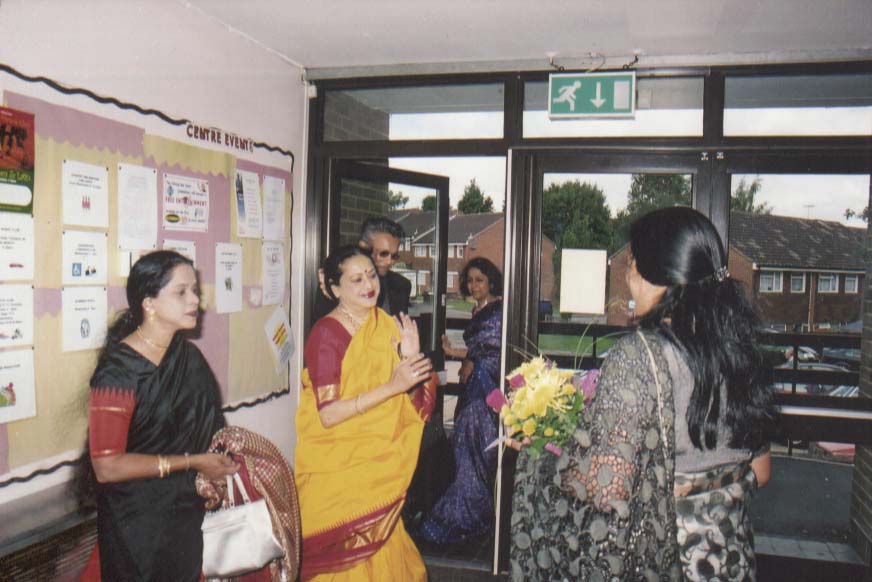
With Karunanidhi just a couple of days before her death..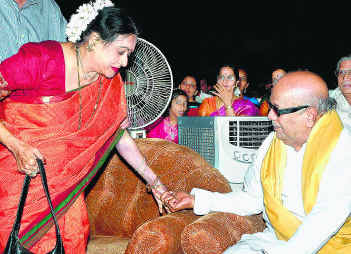
Her Career best and Most famous film was Tillana Mohanambal in Tamil with Sivaji Ganeshan
She won a Filmfare award for the Best Supporting actress in the year 1966 for Kaajal
After her marriage in 1961 to a Doctor, Padmini focused on marriage and refiniing classical dance
She settled in the United States in 1977 and opened her classical Dance school in New Jersey called
The Padmini School of fine arts.Her school today is one of the largest Indian classical dance
institutions in the United States.
Her only son Prem Ramchandra works with Warner Bros.......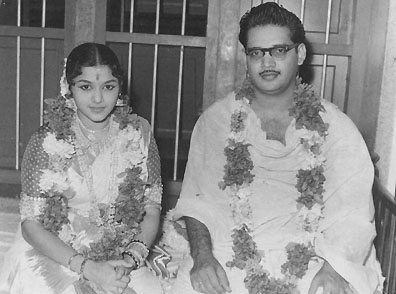
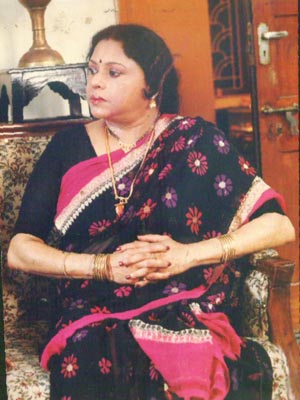
She had relocated to Chennai from New Jersey in June 2006 as she was keen on acting in some
quality films....however she died of a Heart attack in a hospital in Chennai on September 24,2006
leaving behind some memorable films in 5 languages.....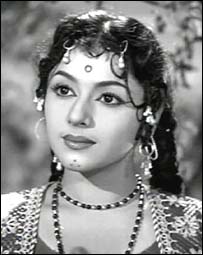
Posted by: nasir Jun 16 2007, 07:42 PM
Thank you Reeth for the info and those lovely pictures of Padmini.
No doubt, she was a Legend in her own right. As far as the Hindi films are concerned, RK's JIS DESH ME.N GANGA BEHTI HAI was her best. When she sang (Lata's sexy number) O MAINE PYAAR KIYA...heaving her breasts, (RK's favourite close-up shots...) the audience went wild. She would have won the prestigious Film Fare Award but lost out to Vyjantimala's powerful performance in GANGA JUMNA.
NASIR.
Posted by: Reeth Jun 17 2007, 02:05 PM
Thank you Reeth for the info and those lovely pictures of Padmini.
No doubt, she was a Legend in her own right. As far as the Hindi films are concerned, RK's JIS DESH ME.N GANGA BEHTI HAI was her best. When she sang (Lata's sexy number) O MAINE PYAAR KIYA...heaving her breasts, (RK's favourite close-up shots...) the audience went wild. She would have won the prestigious Film Fare Award but lost out to Vyjantimala's powerful performance in GANGA JUMNA.
NASIR.
Most welcome Nasir.....Padmini has done quite a few such numbers in Mera naam Joker, Chanda aur bijli,Kajal,Nanha farishta
Posted by: maheshks Jun 17 2007, 04:43 PM
M A D H U B A L A - Thee we remember.
Thanks Reeth for those beautiful pictures of hers and also the write up.
Millions of lives have been lost just because there was no treatment for the disease at a particular point of time. Madhubala's case is in point. If we watch the old movies we get this indication. For example, in JUGNU (1946) Noor Jahan dies of T.B. There seemed to have been no cure then. It was a dreaded disease. Many old movies showed one or the other character suffering from this disease. (Geeta Bali died of Small Pox). Movies of the Seventies showed the plight of the terminable disease CANCER. And now we have AIDS - but this disease is not being projected because of the attached stigma. There was just one movie PHIR MILENGE where the heroine's (Shilpa Shetty) world turn upside down on learning that she has tested HIV Positive. That millions still die of T.B. is because of its newer deadlier form and because of AIDS. So when the cure for Cancer and AIDS is found in future, those future generations would come up with similar observations that so many lives have been lost in the past.
Now, coming back to Madhubala (now this one is like MUJHE YAAD HAI ZARA ZARA) is it true that during the last days of her illness before death Madhubala had come to Dilip Kumar's house?
NASIR.
I am not sure about the fact, but going by all accounts Madhubala never got over Dilip Kumar, and had he accepted her, she would have gladly married him......she married Kishore Kumar only after Dilip and Saira got married...........To be fair to Dilip Kumar.....He is supposed to have gone to her film sets and asked her to go with him , that a qazi was waiting at his home to perform the 'Nikhaa', but she was too timid to do so, and could never go against her Father's wishes, so she is supposed to have refused, this broke his heart and all else that followed was because of his bitterness towards her....
Reeth I doubt the accuracies in these posts. Kindly recheck your resources:
Madhubala's beauty was legendary. The film star Nadira, whom Mahboob Khan
introduced in the first Indian colour film Aan, said of her, "She was like
a fairy descended from the skies. There was such dignity to her beauty,
which was what placed her in a class distinct and apart from others who
bear good looks". Begum Para who used to take morning walks with her said,
"If you saw her face the first thing in the morning as the sun rose, you
felt happy for the entire day. She was like a dream of exceeding
loveliness". Nimmi recalled that when she first saw Madhubala on a movie
set, she could not sleep that night. She just kept wondering if what she
had seen was real or if it was an illusion or perhaps it was an angel come
to earth.
Madhubala came to the movies as a child star and she kept working till the
end, bearing on her shoulders the entire financial burden of family
support. Her father, who kept hawk-like control on her life , also put her
money into wasteful ventures, including an unfinished screen disaster
called Pathan which he directed and which sank without trace. Madhubala by
then was too sick to star in it. He had earlier squandered her money by
launching five other movies that were never completed. He was such a tyrant
that he did not permit her to attend a dinner arranged during a film
festival where Frank Capra was present because he said, “She does not know
how to eat with a knife and fork.” It is hard to imagine that this
heartthrob of millions was a defenceless young woman tyrannised over by a
harsh father ( In classical
psycho-analysis, the memories and experiences become psychic themes
and acquire a dynamism of their own. They can invoke experiences
and by and large determine the direction in one's life. Some recent
researchers regard these early childhood experiences as the process
of "hardwiring" of the human computer. Whichever way it is described,
the point is that childhood experiences, particularly interpersonal relationships
in one's household, command a dominant place in the way a person chooses
to live her life. A daughter's life is considerably affected by her experiences
with her father such that in some cases she cannot rid herself of his influence
for the rest of her life. Madhu Bala's case appears to be typical).
Madhubala was in love with Dilip Kumar, and he with her, but Ataullah Khan
stood like a wall in their way. He did not want her to get married because
he would have thereby lost all the money that she earned. When the two,
Dilip and Madhubala, were cast for the movie Naya Daur, Ataullah Khan laid
down the condition that his daughter would not go for outdoor shooting. He
had earlier decreed that she would not do night shooting. The director of
Naya Daur, B.R. Chopra, wanted the unit to travel to Bhopal, but Ataullah
Khan put his foot down and even said that the entire thing was a ruse to
give Dilip the opportunity to entice away his daughter. Finally, in
desperation, Chopra sued Madhubala for fraudulently obtaining an advance
from him for a project she had no intention of completing. He also sacked
Madhubala and brought in the South Indian bombshell Vijayntimala to replace
her.
The litigation was nasty and Dilip Kumar appeared as a witness for the
prosecution against Madhubala and said some very bitter things about her in
open court. While Dilip was testifying against her, she turned to her
lawyer R.D. Chadha and said, “I don’t believe this is the man who was so in
love with me and whom I loved more than anyone and anything in the world.”
The film Naya Daur was released while the case was still in court and it
was an instant hit, including the music scored by O.P. Nayyar. Feeling
triumphant, Chopra withdrew the case.
Madhubala made one last attempt to reach out to Dilip. She asked their
mutual friend, the movie journalist Bunny Robin, to go to Dilip and tell
him how despite the court case, she still loved him. The moment Robin
mentioned why he was there, Dilip jumped at him angrily. “What rubbish.
What love?!” He was not even prepared to hear her name. Feeling lost and
rejected, Madhubala once and for he only time in her life defied her father
and married Kishore Kumar. It was a disastrous marriage and it never worked.
Nature had given her unparalleled beauty; but it had also left a hole in
her heart which in the 1960s was considered a condition that could not be
repaired. Ironically, the hole that Dilip, the only man she ever loved,
left in her heart, was even bigger and perhaps what brought the short and
tragic life of this lovely woman to an early end was not what nature had
wrought but what the man she loved had done. She lies in the Santa Cruz
graveyard in Bombay, where among others, lies Muhammad Rafi and even
Ataullah Khan who can no longer tyrannise over her. She rests in peace at
last, still mourned by many.
Posted by: Reeth Jun 18 2007, 12:45 AM
M A D H U B A L A - Thee we remember.
Thanks Reeth for those beautiful pictures of hers and also the write up.
Millions of lives have been lost just because there was no treatment for the disease at a particular point of time. Madhubala's case is in point. If we watch the old movies we get this indication. For example, in JUGNU (1946) Noor Jahan dies of T.B. There seemed to have been no cure then. It was a dreaded disease. Many old movies showed one or the other character suffering from this disease. (Geeta Bali died of Small Pox). Movies of the Seventies showed the plight of the terminable disease CANCER. And now we have AIDS - but this disease is not being projected because of the attached stigma. There was just one movie PHIR MILENGE where the heroine's (Shilpa Shetty) world turn upside down on learning that she has tested HIV Positive. That millions still die of T.B. is because of its newer deadlier form and because of AIDS. So when the cure for Cancer and AIDS is found in future, those future generations would come up with similar observations that so many lives have been lost in the past.
Now, coming back to Madhubala (now this one is like MUJHE YAAD HAI ZARA ZARA) is it true that during the last days of her illness before death Madhubala had come to Dilip Kumar's house?
NASIR.
I am not sure about the fact, but going by all accounts Madhubala never got over Dilip Kumar, and had he accepted her, she would have gladly married him......she married Kishore Kumar only after Dilip and Saira got married...........To be fair to Dilip Kumar.....He is supposed to have gone to her film sets and asked her to go with him , that a qazi was waiting at his home to perform the 'Nikhaa', but she was too timid to do so, and could never go against her Father's wishes, so she is supposed to have refused, this broke his heart and all else that followed was because of his bitterness towards her....
Reeth I doubt the accuracies in these posts. Kindly recheck your resources:
Madhubala's beauty was legendary. The film star Nadira, whom Mahboob Khan
introduced in the first Indian colour film Aan, said of her, "She was like
a fairy descended from the skies. There was such dignity to her beauty,
which was what placed her in a class distinct and apart from others who
bear good looks". Begum Para who used to take morning walks with her said,
"If you saw her face the first thing in the morning as the sun rose, you
felt happy for the entire day. She was like a dream of exceeding
loveliness". Nimmi recalled that when she first saw Madhubala on a movie
set, she could not sleep that night. She just kept wondering if what she
had seen was real or if it was an illusion or perhaps it was an angel come
to earth.
Madhubala came to the movies as a child star and she kept working till the
end, bearing on her shoulders the entire financial burden of family
support. Her father, who kept hawk-like control on her life , also put her
money into wasteful ventures, including an unfinished screen disaster
called Pathan which he directed and which sank without trace. Madhubala by
then was too sick to star in it. He had earlier squandered her money by
launching five other movies that were never completed. He was such a tyrant
that he did not permit her to attend a dinner arranged during a film
festival where Frank Capra was present because he said, “She does not know
how to eat with a knife and fork.” It is hard to imagine that this
heartthrob of millions was a defenceless young woman tyrannised over by a
harsh father ( In classical
psycho-analysis, the memories and experiences become psychic themes
and acquire a dynamism of their own. They can invoke experiences
and by and large determine the direction in one's life. Some recent
researchers regard these early childhood experiences as the process
of "hardwiring" of the human computer. Whichever way it is described,
the point is that childhood experiences, particularly interpersonal relationships
in one's household, command a dominant place in the way a person chooses
to live her life. A daughter's life is considerably affected by her experiences
with her father such that in some cases she cannot rid herself of his influence
for the rest of her life. Madhu Bala's case appears to be typical).
Madhubala was in love with Dilip Kumar, and he with her, but Ataullah Khan
stood like a wall in their way. He did not want her to get married because
he would have thereby lost all the money that she earned. When the two,
Dilip and Madhubala, were cast for the movie Naya Daur, Ataullah Khan laid
down the condition that his daughter would not go for outdoor shooting. He
had earlier decreed that she would not do night shooting. The director of
Naya Daur, B.R. Chopra, wanted the unit to travel to Bhopal, but Ataullah
Khan put his foot down and even said that the entire thing was a ruse to
give Dilip the opportunity to entice away his daughter. Finally, in
desperation, Chopra sued Madhubala for fraudulently obtaining an advance
from him for a project she had no intention of completing. He also sacked
Madhubala and brought in the South Indian bombshell Vijayntimala to replace
her.
The litigation was nasty and Dilip Kumar appeared as a witness for the
prosecution against Madhubala and said some very bitter things about her in
open court. While Dilip was testifying against her, she turned to her
lawyer R.D. Chadha and said, “I don’t believe this is the man who was so in
love with me and whom I loved more than anyone and anything in the world.”
The film Naya Daur was released while the case was still in court and it
was an instant hit, including the music scored by O.P. Nayyar. Feeling
triumphant, Chopra withdrew the case.
Madhubala made one last attempt to reach out to Dilip. She asked their
mutual friend, the movie journalist Bunny Robin, to go to Dilip and tell
him how despite the court case, she still loved him. The moment Robin
mentioned why he was there, Dilip jumped at him angrily. “What rubbish.
What love?!” He was not even prepared to hear her name. Feeling lost and
rejected, Madhubala once and for he only time in her life defied her father
and married Kishore Kumar. It was a disastrous marriage and it never worked.
Nature had given her unparalleled beauty; but it had also left a hole in
her heart which in the 1960s was considered a condition that could not be
repaired. Ironically, the hole that Dilip, the only man she ever loved,
left in her heart, was even bigger and perhaps what brought the short and
tragic life of this lovely woman to an early end was not what nature had
wrought but what the man she loved had done. She lies in the Santa Cruz
graveyard in Bombay, where among others, lies Muhammad Rafi and even
Ataullah Khan who can no longer tyrannise over her. She rests in peace at
last, still mourned by many.
Mahesh i got this info from an article by Syed Badrul Ahsan...A hole in her heart...biography of Madhubala,is available on the net...
Posted by: maheshks Jun 18 2007, 01:41 AM
NO.. not about her illness but about the kazi thing and the statement that
she got married to kishore kumar only after dilip and saira got married.
They got married in 1966 while madhubala and kishore in 1961.
Accounts of events given are misleading and lop sided.
I personally know many old timers here in Mumbai who were witnesses
to all those events. It pains me when I read such fanciful thoughts
errupted out of flight of imagination.
Which biography are you mentioning about? Let me see.
Posted by: Reeth Jun 18 2007, 02:54 PM
NO.. not about her illness but about the kazi thing and the statement that
she got married to kishore kumar only after dilip and saira got married.
They got married in 1966 while madhubala and kishore in 1961.
Accounts of events given are misleading and lop sided.
I personally know many old timers here in Mumbai who were witnesses
to all those events. It pains me when I read such fanciful thoughts
errupted out of flight of imagination.
Which biography are you mentioning about? Let me see.
I am sorry about that....i am trying to locate the article where i got that from, which as you say is not correct....infact kishore kumar and Madhubala had a civil marriage in 1960 and later he is supposed to have converted to islam and got married according to muslim rites which angered his family.....i should have rechecked before writing that...
however the qazi incident has been quoted in a couple of other articles as well other than the one i mentioned earlier...
Posted by: nasir Jun 18 2007, 08:59 PM
NO.. not about her illness but about the kazi thing and the statement that
she got married to kishore kumar only after dilip and saira got married.
They got married in 1966 while madhubala and kishore in 1961.
Accounts of events given are misleading and lop sided.
I personally know many old timers here in Mumbai who were witnesses
to all those events. It pains me when I read such fanciful thoughts
errupted out of flight of imagination.
Which biography are you mentioning about? Let me see.
I am sorry about that....i am trying to locate the article where i got that from, which as you say is not correct....infact kishore kumar and Madhubala had a civil marriage in 1960 and later he is supposed to have converted to islam and got married according to muslim rites which angered his family.....i should have rechecked before writing that...
however the qazi incident has been quoted in a couple of other articles as well other than the one i mentioned earlier...
Reeth, on conversion, did KK change his name to ABDUL REHMAN? Is that mentioned somewhere?
Nasir.
Posted by: Reeth Jun 19 2007, 02:57 PM
NO.. not about her illness but about the kazi thing and the statement that
she got married to kishore kumar only after dilip and saira got married.
They got married in 1966 while madhubala and kishore in 1961.
Accounts of events given are misleading and lop sided.
I personally know many old timers here in Mumbai who were witnesses
to all those events. It pains me when I read such fanciful thoughts
errupted out of flight of imagination.
Which biography are you mentioning about? Let me see.
I am sorry about that....i am trying to locate the article where i got that from, which as you say is not correct....infact kishore kumar and Madhubala had a civil marriage in 1960 and later he is supposed to have converted to islam and got married according to muslim rites which angered his family.....i should have rechecked before writing that...
however the qazi incident has been quoted in a couple of other articles as well other than the one i mentioned earlier...
Reeth, on conversion, did KK change his name to ABDUL REHMAN? Is that mentioned somewhere?
Nasir.
Not sure abt that nasir, i can look it up....
Posted by: jassi Jun 19 2007, 03:19 PM
it may upset kishore fans but i wonder as he married abt four times..
what he was looking for
Posted by: jassi Jun 19 2007, 03:19 PM
let me know if kishore ever sing for dilip kumar or not
Posted by: jassi Jun 19 2007, 03:33 PM
Suchitra Sen(Bengali),Padmini(South) & Sandhya(Marathi) they all were not regular Bollywood Actresses,but they did some fine work in Bollywood too.Sandhya later became part of Hindi films,but there was always gap in her film.Suchitra and Padmini did Hindi Films,when they got something nice to do.Here are biographies of these three Regional Actresses.....
Suchitra Sen
Born in 1931 in Patna,Suchitra Sen was the most popular actress that Bengali Cinema has ever seen. Her beauty and acting talent was just superb.All this gave her a legendary cult status in Bengal.Her debut was in the unreleased Shesh Kothai made in 1952 oppocite Uttam Kumar.They went on to become icons of Bengali romantic melodramas for more than twenty years .She was already a superstar of Bengal,but did good work in Bollywood too.She did not get much success in Bollywood may be because of language problems. Her first Hindi film was Bimal roy s Devdas (1955),she played role of Paro and got critical acclaim for her. Later she did few hindi films Bambai Ka Babu & Musafir but these films could not do well at the box office.Mamta and Aandhi were her two best performances of hindi films.Mamta and Aandhi were her two best performances of hindi films.She retired from the screen in 1978.A devotee of Ramakrishna Mission, Suchitra now immerses herself in meditation and prayer.Her daughter Moon Moon Sen(who is just remembered for exposing) and grand daughters Riya and Raima(both are doing well as comparison to their mother) are all actresses as well.
She got filmfare nomination of best actress award for Mamta and Aandhi.
Suchitra Sen is the first Indian actress awarded in an international film festival. She received the Best Actress award for the movie saat paake bandha in 1963 Moscow film festival.Some of her Bengali films also remaked in Hindi for eg. Khamoshi(Wahida Rehmaan,Dharemndra & Rajesh Khanna) and Kora Kagaj(Vijay Anand,Jaya Bachan).
Her Performances(In Hindi)-Devdas(Dalip K,Vyajantimala),Champakali(with Bharat Bhushan),Musafir(with Dalip K,Kishore K),Mamta(with Ashok K,Dharamendra),Bambai Ka Babu(with Dev Anand),Aandhi(with Sanjeev Kumar) and couple of Bengali films.
Posted by: jassi Jun 19 2007, 03:37 PM
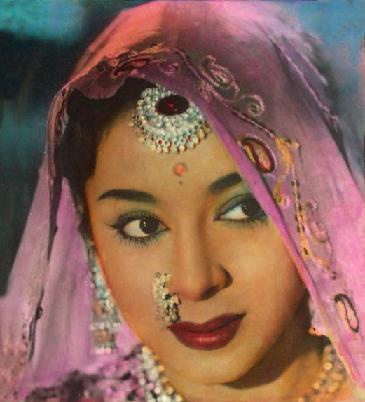
Padmini
Born in 1932,Padmini was small time bollywood actress,but she was super star in south and did good work in hindi films too.Her elder sister Lalitha and younger sister Ragini were also renowned film actresses.Padmini had her early education at Mahila Mandiram School and at Sea Shell convent in Thiruvananthapuram. Later she devoted her entire time and energy in pursuing classical dance and has been religiously doing it for the past 64 years.At 14, she became a member of a dance troupe that toured various parts of India. At the age of 17, Padmini became the heroine of the Hindi film "Kalpana," .Later she did films like Jis desh mein ganga behti hai. She then went on to act in Hindi, Tamil, Telugu, Kannada, and Malayalam films.But she nevar did so many films in Hindi.Padmini has acted with all the leading heroes during that age, which include legendary stars like Raj Kapoor, Dev Anand,Rajinder Kumar,Dharamendra,Sivaji Ganesan, MGR, Prem Nazir, and Raj Kumar.She got married to Dr. KT Ramachandran in 1961.Her Mera Naam Joker s one scene create lot of hoo haa. She left the soaring acting career and settled for family life. 1977, she started her own school 'Padmini School of Fine Arts' at the basement of her house in New Jersey with four students.Late film actress Richa Sharma, Sanjay Dutt's wife was one of her students. She is a founder-member of the Hindu Temple Society of North American. She is also associated with many charities.In 1981 her husband died at the age of 48. Their only son Premanand is an official with the Warner Brothers. He acted in one Malayalam movie and produced three documentaries.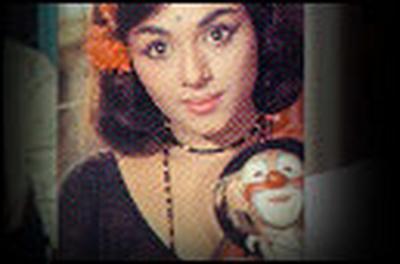
She got Filmfare Best Actress Nomination for Jis Desh Mein Ganga Behti Hai and Filmfare Best Supportiung Actress Nomintation for Kaajal and she won the award Kaajal and also won Best actress awards(South) of the Film Fans Association in 1954,'59,'61 and '66.
Her Performances-Kalpana(with Ashok K),Kaajal(with Meena K,Rajkumar,Dharamendra),Jis Desh Mein Ganga Behti Hai(with Raj K),Bhai Behan(with Ashok K,Sunil D,Nutan),Mahabharat(with Pradeep K,Dara Singh),Vaasna(with Rajkumar,Biswajeet),Chanda aur Bijli(with Sanjeev Kumar,Sachin) and Mera Naam Joker(with Raj K,Rajendra K,Dharamendra,Manoj K,Simi,Rishi Kapoor)etc.
Posted by: jassi Jun 19 2007, 03:40 PM
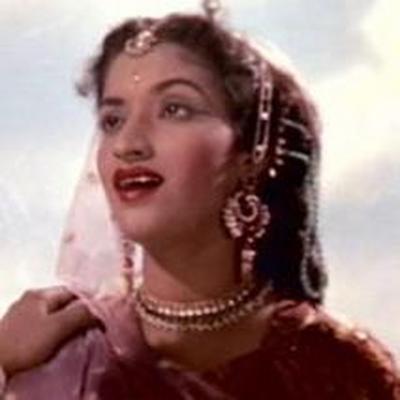
Sandhya
Sandhya was Marathi Actress,who later joined Hindi Films in 50s,She is known for her dances in hindi films and song E Malik Tere Bande Hum.She did very few films,but we can consider her most of films as classic.She mostly worked with V.Shantaram,whom she got married later.She was second wife of V.Shantaram.She was different from other actresses from her era,may be that’s coz she was not part of Raj Kapoor kind romance or Bimal roy kinda social films.She got good reviews for Navrang,she was acclaimed for her crossdressing holi song 'are ja re natkhat',where she appeared in both man & woman s role.Her Films were also based on Dance,Romance and Social Issues but they were not typical bollywood flicks.The other reason can be that she was not paired oppocite stars like Raj Kapoor,Daleep Kumar,Dev Anand etc.So she was not in the stage like other actresses.She was even not continuely doing films,most of her films came after litlle gap.In the beginning of 70s she alsmost stopped doing films and started looking after her family.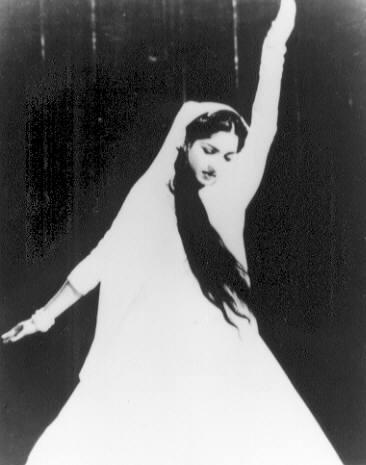
She got Lifetime Achievment Award for her contribution to cinema by Marathi Film Accosiation in 2000.
Her Performances-Teen Batti Chaar Raaste(with Karan Diwan),Jhanak Jhanak Payal Baaje(with Mehipal & Madan Puri),Navrang(with Mehipal),Do Aankhen Barah Haath(with V.Shantaram),Jal Bin Machali Nritiya Bin Bijli(with Abhijeet),Sehra(with Prashant) and Pinjra(with Dr.Shri Ram Lagoo)
Posted by: Reeth Jun 19 2007, 08:27 PM
it may upset kishore fans but i wonder as he married abt four times..
what he was looking for
I guess he did marry four times, but that is his personal choice .......
Posted by: Reeth Jun 19 2007, 08:29 PM
Suchitra Sen(Bengali),Padmini(South) & Sandhya(Marathi) they all were not regular Bollywood Actresses,but they did some fine work in Bollywood too.Sandhya later became part of Hindi films,but there was always gap in her film.Suchitra and Padmini did Hindi Films,when they got something nice to do.Here are biographies of these three Regional Actresses.....
Suchitra Sen

Born in 1931 in Patna,Suchitra Sen was the most popular actress that Bengali Cinema has ever seen. Her beauty and acting talent was just superb.All this gave her a legendary cult status in Bengal.Her debut was in the unreleased Shesh Kothai made in 1952 oppocite Uttam Kumar.They went on to become icons of Bengali romantic melodramas for more than twenty years .She was already a superstar of Bengal,but did good work in Bollywood too.She did not get much success in Bollywood may be because of language problems. Her first Hindi film was Bimal roy s Devdas (1955),she played role of Paro and got critical acclaim for her. Later she did few hindi films Bambai Ka Babu & Musafir but these films could not do well at the box office.Mamta and Aandhi were her two best performances of hindi films.Mamta and Aandhi were her two best performances of hindi films.She retired from the screen in 1978.A devotee of Ramakrishna Mission, Suchitra now immerses herself in meditation and prayer.Her daughter Moon Moon Sen(who is just remembered for exposing) and grand daughters Riya and Raima(both are doing well as comparison to their mother) are all actresses as well.

She got filmfare nomination of best actress award for Mamta and Aandhi.
Suchitra Sen is the first Indian actress awarded in an international film festival. She received the Best Actress award for the movie saat paake bandha in 1963 Moscow film festival.Some of her Bengali films also remaked in Hindi for eg. Khamoshi(Wahida Rehmaan,Dharemndra & Rajesh Khanna) and Kora Kagaj(Vijay Anand,Jaya Bachan).
Her Performances(In Hindi)-Devdas(Dalip K,Vyajantimala),Champakali(with Bharat Bhushan),Musafir(with Dalip K,Kishore K),Mamta(with Ashok K,Dharamendra),Bambai Ka Babu(with Dev Anand),Aandhi(with Sanjeev Kumar) and couple of Bengali films.

Padmini
Born in 1932,Padmini was small time bollywood actress,but she was super star in south and did good work in hindi films too.Her elder sister Lalitha and younger sister Ragini were also renowned film actresses.Padmini had her early education at Mahila Mandiram School and at Sea Shell convent in Thiruvananthapuram. Later she devoted her entire time and energy in pursuing classical dance and has been religiously doing it for the past 64 years.At 14, she became a member of a dance troupe that toured various parts of India. At the age of 17, Padmini became the heroine of the Hindi film "Kalpana," .Later she did films like Jis desh mein ganga behti hai. She then went on to act in Hindi, Tamil, Telugu, Kannada, and Malayalam films.But she nevar did so many films in Hindi.Padmini has acted with all the leading heroes during that age, which include legendary stars like Raj Kapoor, Dev Anand,Rajinder Kumar,Dharamendra,Sivaji Ganesan, MGR, Prem Nazir, and Raj Kumar.She got married to Dr. KT Ramachandran in 1961.Her Mera Naam Joker s one scene create lot of hoo haa. She left the soaring acting career and settled for family life. 1977, she started her own school 'Padmini School of Fine Arts' at the basement of her house in New Jersey with four students.Late film actress Richa Sharma, Sanjay Dutt's wife was one of her students. She is a founder-member of the Hindu Temple Society of North American. She is also associated with many charities.In 1981 her husband died at the age of 48. Their only son Premanand is an official with the Warner Brothers. He acted in one Malayalam movie and produced three documentaries.

She got Filmfare Best Actress Nomination for Jis Desh Mein Ganga Behti Hai and Filmfare Best Supportiung Actress Nomintation for Kaajal and she won the award Kaajal and also won Best actress awards(South) of the Film Fans Association in 1954,'59,'61 and '66.
Her Performances-Kalpana(with Ashok K),Kaajal(with Meena K,Rajkumar,Dharamendra),Jis Desh Mein Ganga Behti Hai(with Raj K),Bhai Behan(with Ashok K,Sunil D,Nutan),Mahabharat(with Pradeep K,Dara Singh),Vaasna(with Rajkumar,Biswajeet),Chanda aur Bijli(with Sanjeev Kumar,Sachin) and Mera Naam Joker(with Raj K,Rajendra K,Dharamendra,Manoj K,Simi,Rishi Kapoor)etc.

Sandhya
Sandhya was Marathi Actress,who later joined Hindi Films in 50s,She is known for her dances in hindi films and song E Malik Tere Bande Hum.She did very few films,but we can consider her most of films as classic.She mostly worked with V.Shantaram,whom she got married later.She was second wife of V.Shantaram.She was different from other actresses from her era,may be that’s coz she was not part of Raj Kapoor kind romance or Bimal roy kinda social films.She got good reviews for Navrang,she was acclaimed for her crossdressing holi song 'are ja re natkhat',where she appeared in both man & woman s role.Her Films were also based on Dance,Romance and Social Issues but they were not typical bollywood flicks.The other reason can be that she was not paired oppocite stars like Raj Kapoor,Daleep Kumar,Dev Anand etc.So she was not in the stage like other actresses.She was even not continuely doing films,most of her films came after litlle gap.In the beginning of 70s she alsmost stopped doing films and started looking after her family.

She got Lifetime Achievment Award for her contribution to cinema by Marathi Film Accosiation in 2000.
Her Performances-Teen Batti Chaar Raaste(with Karan Diwan),Jhanak Jhanak Payal Baaje(with Mehipal & Madan Puri),Navrang(with Mehipal),Do Aankhen Barah Haath(with V.Shantaram),Jal Bin Machali Nritiya Bin Bijli(with Abhijeet),Sehra(with Prashant) and Pinjra(with Dr.Shri Ram Lagoo)
Thanks a lot Jassi ...
Posted by: nasir Jun 19 2007, 08:44 PM
let me know if kishore ever sing for dilip kumar or not
Of course, Dilip Kumar did use Kishore Kumar during the KK wave. This was in Sagina (1974).
The songs that instantly come to my mind are:
SAALA MAI.N TO SAAB BAN GAYA.....
Here KK is joined by Pankaj Mitra who actually has to speak words: e.g. WAH FAKIRA...
The other song which is a duet:
Tumre Sang Rayn Bitaayi Kaha.n Bitaaoo.n Din?
Rayn Ka Sapna Beet Gaya Ab Din Mein Taare Gin...
Then there is the one in which Dilip Kumar has skilfully blended his voice into Kishore's:
KK. OOPER WALA DUKHIYO.N KI NAAHI.N SUNTA RE....
D.K. - SOTA HAI.... BAHUT JAAGA HAI NAA..
Nasir.
Posted by: maheshks Jun 21 2007, 02:05 AM
THE BEAUTIFUL GIRL…..MADHU BALA
It seems both ironic and incongruous that my relationship with the leading lady of Indian cinema in the late 1940s and early 1950s - a relationship that was among the most meaningful in my life, and not only as a film journalist - should have begun on an inauspicious note. For a scene to be shot at China Creek for a Hindi film whose title I cannot now recall, a ban was imposed by Madhubala, or, more correctly, by her formidable father, Khan Ataullah Khan, on film journalists and photographers from visiting that particular set. Hastily, and rather thoughtlessly, the film press responded by imposing a total blackout of Madhubala in the film press. I was appointed, without being consulted, chairman of the blackout committee.
In my considered opinion, then as now, both the ban and the response to it were uncalled for and, worse, ineffective. I told the journalists that the press needed Madhubala as much as Madhubala needed the press. In the dispute, the reaction of her many, many fans was not taken into account. The matter dragged on purposelessly for a couple of months till, one fine morning, Khan Saheb summoned the photographer Ram Aurangbadkar, my right-hand man in Movie Times which I then edited, and told him that the dispute was pointless and, as a gesture of goodwill, invited the film press to a tea party at Madhubala’s residence Arabian Villa in Bandra.
Arabian Villa, a picturesque little cottage in a Bandra side-lane, was one of many such cottages that sprawled all over the suburb in those days. At the villa’s gate, along with the security guards, stood Khan Saheb with a genial smile welcoming us journalists, eight or nine of us. We were taken to a small but elegantly decorated, richly-carpeted, drawing room. Unlike the other filmstar homes I’d visited, not a single portrait of Madhubala adorned the walls.
I hadn’t met Madhubala (her real name was Mumtaz Begum) earlier, but I had seen several of her films and had been impressed by her attractive personality and her obvious budding talent. I wasn’t prepared for the woman I saw slowly descending a curved staircase from the upper floor. It was as if a vision of beauty had achieved form and presence, in a simple white sari and matching sandals, right in front of my eyes, without a touch of make-up. I was so struck that I forgot my manners and didn’t stand up when, before greeting everyone else, she stood before me, her manicured hands together in a namaste.
I struggled to my feet, still feeling dazed, mumbled an apology for not standing up earlier and returned her namaste. With a dazzling smile, showing her pearly white teeth, she put her hands on my shoulders and pressed me down back into my seat. Then she went on to greet my wife and the other guests. My first thought was, “How could the camera have so signally failed to capture that quite extraordinary beauty?” I was to find my answer to that later. I couldn’t take my eyes off her. Her deep brown hair loosened and fell around her shoulders; her complexion I can only describe with the cliché “peaches and cream”. Her eyes were luminous of a light brown, whose shade kept lightening or darkening according to her moods.
But they were the most expressive features on her face. So was her voice, soft and low with a sexy huskiness to it. Then, suddenly, the answer came to me. Her films which I had seen were in black and white. Colour had not then come to Indian cinema. Only colour could do justice to the flush even now glowing on her cheeks. Khan Saheb was holding forth on which films had been hits and which had flopped. There was a lot of discussion on this. Khan Saheb mentioned a particular film in which Madhu, as he called her, had been a big hit. “No doubt,” my wife, who reviewed Hindi films for my paper, said. “But it was a frame by frame copy of an American film.” She named the film. Khan Saheb was taken aback. One could see his mind working on a rebuttal, “Don’t you see, Madam, when someone sets a good example, we follow it. What’s wrong with that?”
He could be quite cynical at times. Khan Saheb was a rather short, thick-set man. A dangerous enemy but, as we were to discover, a wonderful friend. His geniality could not conceal a trace of bitterness in his face, maybe because of the struggles he had faced bringing up his daughters. Madhubala had sisters, too, whom I was to get to know much later. I noticed that his cheeks were flushed. He suffered, I learned, from high blood pressure. It was rumoured that he was the father of eleven children, of whom Madhubala was the fifth.
It was now time for tea. Madhubala carried the tray herself. She brought it to me, questioning me with her eyes, holding up the sugar spoon. “One, please,” I said. She put in one, then holding up the sugar-filled spoon again, looking straight into my eyes, mischievously, tauntingly, she added that one too. As she moved around with the tray, I noticed the spring and suppleness of her movements. There was something startlingly different about her from the other stars I was friendly with, as if she carried an aura about her. It was my first meeting with Madhubala, but somehow it seemed to me that I had known her for a long, long time. Perhaps it was a prescience of things to come.
It was a friendly meeting. Soon, too soon, it was time to leave. The journalists were given a lift home in Madhubala’s Town and Country station wagon. Abad and I had our own car and we were saying goodbye too, when with a concealed gesture of his right hand Khan Saheb indicated that we should stay behind. I had earlier noticed his rather condescending attitude to the others compared to his friendliness, almost humbleness with us. Now he made it obvious.
“I respect you, Mr Karanjia, for two reasons. Movie Times shows courage in fighting our industry’s battles and I respect you personally for bringing dignity to film journalism. That’s all I wanted to tell you.” I felt flattered. He expressed the desire to be in constant touch. We had honoured him by visiting his home and he would reciprocate by visiting ours. He took down our address and both home and office telephone numbers. Then both father and daughter came down to our humble Ambassador to see us off.
As we were driving back to our home in Chowpatty, Abad remarked quite out of the blue, “I think she’s taken a shine to you, Burjor. Better be careful.” “She? You mean him, her father. She hardly spoke a word to me the entire evening. It was he who kept buttering me up. He realises the power of Movie Times. He’s always involved in some controversy or the other and would like to have us on his side, I suppose,” I said.
I was wondering if and when we’d meet again. A couple of days later, I had hardly sat down at my desk to check the proof pages of the next issue when the phone rang. It was Khan Saheb. I could never mistake his high-pitched, rasping voice. He thanked me again for coming to his home and enquired if I was free the next Sunday afternoon at about 4 pm. I said it would be a pleasure to meet him again. I told him that our house stood exactly behind the Orient Club on Chowpatty sea face and we were on the third floor. He said not to worry, he’d find it. He enquired after “Madam” (my wife) and then told me to hold on, Madhu wanted to say hello.
My heart jumped. She also thanked me. I told her how happy I was to have met her and added that I found her more beautiful in person than on the screen. It was my eyes that had made her beautiful, she replied. It sounded like a bit of dialogue from a Hindi film, but it was music to my ears. She asked about my daughter Rutton about whom my wife had spoken to her and expressed a desire to meet her some time.
Our conversations were always bilingual, she spoke to me in Hindi, and I, in English. On the frequent occasions we met, she would try to speak a few sentences in English “for practice,” she said. Well, her English did improve, but my Hindi remained the same. That call made my day. Our relationship wasn’t ended with the meeting at Arabian Villa. I rubbed my hands in glee.
Khan Saheb arrived on the dot, dressed in a cream silk shirt and white trousers, and wearing chappals. “You have a huge house,” he remarked, looking around and adding, “and look at that ceiling, it’s so high, you don’t get houses like this these days. It must be a very old house.” “Yes,” I said, “it was my grandfather’s gift to my mother when she got married. I introduced him to my mother who was sitting at the other end of our drawing room. He bowed to her with deep respect. And when little Rutton came in, all dressed up for the occasion, he fondled her cheeks and drew her close to him and indulged in a bit of child talk.
Over tea we discussed the deteriorating conditions of filmmaking in India, black money pouring in, trade bodies at loggerheads with one another, freelancing filmstars working in several films at the same time, the lack of a strong organisational base and of a film policy worth the name. It became a habit with him to visit us every alternate Sunday afternoon. I grew to like him, even admire him for his deep knowledge of cinema and for the strict discipline he was able to enforce on his daughter which should have set an example to other freewheeling stars. On one occasion I recall, the city was flooded with rains. Transport had come to a standstill. Still Madhubala managed to reach M&T Studios on time, at 9 am, only to learn that the shooting had been cancelled.
One Sunday, to my great joy, Madhubala accompanied her father to our home, carrying a huge box of sweets for Rutton. She became extremely friendly with my wife and, believe it or not, actually played hide-and-seek with Rutton in our 5,000-square-foot flat. The child was still present in the woman I was getting to know. When I came down to the garden to see the star and her dad to their car, I could see neighbours peering from their windows. There was also a small crowd around the car, since in India filmstars are recognised by the cars they own. I sensed that the star’s visit had somehow elevated our status in the neighbourhood.
Madhu — I began to call her that — would often ring me up, seeking my advice on a particular role she didn’t like to play or convey to me some currently raging scandal. One thing she particularly admired in Movie Times and even the monthly “Cinevoice” which I edited was that we never indulged in film gossip. I once told her that while gossip sells, there’s more to selling than gossip as the circulation figures of Movie Times clearly proved. On my weekly studio rounds, I made it a point to include whatever studio she was working in. Whenever she spotted me, her face would light up with a welcoming smile, and as soon as the shot was over she would come to sit with me and order tea for both of us. Our closeness was becoming apparent but it had such a dizzying effect on me that I couldn’t have cared less. We were not doing anything wrong. We let things take their course.
But then, what about the world’s sense of right and wrong? I soon realised the impossibility and, yes, the absurdity of our friendship getting any closer. I was married, and happily too. Abad and Madhu became extremely fond of each other. Madhu’s father had tremendous faith in me and any such “affair” would have shattered him. Above all, I had my own code of honour as editor of a powerful paper — never, ever, mix business with pleasure. I would have been seriously compromised and Madhu even more than me.
In the meantime a crisis was brewing on the office front. For some time, we had been facing financial problems as a direct result of filmdom’s uncertainties. If a film flopped, its producer made that an excuse for not paying for the advertisements he had put in the paper. He would plead with us to be patient till he had his next hit. And in an industry in which there were at least ten flops to each hit, this became a major problem. If we insisted on an immediate payment, we would get a rubber cheque.
The file containing rubber cheques had pride of place as being the thickest among our office files. In desperation, in one or two cases we did file legal suits. But the industry’s ways were so devious, we ended up by losing more money, good money after bad. But let me be fair. There were distributors like K.K. Kapoor, producers like Seth Chandulal Shah and actor-directors like Raj Kapoor who came to our rescue by booking a full year’s advertising in our paper and paying in advance.
But these were in a hopeless minority. There were occasions when we didn’t have the means to bring out the next week’s issue. My financial director, A.M. Kapadia, who also had invested in the paper, threw up his hands in despair. Movie Times was my life; it now appeared that it had been lived in vain. We had finance enough for a couple of months, after which we took the decision, bitter as it was, to close down the publication.
But we had reckoned without Madhubala. One evening my wife and I were having coffee at Bombelli’s, as was our practice, when Ram Aurangabadkar joined us. He looked quite excited, for Movie Times meant as much to him as it did to us. He told us how, meeting Khan Saheb by accident on his studio rounds, he mentioned in passing to Khan Saheb that Movie Times would shortly be closing down and he was shocked. “I will never allow Movie Times to close down,” he said.
He made a tempting offer to Ram that I should produce a film and Madhubala would work free in it. Her price then was Rs two to three lakhs per film, and we could utilise that to carry on. Even as he was telling us this, I recalled how during the “Madhubala ban” days, Khan Saheb had referred to film journalists as kutte (dogs) who devoured the chunks thrown to them by the likes of him. I rejected the offer and Ram, also a man of integrity, agreed with my decision. Besides, the very idea of producing a film seemed preposterous to me.
The very next day Madhubala rang, requesting an urgent meeting with me. I would have invited her to lunch or dinner, as I had done with other stars, but it was out of the question in the case of Madhubala who had never been to a five-star hotel and was a recluse by nature. I felt quite frustrated, when Madhu herself came up with a solution. Her driver would pick me up from home and we’d go for a drive in her Town and Country and talk.
As soon as she saw me, she lowered the burkha she was wearing to her shoulders. Madhu pleaded with me, holding my hand in both hers, to accept her offer. I told her how deeply grateful I was, but that what she was suggesting wouldn’t help in the long run. But she had her answer ready, “I’ll do two pictures, three, as many as you wish, but I want your paper to survive” (after a pause) “so does my father.”
I shook my head and tried to explain that it wasn’t a question of three pictures or thirty, the basic mistake I had made was to launch both my papers in an individual capacity, without any institutional support.
Conditions in the film industry being what they were and with men not respecting their own signatures, we’d go deeper and deeper into loss. I was grateful to her, I’d always be grateful, but as one who cared deeply for her, I couldn’t and wouldn’t allow her money to go down the drain. Did she realise what the film world would make of a filmstar coming to the rescue of a film journalist? It would cause a scandal of unimaginable proportions and would affect her stardom and compromise my integrity.
“If you really cared for me, you wouldn’t insist. You’d try to understand my helplessness,” I said. She fell back into her seat, looking quite forlorn. “What about me, what about our friendship? How am I going to convince my father? He’ll be heartbroken. What are you going to do about your career?” she asked. I assured her as solemnly as I could that we’d always be friends, her friendship and affection meant a lot to me, even more than it did to her.
I’d explain to Khan Saheb when he came next Sunday and I’m sure he’d understand. And as for my work, I had already received the offer of a job as PRO of the vast Godrej enterprise, she need have no worry on that score. She smiled for the first time that evening. A desire to hold her in my arms flared like a fire inside me. With a tremendous effort I subdued it. I don’t recall how many rounds the station wagon made from Chowpatty, up Walkeshwar, across Malabar Hill, round Kemp’s Corner and Hughes Road and then back all over again. We were together for almost an hour. Before getting down at Chowpatty, I told her I wanted to thank her for a great lesson I had learned from our relationship. Her eyes opened in wonder.
“You taught me, dear Madhu, that true love survives the body’s passion. Passion gets spent, love survives and triumphs. And I am doubly glad that I learnt this lesson from one whom I consider the most beautiful woman I’ve met.” She looked down and was silent for a long time. Then quickly, she took my hand to her lips.
Movie Times closed down, not with a whimper but a big bang, with the staging of “Constellation Night”, a star show in aid of charity at which we got Suraiyya to sing on the stage for the first time in her career. Radiant in the first row sat Madhu, next to Dilip Kumar. When, years later in 1961, I was appointed editor of Filmfare, Madhu’s was the first phone call to congratulate me. She said the news made her happier than she had ever been. It proved her faith in me.
Of course Madhu and I continued to be the best of friends. I heard rumours that Dilip Kumar wanted to marry her, but Khan Saheb objected, I’ve no idea why. Then suddenly, I heard that she had married the singer Kishore Kumar. It seemed to me the unlikeliest of marriages, even by Bollywood standards. A couple of years later she fell sick with a heart ailment, for which there apparently was no cure. Khan Saheb took her to London, but her health became worse. She was confined to bed and her shooting days appeared to be over. The film industry forgot her, but I continued to send flowers on her birthday even though she was no longer a star.
I’ve described in my book Counting My Blessings my visit to her, it was my last visit, as she lay dying in Breach Candy Hospital. After considerable persuasion I was allowed to see her for just three minutes. Three minutes after a lifetime of companionship! She couldn’t speak because of tubes in her mouth and nose. But immediately I saw recognition in her eyes and, what particularly cheered me, the remembrance. She held my hand as she had always done and we continued looking into each other’s eyes. She wouldn’t let go off my hand, though the nurse asked me to leave.
I loosened her hand with both mine and bent to kiss her on her pale, moist brow. She gave a deep sigh as if in contentment, and then closed her eyes. My eyes were moist, my features were crumpling as I tiptoed out of the room. Seeing me, the nurse followed me out and put her hand on my shoulder and whispered just one word “Pray!” Madhu died two days later on February 20, 1969. She left me with two regrets. One, that colour had not come to Indian cinema in the heyday of her career. And second, that just a year after her death, I read in the Lancet medical journal that at last a cure had been found for the ailment she suffered.
Fate implacably drives men and women to self-knowledge and an acceptance of their limitations. I spoke earlier of Madhubala giving a meaning to my life. My memory of her is still vibrant. Almost 40 years after her death, the enchantment is still with me. No, she is not lost to me.
By B.K.Karanjia
Posted by: Reeth Jun 21 2007, 02:07 AM
Waheeda Rehman ( Born May 14, 1936 )
Waheeda Rehman is one of the most talented golden era actresses.She is considered to be the
epitome of Classic Indian beauty. She has won the hearts of millions through her elegence
those soulful eyes and acting skills.An actress like Waheeda was complete in herself, however
untrained and unaware she may have been in the fine art of acting.Her finely chiseled features
her expressive eyes and her well-modulated voice were capable of expressing a range of emotions.
Waheeda was born into a traditional muslim family in Hyderabad.She was trained in Kuchupudi and
Bharatanatyam.She lost her father early at the age of 12.....
Her first screen appearance was in a Telugu film Jaisimha(1955) followed by another telugu film
Rojulu Maarayi(1955).....She was spotted by GuruDutt in a song in the latter film and was
offered the role of a vamp in the film CID, directed by Raj Khosla. She lost her mother
soon after.....
After the tremendous success of CID she was given the leading role in Pyaasa(1957)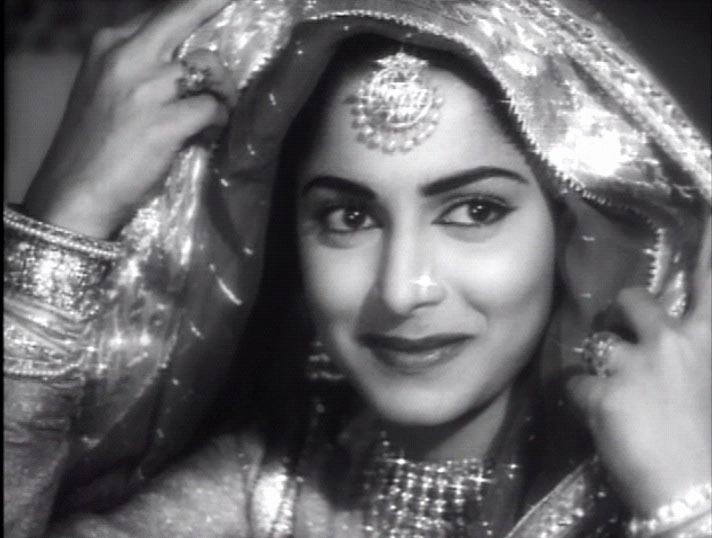
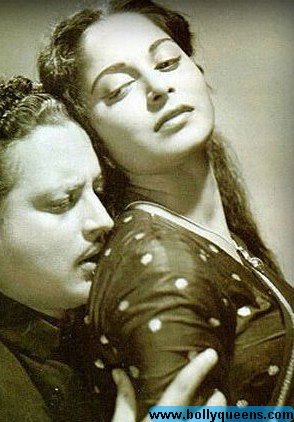
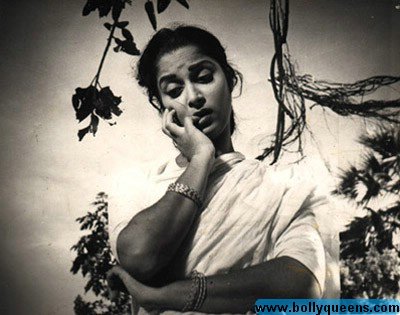
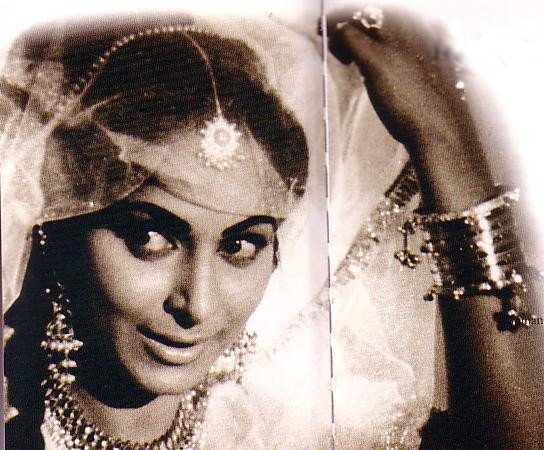
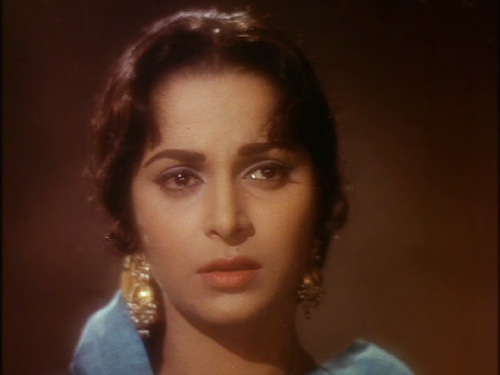
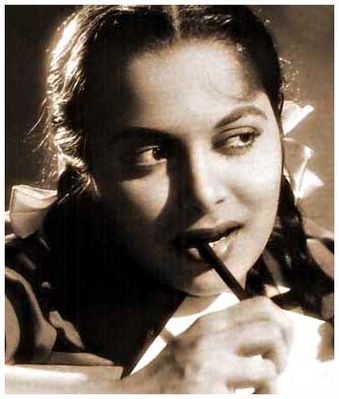
With Pyaasa came success and Waheeda got involved with Guru Dutt, but it was an unsuccessful
love affair and Guru dutt's marital status and her growing success tore them apart. They acted in
four classic movies including Pyaasa.....Chauduvin ka Chand,Sahib bibi aur Ghulam and
the semi autobiographical Kagaz ke phool.........Guru dutt committed suicide in 1964...
Her career continued throughout the 1960's, 1970's and the 80's....She has been paired with most of
the top leading heroes be it Dilip kumar, Raj kapoor or Dev anand.....Guru dutt,Sunil Dutt, Dharmendra,
Pradeep Kumar,Amitabh bachchan,Rajesh Khanna, Manoj kumar,Rajendra kumar,Biswajeet....a long list indeed....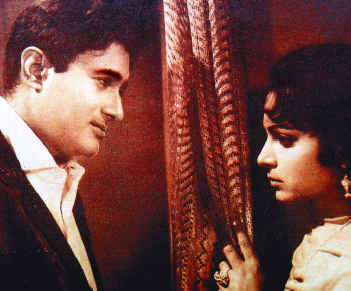
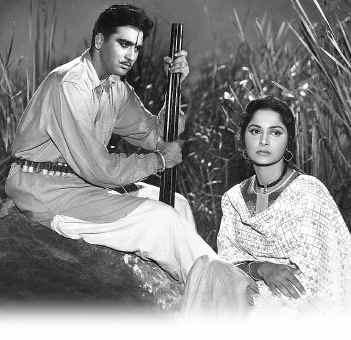
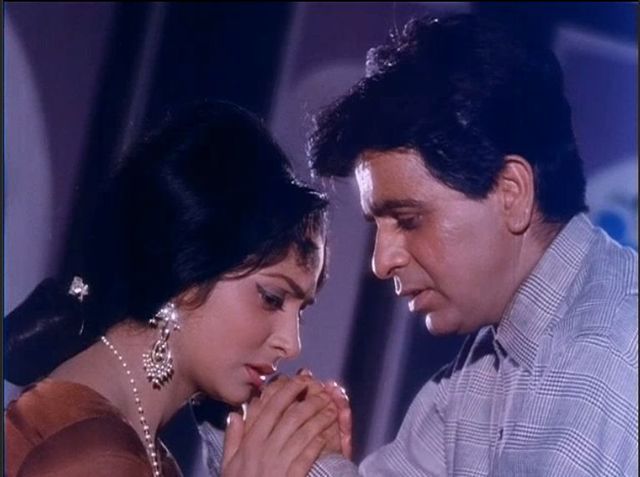


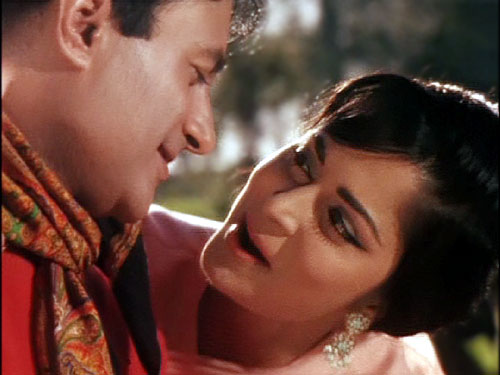
Memorable films...
CID
Pyaasa
Solva saal
Sahib bibi aur ghulam
Kagaz ke phool
Kala bazar
Roop ki rani chorn ka raja
Chauduvin ka chand
Bees saal baad
baat ek raat ki
Ek phool char kaante
Kohra
Guide
Teesri kasam
Ram aur shyam
Dil diya dard liya
Patthar ke sanam
Palkhi
Aadmi
Shagun
Neel kamal
Khamoshi
Kabhi khabhi
Trishul.....
Impressive collection of films....
She won the Filmfare best actress award for her role in Guide (1965) and neel Kamal ( 1968)...
She has won the Lifetime Achievement award in the year 1995 and The special award for
'Invaluable Contribution to the Indian Cinema' in 2001....
Waheeda Rehman married Kamaljeet (who was her costar in Shagun) on April 27 1974 and
after her marriage she shifted to Bangalore and concenterated on raising her family,occassionally
acting in some quality films .
She has two children, son Sohail and daughter Kashvi.....Her husband Kamaljeet died on November
21,2000 following a prolonged illness....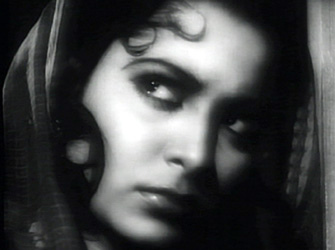
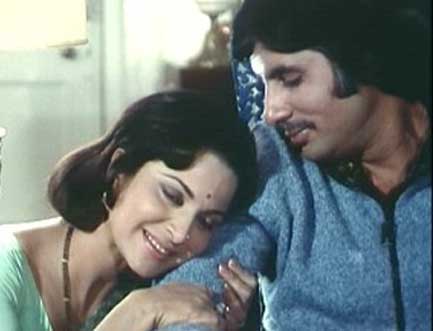
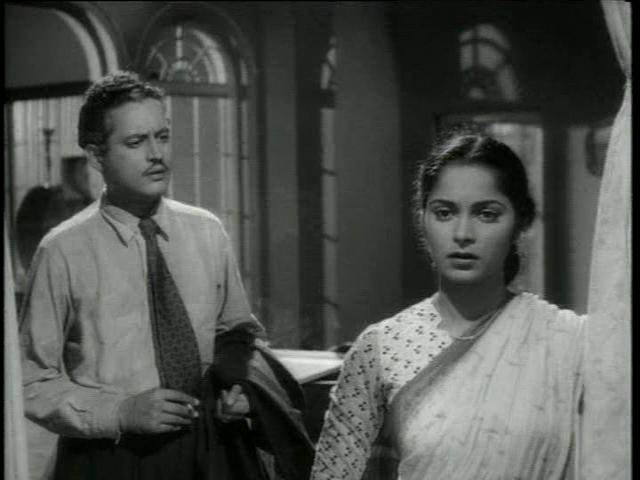
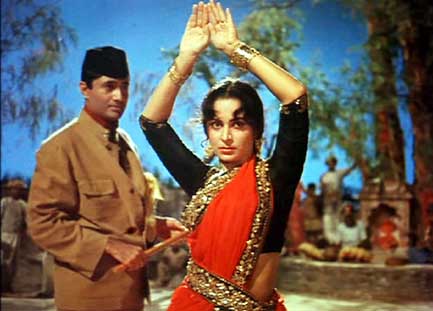
Waheeda Rehman has settled down in Bangalore where she is involved in a business venture
marketing her own brand of breakfast cereals and leads a contented life in her farm house.
Waheeda Rehman combined the classic Islamic beauty with an extraordinary grace, talent and a
truly transcendent appeal that ranked her among the Pantheon of Bollywood's elite actresses...
Attached image(s)
Posted by: Reeth Jun 21 2007, 02:14 AM
THE BEAUTIFUL GIRL…..MADHU BALA
It seems both ironic and incongruous that my relationship with the leading lady of Indian cinema in the late 1940s and early 1950s - a relationship that was among the most meaningful in my life, and not only as a film journalist - should have begun on an inauspicious note. For a scene to be shot at China Creek for a Hindi film whose title I cannot now recall, a ban was imposed by Madhubala, or, more correctly, by her formidable father, Khan Ataullah Khan, on film journalists and photographers from visiting that particular set. Hastily, and rather thoughtlessly, the film press responded by imposing a total blackout of Madhubala in the film press. I was appointed, without being consulted, chairman of the blackout committee.
In my considered opinion, then as now, both the ban and the response to it were uncalled for and, worse, ineffective. I told the journalists that the press needed Madhubala as much as Madhubala needed the press. In the dispute, the reaction of her many, many fans was not taken into account. The matter dragged on purposelessly for a couple of months till, one fine morning, Khan Saheb summoned the photographer Ram Aurangbadkar, my right-hand man in Movie Times which I then edited, and told him that the dispute was pointless and, as a gesture of goodwill, invited the film press to a tea party at Madhubala’s residence Arabian Villa in Bandra.
Arabian Villa, a picturesque little cottage in a Bandra side-lane, was one of many such cottages that sprawled all over the suburb in those days. At the villa’s gate, along with the security guards, stood Khan Saheb with a genial smile welcoming us journalists, eight or nine of us. We were taken to a small but elegantly decorated, richly-carpeted, drawing room. Unlike the other filmstar homes I’d visited, not a single portrait of Madhubala adorned the walls.
I hadn’t met Madhubala (her real name was Mumtaz Begum) earlier, but I had seen several of her films and had been impressed by her attractive personality and her obvious budding talent. I wasn’t prepared for the woman I saw slowly descending a curved staircase from the upper floor. It was as if a vision of beauty had achieved form and presence, in a simple white sari and matching sandals, right in front of my eyes, without a touch of make-up. I was so struck that I forgot my manners and didn’t stand up when, before greeting everyone else, she stood before me, her manicured hands together in a namaste.
I struggled to my feet, still feeling dazed, mumbled an apology for not standing up earlier and returned her namaste. With a dazzling smile, showing her pearly white teeth, she put her hands on my shoulders and pressed me down back into my seat. Then she went on to greet my wife and the other guests. My first thought was, “How could the camera have so signally failed to capture that quite extraordinary beauty?” I was to find my answer to that later. I couldn’t take my eyes off her. Her deep brown hair loosened and fell around her shoulders; her complexion I can only describe with the cliché “peaches and cream”. Her eyes were luminous of a light brown, whose shade kept lightening or darkening according to her moods.
But they were the most expressive features on her face. So was her voice, soft and low with a sexy huskiness to it. Then, suddenly, the answer came to me. Her films which I had seen were in black and white. Colour had not then come to Indian cinema. Only colour could do justice to the flush even now glowing on her cheeks. Khan Saheb was holding forth on which films had been hits and which had flopped. There was a lot of discussion on this. Khan Saheb mentioned a particular film in which Madhu, as he called her, had been a big hit. “No doubt,” my wife, who reviewed Hindi films for my paper, said. “But it was a frame by frame copy of an American film.” She named the film. Khan Saheb was taken aback. One could see his mind working on a rebuttal, “Don’t you see, Madam, when someone sets a good example, we follow it. What’s wrong with that?”
He could be quite cynical at times. Khan Saheb was a rather short, thick-set man. A dangerous enemy but, as we were to discover, a wonderful friend. His geniality could not conceal a trace of bitterness in his face, maybe because of the struggles he had faced bringing up his daughters. Madhubala had sisters, too, whom I was to get to know much later. I noticed that his cheeks were flushed. He suffered, I learned, from high blood pressure. It was rumoured that he was the father of eleven children, of whom Madhubala was the fifth.
It was now time for tea. Madhubala carried the tray herself. She brought it to me, questioning me with her eyes, holding up the sugar spoon. “One, please,” I said. She put in one, then holding up the sugar-filled spoon again, looking straight into my eyes, mischievously, tauntingly, she added that one too. As she moved around with the tray, I noticed the spring and suppleness of her movements. There was something startlingly different about her from the other stars I was friendly with, as if she carried an aura about her. It was my first meeting with Madhubala, but somehow it seemed to me that I had known her for a long, long time. Perhaps it was a prescience of things to come.
It was a friendly meeting. Soon, too soon, it was time to leave. The journalists were given a lift home in Madhubala’s Town and Country station wagon. Abad and I had our own car and we were saying goodbye too, when with a concealed gesture of his right hand Khan Saheb indicated that we should stay behind. I had earlier noticed his rather condescending attitude to the others compared to his friendliness, almost humbleness with us. Now he made it obvious.
“I respect you, Mr Karanjia, for two reasons. Movie Times shows courage in fighting our industry’s battles and I respect you personally for bringing dignity to film journalism. That’s all I wanted to tell you.” I felt flattered. He expressed the desire to be in constant touch. We had honoured him by visiting his home and he would reciprocate by visiting ours. He took down our address and both home and office telephone numbers. Then both father and daughter came down to our humble Ambassador to see us off.
As we were driving back to our home in Chowpatty, Abad remarked quite out of the blue, “I think she’s taken a shine to you, Burjor. Better be careful.” “She? You mean him, her father. She hardly spoke a word to me the entire evening. It was he who kept buttering me up. He realises the power of Movie Times. He’s always involved in some controversy or the other and would like to have us on his side, I suppose,” I said.
I was wondering if and when we’d meet again. A couple of days later, I had hardly sat down at my desk to check the proof pages of the next issue when the phone rang. It was Khan Saheb. I could never mistake his high-pitched, rasping voice. He thanked me again for coming to his home and enquired if I was free the next Sunday afternoon at about 4 pm. I said it would be a pleasure to meet him again. I told him that our house stood exactly behind the Orient Club on Chowpatty sea face and we were on the third floor. He said not to worry, he’d find it. He enquired after “Madam” (my wife) and then told me to hold on, Madhu wanted to say hello.
My heart jumped. She also thanked me. I told her how happy I was to have met her and added that I found her more beautiful in person than on the screen. It was my eyes that had made her beautiful, she replied. It sounded like a bit of dialogue from a Hindi film, but it was music to my ears. She asked about my daughter Rutton about whom my wife had spoken to her and expressed a desire to meet her some time.
Our conversations were always bilingual, she spoke to me in Hindi, and I, in English. On the frequent occasions we met, she would try to speak a few sentences in English “for practice,” she said. Well, her English did improve, but my Hindi remained the same. That call made my day. Our relationship wasn’t ended with the meeting at Arabian Villa. I rubbed my hands in glee.
Khan Saheb arrived on the dot, dressed in a cream silk shirt and white trousers, and wearing chappals. “You have a huge house,” he remarked, looking around and adding, “and look at that ceiling, it’s so high, you don’t get houses like this these days. It must be a very old house.” “Yes,” I said, “it was my grandfather’s gift to my mother when she got married. I introduced him to my mother who was sitting at the other end of our drawing room. He bowed to her with deep respect. And when little Rutton came in, all dressed up for the occasion, he fondled her cheeks and drew her close to him and indulged in a bit of child talk.
Over tea we discussed the deteriorating conditions of filmmaking in India, black money pouring in, trade bodies at loggerheads with one another, freelancing filmstars working in several films at the same time, the lack of a strong organisational base and of a film policy worth the name. It became a habit with him to visit us every alternate Sunday afternoon. I grew to like him, even admire him for his deep knowledge of cinema and for the strict discipline he was able to enforce on his daughter which should have set an example to other freewheeling stars. On one occasion I recall, the city was flooded with rains. Transport had come to a standstill. Still Madhubala managed to reach M&T Studios on time, at 9 am, only to learn that the shooting had been cancelled.
One Sunday, to my great joy, Madhubala accompanied her father to our home, carrying a huge box of sweets for Rutton. She became extremely friendly with my wife and, believe it or not, actually played hide-and-seek with Rutton in our 5,000-square-foot flat. The child was still present in the woman I was getting to know. When I came down to the garden to see the star and her dad to their car, I could see neighbours peering from their windows. There was also a small crowd around the car, since in India filmstars are recognised by the cars they own. I sensed that the star’s visit had somehow elevated our status in the neighbourhood.
Madhu — I began to call her that — would often ring me up, seeking my advice on a particular role she didn’t like to play or convey to me some currently raging scandal. One thing she particularly admired in Movie Times and even the monthly “Cinevoice” which I edited was that we never indulged in film gossip. I once told her that while gossip sells, there’s more to selling than gossip as the circulation figures of Movie Times clearly proved. On my weekly studio rounds, I made it a point to include whatever studio she was working in. Whenever she spotted me, her face would light up with a welcoming smile, and as soon as the shot was over she would come to sit with me and order tea for both of us. Our closeness was becoming apparent but it had such a dizzying effect on me that I couldn’t have cared less. We were not doing anything wrong. We let things take their course.
But then, what about the world’s sense of right and wrong? I soon realised the impossibility and, yes, the absurdity of our friendship getting any closer. I was married, and happily too. Abad and Madhu became extremely fond of each other. Madhu’s father had tremendous faith in me and any such “affair” would have shattered him. Above all, I had my own code of honour as editor of a powerful paper — never, ever, mix business with pleasure. I would have been seriously compromised and Madhu even more than me.
In the meantime a crisis was brewing on the office front. For some time, we had been facing financial problems as a direct result of filmdom’s uncertainties. If a film flopped, its producer made that an excuse for not paying for the advertisements he had put in the paper. He would plead with us to be patient till he had his next hit. And in an industry in which there were at least ten flops to each hit, this became a major problem. If we insisted on an immediate payment, we would get a rubber cheque.
The file containing rubber cheques had pride of place as being the thickest among our office files. In desperation, in one or two cases we did file legal suits. But the industry’s ways were so devious, we ended up by losing more money, good money after bad. But let me be fair. There were distributors like K.K. Kapoor, producers like Seth Chandulal Shah and actor-directors like Raj Kapoor who came to our rescue by booking a full year’s advertising in our paper and paying in advance.
But these were in a hopeless minority. There were occasions when we didn’t have the means to bring out the next week’s issue. My financial director, A.M. Kapadia, who also had invested in the paper, threw up his hands in despair. Movie Times was my life; it now appeared that it had been lived in vain. We had finance enough for a couple of months, after which we took the decision, bitter as it was, to close down the publication.
But we had reckoned without Madhubala. One evening my wife and I were having coffee at Bombelli’s, as was our practice, when Ram Aurangabadkar joined us. He looked quite excited, for Movie Times meant as much to him as it did to us. He told us how, meeting Khan Saheb by accident on his studio rounds, he mentioned in passing to Khan Saheb that Movie Times would shortly be closing down and he was shocked. “I will never allow Movie Times to close down,” he said.
He made a tempting offer to Ram that I should produce a film and Madhubala would work free in it. Her price then was Rs two to three lakhs per film, and we could utilise that to carry on. Even as he was telling us this, I recalled how during the “Madhubala ban” days, Khan Saheb had referred to film journalists as kutte (dogs) who devoured the chunks thrown to them by the likes of him. I rejected the offer and Ram, also a man of integrity, agreed with my decision. Besides, the very idea of producing a film seemed preposterous to me.
The very next day Madhubala rang, requesting an urgent meeting with me. I would have invited her to lunch or dinner, as I had done with other stars, but it was out of the question in the case of Madhubala who had never been to a five-star hotel and was a recluse by nature. I felt quite frustrated, when Madhu herself came up with a solution. Her driver would pick me up from home and we’d go for a drive in her Town and Country and talk.
As soon as she saw me, she lowered the burkha she was wearing to her shoulders. Madhu pleaded with me, holding my hand in both hers, to accept her offer. I told her how deeply grateful I was, but that what she was suggesting wouldn’t help in the long run. But she had her answer ready, “I’ll do two pictures, three, as many as you wish, but I want your paper to survive” (after a pause) “so does my father.”
I shook my head and tried to explain that it wasn’t a question of three pictures or thirty, the basic mistake I had made was to launch both my papers in an individual capacity, without any institutional support.
Conditions in the film industry being what they were and with men not respecting their own signatures, we’d go deeper and deeper into loss. I was grateful to her, I’d always be grateful, but as one who cared deeply for her, I couldn’t and wouldn’t allow her money to go down the drain. Did she realise what the film world would make of a filmstar coming to the rescue of a film journalist? It would cause a scandal of unimaginable proportions and would affect her stardom and compromise my integrity.
“If you really cared for me, you wouldn’t insist. You’d try to understand my helplessness,” I said. She fell back into her seat, looking quite forlorn. “What about me, what about our friendship? How am I going to convince my father? He’ll be heartbroken. What are you going to do about your career?” she asked. I assured her as solemnly as I could that we’d always be friends, her friendship and affection meant a lot to me, even more than it did to her.
I’d explain to Khan Saheb when he came next Sunday and I’m sure he’d understand. And as for my work, I had already received the offer of a job as PRO of the vast Godrej enterprise, she need have no worry on that score. She smiled for the first time that evening. A desire to hold her in my arms flared like a fire inside me. With a tremendous effort I subdued it. I don’t recall how many rounds the station wagon made from Chowpatty, up Walkeshwar, across Malabar Hill, round Kemp’s Corner and Hughes Road and then back all over again. We were together for almost an hour. Before getting down at Chowpatty, I told her I wanted to thank her for a great lesson I had learned from our relationship. Her eyes opened in wonder.
“You taught me, dear Madhu, that true love survives the body’s passion. Passion gets spent, love survives and triumphs. And I am doubly glad that I learnt this lesson from one whom I consider the most beautiful woman I’ve met.” She looked down and was silent for a long time. Then quickly, she took my hand to her lips.
Movie Times closed down, not with a whimper but a big bang, with the staging of “Constellation Night”, a star show in aid of charity at which we got Suraiyya to sing on the stage for the first time in her career. Radiant in the first row sat Madhu, next to Dilip Kumar. When, years later in 1961, I was appointed editor of Filmfare, Madhu’s was the first phone call to congratulate me. She said the news made her happier than she had ever been. It proved her faith in me.
Of course Madhu and I continued to be the best of friends. I heard rumours that Dilip Kumar wanted to marry her, but Khan Saheb objected, I’ve no idea why. Then suddenly, I heard that she had married the singer Kishore Kumar. It seemed to me the unlikeliest of marriages, even by Bollywood standards. A couple of years later she fell sick with a heart ailment, for which there apparently was no cure. Khan Saheb took her to London, but her health became worse. She was confined to bed and her shooting days appeared to be over. The film industry forgot her, but I continued to send flowers on her birthday even though she was no longer a star.
I’ve described in my book Counting My Blessings my visit to her, it was my last visit, as she lay dying in Breach Candy Hospital. After considerable persuasion I was allowed to see her for just three minutes. Three minutes after a lifetime of companionship! She couldn’t speak because of tubes in her mouth and nose. But immediately I saw recognition in her eyes and, what particularly cheered me, the remembrance. She held my hand as she had always done and we continued looking into each other’s eyes. She wouldn’t let go off my hand, though the nurse asked me to leave.
I loosened her hand with both mine and bent to kiss her on her pale, moist brow. She gave a deep sigh as if in contentment, and then closed her eyes. My eyes were moist, my features were crumpling as I tiptoed out of the room. Seeing me, the nurse followed me out and put her hand on my shoulder and whispered just one word “Pray!” Madhu died two days later on February 20, 1969. She left me with two regrets. One, that colour had not come to Indian cinema in the heyday of her career. And second, that just a year after her death, I read in the Lancet medical journal that at last a cure had been found for the ailment she suffered.
Fate implacably drives men and women to self-knowledge and an acceptance of their limitations. I spoke earlier of Madhubala giving a meaning to my life. My memory of her is still vibrant. Almost 40 years after her death, the enchantment is still with me. No, she is not lost to me.
By B.K.Karanjia
Great article mahesh
Posted by: noorie Jun 21 2007, 02:22 AM
I wonder if all that is true. Why wud Madhu be interested in him ( a married man )?
Noorie
Posted by: jassi Jun 21 2007, 05:37 PM
profiles of actresses should be post in the way they made their debut,i think it was little early to post waheeda's profile before nutan,meena kumari and vyajantimala..i guess we have yet to gone through nargis profile
Posted by: jassi Jun 21 2007, 06:00 PM
50s was an era of Stardom,in 50s actors got more stardom as comparing to 20s,30s & 40s stars.Nargis,Madhubala,Meena Kumari and Geeta Bali were reknown faces of 50s.Actresses of 40s like Suraiya,Nirupa Roy,Kamini Kaoshal were also doing well.Nutan,Vyjayantimala & Waheeda Rehman got stardom in mid of 50s.
Beena Roy,Nimmi,Sandhya,Geeta Dutt,Shakila,Nadira,Kalpana Kartik,Shyama,Kumkum,Shashikala etc were another actresses of that era,who got stardom.Cuckoo,Kuldeep Kaur and Nigar Sultana were doing supporting roles like Vamp,Comic roles etc.Some of 20s and 30s actresses started playing character roles like Sulochana,Lalita Pawar,Durga Khote,Leela Chitnis etc.They also did lead roles in small films.Mala Sinha and Nanda became esteblish actresses in last of 50s.Padmini(South) and Suchitra Sen(Bengali) were not regular bollywood actresses,but they did some performance oriented roles in Bollywood too.
Posted by: jassi Jun 21 2007, 06:08 PM
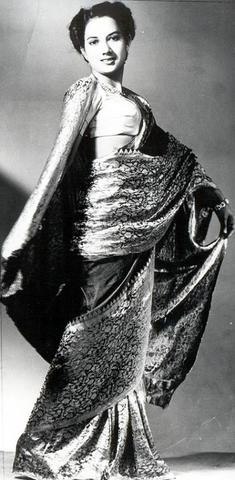
Shakila-She made debut with Suraiya,Karan Diwan starring Duniya in 1949.Soon she got some supporting roles and after that got chance to play leading lady.Dataan,Duniya,Jhansi Ki Rani,Hatimtai,Aar Paar,C.I.D,Begunah etc were her reknown films.Later she played supporting roles in some movies.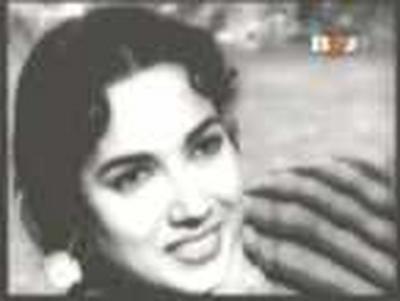

Shyama-She made debut in 1949 with Dev Anand,Suraiya starring Shair.Soon she got leading roles,She did not get much scope,but supporting roles helped her.Tarana,Shair,Patanga,Saza,Aasmaan,Aar Paar,Bhai Bhai,Hill Station,Choti Behan,Shardha etc were her main films.She got Filmfare Best Supporting Actress Award for Shardha(1957).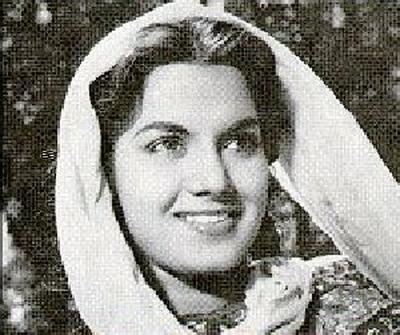
i have no information where they are now
Posted by: jassi Jun 21 2007, 06:18 PM

Kumkum-She made debut with Bharat Bhushan,Suraiya starrer Mirza Ghalib in 1954.She was having little role.Soon she got some supporting roles,where she got do something.She got noticed in Basant Bahar.She got lot of hits,but somewhere she did not get much attention as an actress.Later she got films like Mother India,Funtoosh,Dil bhi tera hum bhi tere,Mr and Mrs 55,Mr X in Bombay,Kohinoor,Raja Aur Runk,Geet,Aankhen,Lalkaar etc.Mehboob Khan's Son Of India turned out of big flop,one of her most big project as leading lady.She was even going well in 60s and early 70s.Few Years back she was given lifetime achievement award by Bhojpuri Cinema(i have no idea if she was part of bhojpuri films,may be she might have done few films with Sujit Kumar).Recently got special award during Dada Saheb Falke Awards.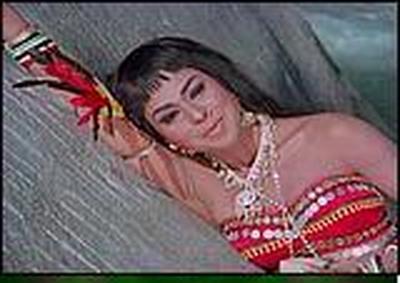
Posted by: YaarMere Jun 21 2007, 07:36 PM
Lets talk abt Priya Rajvansh, she was well fine looking... well she was in Hanste Zakhm.
Posted by: jassi Jun 21 2007, 07:45 PM
i will talk abt her,but its humble request from me
plz lets first finish profiles of 50s actresses...than we will move to 60s..
Posted by: nasir Jun 21 2007, 10:41 PM
Regarding Shakila, I was fortunate to attend her wedding held at the Mahalaxmi Race Course in Bombay. She was a student of Arabic and learnt from a Maulana who was our tenant. (Reeth will remember I mentioned this Maulana in the topic of Ghosts....) It was a grand wedding after which Shakila stopped working in movies.
Shakila had that something which is called "Namak" in hindustani. I loved her fairy's role in HATIM TAI, (1957) which till today is the best among all the Hatim Tai movies.
NASIR.
Posted by: noorie Jun 21 2007, 11:11 PM
Lets talk abt Priya Rajvansh, she was well fine looking... well she was in Hanste Zakhm.
Hers is a sad story.
She was a victim of murder; the two sons of her late partner Chetan Anand ( with whom she had a live-in relationship ) were found guilty of the crime.
There was a trial, and they served time in prison for a while, last I heard they are out on parole.
Poor Priya, who wud have thought she wud meet such a gory end.
Noorie
Posted by: Reeth Jun 22 2007, 02:45 PM
profiles of actresses should be post in the way they made their debut,i think it was little early to post waheeda's profile before nutan,meena kumari and vyajantimala..i guess we have yet to gone through nargis profile
Jassi Nargis and Meena Kumari have already been covered.....Nutan and Vyjayantimala come after Waheeda Rehman(going by their dob)...
Thanks a lot for all those writeups and pics about Shakila , Shama and Kum kum.........they definitely deserve to be mentioned....
Posted by: Reeth Jun 22 2007, 02:48 PM
Regarding Shakila, I was fortunate to attend her wedding held at the Mahalaxmi Race Course in Bombay. She was a student of Arabic and learnt from a Maulana who was our tenant. (Reeth will remember I mentioned this Maulana in the topic of Ghosts....) It was a grand wedding after which Shakila stopped working in movies.
Shakila had that something which is called "Namak" in hindustani. I loved her fairy's role in HATIM TAI, (1957) which till today is the best among all the Hatim Tai movies.
NASIR.
I lkied her dancing to Geeta's 'Hoon abhi mein jawan yeh dil... and Ankhon ki aankhon mein ishara ho gaya......and yes ,she had a certain kind of charm
Posted by: Reeth Jun 22 2007, 02:50 PM
Lets talk abt Priya Rajvansh, she was well fine looking... well she was in Hanste Zakhm.
Hers is a sad story.
She was a victim of murder; the two sons of her late partner Chetan Anand ( with whom she had a live-in relationship ) were found guilty of the crime.
There was a trial, and they served time in prison for a while, last I heard they are out on parole.
Poor Priya, who wud have thought she wud meet such a gory end.
Noorie
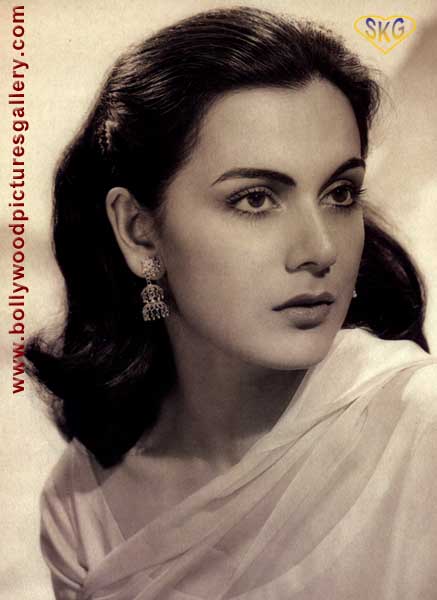
Priya led an enigmatic life. For one, she was perhaps the only heroine educated in London, at a time when most of the leading ladies were hardly literate! After her debut film 'Haqeeqat', her professional and personal life were so intricately fused that it became difficult to seperate one from the other. She only starred in seven films in her entire career and all of them were directed by Chetan Anand. He went on to become her friend, philosopher and guide. Priya remained faithful to him till his death recently. And became a recluse. However the personal rapport between Chetan Anand and Priya Rajvansh could not crystallize into memorable performances from the latter. Whether it was the Heer of Heer Ranjha, the call girl of 'Hanste Zakhm' or the modern day Cinderella of Sahib Bahadur, Priya remained glacial, in all of them! Priya Rajvansh, however will be remembered for some of the most melodious Lata Mangeshkar solos tuned by Madan Mohan and picturised on her. .....
Posted by: jassi Jun 22 2007, 03:44 PM
i ll have to check previous pages,how i can miss it...
well nutan,vyjantimala and waheeda all three were born in same year 1936,i was not knowing abt date of birth..but if we go by debut it was nutan who made her debut in 1951 and vyajantimala in 1953 and waheeda in 1955-56
i was just knowing abt kumkum,shayma and shakeela's proffessional life,someone update abt their personal life too
thanks reeth for encouraging words
Posted by: YaarMere Jun 22 2007, 03:50 PM
Lets talk abt Priya Rajvansh, she was well fine looking... well she was in Hanste Zakhm.
Hers is a sad story.
She was a victim of murder; the two sons of her late partner Chetan Anand ( with whom she had a live-in relationship ) were found guilty of the crime.
There was a trial, and they served time in prison for a while, last I heard they are out on parole.
Poor Priya, who wud have thought she wud meet such a gory end.
Noorie

Why was she killed? You dont kill sum1 who looks like that, thatz just wrong!
Posted by: noorie Jun 22 2007, 08:38 PM
Lets talk abt Priya Rajvansh, she was well fine looking... well she was in Hanste Zakhm.
Hers is a sad story.
She was a victim of murder; the two sons of her late partner Chetan Anand ( with whom she had a live-in relationship ) were found guilty of the crime.
There was a trial, and they served time in prison for a while, last I heard they are out on parole.
Poor Priya, who wud have thought she wud meet such a gory end.
Noorie

Why was she killed? You dont kill sum1 who looks like that, thatz just wrong!
She was caught in the middle of a sordid property tussle; she wished to sell off the bungalow that was willed to her by Chetan Anand; apparently this didn’t go down very well with his two sons by his first wife.
They hatched a plot to dispose off her for good, and were very successful; fortunately for us the law caught up with them, and put them behind bars.
They wud still be in there, if it hadn’t been 4 the rotten legal system in India.
This article has a lot on her life with Chetan Anand; very interesting.
Remembering Priya Rajvansh
-Sharmila Taliculam
http://www.rediff.com/entertai/2000/apr/08priya.htm
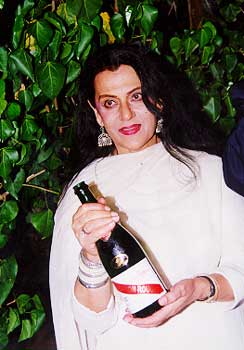
Nothing, at the present moment, has caught the industry's imagination as much as the gruesome tale of the murder of yesteryear actress, Priya Rajvansh. And the horrifying knowledge that the alleged suspects are Chetan Anand's sons.
But a few months ago, nobody even remembered Priya Rajvansh. She was as good as forgotten by the industry and its people. For those whose memory went that far back, she was just a heroine that film-maker Chetan Anand, Dev Anand's elder brother, was fascinated with and lived in with.
But their lifestyle did not generate much gossip. They made very few films and never really partied much. They kept to themselves of the most time and interacted with only a few close friends. They preferred to invite friends over to their shack and have a few drinks and discuss poetry, politics, books, etc. Amit Khanna, CEO, Plus Channel, who had known the couple since 1971, says, "The evenings in their shack were very stimulating."
Priya came to India from London, where her father was deputed as a forest conservator by the United Nations. She had studied acting at the Royal Academy of Dramatics. Chetan, who was on the lookout for a new heroine for his film Haqeekat, spotted her a friend's place and immediately signed her on.
"They became very close during the making of the film. Chetansaab had just gone through a divorce and Priya was alone here. They both were lonely and that, I think, is what brought them together in the first place," says Hasan Kamaal, writer and lyricist, who worked with Chetan on Haathon Ki Lakheeren (1982) and the television serial, Paramveer Chakra.
Priya was 20 years younger than Chetan, a fact that obviously didn't bother either of them. "Chetansaab was her mentor. He introduced her to the film industry. Priya was totally dedicated to him. Whatever relationship they had, everybody knew about it. We also accepted it. We never thought about it ever. It was a decent relationship and they both liked each other," says Kamaal.
"Priya and Chetan had a very good relationship," adds Khanna. "She was the gregarious one, he was very reticent. Despite that, they liked each other a lot. Priya was completely dedicated to him."
Priya's dependence on Chetan was not just mental and emotional, there are strong indications that it could have been financial as well. "When Chetansaab was alive, he saw to it that she was well looked after. Perhaps, if he had married her, the situation would have been different today because she would have more legal powers," says Kamaal.
Priya and Chetan never thought of marriage. Even if they did, it probably didn't affect their relationship. They were happy with each other. "Priya and Chetansaab never discussed their relationship. I don't know why they never married and, frankly, I never thought of asking them. It never mattered," says Khanna.
"As far as I know, Priya was happy with the way things were going. She never talked about marriage. Chetansaab didn't want to marry, maybe because of the kids and his previous marriage, which had gone sour," says Kamaal.
"I remember we used to tell Priya she must do something for herself and not be involved so much with the man she loved. She would only reply that she couldn't see beyond Chetansaab at all. She was completely devoted to him and, finally, it didn't matter because they really behaved like husband and wife. Only, they didn't have the tag of 'being married.' We accepted this. We found nothing unusual in their relationship as such."
The usual fights and arguments were generally considered normal, they would have happened even if the two were married. The only difference was the fact that Priya lived separately. She had her own flat first in Kalumal Estate and, later, a bigger house in Mangal Kiran. She would go over to Chetan's house twice a day, for lunch and in the evenings for about three or four hours.
"That was when she would call and invite us over for drinks and conversation. They would behave like any married couple. They had their share of fights and arguments. They would also discuss their likes and dislikes. We never thought it was something different because we accepted them as a couple," says Kamaal.
They were so dedicated to each other that Priya never thought of acting in anyone else's films. Chetan, too, never made a film without her as the central character. She probably had offers, but she never accepted them. She never gave any reasons why she did that.
"She did tell me she had got some offers. But she never really explained why she didn't take them up. Maybe Chetansaab didn't want her to. Maybe, she didn't feel like it. The fact is, she was involved in every aspect of Chetansaab's films. Right from scripts to story to lyrics to postproduction. It wasn't as if she didn't have anything to do at all. She contributed a lot professionally and personally," says Kamaal.
Even Chetan's family, including his two brothers, their families and his two children, had accepted her.
Since she was so involved with a man who was so much older to her, Priya never gave a thought to herself. She never even thought about having an income of her own. Apparently, she never gave any thought to what life would be like after Chetan Anand. That, probably, could be why she became very lonely after his death.
According to Khanna, though she was lonely, she had her circle of friends whom she kept in touch with on a regular basis. Kamaal disagrees. "The people who would drop in when Chetansaab was alive didn't come over anymore. Even though we would go over sometimes, the frequency of our visits decreased. She even contemplated going back to Chandigarh because she felt she had nothing left after Chetansaab. She had a beautiful bungalow there and she wanted to settle down. But we would discourage her, saying she didn't have anybody there and she would be very lonely. At least she had us here, to call and chat with whenever she wanted."
Since she never acted in any other films and never thought of doing films after Chetan's death, Priya was not very well off financially. Kamaal says she wanted to sell the bungalow because she thought the resultant money would assure her of a decent living for the rest of her life.
"She did mention she had arguments about the property with Chetansaab's sons, but she put it in such a manner that we thought it was regular thing and it would get solved soon. We never thought it would take such a dramatic and violent turn," says Kamaal.
"She would mention them in such a manner that we would think these things happen everywhere. She never gave us a chance to seriously worry about her situation. Like she would say that her servant would be rude to her, but then again we thought it was something which was quite ordinary."
Priya was known in the industry for her grace and style. She was looked upon as a very civilised and cultured person. "Never has she spoken a harsh word against anybody. Or been rude to anyone. So this death has shocked me and everybody who knew her."
Priya was murdered in the same bungalow and the culprits are suspected to be Chetan's sons, Ketan and Vivek. "The whole thing baffles me because I know the boys well and logic tells me there is something more to this than meets the eye. Both the boys wouldn't do such a ridiculous thing," says Khanna.
Again, Kamaal disagrees. "I have no reason not to believe it. I only wish I had known the seriousness of the situation. It's sad that she had to die in this manner. She was very close to my wife and daughter. She would come to my house for Eid every year for dinner. She would tell me, 'Hasansaab, if this house could get sold, I would be settled.' Now she is dead. It has still to sink in."
Posted by: YaarMere Jun 22 2007, 10:02 PM
Is the woman in white Priya? Ewwwww! I wanna shake the hands of those 2 outstanding gentlemen 4 performing a public service.
Posted by: RafiKiAwaaz Jun 22 2007, 11:24 PM
Is the woman in white Priya? Ewwwww! I wanna shake the hands of those 2 outstanding gentlemen 4 performing a public service.
Can we find someone to get of rid of this insensitive boob, maybe someone will kick this YM in a place where the sun don't shine and perform another public service!!!
Posted by: YaarMere Jun 23 2007, 12:15 AM
Your chronic obstructive pulmonary withstanding, step-up, perform 1 y dont you?
Posted by: jassi Jun 23 2007, 02:04 PM
let me know abt sardar akhtar,if she was the same actress who played jhansi ki rani..
Posted by: nasir Jun 23 2007, 05:21 PM
let me know abt sardar akhtar,if she was the same actress who played jhansi ki rani..
Sardar Akhtar was the heroine of Mehboob in AURAT (1939) and later married him. Mehtab was the heroine of Sohrab Modi's JHANSI KI RANI (1952). She also married Sohrab Modi. Incidentally, despite being fully in colour in the fifties, the film was a huge flop. The loss that was caused to Sohrab Modi was such that he never resurfaced again. He had to even sell off the last piece of property, namely, MINERVA THEATRE located in Grant Road Area of Bombay.
NASIR.
Posted by: jassi Jun 23 2007, 05:45 PM
i thought it was hit,even i thought that why these actresses could not make it big,i guess sardar akhtar was a star actress
well as i noticed something u guys seems to be journlist or related to film industry..
but i m not,infact i guess i might be younger(22) among u all..thanks for information
Posted by: maheshks Jun 23 2007, 06:07 PM
Aurat (1940) was one of the last movies of Sardar Akhtar. She appeared
a little bulky in this movie. Aurat was remade by Mehboob with
the name Mother India and the same role was played by Nargis.
Sudrendra and Yakub played the roles which Rajinder Kumar and
Sunil Dutt played respectively. Jyoti (Actress Nimmi's mausi) played the
romantic role with Surendra.
Sardar Akhtar had herself sung some of the songs picturised on her.
Posted by: Reeth Jun 23 2007, 11:05 PM
Aurat (1940) was one of the last movies of Sardar Akhtar. She appeared
a little bulky in this movie. Aurat was remade by Mehboob with
the name Mother India and the same role was played by Nargis.
Sudrendra and Yakub played the roles which Rajinder Kumar and
Sunil Dutt played respectively. Jyoti (Actress Nimmi's mausi) played the
romantic role with Surendra.
Sardar Akhtar had herself sung some of the songs picturised on her.
Sardar Akhtar (1915 - 1984)
Filmpgraphy:
Jai Mata Di (1977)
Bandhe Haath (1973)
Hulchul (1971)
Jalsaghar (1958) .... Singer
... aka The Music Room
Rahat (1945)
Fashion (1943)
Duniya Ek Tamasha (1942)
Ghar Sansar (1942)
... aka Homelife (International: English title)
Phir Milenge (1942)
Uljhan (1942)
... aka The Dilemma
Aasra (1941)
Nai Roshni (1941)
Alibaba (1940/I)
Aurat (1940) .... Radha
... aka Woman
Bharosa (1940) .... Shobha
Pooja (1940) .... Rama
Pukar (1939) .... Washerwoman
Poornima (1938)
... aka Purnima (India: Hindi title: alternative transliteration)
State Express (1938)
Bismil Ki Arzoo (1937)
His Highness (1937)
Khwab Ki Duniya (1937)
... aka Dreamland
Karodpati (1936)
... aka Millionaire (India: English title)
... aka The Millionaire (India: English title)
Piya Ki Jogan (1936)
... aka My Beloved Renunciation
... aka Purchased Bride
Pratima (1936)
... aka Prem Murti
... aka The Idol of Love
Prem Bandhan (1936)
... aka Victim of Love (India: English title)
Sangdil Samaj (1936)
... aka Stone-hearted Society
Sher Ka Panja (1936)
Delhi Express (1935)
Dharma Ki Devi (1935)
... aka Religious Woman
Dhoop Chhaon (1935) .... Stage kallo ki ma
Farebi Duniya (1935)
... aka Mysterious Man (India: English title)
... aka This False World
Misar Ka Khazana (1935)
Shah Behram (1935)
Ajamil (1934)
Dilara (1934)
Gaafil Musafir (1934)
... aka Careless Traveller
Hothal Padmini (1934)
Jaan Nissar (1934)
Johar-E-Shamsheer (1934)
... aka The Feats of the Sword
Talismi Talwar (1934)
... aka Chamakti Shamsheer
... aka Flashing Sword
... aka Saif-E-Sulemani
... aka The Magic Sword
... aka Tilasmi Talwar
Husn Ka Gulam (1933)
Malati Madhav (1933)
Naqsh-E-Sulemani (1933)
Roop Basant (1933)
Idd Ka Chand (1932)
NADIRA (5 December,1932 - 9 February,2006)
Veteran film actress Nadira passed away in Mumbai on 9th February, 2006 after a prolonged illness. Even if she had played no other role other than the scheming Maya in Raj Kapoor’s masterpiece Shree 420 (1955), she would always remain the Mud Mudke Na Dekh girl trying to entice the naïve hero into crime!
Nadira was born a Jew, Farhat Ezekia in Nagpada, Mumbai. Her parents split up when she was just four. Her mother got remarried and Nadira and her brother were brought up by her grandmother.
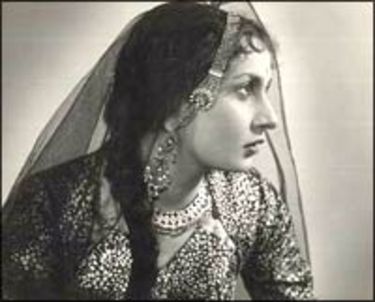
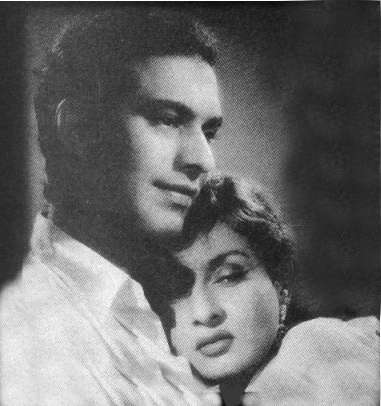
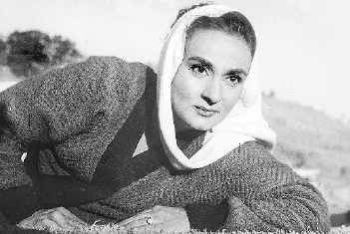
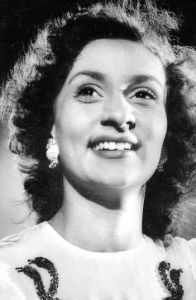
She was still in her teens when she was spotted by Sardar Akhtar, the great filmmaker Mehoob Khan’s wife. After convincing her mother, Sardar Akhtar took Nadira under her wing and groomed her. Nadira recalled in an interview…
“She bought me my first bra. I did not know the use of the garment till then. She gave me my screen name Nadira as Farhat was thought to be too soft. My first saree was a gift from her, so was my first tube of paint. She taught me to put on make up. I still have that tube which I use each time I start something new.”
When Nargis turned down the lead role in mentor Mehboob Khan’s Aan (1952), Nadira was cast in her place as a haughty princess and introduced opposite Dilip Kumar in this spectacular take on Taming of the Shrew also co-starring Nimmi and Premnath. Aan, Mehboob’s first film in colour, even had a release in London and was much appreciated even though a critic did quip - it goes aan and aan and aan! Nadira was now a star.
At this juncture just when things were starting to look up for her, Nadira married film lyricist Naqshab. Naqshab made her break her contract with Mehboob Khan and with her earnings made films like Nagma and Raftaar exploiting her star status but basically to move himself further. Nadira walked out of the marriage leaving behind all her money and rented a suite in Marine Drive and continued working!
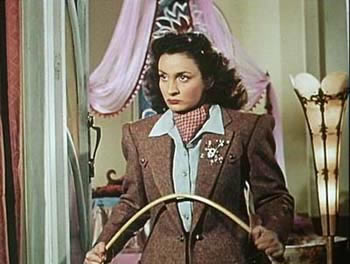
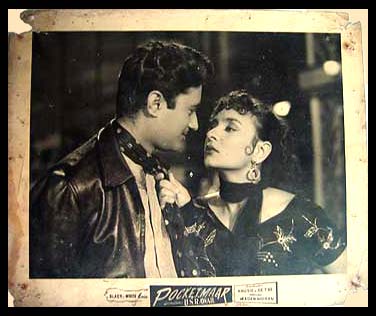
It was Raj Kapoor who then used Nadira to stunning effect in what was to become her signature role in Shree 420 but which also proved to be almost a death knell in her career. Then still a leading lady, the film cast her against type as the cigarette smoking vamp who with her arched eyebrows seduces the hero to a glamorous and crooked lifestyle to such strong effect (she has never acted or looked better!) that she stole a march over both Raj Kapoor and Nargis in the film and thereafter was only offered negative roles! She refused most of them still wanting to play the heroine only to find few offers now forthcoming. The negative roles she refused were then offered to Shashikala making a big star out of the latter thus making Nadira lose out in the vamp department as well. But films like Shree 420 and Pocketmaar (1956) with Dev Anand prove that there when Nadira was up to her scheming vamping antics or seducing the hero through songs like Mud Mudke Na Dekh or Duniyake Saath Chal Pyaare, she had no equal!
When Vyjayantimala turned down the Filmfare Award for Best Supporting Actress for her turn as Chandramukhi in Bimal Roy’s Devdas (1955) arguing that both Paro and Chandramukhi were in fact leading roles, the award was offered to Nadira for Shree 420. She sensibly turned it down saying she would win the award on merit or not at all but never as a hand-me-down.
Nadira tried settling down again but went through a second, disastrous short-lived marriage to an Arab.
Nadira’s other really effective and well-known film was the Kishore Sahu directed and Kamal Amrohi produced Dil Apna Aur Preet Paraayi (1960) co-starring Meena Kumari and Raaj Kumar. Again she came off strongly in the film as the wife of Raaj Kumar, who would stop at nothing to keep her husband though he and Meena Kumari loved each other before his marriage. It was an interesting film in that the ‘vamp’ is the wife trying to make her marriage work while the goody-two shoes heroine really is the other woman but of course the film gives full sympathy to Meena Kumari and Raaj Kumar suffering in unrequited love with Nadira being a shrew in their way.
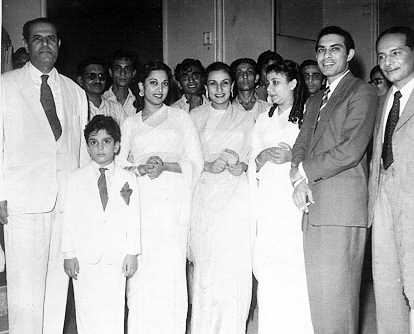
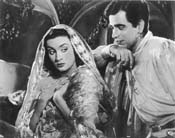
She did work on and off sometimes with long breaks but always made an impact in the films she did – Chhoti Chhoti Baatein (1965), Pakeezah (1972), Hanste Zakhm (1973), Ishq Ishq Ishq (1974) and especially Julie (1975). In Julie, as the heroine Lakshmi's mother Margaret - an Anglo-Indian housewife who considers herself more English and who keeps her brood together while facing crises with poise, Nadira came up with easily the strongest performance of the film and 20 years after Shree 420, won the Filmfare Award for Best Supporting Actress on merit! In fact when not vamping it, even when she played the mother, Nadira was rarely the stereotypical, crying, helpless woman in white. She added rare dignity and spirit to the various roles of the mother, aunt or other older woman roles.
Nadira’s other films include Amar Akbar Anthony (1977), Saagar (1985) – again making a very strong impression, Tamanna (1997) and Josh (2000). She also acted in the Ismail Merchant directed Cotton Mary (1999) and the Television Serials Thoda sa Aasmaan and Margarita.
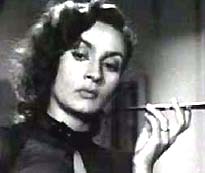
Posted by: maheshks Jun 24 2007, 01:41 AM
movie aurat (1940)
SARDAR AKHTAR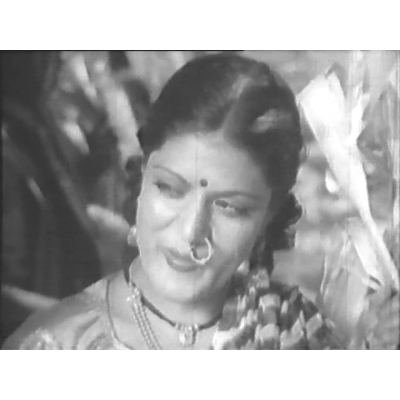
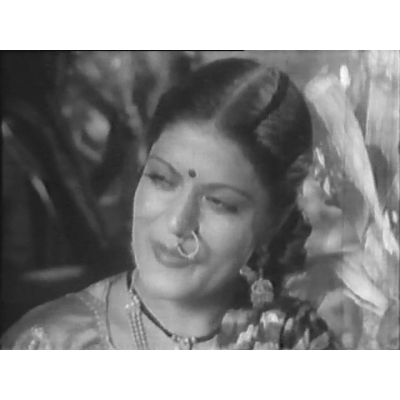
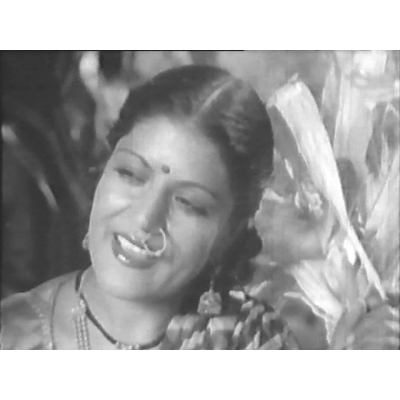
SURENDRA AND JYOTI
SURENDRA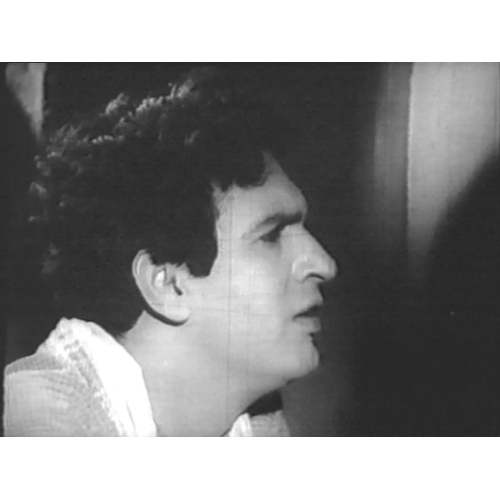
Posted by: pinky Jun 24 2007, 04:19 PM
Reeth i am posting this article on Waheeda Rehman ![]()
Today,Waheeda Rehman is a successful entrepreneur, The Bimal Roy Memorial Committee recently felicitated Rehman for her outstanding contribution to Indian cinema.
Well, all we can say is, she is one of the rare actresses with a perfect sense of timing.
Waheeda Rehman : The Star After years of life in the limelight, Waheeda Rahman seems to have finally found her font of peace in her home by the sea-shore. She tells Priya Pathiyan of life after her glory days, her wanderlust and her passion for photography I lost my husband only three months ago, and Ive been very busy with all the paperwork and other arrangements, she says matter-of-factly, the depth of her bereavement only evident in her expressive eyes.
The surrounding silence is overpowering. The throbbing beats of techno from the fishing colony close by, die out at the steps of Sahil. The house that holds a wealth of memories for Waheeda Rahman is as quiet as a mausoleum. And its the one retreat that Waheeda has found in noisy Mumbai. Tucked away on a shoulder of Bandras Bandstand that is surprisingly far from the madding crowds that throng the sea front, Waheedas home for the last two years is serene. Just like the woman. Both have donned the same mantle of cool, venerated antiquity. The house is characterised by high-ceilings, French-windows, wood furniture gleaming with an antique sheen, and cool expanses of tiled floor broken with carefully chosen throws, Chinese screens and objets dart. Waheeda is almost spartan in contrast no traces of make-up, clad in a simple black salwar-kameez. But just as full of grace as her home. She speaks about the ability to express kashvi. Which is, incidentally, also her daughters name. My children motivate me. Kashvi has just returned from her jewellery designing course abroad and my son Sohail is now working in a company after his MBA. But yesteryears heroine is no retired mother-of-two even now. Next month, well start shooting for the Anupam Kher-directed Om Jai Jagdish, which stars Abhishek Bachchan, Anil Kapoor and Fardeen Khan. I play the mother.
The self-confessed practical person is just as blasi about the breakfast cereal venture that she started 11 years ago, while in Bangalore. My kids were at boarding school in Kodai. My friend Ashrafa Sattar and I, went into partnership to market breakfast cereals. Even now, although I dont live there permanently any more, I often visit my farmhouse near Bangalore, she says, confessing that she misses the healthy, happy life that she lived in the garden city. My husband loved nature as much as I, she reminisces.
Something that not many of her fans may be aware of, is her abiding love for photography, I love to take pictures of animals and one place that Ive always wanted to visit is Africa, mainly for its national parks. Travel excites her, and while she speaks of faraway places, she reveals an animation that her beatific face is otherwise devoid of. This trip to Tokyo for the Guru Dutt commemorative along with Johnny Walker that came up suddenly, was a pleasant surprise, she lights up. And it seems to mean as much to her as the honours being conferred on her this year by the Bimal Roy Memorial Committee, which is not only dedicating this years event to her, but also screening some of her films. Ask her which roles shes proud of having done and she lists: Guide, Mujhe Jeene Do, Khamoshi, Teesri Kasam..., but like all artistes, even I always feel that I could have done each of them better. If only I had done this, or that..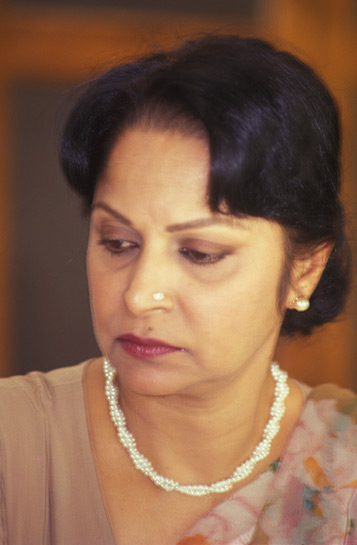
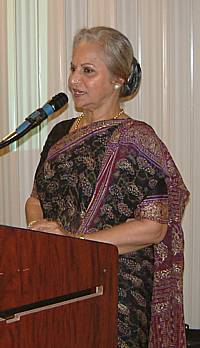
Posted by: maheshks Jun 25 2007, 01:25 AM
Somebody should write on her. She along with Maharani Gayatri Devi were
named as the most beautiful women by the vogue magazine.
Known for the role of Sylvia played by her. To recapitulate, the movie
was based on famous Nanavati trial case. The case changed the
lives of two young and raw advocates who were non-entities by then.
One was Shri Y.V. Chandrachud, the public prosecutor, who later
on became the Chief Justice of India. On the other side was
naive and dynamic Ram Jethmalani. This case also changed
the system of trials in India. With this case the jury system was
abolished.
Any one on this beauty. A Miss India during 50s.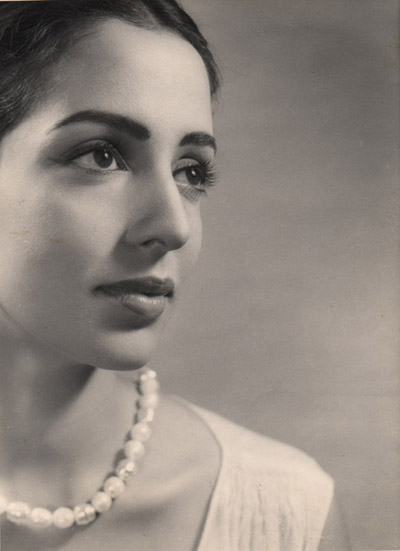
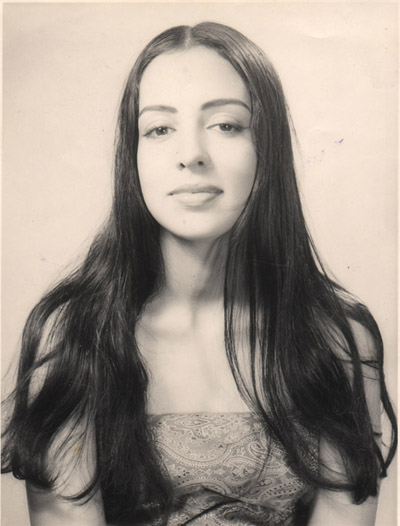
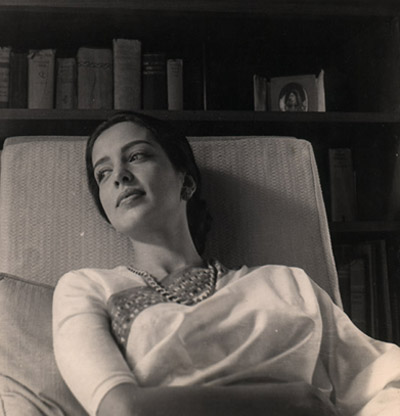
Posted by: noorie Jun 25 2007, 09:17 AM
That's Leela Naidu , the star of films like Anuradha and Yeh Raaste Hain Pyar Ke.
She was also the (ex) wife of Anglo-Indian writer Dom Moraes.
Sunil Dutt's Yeh Raaste Hain Pyar Ke was based on the Nanavati trial.
Here are some more pictures of her:

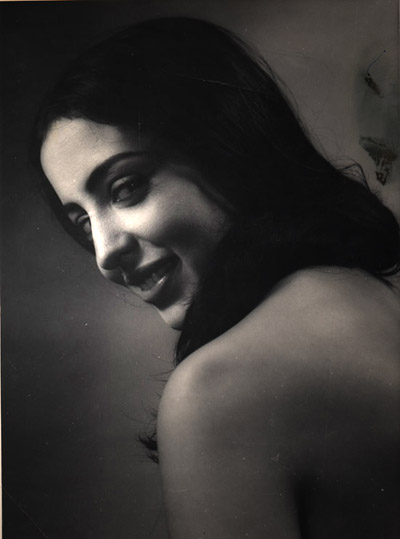

A still from the Merchant-Ivory production The Householder where she starred opposite Shashi Kapoor.
Noorie
Posted by: jassi Jun 25 2007, 10:38 AM
we are not goin in right way,anyways its all up to me
i wanted to cover actresses of 50s first
Posted by: nasir Jun 25 2007, 12:56 PM
LEELA NAIDU:
Leela Naidu was the daughter of the well known nclear physicst Ramaiah Naidu from Andhra Pradesh while her mother was of Irish origin.
To mention just a couple of her movies, she starred opposite Pradeep Kumar in BAGHI (1964). Her earlier movie ANURADHA (1960) where Pandit Ravi Shankar provided the music, had some very “Sitaric” songs of Lata such as SANVRE, SANVRE, and JAANE KAISE SAPNON MEIN KHO GAYIN ANKHAIYAA.N.
YEH RAASTE HAIN PYAAR KE was released sometimes in 1963 at the Bombay’s Maratha Mandir Cinema. Despite the well-known story of Crime of Passion ( of Nanavati who killed Ahuja who was involved with former's wife) the movie did not do well. Perhaps it was because it really failed to capture the passion ingrained in the real-life story. Ravi provided some good songs there: a duet of Rafi-Asha: YEH KHAAMOSHIYAN…. And Rafi’s: TUM JIS PE NAZAR DAALO…are well-known. The title-song was by Asha. As has been pointed out by Mr. Mahesh, the trial of Nanavati sealed the fate of Indian Jury System in India.
Leela Naidu was a statuesque beauty but could not last in Bollywood for one reason or the other. She had also been considered for the lead role in GUIDE. In 1954, Leela Naidu was selected Femini’s Miss India.
NASIR.
Posted by: jassi Jun 25 2007, 01:53 PM
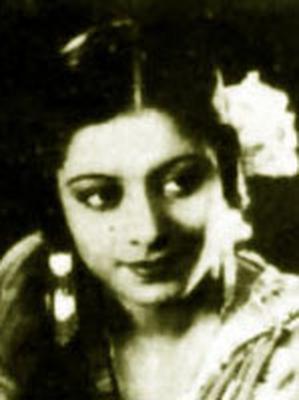
An untrained singer when she entered films, she studied briefly with Ustad Allah Rakha in Lucknow. She was employed as a singer at Megaphone Gramaphone Company receiving further training from Bhishmadev Chatterjee. Born Kananbala in 1916, she made her debut as a child actress with Joydev (1926). She later worked in P.C Barua s Mukti and this film made her a star and led to a fruitful association with New Theatres. The success of Bidyapati (Bengali)/ Vidyapati /(Hindi) (1937) in which she gave perhaps her finest performance, made her the studio's top star. Kanan Devi remained the top star of New Theatres till she resigned in 1941 and began to freelance in Hindi and Bengali films.
Kanan Devi turned producer with Shrimati Pics in 1949 and later launched the Sabhyasachi collective with the film Ananya (1949). Her own productions were mainly based on Sarat Chandra stories and were directed by her husband Haridas Bhattacharya. Kanan Devi's last film was Indranath Srikanta-o-Annadadidi (1959). She wrote an autobiography Sabare Ami Nomi (1973) and in 1977, Kanan Devi, the first lady of the Hindi and Bengal screen was awarded the Dadasaheb Phalke award for her contribution to Indian Cinema. She also worked as President of the Mahila Shilpi Mahal, an organization that helps aged and needy female artistes of yesteryear.She passed away in 1992.
Her Performances-Jaidev(Patience Cooper),Vidyapati,Mukti(P.C Barua),Anyana,Sapera(Prithvi RK),Lagan(K L Sehgal),Jawani Ki Reet(with Jagdish Sethi),Krishna Leela(Pradeep Kumar) etc.
apart from these actresses there were Rajkumari,Jamuna(both were part of K L Sehgal starrer Devdas),Sardar Akhtar,Madhuri etc were other reknown actresses of 30s.
Sitara Devi was also a succesful actress of that era(Her name was mentioned in 2001 s blockbuster Gadar ek prem katha).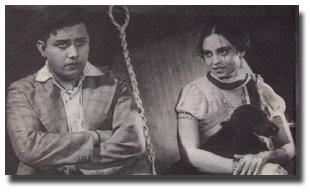
Meenakashi Shirodkar(Grandmother of Shilpa and Namarta Shirodkar),Shanta Apte and Hansa Wadkar(70s film Bhumika starring Smita Patel was based on her life) were reknown actresses of Marathi films,but they did Hindi films too.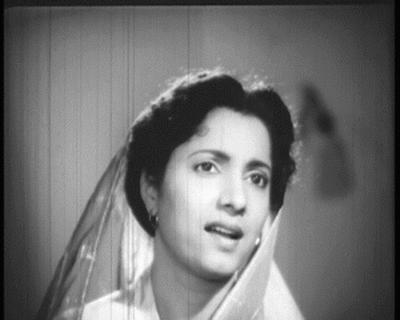


Jaishree(wife of V.Shantaram),Sadhana Bose and Begum Akhtar also did some meaningful films.Sadhana Bose was also Lux Soap Face,its believed that She is reborn as Shahrukh Khan,but she was died after Shahrukh Khan's birth.Sulochana also got success in Mythological Films,later she became reknown supporting actresses of 60s and 70s films.
Powered by Invision Power Board (http://www.invisionboard.com)
© Invision Power Services (http://www.invisionpower.com)
